V I'"
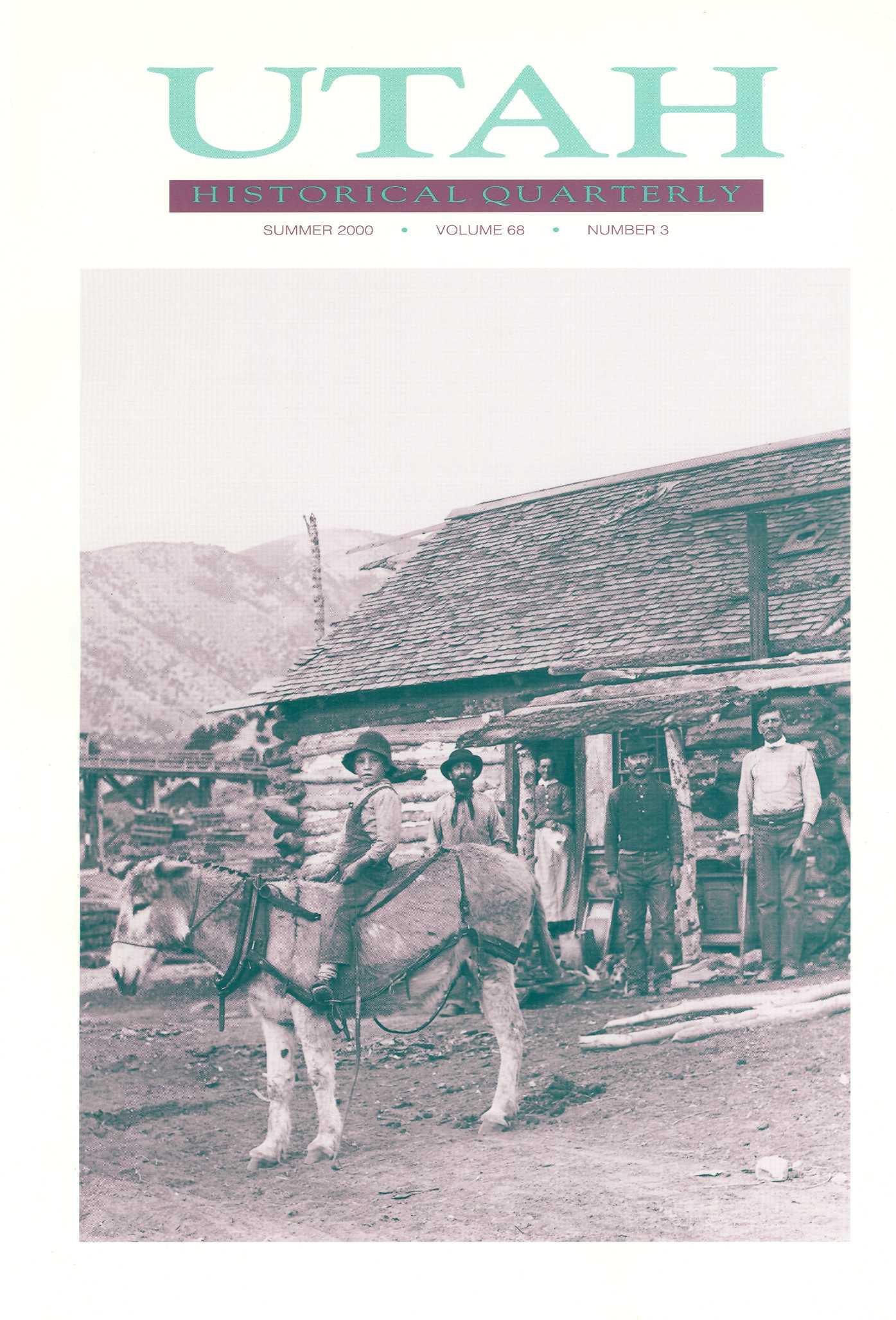
SUMMER 2000 VOLUME 68 NUMBER 3
UTA H HISTORICA L QUARTERL Y (ISSN 0042-143X)
EDITORIA L STAF F
MAX J. EVANS, Editor
STANFORD J LAYTON, Managing Editor
KRISTEN SMART ROGERS, Associate Editor
ALLAN KENT POWELL, Book Review Editor
ADVISOR Y BOAR D O F EDITOR S
AUDREY M GODFREY, Logan, 2000
LEE ANN KREUTZER,Torrey, 2000
ROBERT S. MCPHERSON, Blanding, 2001
MIRIAM B MURPHY, Murray, 2000
ANTONETTE CHAMBERS NOBLE, Cora,WY, 2002
RICHARD C ROBERTS, Ogden, 2001
JANET BURTON SEEGMILLER, Cedar City, 2002
GARY TOPPING, Salt Lake City, 2002
RICHARD S VAN WAGONER, Lehi, 2001
Utah Historical Quarterly was established in 1928 to publish articles, documents, and reviews contributing to knowledge of Utah history. The Quarterly is published four times a year by the Utah State Historical Society, 300 Ri o Grande, Salt Lake City, Utah 84101 Phone (801) 533-3500 for membership and publications information
Members of the Society receive the Quarterly, Beehive History, Utah Preservation, and the bimonthly newsletter upon payment of the annual dues: individual, $20; institution, $20; student and senior citizen (age sixty-five or older), $15; contributing, $25; sustaining, $35; patron, $50; business, $100
Manuscripts submitted for publication should be double-spaced with endnotes Authors are encouraged to include a PC diskette with the submission For additional information on requirements, contact the managing editor Articles and book reviews represent the views of the authors and are not necessarily those of the Utah State Historical Society
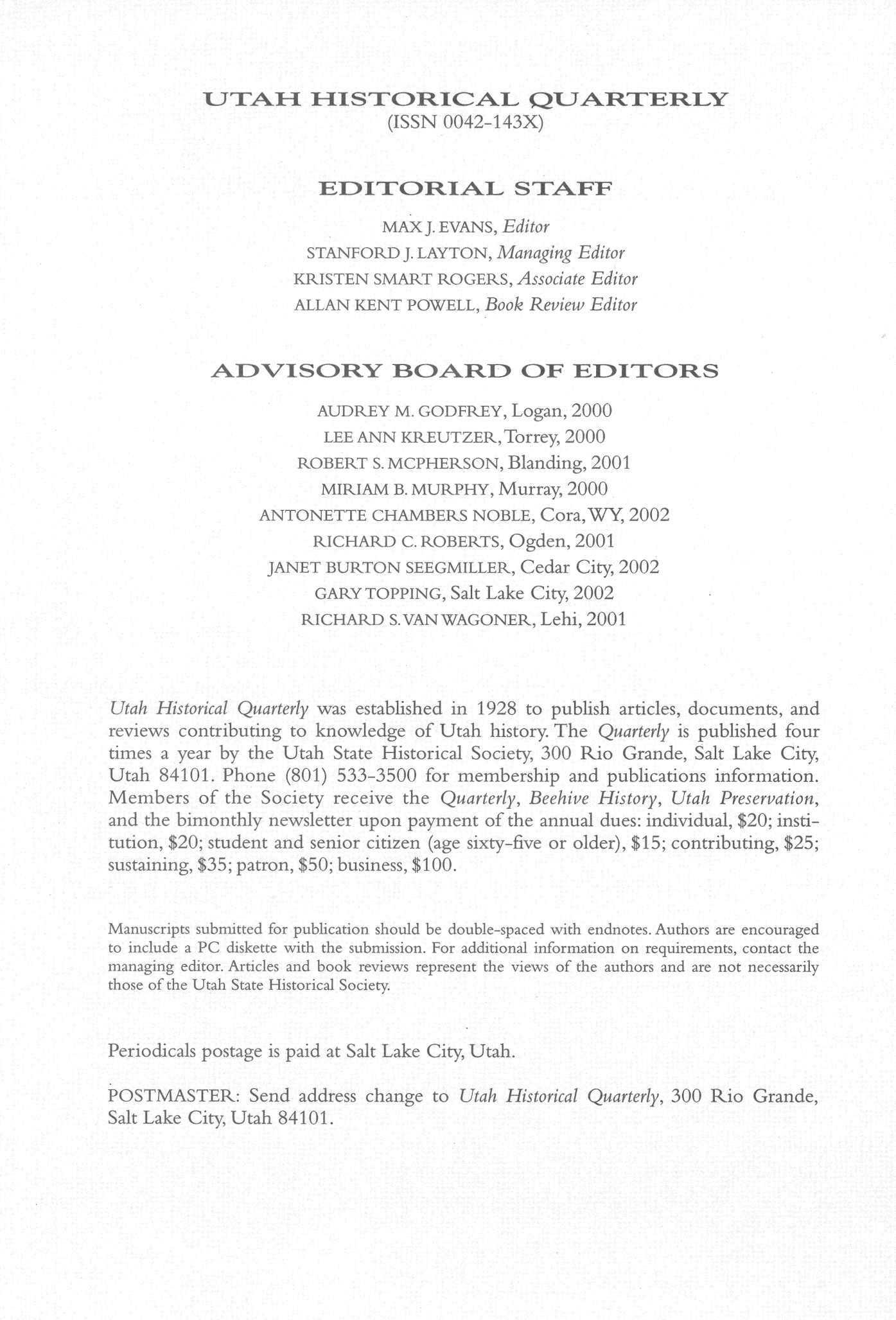
Periodicals postage is paid at Salt Lake City, Utah.
POSTMASTER: Send address change to Utah Historical Quarterly, 300 Ri o Grande, Salt Lake City, Utah 84101
194 I N THI S ISSUE
196 "I'd Rather Have Som e Roasting Ears": Th e Peregrinations o f George Armstrong Hicks
By Davis Bitton
223 "Grit Enoug h to Stick with It": Stories from Blue Valley Edited and introduced by Kent Davis and Kristen Rogers
244 Price Band Days: Th e Intermountain Music Festival
By Ronald G. Watt
258 Pins, Patterns and J. C. Penney: A n Ogde n Cottage Industry Goes Global By
Audrey M. Godfrey
269 BOO K REVIEWS
Ronald W Walker and Doris R. Dant, eds. Nearly Everything

Imaginable: The Everyday Life of Utah's Mormon Pioneers.
Reviewed by Jay A. Aldou s
William B. Smart and Donna T. Smart, eds. Over the Rim: The Parley
P. Pratt Exploring Expedition to Southern Utah, 1849-50.
Reviewed by Wayn e K Hinton
Scott R Christensen Sagwitch: Shoshone Chieftain, Mormon Elder, 1822-1887.
Reviewed by Roger Blomquist
Mark Fiege Irrigated Eden: The Making of an Agricultural Landscape in the American West.
Reviewed by Craig Fuller
Newell G Bringhurst. Fawn McKay Brodie: A Biographer's Life.
Reviewed by Lavina Fielding Anderso n
Sondra Jones. The Trial of Don Pedro Leon Luj an: The Attack against Indian Slavery and Mexican Traders in Utah.
Reviewed by Kenneth L Canno n II
John H.Yang, comp Asian Americans in Utah: A Living History.
Reviewed by Eric Walz
Doug Goodman and Daniel McCool, eds. Contested Landscape: The Politics ofWilderness in Utah and the West.
Reviewed by Paul S Sutter
Richard D Poll; Stan Larson, ed Working the Divine Miracle: The Life ofApostle Henry D. Moyle.
Reviewed by Richard Neitzel Holzapfel
SUMME R 2000 • VOLUM E 68 • NUMBER 3
285 BOO K NOTICE S © COPYRIGHT 2000 UTAH STATE HISTORICAL SOCIETY
Few characters wh o have commande d space in Utah Historical Quarterly through the years would be considered more interesting than George A. Hicks. O n the surface, he appears to have been a typical Mormon pioneer, having been born in 1835 and raised in the church, crossing the plains in 1852, answering the call to colonize remote areas of Utah Territory, and dying in the faith as an old man Under the historian's stereoscope, however, he becomes a multidimensional personality plagued by doubts about church leadership, doctrine, and enterprise A reasonably -well-read and literary man, he penned a pointed memoir in 1878; wrote impu-
ABOVE: Webster School Orchestra, October 23, 1907.
ON THE COVER: The Edmund family and cabin, probably Carbon County, c. 1900. George Edward Anderson photo, USHS collections, courtesy Rell G. Francis. At the same time that some Utahns could enjoy varied cultural opportunities, others lived a far more rustic and isolated existence.

IN THIS ISSUE
PHOTO USHS
194
dent letters to Brigham Young; alienated the testy Emma Lee, who threatened to "put a load of salt in his backside"; and may have even been excommunicated for a time. Readers of this issue will probably be affected by him the same way as were his contemporaries: some will like him, many will find him less than charming, and still others will smile and just shake their heads at his antics and eccentricities. All, no doubt, 'will admire the insightful, masterful way his complexities are handled by a very talented biographer in this engaging character study
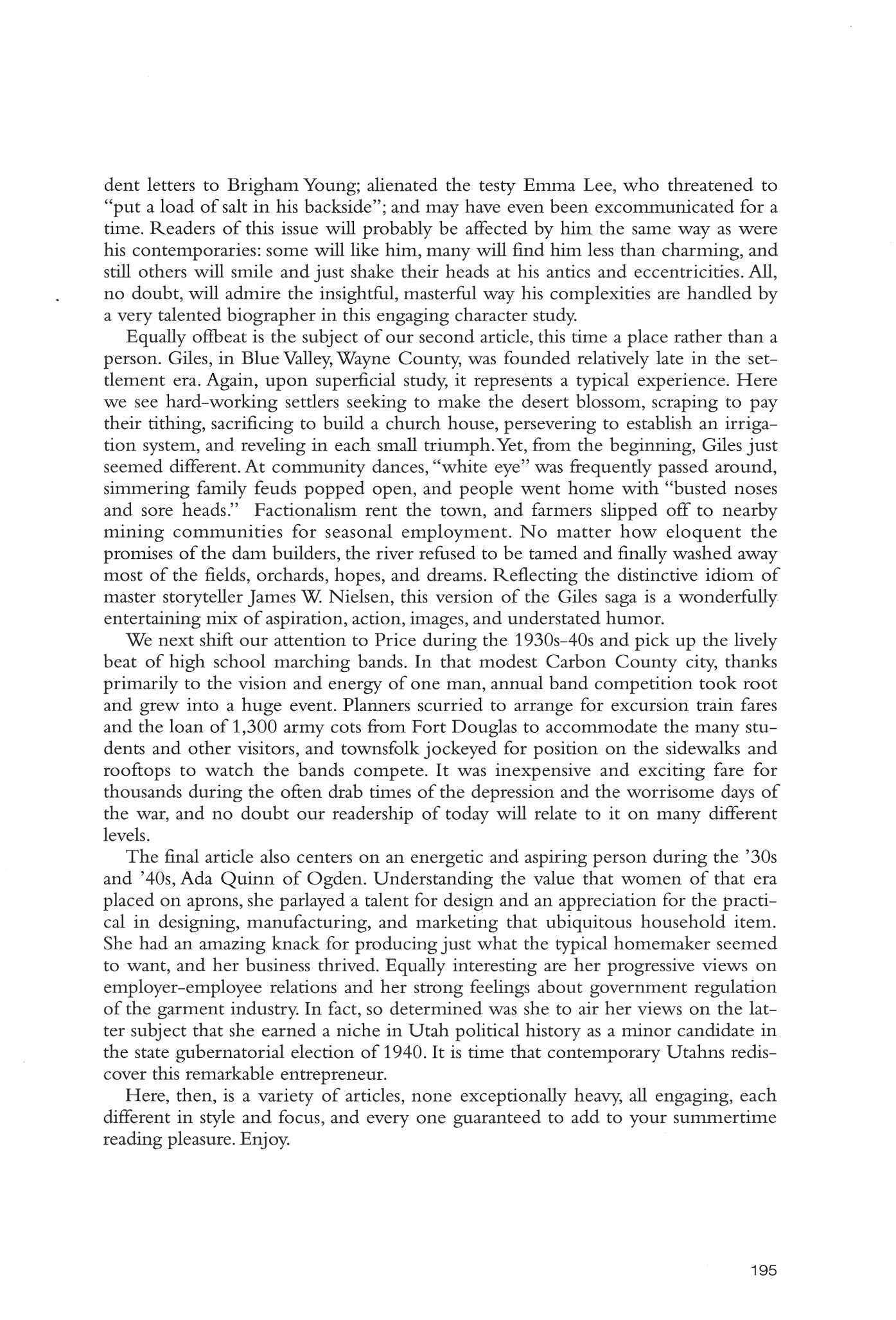
Equally offbeat is the subject of our second article, this time a place rather than a person Giles, in Blue Valley, Wayne County, was founded relatively late in the settlement era. Again, upon superficial study, it represents a typical experience. Here we see hard-working settlers seeking to make the desert blossom, scraping to pay their tithing, sacrificing to build a church house, persevering to establish an irrigation system, and reveling in each small triumph. Yet, from the beginning, Giles just seemed different. At community dances, "white eye" was frequently passed around, simmering family feuds popped open, and people went home with "busted noses and sore heads." Factionalism rent the town, and farmers slipped off to nearby mining communities for seasonal employment. N o matter how eloquent the promises of the dam builders, the river refused to be tamed and finally washed away most of the fields, orchards, hopes, and dreams Reflecting the distinctive idiom of master storyteller James W. Nielsen, this version of the Giles saga is a wonderfully entertaining mix of aspiration, action, images, and understated humor
We next shift our attention to Price during the 1930s-40s and pick up the lively beat of high school marching bands In that modest Carbon County city, thanks primarily to the vision and energy of one man, annual band competition took root and grew into a huge event. Planners scurried to arrange for excursion train fares and the loan of 1,300 army cots from Fort Douglas to accommodate the many students and other visitors, and townsfolk jockeyed for position on the sidewalks and rooftops to watch the bands compete. It was inexpensive and exciting fare for thousands during the often drab times of the depression and the worrisome days of the war, and no doubt our readership of today will relate to it on many different levels.
The final article also centers on an energetic and aspiring person during the '30s and '40s, Ada Quinn of Ogden Understanding the value that women of that era placed on aprons, she parlayed a talent for design and an appreciation for the practical in designing, manufacturing, and marketing that ubiquitous household item She had an amazing knack for producing just what the typical homemaker seemed to -want, and her business thrived. Equally interesting are her progressive views on employer-employee relations and her strong feelings about government regulation of the garment industry In fact, so determined was she to air her views on the latter subject that she earned a niche in Utah political history as a minor candidate in the state gubernatorial election of 1940. It is time that contemporary Utahns rediscover this remarkable entrepreneur
Here, then, is a variety of articles, none exceptionally heavy, all engaging, each different in style and focus, and every one guaranteed to add to your summertime reading pleasure. Enjoy.
195
"I'd Rather Have Some Roasting Ears": The Peregrinations of George Armstrong Hicks
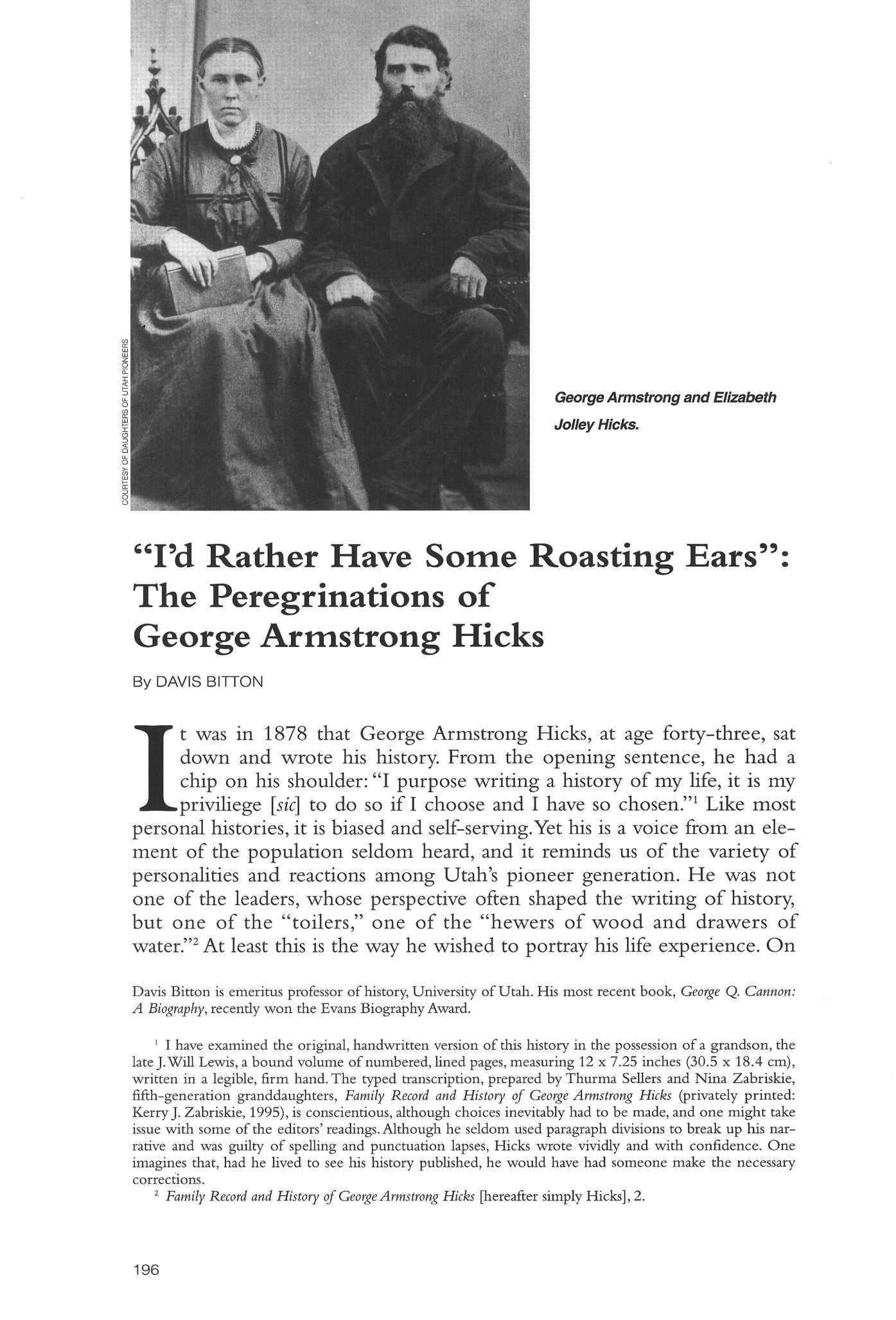 By DAVIS BITTON
By DAVIS BITTON
It was in 1878 that George Armstrong Hicks, at age forty-three, sat down and wrote his history. From the opening sentence, he had a chip on his shoulder:"I purpose writing a history of my life, it is my priviliege [sic] to do so if I choose and I have so chosen."1 Like most personal histories,it isbiased and self-serving.Yet his is avoice from an element of the population seldom heard, and it reminds us of the variety of personalities and reactions among Utah's pioneer generation. He was not one of the leaders, whose perspective often shaped the writing of history, but one of the "toilers," one of the "hewers of wood and drawers of water."
2 At least this is the way he wished to portray his life experience. On
Davis Bitton is emeritus professor of history,University of Utah His most recent book, George Q Cannon: A Biography, recently won the Evans Biography Award
1 I have examined the original, handwritten version of this history in the possession of a grandson, the lateJ.Will Lewis,abound volume of numbered, lined pages,measuring 12 x 7.25 inches (30.5 x 18.4 cm), written in a legible, firm hand The typed transcription, prepared byThurma Sellers and Nina Zabriskie, fifth-generation granddaughters, Family Record and History of George Armstrong Hicks (privately printed: KerryJ Zabriskie, 1995),is conscientious, although choices inevitably had to be made,and one might take issue with some of the editors'readings Although he seldom used paragraph divisions to break up his narrative and was guilty of spelling and punctuation lapses, Hicks wrote vividly and with confidence. One imagines that, had he lived to see his history published, he would have had someone make the necessary corrections
2 Family Record and History of George Armstrong Hicks [hereafter simply Hicks],2
George Armstrong and Elizabeth Jolley Hicks.
196
GEORGE ARMSTRONG HICKS
the title page of his handwritten history, he wrote the familiar lines from Thomas Gray's"ElegyWritten in a Country Churchyard":
Let not ambition mock their useful toil, Their homelyjoys and destiny obscure; Nor grandeur hear with a disdainful smile
The short but simple annals of the poor
In another sense, too, Hicks provides a valuable point of view Too often we lump the people of'territorial Utah into two large categories— Mormons and gentiles—the former portrayed as all devout, the latter as vehement persecutors—or, alternatively, the former as superstitious sheep, the latter as enlightened sophisticates The reality was more interesting and more complex on both sides, for there was in fact a spectrum of gentile opinion about Mormons and a range of reactions and commitment within the Mormon community.3 Hicks is a fascinating example of a Mormon who positioned himself close to the edge,just inside or just outside the boundary
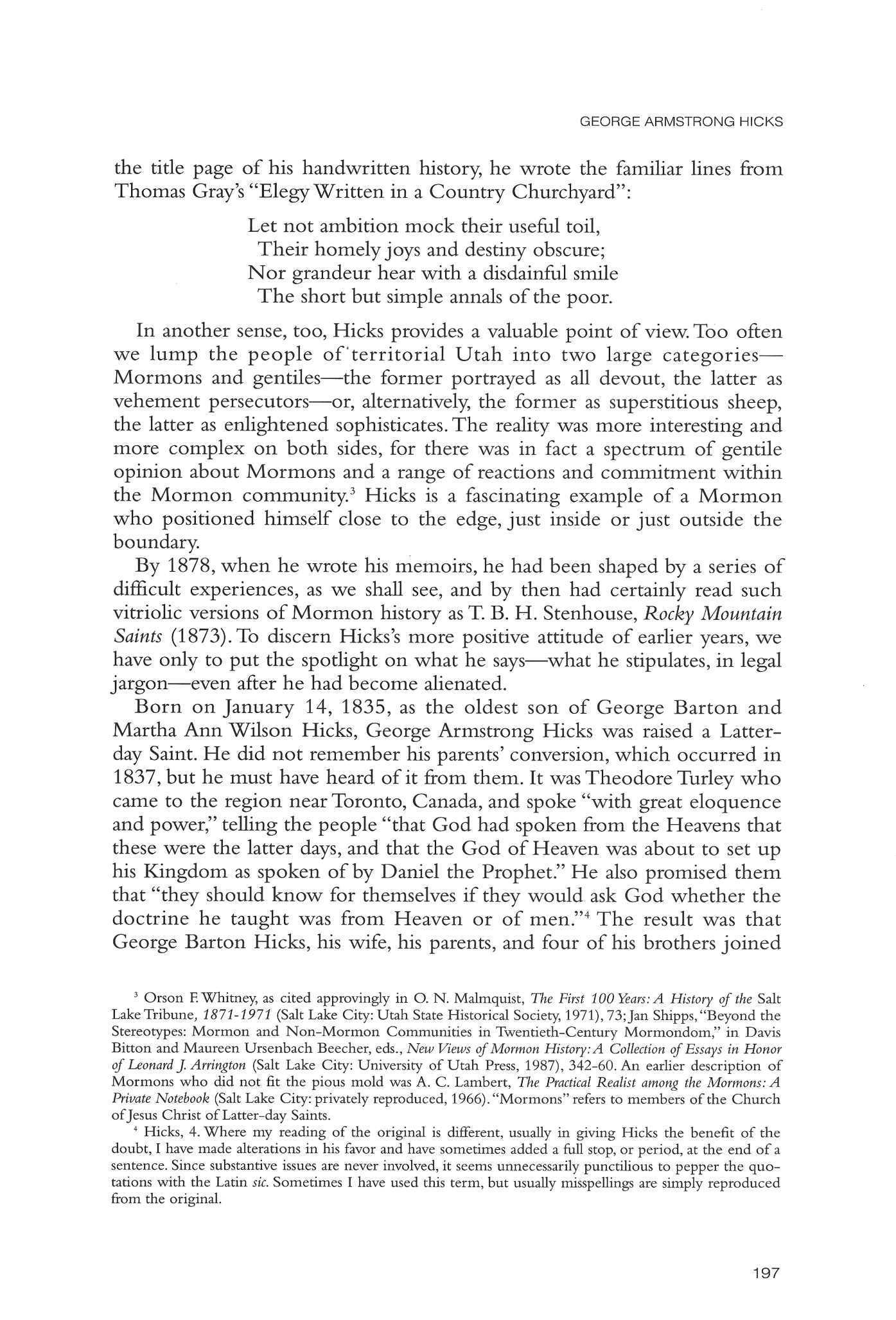
By 1878,-when he wrote his memoirs, he had been shaped by a series of difficult experiences, as we shall see, and by then had certainly read such vitriolic versions of Mormon history asT.B.H. Stenhouse, Rocky Mountain Saints (1873).To discern Hicks's more positive attitude of earlier years,-we have only to put the spotlight on what he says—what he stipulates, in legal jargon—even after he had become alienated
Born on January 14, 1835, as the oldest son of George Barton and Martha Ann Wilson Hicks, George Armstrong Hicks -was raised a Latterday Saint. He did not remember his parents' conversion, -which occurred in 1837,but he must have heard of it from them It wasTheodore Turley who came to the region nearToronto, Canada, and spoke "with great eloquence and power," telling the people "that God had spoken from the Heavens that these were the latter days,and that the God of Heaven was about to set up his Kingdom as spoken of by Daniel the Prophet." He also promised them that "they should know for themselves if they would ask God whether the doctrine he taught was from Heaven or of men."4 The result was that George Barton Hicks, his wife, his parents, and four of his brothers joined
3 Orson F.Whitney, as cited approvingly in O N Malmquist, The First 100 Years: A History of the Salt LakeTribune, 1871-1971 (Salt Lake City:Utah State Historical Society, 1971),73;Jan Shipps,"Beyond the Stereotypes: Mormon and Non-Mormon Communities in Twentieth-Century Mormondom," in Davis Bitton and Maureen Ursenbach Beecher, eds., New Views of Mormon History:A Collection of Essays in Honor of Leonard J. Arrington (Salt Lake City: University of Utah Press, 1987), 342-60 An earlier description of Mormons who did not fit the pious mold was A. C. Lambert, The Practical Realist among the Mormons: A Private Notebook (Salt Lake City:privately reproduced, 1966) "Mormons" refers to members of the Church ofJesus Christ of Latter-day Saints
4 Hicks, 4 Where my reading of the original is different, usually in giving Hicks the benefit of the doubt, I have made alterations in his favor and have sometimes added a full stop,or period, at the end of a sentence Since substantive issues are never involved, it seems unnecessarily punctilious to pepper the quotations with the Latin sic. Sometimes I have used this term, but usually misspellings are simply reproduced from the original
197
UTAH HISTORICAL QUARTERLY
the Mormon church.Among the missionaries who came to the area were Almon W Babbitt, "a man of great intellectual abilities," and the prophet Joseph Smith himself, -who, preaching on the farm of William Law, "in a powerful manner bore testimony that God had sent an Angel and that the Angel had given him the book of Mormon he had translated it by the power of God."5
The Hicks family left forJackson County, Missouri,in 1838,stopping for the summer in Georgetown, Pennsylvania, where the father obtained employment as a weaver and the mother opened a confectionary shop. Upon hearing of the expulsion of the Saints from Missouri, they continued on to Commerce (the future Nauvoo), Illinois, in November 1839 Only four years old when the family arrived in Illinois, George A. would not have remembered much, if anything, about these early peregrinations, although he did remember leaving Canada.6 He -waseleven -when the family left Illinois in 1846 His retrospective account of the Nauvoo years,based on the limited understanding of a child, is tinctured -with his later disillusionment.Yet it often rings true.
The first winter in Illinois, 1839-40, the Hicks family lived in "a rude log cabin...constructed without floor or window."7 Even for Canadians accustomed to cold weather, the winter was "severe."In 1840 Father Hicks built a better log house. The population was soaring and construction booming Orchards were planted and "fine buildings were erected." But there were two "drawbacks" to the Nauvoo location: the "chills and fever," a malaria-like sickness prevalent in the swampy area; and the economic reality that "the people had little or no capital or if they had it was not thought a safe place to invest what they did have.""It was a well known fact that no place can long survive the want of cash capital,"Hicks explains "Nauvoo soon became a hard place for the poor to make a living in."8 His experience of poverty with the others in his family was genuine enough, but his adult reflections on the importance of capital to an economy stemmed in large part, as we shall see, from later painful experiences with the poverty in Utah.
Hicks recalled schools in Nauvoo, but these -were private,not public, and the teachers had to be paid "How could a weaver farmer who -worked in a brickyard for an irresponsable company (the Mormons have been very fortunate in starting irresponsable companies) pay school bills or any other bills[?]" Here recognition of the financial plight that prevented his attending school combines with a bitter editorial comment based on his later
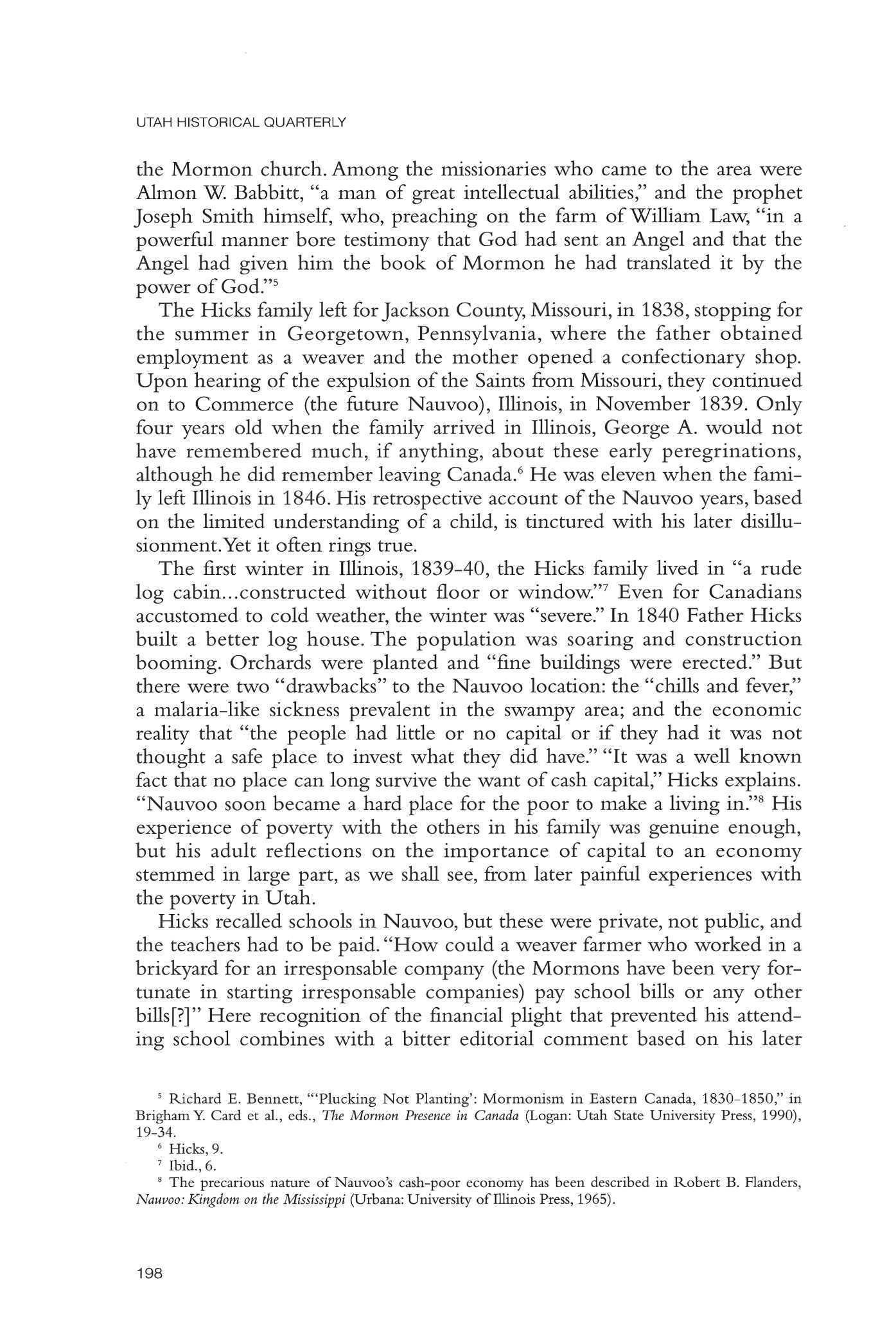
6 Hicks,9
7 Ibid., 6
5 Richard E. Bennett, '"Plucking Not Planting': Mormonism in Eastern Canada, 1830-1850," in BrighamY Card et al., eds., The Mormon Presence in Canada (Logan: Utah State University Press, 1990), 19-34
198
8 The precarious nature of Nauvoo's cash-poor economy has been described in Robert B Flanders, Nauvoo: Kingdom on the Mississippi (Urbana:University of Illinois Press, 1965)
accumulated grievances about business failures In any case, Mother Hicks taught her children at home in Nauvoo George's recollections show the limitations of such schooling but also pay tribute to a valiant mother: "Ignorance is the bane of society, my mother [k]new this and she taught me and her other children lessons at her knee.... She not only taught me to read and spell,but she taught me to believe in the new faith and why it was necessary to believe in it."9
The three books in the Hicks household were the Bible, the Book of Mormon, and Parley P Pratt's Voice of Warning. Anxious to encourage young George's religious development, his mother promised to give him a copy of the Book of Mormon if he would read it."I soon got interested in the wars betwixt the Nephites and Lamanites," he recalls,"but before I got through, the book fell into a tub of soap suds and was spoiled, so I did not read it through."10 An interest in action and adventure may be quite normal for a boy, but there is no evidence that Hicks ever returned to the Book of Mormon or developed any appreciation for its pervasive religious message.
He loved to read in Pratt's Voice of Warning, however. "I think it is one of the finest religious books I ever read," he proclaimed "It is a great pity that it is not true."11 This conclusion was not that of Hicks the boy in Nauvoo, but it was reached in the course of time. One of the compelling passages in Pratt's pamphlet described the biblical image of the little stone cut from the mountain without hands, which, rolling down, shattered the great image (Dan. 2)."I asked my mother when these things should take place," Hicks recalled."She told me that the little stone' is the Mormon Church and that the time for breaking the 'Image' is now—in a few years.That was the faith of the whole Mormon Church and my parents were not to blame for believing it. Over thirty years have passed and gone yet the 'Image' is still standing and the 'Stone' is showing signs of decay." Hicks's expectations were brittle, but his mindset was common among the Saints of the first generation.12
One of the Nauvoo developments that most galled Hicks was polygamy
Flatly rejecting the claim of the Reorganized Church of Jesus Christ of Latter Day Saints that plural marriage originated after Joseph Smith's death, Hicks gives his own testimony "I know that polygamy was in the church previous to his death," he wrote "One of P P Pratt's wives made it her home at my father's house and I know that the Apostle Pratt came and vis-
9 Hicks, 6
!0 Ibid., 6-7
11 Hicks, 7 Parley P Pratt, A Voice of Warning (New York: Sandford, 1837) Editions were also brought out in 1839,1841,1842, and 1844
12 David J Whittaker, "The Book of Daniel in Early Mormon Thought," in By Study and also by Faith, ed by John Lundquist and Stephen Ricks, 2 vols (Salt Lake City: FARMS and Deseret Book, 1990), 1:155-201; Richard Lloyd Anderson, "Joseph Smith and the Millenarian Time Table," BYU Studies 3 (1961): 55-66; Grant Underwood, "Millenarianism in the Early Mormon Mind,"Journal of Mormon History 9 (1982):41-51; and Dan Erickson, As a Thief in the Night: The Mormon Quest for Millennial Deliverance (Salt Lake City: Signature Books, 1998)
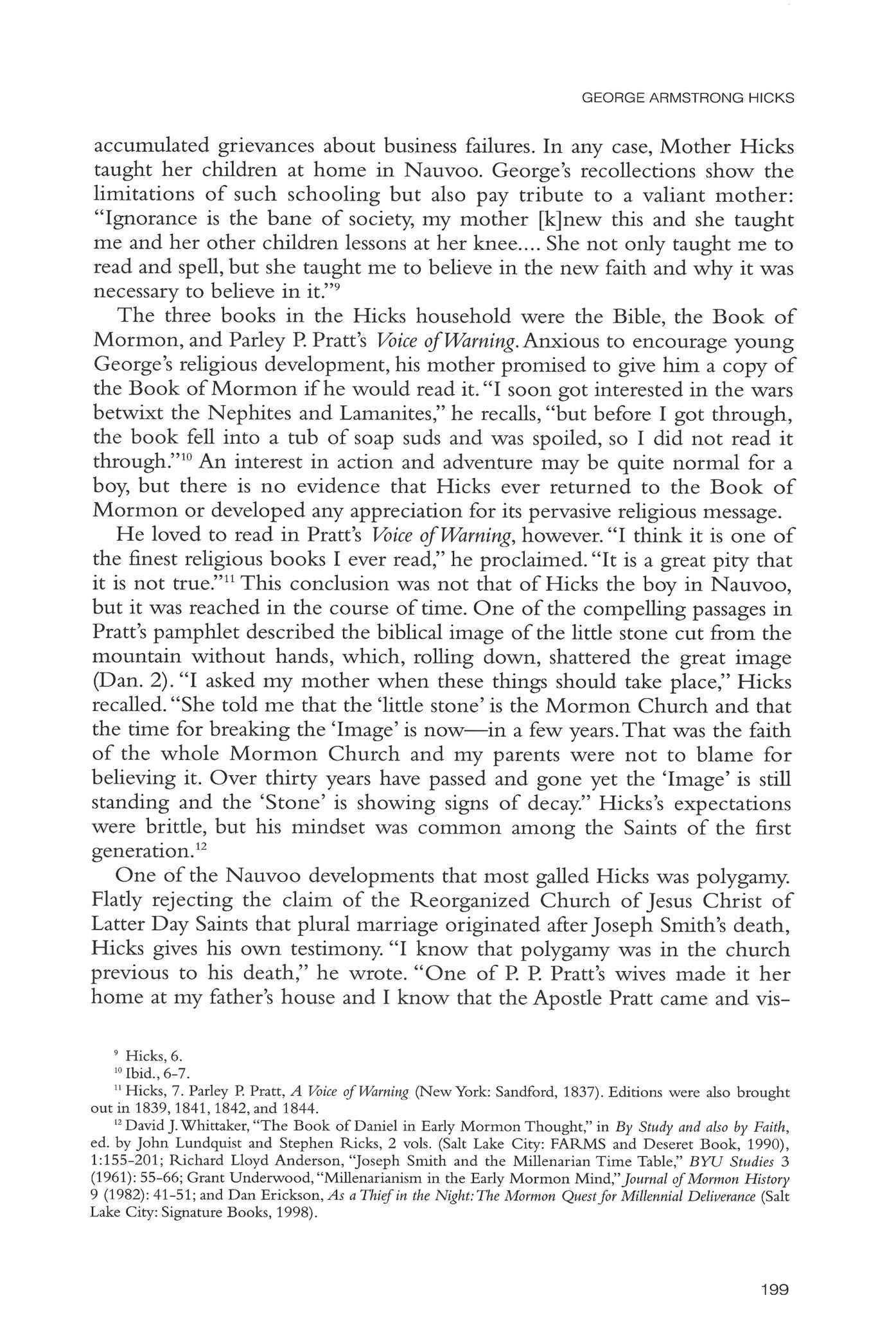
GEORGE ARMSTRONG HICKS
199
UTAH HISTORICAL QUARTERLY
ited her several times.The name of this -woman was Elizabeth Brewerton and I know Pratt had several other wives beside her for I have been to his house and saw them and knew them well."13 Hicks, who was between the ages of eight and ten at the time, tells ofJoseph Smith having the wives of several leading men sealed to him. "At least it -was so -whispered around among the people and I believe the report to be true,"he wrote,passing on the hearsay evidence but giving it his endorsement.14 Hicks pronounces polygamy "the cause"—note the definite article and singular noun—"of the deaths ofJoseph and Hyrum Smith, the 'rock' the church 'came near splitting upon' in the days of...Nauvoo," and a practice that "is and always was disagreeable to the female member of the church." He never had a spiritual testimony of polygamy, he writes, for "it does not bring the peace of mind that accompany the other parts of the Gospel."He flatly rejects the claim that the number of wives,or even marriage itself,had anything to do with eternal salvation Surprisingly, considering all this,he also said,"I as an individual have no particular objections to polygamy I know the laws of nature allow the practice of it and if people of mature judgment wish to practice it I have no objections."15 Hicks in 1878 was one of many Mormons, the majority, who did not practice plural marriage but recognized its origins with Joseph Smith and could not quite bring themselves to ablanket denunciation.
Retaining a sense of loyalty to his parents, to good Mormons he admired, and perhaps even to his earlier faith, Hicks in 1878 tried to have it both ways. He portrayed early Mormonism with some nostalgia. "I have seen Joseph Smith and heard him preach," he wrote. "I believe he, in the beginning of his career was all that he claimed to be, a prophet-seer and revelator, but being mortal he could not bear success."This is the "fallen prophet" analysis,brought forth early by those who abandoned the movement or rejected later developments but also wished to preserve their own integrity by idealizing the teachings they had originally subscribed to For Hicks,Joseph Smith was"really an eloquent preacher of the gospel,"but he had fatal character flaws. "Good and truthful men" had testified that the prophet was "occasionally seen drunk," said Hicks, passing on hearsay evidence.16 The biblical figures Noah and Lot drank wine, Hicks acknowledged, but "it -was certainly no credit to either of them or any of their children after them -who make a practice of drinking to excess."As so often in memoirs, we are served a mixture of rumor, recollection, and value judg-
13 Hicks, 8
14 On Joseph Smith's marriages see Lawrence Foster, Religion and Sexuality:The Shakers, the Mormons, and the Oneida Community (Urbana: University of Illinois Press, 1984);andTodd Compton, In Sacred Loneliness: The Plural Wives ofJoseph Smith (Salt Lake City: Signature Books, 1997) Reservations about Compton's work are expressed by Richard LloydAnderson, Scott H Faulring,and DanelW Bachman in Farms Review of Books 10 (1998):67-137

15 Hicks,9.
16 Ibid., 10 Cf LaMar Petersen, Hearts Made Glad: The Chargesof Intemperance against Joseph Smith, the Mormon Prophet (Salt Lake City:privately published, 1975)
20 0
GEORGE ARMSTRONG HICKS
ment, the latter inextricably tangled with the attitudes of the older man of 1878,a confirmed teetotaler
"I have heard my father say that he was present at the time when it is said that the mantle of Joseph fell upon Brigham Young," Hicks wrote, implying that he himself-was not present at the crucial meeting of August 8, 1844 Surprisingly, considering the strong antipathy he had developed toward Young by 1878, he reflects the faithful believer's response to the event:"I believe it,I believe the spirit ofJoseph took possession of the body ofBrigham and spoke to the people through him.Brigham -wasthe man to take the lead."17
But even with some positive statements about the first two presidents of the church, Joseph Smith and Brigham Young, Hicks began accumulating grievances rather early. It was not merely that Joseph Smith partook of alcohol on occasion or married plural wives, although these practices were negative enough in Hicks's view Smith also behaved as a tyrant in excommunicating the author's uncle,John Hicks, on the basis of inaccurate and inadequate evidence;18 erred in ordering the destruction of the Nauvoo Expositor; and was much too fond of political power and military display."I never read of General Peter or Colonel Paul or Major Luke,"Hicks wrote, "but on the contrary Jesus and the Apostle taught the people to 'beat their swords into plowshears [plowshares] and their spears into pruning hooks.'... I think that the Mormon leaders -were at first faithful and honest, but as they became successful they began to be lifted up in the pride of their own hearts and to forget God."19
Indeed, Hicks goes so far as to say the Mormons brought the persecution on themselves. He joins those who charged Orrin Porter Rockwell with attempting to assassinate Governor Lilburn W. Boggs of Missouri in 1842 "I know that it was commonly talked about among the people of Nauvoo," he recalls with all the probative value of hearsay,"that Rockwell did shoot Boggs and the reason he was not killed was because Rockwell put two balls in the gun and that he shot him through a glass window."20 Harold Schindler's thorough biography admits the possibility, even likelihood, of Rock-well's role,but the evidence falls short ofproof."If Rock-well did fire the fateful shot," writes Schindler, "it would appear the decision was of his own making.... In any event, only Rockwell knew the truth of the matter, and he took that with him to the grave."21 For present purposes,
17 Hicks, 11.On this whole question, see Richard S.VanWagoner, "The Making of a Mormon Myth: The 1844 Transfiguration of Brigham Young," Dialogue: A Journal of Mormon Thought 25 (Winter 1995); Reid L Harper, "The Mantle of Joseph: Creation of a Mormon Miracle," Journal of Mormon History 22 (Fall 1996): 35-71; and Lynn Watkins Jorgenson, "The Mantle of the Prophet Joseph Passes to Brother Brigham and theTwelveApostles:A Collective SpiritualWitness," BYU Studies 36 (1996-97): 125-204 In Jorgenson's terminology, Hicks would be asecondhand witness

18 Hicks, 10-11
19 Ibid., 10
20 Ibid., 11-12
21 Harold Schindler, Orrin Porter Rockwell: Man of God, Son of Thunder (Salt Lake City: University of Utah Press,1(
201
UTAH HISTORICAL QUARTERLY
the important point is Hicks's willingness to pass on rumor, believe the -worst,and draw large conclusions.
A heart-rending division in the family occurred in early 1844 when four of Hicks's uncles and his aged grandmother became followers of William Law, who had come out in opposition to Joseph Smith.22 Even though his own parents remained true toJoseph Smith and subsequently to the leadership of BrighamYoung, this was a family fully aware of the criticism then being circulated George Armstrong Hicks adds a personal recollection His father had rented a farm near Nauvoo that, after the author's uncle Samuel Hicks had been burned out of his place at Camp Creek, provided for the two families One night a fat hog was stolen "The next day my father and uncle tracked the parties to Nauvoo but they did not recover the pork." Many chickens were also stolen from the Hicks farm "I presume that many in Nauvoo thought that because my father's folks had most of them left the church and we were living on land that belonged to a gentile, we were no better than apostates and it was no harm to rob us before we followed the Laws to Wisconsin."23 Young George Hicks was about ten at the time
Leaving Nauvoo with the body of the Saints in 1846, Father Hicks sold for four dollars two log houses, one of them filled with wheat. In a borrowed wagon, the family crossed the Mississippi River and started moving westward across Iowa George A Hicks considered the expulsion of the Saints from Nauvoo cruel, and most observers would agree that the persecutors showed little mercy But by 1878, if not before, Hicks blamed the Mormons "If the Mormons had have punished offenders among themselves and have used due diligence to assist officers of the law to catch all who were transgressors against the law we might have been living in Hancock County today and have been at peace with all mankind, but it was otherwise to be."24
During the next eight years, the Hicks family lived either in Iowa or Nebraska. In Bonaparte, Iowa, Father Hicks found employment.When he was stricken with cholera, a physician named Dr.Wyman came seven times and ministered to the patient until he began to recover.When asked how much the bill was,Wyman responded,"Hicks,ifyou will haul me a damned good load of wood I will be satisfied." Although the doctor called himself an infidel, or unbeliever, young George considered him a Christian,"for he 'visited the sick' and 'did unto others as he would have had them do unto him.' His heart was warm and kind he knew how to sympathize with the poor and he felt it was his duty to administer to their sufferings. I am sorry
22 LyndonW Cook,"William Law,Nauvoo Dissenter," BYU Studies 22 (Winter 1982):49-72 Compare Law's earlier attitude in Lyndon W Cook, ed., '"Brother Joseph IsTruly aWonderful Man, He Is All We CouldWish aProphet to Be':Pre-1844 Letters ofWilliam Law," BYU Studies 20 (Winter 1980):207-18

23 Hicks, 12 Cf KennethW Godfrey, "Crime and Punishment in Mormon Nauvoo, 1839-1846," BYU Studies 32 (Winter-Spring 1992): 195-227
24 Hicks, 12
202
GEORGE ARMSTRONG HICKS
there is not more such 'infidels' in the world."25 By the time he was writing this account, George Hicks took some pride in being known as an infidel26 and,looking back,praised those who seemed most like himself.
Characteristically double-minded, Hicks also recalled the intense idealism and spiritual gifts of Mormonism in its early years. Recalling his parents' conversion, he wrote:
I am satisfied that the new beginners in the Mormon Church were as full of faith in the tenates [tenets] of their new faith as were the followers of Jesus and the Apostles. They were full of love that the 'world' was not in possession of The sick were healed, they spoke with new tongues, Devels [sic] were cast out and to the early members in Canada it was no more nor no less than the restoration of the gospel of Christ. So believed my father and mother and they believe it still although 40 years have passed away they have never faltered in their belief that Mormonism is the true and only gospel by which the human family can be saved and brought back into the presence of God.27
While not denying the healings he had witnessed, the Hicks of 1878 gives anaturalistic explanation:
I think we do not understand the principle by which the sick are healed. I think it is more than likely it is the laying on of the hands that heals the sick and not the prayers. I once had a spiritualist lay hands on me for a headache and was healed immediately I believe that any number of healthy persons who were united in their faith might benefit the sick by laying on hands.28
In other words, the healings were genuine, but they had nothing to do with the Mormon priesthood. "It is evident that the priesthood idea has been taken from theJews, and the heathen nations around them,"he wrote "Jesus denounced the priests of the Jews in the powerful language and in my opinion all men -who claim any priesthood from God are nothing but impostures."29 Such a rejection of the very idea of priesthood authority reflects the bitterness of Hickss disappointments by 1878, not his attitude in 1847
Moving to the area of Council Bluffs, Iowa, in June 1847, the Hicks family prospered for about five years.Young George was afflicted -with "fever and ague" each year for a number of-weeks These -were his teenage years He remembered social gatherings during the winter, dancing, and "religious exercises."The Latter-day Saints,he writes,were "full of brotherly love and faith in the future, triumphing of the gospel dispensation." On two different occasions he began school with a teacher but, frustrated by illness,did not continue for more than afew weeks His father brought him "a great many books of romance" to read. He particularly enjoyed the Life
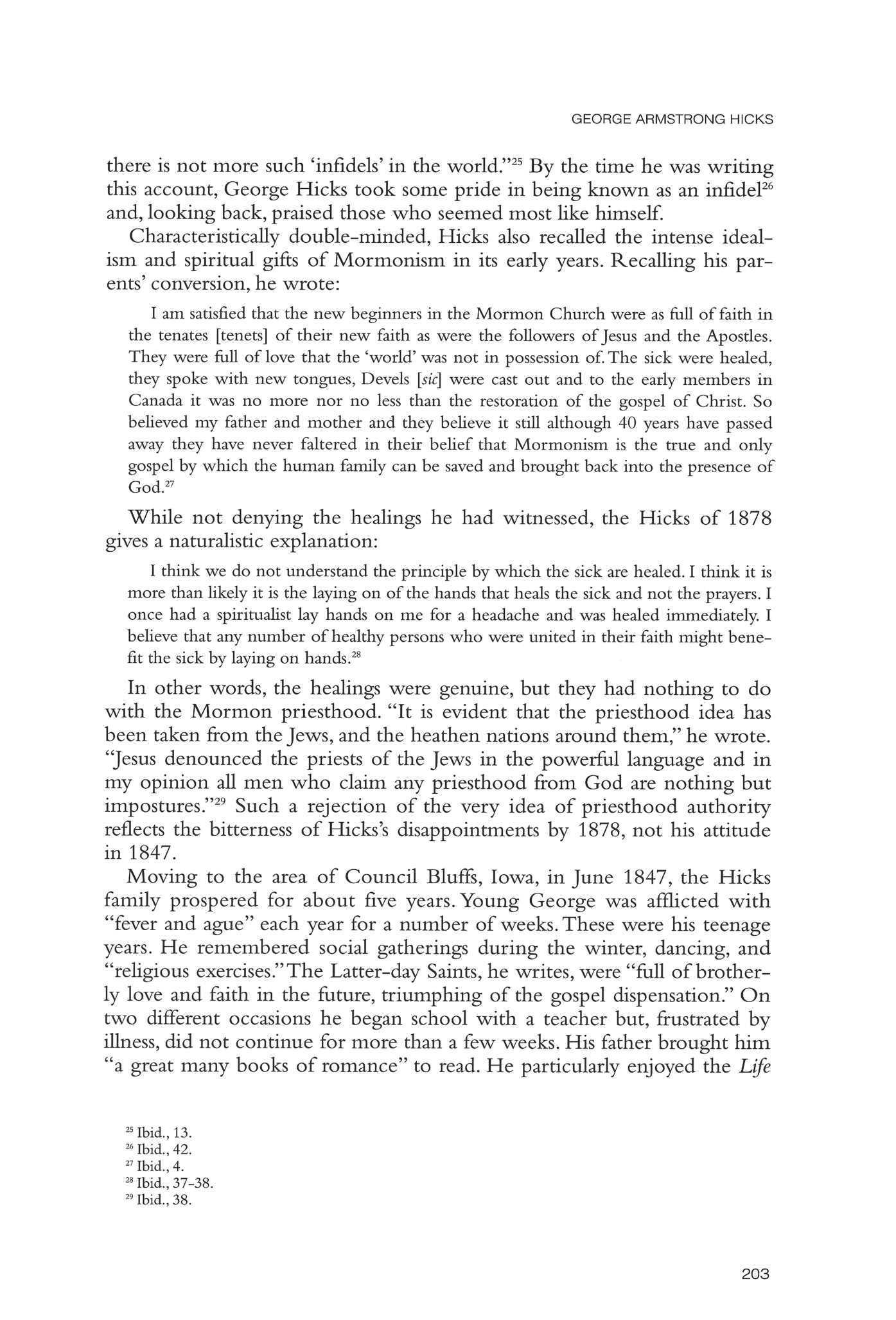
25 Ibid., 13 26 Ibid.,42 27 Ibid., 4. 28 Ibid., 37-38 29 Ibid.,38 203
UTAH HISTORICAL QUARTERLY
of David Crockett.30 Unlike Ignatius Loyola, whose reading three centuries earlier of religious books in the absence of the romances he would have preferred played a crucial part in his conversion experience, Hicks eschewed religious reading in favor of romance and adventure.
Finally, in 1852, the Hicks family joined a wagon train and started for Utah It was not apleasant trip.Thirteen of the company died of cholera "I often saw the ordinance of laying on hands tried to no purpose," Hicks wrote. Buffalo meat was a staple for much of the journey, and young George, now seventeen years old, killed one of the animals himself. Even though he remained convinced that leaving Nauvoo was entirely unnecessary, Hicks allowed some of the optimistic feelings of the time to show through:
We had one ox team and a couple of cows but we had great faith, we believed we were of the chosen of God, that it was our duty to gather out of Babylon while the judgements of God should pass over the nation, and in the past, it has been so for the great rebellion in the U.S which has cost the Nation so much blood and treasure, has 'passed over' the country I think I am safe in saying that Utah has suffered the least of any state or territory in the Union by the war, it would be very hard for me to believe that the gathering of the Mormon people was all the work of chance and fanaticism, "there is a divinity" (I think).31
In these few lines we find a complex mix: recollections of the buoyant spirit of the gathering and ofpredictions about the United States;a boastful claim that the prophecy had been fulfilled; and, with a quote from Shakespeare's Hamlet (act 5,sc.2,line 10),areluctant, tentative acknowledgment of divine guidance of the Mormon westward movement.
In Utah, the Hicks family temporarily camped in the Big Field, a common grazing area,in Salt Lake City Then, after the October church conference of 1852,they made their -way to a new settlement called Palmyra just then being established on the Spanish Fork River.They lived that -winter in a dugout, "made by digging a celler or hole in the ground and putting a roof of willows and earth over it and then making a fireplace inside."32 Most importantly for young George, they met the Henry Bryant Jolley family Elizabeth Jolley was fifteen. During the winter months George and Elizabeth attended school. A frontier Abelard and Eloise, they had a hard time keeping their minds on their class-work."I fear there -was more love making than studying of books,"he -wrote,"for young lovers make bad students of books."33 They attended balls and parties together and the next spring were married. He hadjust turned eighteen.
30 Ibid., 16
31 Ibid
32 Ibid., 20 Cf Elisha Warner, The History of Spanish Fork (Spanish Fork, UT: Press Publishing Company, 1930),34-50
33 Ibid "I was a student in the school of Mr [Silas] Hillman, and graduated at the end of the first quarter with 'high honors'being able to read in theTestament or the Book of Mormon without making many mistakes in the Pronounciation [sic] of words; with a very limited knowledge of arithmetic and none whatever of grammar or history"; George A Hicks, "History of Spanish Fork," 4, typescript, Special
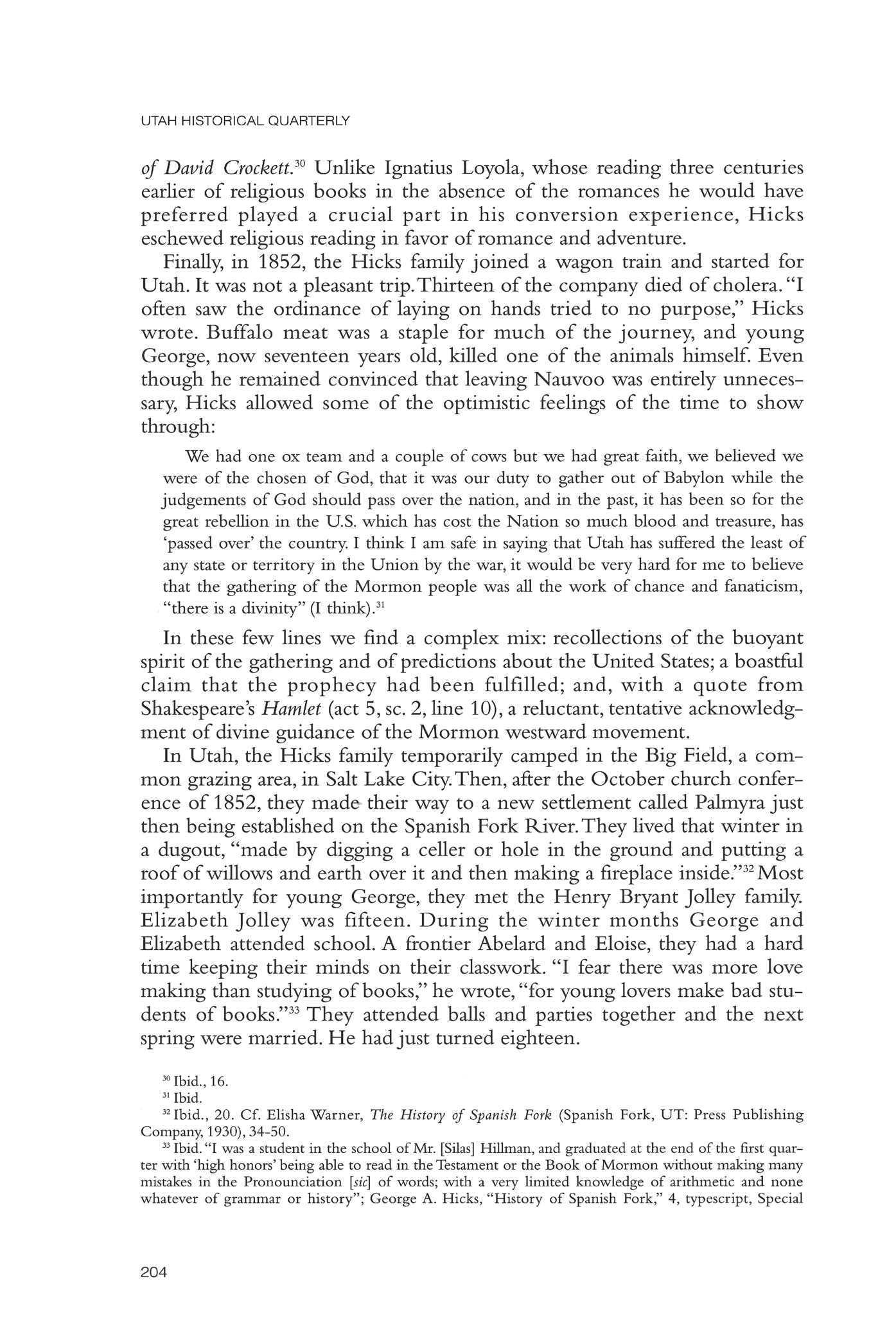
20 4
Writing in 1878, Hicks characteristically idealized the earlier phases of church history in contrast to the deplorable state of affairs later on.For him, fervor andfaith characterized thenewconverts in Canada, the Saints in the vicinity ofWinter Quarters, and the impoverished settlers in Utah County.The dances were atime offun andlaughter.The religious meetings were filled with the spirit of testimony. "Many a manandwoman I have hear[d] say they knew this church to be the work of God for Godhad revealed it to them," Hicks wrote "I have often heard them speak with 'new tounges' and prophecy of things that would yet come to pass. The church wasfull ofthe 'first love' andthe spirit which prom[p]ted them to leave their homes was notyetdead."34
Continuing his description of life in early Palmyra, Hicks describes clashes with the Indians, mixing factual narration with ridicule Brigham Young had described the Indians as "the Lord's battle axe," but, Hicks writes, "it seemed that the Devil generally got the handle in hisown hands and turned the edge the wrong waywhich was construed by our leaders to a whip to scourge us into obedience to the will of God (Brigham Young)."35 Hicks participated with the militia in several campaigns, acted asinterpreter in thenegotiations, andsmoked thepeace pipe with onegroup ofIndian leaders.36
In the spring of 1854"a shower of grasshoppers" descended on the crops In 1855 themillions ofeggs deposited theprevious year hatched,and most of the grain wasdestroyed. "The 'hoppers' ate all that wasgreen on the Spanish [Fork] River bottom except some large boxelder trees andon the benches near the river there was not a green thing to be seen."The cynical Hicks of1878 could notresist getting offajab:
If it were asked where was our prophet that he did not tell us how to fight the hoppers the answer is his inspiration did not lead to anything useful but he told us that the grasshoppers were the Lord's army and that God's judgments must commence at the house of God and we believed him correct The blind lead the blind and we all fell into the ditch together."37
The year 1856 brought a series ofbody blows to thefaith ofGeorgeA Hicks First,when itbecame apparent that irrigation caused alkali to rise to the surface and destroy the crops, Brigham Young told the people of Palmyra their settlement waspoorly located andinstructed them to move to Spanish Fork.38 Hicks didnotchallenge therightness ofthis decisionbut
Collections, Harold B Lee Library,BrighamYoung University This history was dated byitsauthor on June 13,1913
34 Hicks,21
35 Ibid.,28.
36 By 1913 hewas able togive some credit toBrighamYoung forurging thesetders to construct a fort Hicks,"History ofSpanish Fork."

37 Hicks, 29 Cf Davis Bitton andLinda P.Wilcox, "Pestiferous Ironclads:The Grasshopper Problem in Pioneer Utah," Utah Historical Quarterly 46(Fall 1978):335-55
38 Andrew Jenson, Encyclopedic History of the Church ofJesus Christ of Latter-day Saints (Salt Lake City: Deseret News Publishing Co., 1941),631
GEORGE ARMSTRONG HICKS
20 5
UTAH HISTORICAL QUARTERLY
did blame "the 'inspired' idiots" responsible for the original site selection "The city of Palmyra -was located by George A Smith," he -wrote, "and -we went to work in full faith under his instructions and we labored hard for three years before our leaders found out -we -were in the wrong place."When Smith, speaking in the school house, had promised the settlers that "eye hath not seen nor ear heard neither hath it entered into the heart of man, the greatness that is in store for the citizens of Palmyra," Hicks "thanked God that -we had an inspired priesthood that could tell us the future while the gentiles had to grovel in darkness."39 Of course, the fond hopes were not realized Those who had listened to "the 'inspired' raving of the 'man of God' had the 'satisfaction' of losing all their buildings for water began to raise in the cellars of the houses and we must move and lose nearly two years work. I lost a house that cost me $300 in hard labor and I never lived in it an hour."40 His respect for the church leaders was crumbling.
Mormon apostle GeorgeA. Smith was for a time the church leader in Utah County.
Of great weight in influencing his attitude -was the tragedy of the 1856 handcart companies Of these he mentions only the Martin Company, which, along with the Willie Company, experienced the worst suffering "Their leaders prophesied that the Lord would turn the storms to the right hand and the left and that they should be brought through the mountains like the children of Israel were brought through the Red Sea," Hicks wrote Because of a late departure and an unusually early onset of winter, however, the Martin Company ended disastrously, with many deaths and much suffering Ignoring extenuating circumstances or the unpredictable features of the 1856 crossings, Hicks, writing twenty-two years later, is unforgiving in his commentary on the handcart companies: "It was said that they were kept there in order to make money out of them I think B
39 Hicks, 20-21. "Apostle Smith made wonderful predictions in regard to the future and greatness of Palmyra, which, to put it mildly, never materialized"; Hicks, "History of Spanish Fork." On George A Smith, with recognition that he sometimes lacked sensitivity as a leader, see Merlo J Pusey, Builders of the Kingdom: George A.Smith, John Henry Smith, George Albert Smith (Provo, UT: Brigham Young University Press, 1981),80-85
40 Hicks, 21 In 1913 he wrote more fully of the sandy loam that made Palmyra undesirable for farming, the efforts of the settlers to obtain permission to relocate, George A Smith's adamant refusal, and BrighamYoung's wise approval "Four long trying years we worked there under trying circumstances All the improvements we had made in those four years in the form of homes was a total loss, and all because we had listened to bad advice.The writer of this essay had just finished putting on the roof of a house in the fort when the counsel came from headquarters to leave Palmyra That house cost two hundred and fifty dollars in labor, I having hauled rock from the mountains for a foundation"; Hicks, "History of Spanish Fork," 13
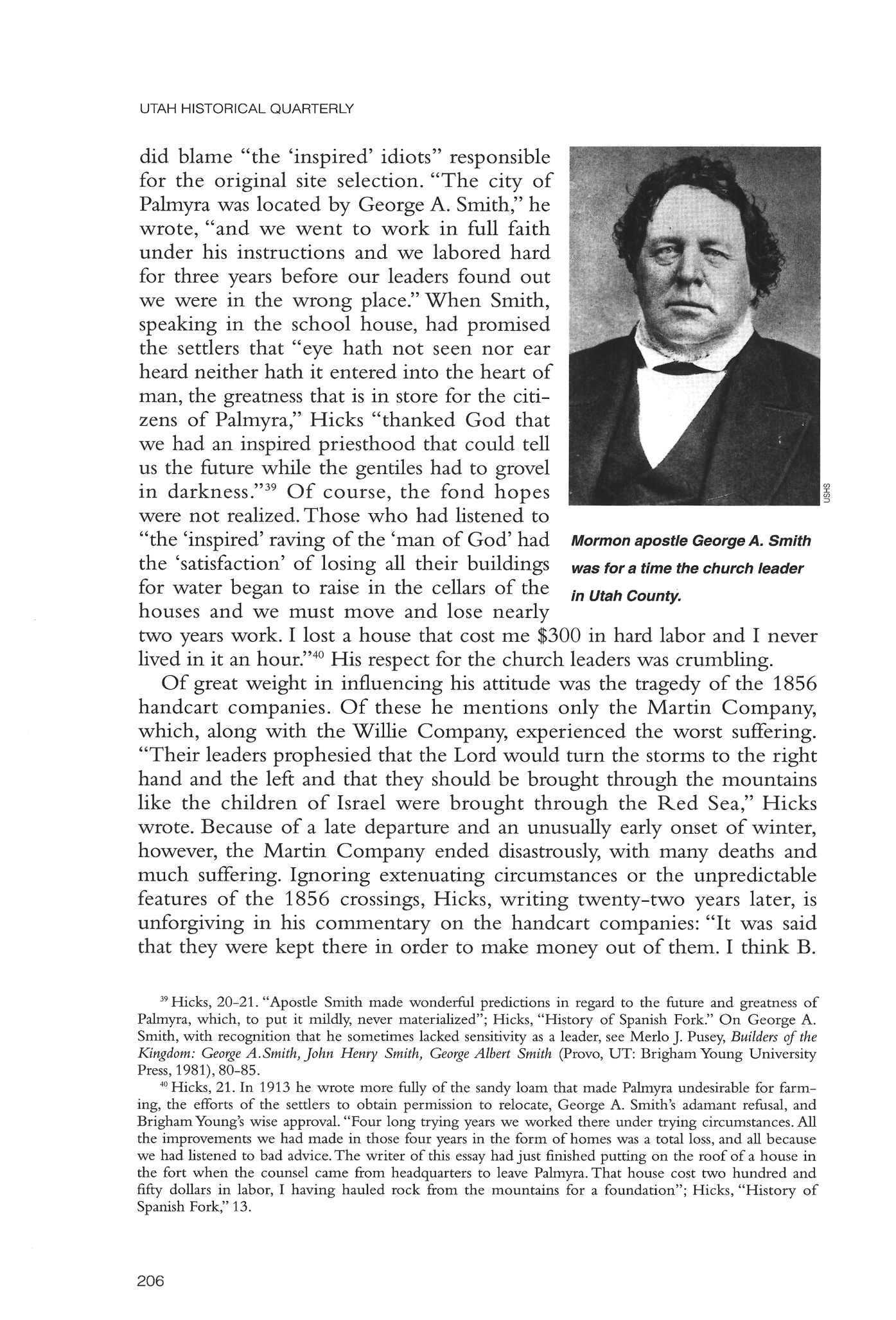
206
Young wished to try an experiment on human indurance [sic] and he did."41
It was the handcart tragedies more than anything else, he explains, that had the effect of"completely revolutionizing" his mind:
At that time I believed that the universe was governed by the will of a supreme being and that he kept the whole human family under his eye as it were and meted out to all according to their needs as a good father would do for his children and "that the righteous were never forsaken." These poor hand cart companies called upo n Go d twice every day; they sang psalms to his praise as they traveled along they hoped; they trusted in him but all in vain I do not believe that "God " will ever have a better opertunity to help our suffering humanity than then. The truth is the universe is governed by laws immutable and unchangeable I have read many books wri[t]ten by "Christian" authors in which they have tried to prove that nature's Laws have been suspended for the Christians special benefit, but I have never known a single instance of divine interposition contrary to known laws of the universe.42
In Hicks's version of the traditional problem of evil, God had simply not come through in the clutches.
Already stewing with resentment, Hicks was further distressed by the Mormon Reformation of 1856-57, a revival movement that he described as"the cause of a great deal of evil and no doubt some little good."Writing in 1878,he portrays BrighamYoung as a power-hungry "atheist" who used the revival "to crush out all vestage of free thought and selfhood."43 But during the 1850s Hicks drank in the fervent preaching and even had a spiritual experience himself.At a testimony meeting where someone spoke in tongues and another person gave the interpretation, he was the next speaker.
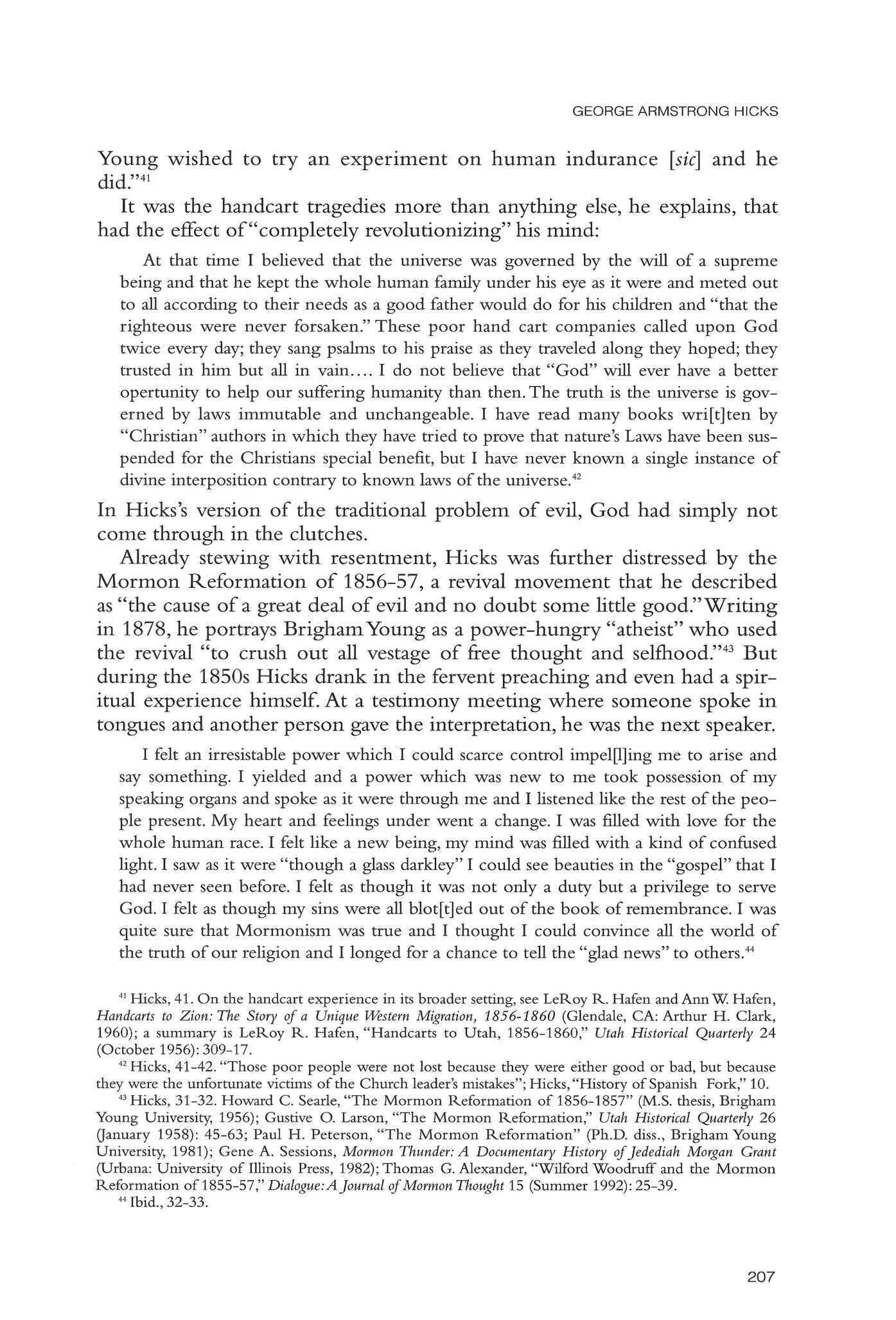
I felt an irresistable power which I could scarce control impellin g me to arise and say something I yielded and a power which was new to me took possession of my speaking organs and spoke as it were through me and I listened like the rest of the people present M y heart and feelings under went a change I was filled with love for the whole human race. I felt like a new being, my mind was filled with a kind of confused light I saw as it were "though a glass darkley" I could see beauties in the "gospel" that I had never seen before. I felt as though it was not only a duty but a privilege to serve God I felt as though my sins were all blot[t]ed out of the book of remembrance I was quite sure that Mormonism was true and I thought I could convince all the world of the truth of our religion and I longed for a chance to tell the "glad news" to others.44
41 Hicks,41 On the handcart experience in its broader setting,see LeRoy R Hafen andAnnW Hafen, Handcarts to Zion: The Story of a Unique Western Migration, 1856-1860 (Glendale, CA: Arthur H. Clark, 1960); a summary is LeRoy R Hafen, "Handcarts to Utah, 1856-1860," Utah Historical Quarterly 24 (October 1956):309-17
42 Hicks, 41-42 "Those poor people were not lost because they were either good or bad, but because they were the unfortunate victims of the Church leader's mistakes";Hicks,"History of Spanish Fork," 10
43 Hicks, 31-32 Howard C Searle,"The Mormon Reformation of 1856-1857" (M.S thesis, Brigham Young University, 1956); Gustive O. Larson, "The Mormon Reformation," Utah Historical Quarterly 26 (January 1958): 45-63; Paul H Peterson, "The Mormon Reformation" (Ph.D diss., Brigham Young University, 1981); Gene A Sessions, Mormon Thunder: A Documentary History ofJedediah Morgan Grant (Urbana: University of Illinois Press, 1982);Thomas G.Alexander, "Wilford Woodruff and the Mormon Reformation of 1855-57," Dialogue:A Journal of Mormon Thought 15 (Summer 1992):25-39
44 Ibid., 32-33
GEORGE ARMSTRONG HICKS
20 7
UTAH HISTORICAL QUARTERLY
The Hicks of 1878, unsure of the source of the power he then felt, announced that there was "a strong similarity between all religious revivals," and "man has made the distinction in all churches."45 Yet he remained a believer in spiritual things. He had witnessed many examples of speaking in tongues and interpretation. In fact, he had an experience that convinced him of the validity of this spiritual gift:
I believe it is a spiritual manifestation I believe that the spirit of someone wh o has departed this life takes possession of the speaker and speaks through them I never have spoken in tongues, but I have given the interpretation and I know there is a power or a spirit connected with it I felt after hearing the "tongue" I felt a strong desire to arise and speak to which I yealded and I did so when I had commenced to speak I lost all control of myself and became a listener as the "spirit gave me utterance" and when the spirit had said what it had to say I was left to exercise my own will and to wonder at the manifestation I presume the gift of tongues is the same as the interpritation We know it is a power but what is it we know not. To me it is a strong proof of the truth of the spiritual gifts spoken of in the second chapter of the Acts of the Apostles.46
During the 1850s, in other words,young Hicks joined in the fervor but, writing some twenty years later, had second thoughts and tried to "explain away" his earlier reactions In describing the reformation, Hicks's favorite word was "fanatical," but, admitting that he himself partook of the spirit to some extent, he explained,"I am only human."47

Looking back, he was particularly troubled by three ideas associated with the preaching of 1856-57. First,he recalled, the claim that Adam was a God was preached vigorously. In his unflattering description of the doctrine, it melded naturally into the notion of possible deification of humans."It was surprising how eagerly these fanatics grasped the idea, [that] we were all gods in embryo."And the doctrine was used by some to support giving a kind of"divine" status to church leaders."Father Adam was the great God of this world," said one Mormon enthusiast in Hicks's recalled version. "[H]e (Adam) was Jesus Christ's God and Jesus is Br.Joseph Smith's God and Br.Joseph is brother Brigham's God and Br.Brigham is BishopJohn T. Butler's God and John T Butler is your God do you hear it breathren?" About half of the Mormon people did not believe these doctrines, Hicks estimated, "but people dare not get up and dispute them for who knows who is God or where he dwells."48
Second, polygamy was pushed to the extent that some teachers considered it "the most prominent point of their faith."49 Hicks had already described in negative terms the practice in Nauvoo Now he accumulated
47
48 Ibid See Culley K Christensen, M.D., The Adam-God Maze (Scottsdale,AZ: Independent Pubhshers, 1981); and, for the current official understanding, Arthur A Bailey,"Adam," Encyclopedia of Mormonism, 4 vols (NewYork:Macmillan, 1992), 1:15-17
49 Hicks,34
45 Ibid.,33
46 Ibid.,37
Ibid.,33.
20 8
additional horror stories.Besieged "by men old enough to be their fathers," girls as young as thirteen -were sealed to men "three times their own age." Combined with the vigorous promulgation of plural marriage, he writes, was the granting of easy divorces. "I have heard it said," he writes while admitting his inability to confirm the rumor, "that during the two years while the 'Reformation' -was raging that there were 1,500 marriages in Utah and that the year after there were 1,700 divorces given by B.Young to dissatisfied parties." Not more than a tenth of the reformation plural marriages were still intact a year later, Hicks claims.The ten-dollar charge for a certificate of divorce must have been "a very lucrative business" for Brigham Young, Hicks thought, remembering what he paid to get such a document for his sister "O for Shame that men -will suffer the love of gold to canker their souls that the[y] will take advantage of the ignorant to get gain."50 Despite these negative reactions, Hicks continued to admire some of those who practiced polygamy, including his father-in-law and his bishop in early Palmyra, Stephen Markham.51
Third, in Hicks's view, the doctrine of blood atonement—that certain sins were of sufficient gravity to require the shedding of one's own lifeblood—was used to justify the killing of apostates and enemies of the church He cites examples of extreme preaching during the Mormon Reformation.52 Against the backdrop of this heated rhetoric, unsolved murders could easily be charged to the Mormons, and Hicks joins in the chorus:"Many were the victims that fell by the hand of the destroyer, but not one in Spanish Fork City My wife and myself both saw the blood of the Parrishes at Springville two days after the murders Those were truly peralous times such as only fanatics know how to bring on a country."53 In a more sweeping allegation, he writes,"With the single exception of Spanish Fork City, I do not know a city that had an existence in Utah that has not shed the blood of from one to many victims."54 It is surely not quibbling to imagine Hicks on the -witness stand being asked the basis for his knowledge of all these cities and perhaps being asked -whether he included legal execu-
50 Ibid See Eugene E Campbell and Bruce L Campbell, "Divorce among Mormon Polygamists: Extent and Explanations," Utah Historical Quarterly 46 (Winter 1978), 4-23 A calmer description of marriage during the Reformation is inWilliam G Hartley, My Bestfor the Kingdom: History and Autobiography of John Lowe Butler, a Mormon Frontiersman (Salt Lake City:Aspen Books, 1993),302-305
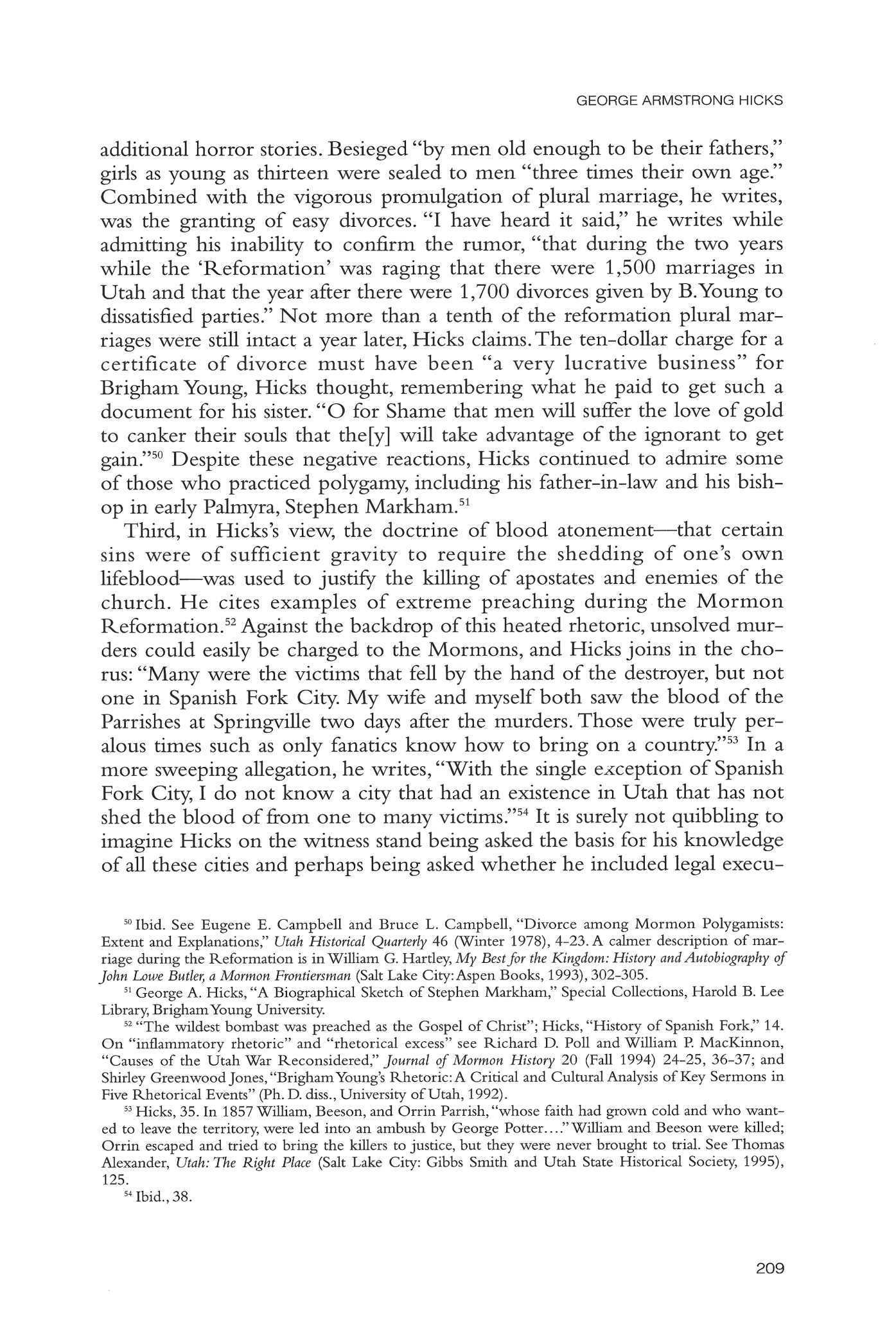
31 George A Hicks,"A Biographical Sketch of Stephen Markham," Special Collections, Harold B Lee Library,BrighamYoung University.
52 "The wildest bombast was preached as the Gospel of Christ"; Hicks,"History of Spanish Fork," 14. On "inflammatory rhetoric" and "rhetorical excess" see Richard D Poll and William P MacKinnon, "Causes of the Utah War Reconsidered," Journal of Mormon History 20 (Fall 1994) 24-25, 36-37; and Shirley GreenwoodJones,"BrighamYoung's Rhetoric:A Critical and Cultural Analysis of Key Sermons in Five Rhetorical Events" (Ph D diss.,University of Utah, 1992)
53 Hicks, 35 In 1857William, Beeson, and Orrin Parrish,"whose faith had grown cold and who wanted to leave the territory, were led into an ambush by George Potter...."William and Beeson were killed; Orrin escaped and tried to bring the killers to justice, but they were never brought to trial See Thomas Alexander, Utah: The Right Place (Salt Lake City: Gibbs Smith and Utah State Historical Society, 1995), 125.
54 Ibid.,38
ARMSTRONG HICKS
GEORGE
209
UTAH HISTORICAL QUARTERLY
tions in his calculations. Mormons have insisted that blood atonement, by necessity a voluntary action, wasnever carried out in practice.55 But from the late 1850s on,anti-Mormons developed a series of indictments used over andover again when denouncing Mormonism.The concept of blood atonement, imperfectly understood, was especially calculated to arouse horror and indignation Critical of the preaching rhetoric of some church leaders during the 1850s,Hicks wasdrawn into another rhetorical network by 1878,that ofthe anti-Mormons.
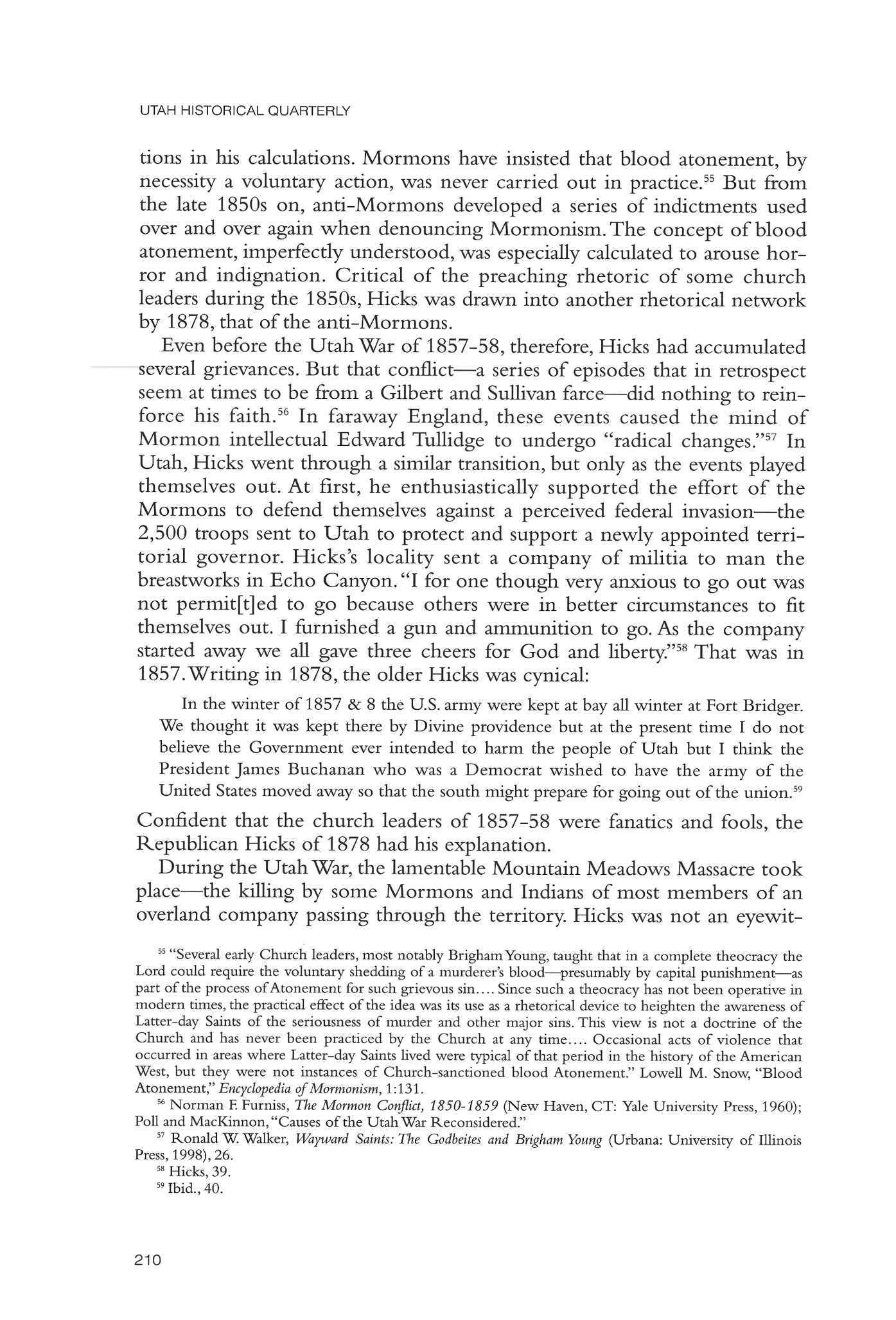
Even before theUtahWar of 1857-58,therefore, Hicks had accumulated several grievances. Butthat conflict—a series ofepisodes that in retrospect seem attimes tobefrom aGilbert andSullivan farce—did nothing to reinforce his faith.56 In faraway England, these events caused the mind of Mormon intellectual Edward Tullidge to undergo "radical changes."57 In Utah, Hicks went through asimilar transition, butonly astheevents played themselves out.At first, he enthusiastically supported the effort of the Mormons to defend themselves against a perceived federal invasion—the 2,500 troops sent to Utah to protect andsupport anewly appointed territorial governor. Hicks's locality sent a company of militia to man the breastworks inEcho Canyon."Iforonethough very anxious to goout was not permit[t]ed to go because others were in better circumstances to fit themselves out.I furnished a gunandammunition to go.As the company started away we all gave three cheers for God and liberty."58 That wasin
1857.Writing in 1878,theolder Hicks was cynical:
In the winter of 1857 & 8 the U.S army were kept at bay all winter at Fort Bridger
We thought it was kept there by Divine providence but at the present time I do not believe the Government ever intended to harm the people of Utah but I think the President James Buchanan who was a Democrat wished to have the army of the United States moved away so that the south might prepare for going out of the union.59
Confident that the church leaders of 1857-58 were fanatics andfools, the Republican Hicks of1878 hadhis explanation
During theUtahWar, thelamentable Mountain Meadows Massacre took place—the killing by some Mormons andIndians ofmost members ofan overland company passing through the territory. Hicks wasnot an eyewit-
55 "Several early Church leaders, most notably BrighamYoung, taught that in acomplete theocracy the Lord could require thevoluntary shedding ofa murderer's blood—presumably by capital punishment—as part ofthe process ofAtonement forsuch grievous sin.... Since such atheocracy has notbeen operative in modern times,thepractical effect ofthe idea was itsuseasarhetorical device toheighten theawareness of Latter-day Saints of the seriousness of murder and other major sins This view is not a doctrine ofthe Church and has never been practiced by the Church at any time... Occasional acts of violence that occurred in areas where Latter-day Saints lived were typical ofthat period inthehistory ofthe American West, but they were not instances of Church-sanctioned blood Atonement." Lowell M. Snow, "Blood Atonement," Encyclopedia of Mormonism, 1:131
56 Norman F Furniss, The Mormon Conflict, 1850-1859 (New Haven, CT: Yale University Press, 1960); Poll andMacKinnon,"Causes ofthe UtahWar Reconsidered."
57 Ronald W Walker, Wayward Saints: The Godbeites and Brigham Young (Urbana: University of Illinois Press, 1998),26.
58 Hicks,39
59 Ibid., 40
210
GEORGE ARMSTRONG HICKS
ness, and his version of the event -was obviously colored by later experiences. But he -writes the following about a company that passed briefly through Spanish Fork about the same time as the ill-fated Fancher train:
In the summer of 1857 I saw the Dukes company pass through Spanish Fork City on its way to California they were well fit[t]ed out with good wagons and teams They were quiet and orderly as far as I know although I have since heard many evil things against them. They were that same that was so cruely murdered at Mountain Meadows.
I went to them and tried to sell them flour and potatoes but was told that they did not need any supplies I have often heard it said that this company could not purchase provisions in any settlements as they passed through. I know the statements to be false.60
He appears to be a -witness against the charge that the Mormons had viciously refused food needed by the train, but he confused the Dukes and the Fancher companies. Others may have done so as well, for the Dukes company, like the Fancher party, was made up largely of people from Missouri andArkansas.51
Totally incompetent as a witness to the massacre itself—he was nowhere near the scene—Hicks characteristically blamed the church authorities, specifically BrighamYoung It wasYoung, he charged, who sent the settlers to Dixie, started "cooperation" in order to collect more tithing, and even recommended the Cotswold breed of sheep, -which turned out badly for their owners.This "devil" theory had become Hicks's convenient explanation by 1878 but, so far aswe can tell,was not his stated belief in the 1850s Already festering, his defiant reaction to the church took decisive shape in the 1860s.62
In 1861,three years after the conclusion of the UtahWar, Hicks moved with his family to Pond Town (Salem) in Utah County, where his fatherin-law, Henry BryantJolley,was bishop.Still devout, Hicks hoped to obtain a recommend so that his marriage could be sealed in the Endowment House Before this could occur, however, Hicks was among those called in 1861 to settle in southern Utah—the Dixie Mission. Bishop Jolley and all his sons and sons-in-law were included in the assignment. Selling his property for about half what he had paid for it a few months earlier, Hicks joined theJolley company and moved south in late November Betraying a negative attitude,he describes himself ashaving a"heavy heart" even before starting.63
The journey south-ward was no picnic. Driving cattle and sheep, the
60 Ibid.,39.
61 A document complaining of their treatment by the Mormons was signed byWilliam C Dukes and twenty-five members of his company; LosAngeles Star, November 7, 1857.1 am indebted for this reference to Professor Lawrence Coates, Ricks College, whose detailed study identifies several trains that passed through southern Utah
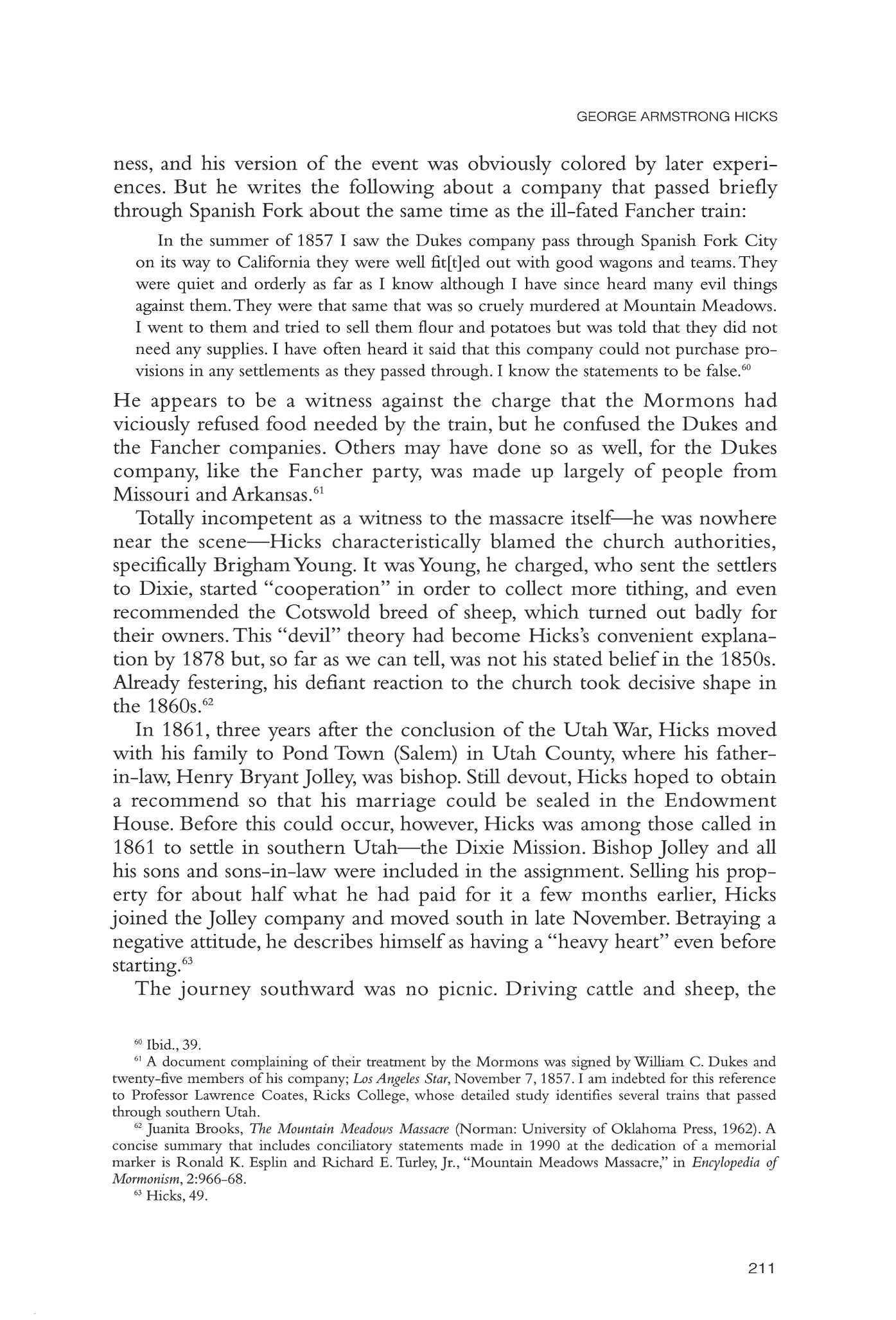
62 Juanita Brooks, The Mountain Meadows Massacre (Norman: University of Oklahoma Press, 1962) A concise summary that includes conciliatory statements made in 1990 at the dedication of a memorial marker is Ronald K Esplin and Richard E Turley,Jr., "Mountain Meadows Massacre," in Encylopedia of Mormonism, 2:966-68
63 Hicks,49
211
UTAH HISTORICAL QUARTERLY
company finally reached Black Ridge and camped for the night. Unfortunately, an unusual storm brought some two feet of snow accompanied by a terrible wind of gale proportions. The draft animals wandered from camp and were not found until more than a week later. Although invited by nearby residents to settle in Harmony, Bishop Jolley insisted on carrying out his instructions "to the very letter." So they made their way southward to Washington. The ground was "dry and dusty," -wrote Hicks. "We -were at the end of our journey in a sickly and barren land with very little to go upon."64
In 1864, Hicks wrote "Once I Lived in Cottonwood," which he called "A Ballad of Our Dixie," a lyric intended to be sung to the tune of "GeorgiaVolunteer." In twelve stanzas, he recounts the call to settle Dixie, the miserable journey, and his disappointment with his new location. Four stanzas convey the main idea and emotion:
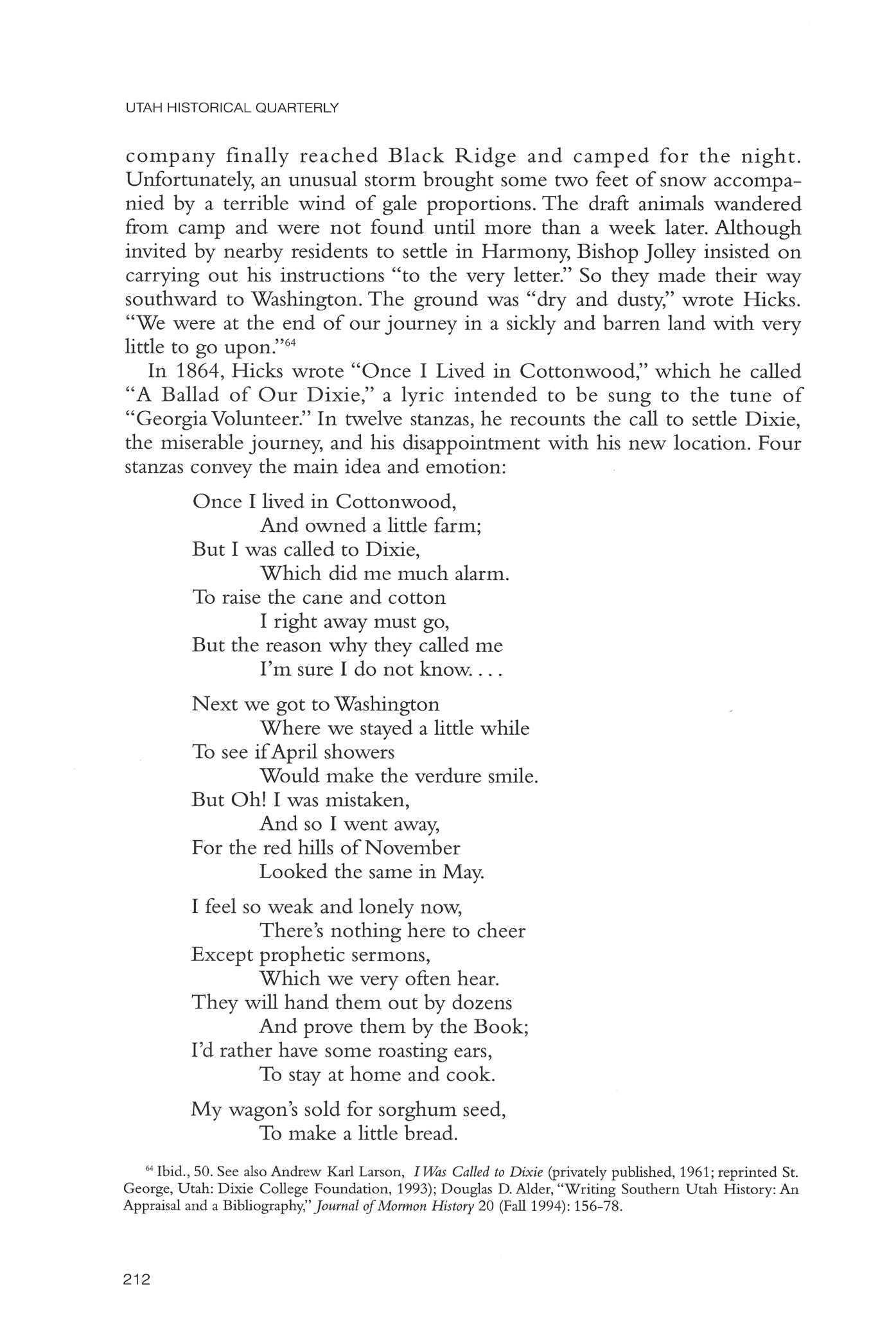
Once I lived in Cottonwood, And owned alittle farm; But I -wascalled to Dixie, Which did me much alarm.
To raise the cane and cotton I right away must go, But the reason why they called me I'm sure I do not know..
Next -wegot to Washington
Where we stayed alittle while To see ifApril showers Would make the verdure smile. But Oh! I was mistaken, And so I went away, For the red hills of November Looked the same in May.
I feel so weak and lonely now, There's nothing here to cheer Except prophetic sermons, Which we very often hear. They will hand them out by dozens And prove them by the Book; I'd rather have some roasting ears, To stay at home and cook.
My wagon's sold for sorghum seed, To make alittle bread
64 Ibid., 50 See alsoAndrew Karl Larson, I Was Called to Dixie (privately published, 1961;reprinted St George, Utah: Dixie College Foundation, 1993); Douglas D Alder,"Writing Southern Utah History: An Appraisal and aBibliography," Journal of Mormon History 20 (Fall 1994): 156-78
212
And poor oldJim and Bolly
Long ago are dead
There's only me and Betsy left
To hoe the cotton tree; May heaven help the Dixieite
Wherever he may be!65
Although some leaders objected to its negativism, the song became popular in the settlements of southern Utah."If the authorities feared the song would breed discontent among the hungry settlers of Dixie," writes Andrew Karl Larson, "they were mistaken It gave them a chance to face their troubles and laugh at them." In Larson's view the poem -was"good-humored, hilarious cynicism" and "good-natured raillery."66
In the small settlement of Washington, Hicks was able to acquire a lot on which he erected a"brush wickup." Here ababy,JamesW, was born to Betsy Already resenting the call that had brought him to a desolate location, Hicks now accumulated additional grievances.Apostle Erastus Snow,leader of the colonization effort, refused a request for flour, saying he could not feed everyone,and advised the settlers to plant "all the cane and cotton we could possibly manage."When the market for these crops turned out to be poor, Hicks of course blamed Snow."I think there is no set of men except lightning rod Agents and commercial Drummers," he wrote, "that have the cheek of Mormon Apostles."67 When BrighamYoung tried to improve the situation by constructing a cotton factory, Hicks admitted that the factory provided employment and "proved a great benefit to the poor of Washington County," but he complained about the quality and price of its product.68
Discouraged, Hicks then moved to Harmony, where Bishop Jolley had established himself.Again Hicks built a wickiup but it accidentally burned down Hiring out as alaborer to grub sage,he got some corn in return He planted four acres of corn, potatoes, sorghum, and other vegetables, but a cow broke through the fence, and a herd of sheep proceeded to "waste" the crops.Living on the edge of starvation,Hicks had no choice but to hire out as a laborer to better-established settlers, who, in his view, underpaid him
63 See other verses in Thomas E Cheney, Mormon Songs from the Rocky Mountains: A Compilation of Mormon Folksongs (Austin, University ofTexas Press, 1968), 118-20 On May 1, 1870, the song was published in a Salt Lake City humor magazine called the Keepapitchinin.
66 Larson, IWas Called to Dixie, 76.See also Our Pioneer Heritage 1 (1964):595.
67 Hicks,52
68 Ibid On theWashington cotton factory, see Leonard J Arrington, Great Basin Kingdom (Cambridge: Harvard University Press, 1958),219-20, 318-19.
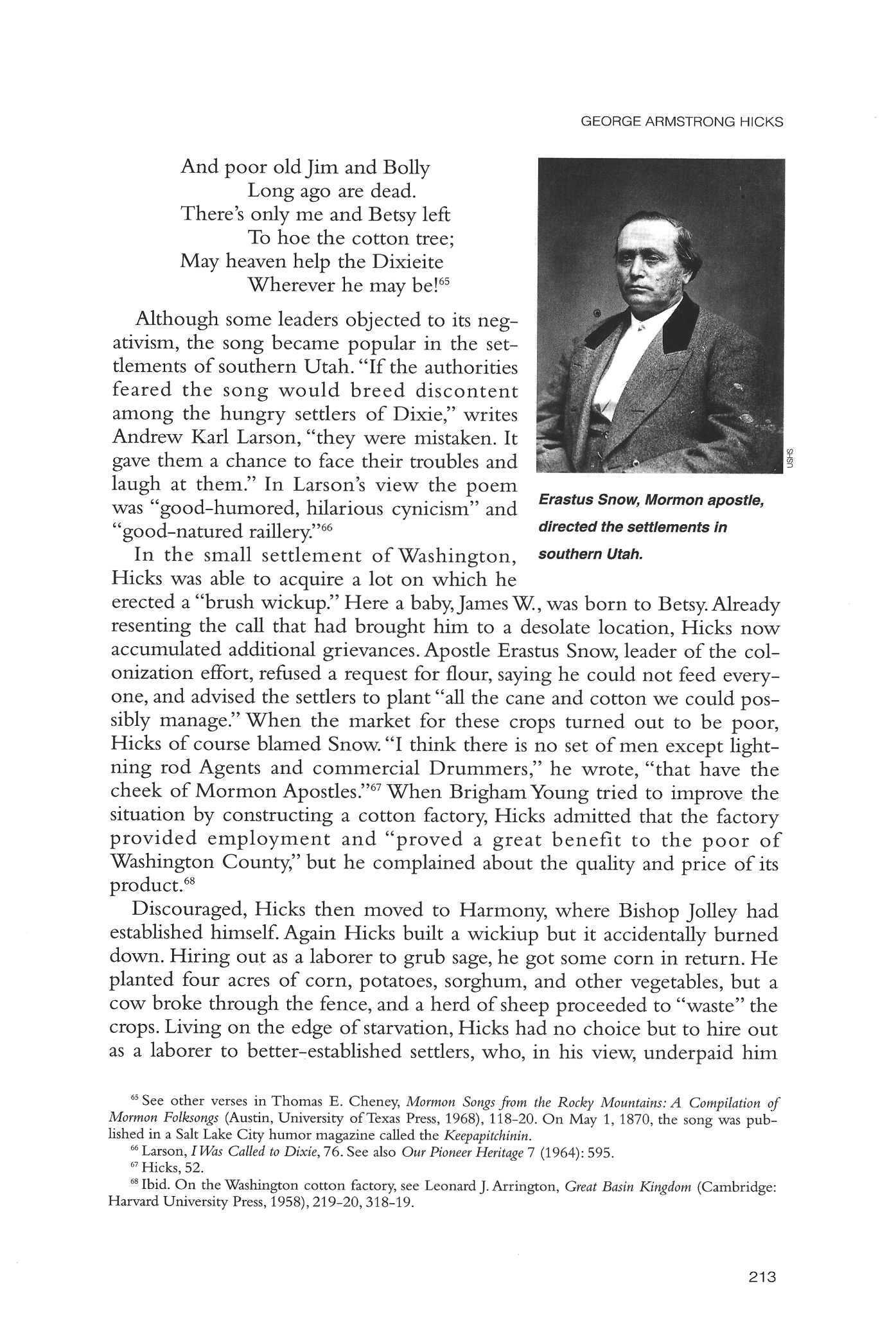 GEORGE ARMSTRONG HICKS
Erastus Snow, Mormon apostle, directed the settlements in southern Utah.
GEORGE ARMSTRONG HICKS
Erastus Snow, Mormon apostle, directed the settlements in southern Utah.
213
UTAH HISTORICAL QUARTERLY
and took advantage of him When Brigham Young encouraged the establishment of cooperatives—part of a program intended to assist the entire territory to be more self-sufficient—Hicks was confident that the motivation was greed, as the church could collect tithing more efficiently "It is my opinion," wrote Hicks, "that Brigham Young -worshiped no God but gold[,] that he would sacrifice friends, honor, fame and every thing over which he had any control for to increase his earthly wealth."69
President of the Mormon branch at Harmony -was none other than John D Lee, later executed for his role in the Mountain Meadows Massacre Although he admitted that Lee was "a good farmer and stock raiser" and even an eloquent speaker, Hicks clearly had no respect for his ecclesiastical leader He accused Lee of misquoting scriptures, he laughed at his faithpromoting stories, and he branded Lee as a swindler, a liar, a sensual brute, and a hypocrite When Brigham Young, journeying southward on one of his tours through the settlements, stayed overnight with Lee—Lee was Young's son by adoption—Hicks was incensed.70
Hicks confronted Lee in meetings, tried to block Lee from obtaining a recommend for a plural marriage, and tried to prevent Lee from preaching. In an 1866 sermon BrighamYoung deplored the horrible 1857 massacre, comparing it to the earlier massacre of a group of Mormons at Haun's Mill in Missouri.71 Attempting to defend himself, Lee said in a speech in Harmony thatYoung did not really mean what he said but was merely trying to mollify critics. Indignant, Hicks sat down in "an overflow of zeal" and wrote a letter to President Young, reporting Lee's comments and demanding that Lee be excommunicated from the church "for slandering him." Not appreciating this advice, Brigham Young replied that the massacre "was none of my business.... that any one reading my letter to him -would conclude that I myself had taken a part in the massacre and if so he would advise me to take a dose of rope around my neck 'with a jerk.'"72 That settled it for Hicks. He now became firmly convinced that Brigham Young had given the counsel that caused the massacre.The later conviction and execution ofJohn D.Lee did not change his mind. Hicks of course did not have access to the honest scholarship ofJuanita Brooks, which attributes the tragic event to wartime psychology, bellicose preaching, and headstrong local leaders but exonerates BrighamYoung from direct responsibility.

73
We should take Hicks's telescoped account of this whole matter with some reservations His original letter to BrighamYoung, dated October 11,
69 Hicks, 57
70 Ibid., 59
71 Journal of Discourses 11 (1867):281-82
72 Hicks, 60
73 See Brooks, The Mountain Meadows Massacre. In describing Lee as a scapegoat, Brooks agreed with Hickssstatement:"Poor Lee was made a sacrafice for the sins of many that had been too fast to follow the council of their leaders and had lost all sense of honesty"; Hicks, 59.
214
GEORGE ARMSTRONG HICKS
1867, mentions Young's sermon, reports Lee's statement that the sermon was "to blind the eyes ofthe Gentiles andto Satisfy a fewindividuals,"and demands that the church president write back to Hicks and tell him "the real intentions which prom[p]ted you."Then comes anincredible sentence: "If you are in favor of the Mountain meadows massacre I -would like to know it ifyou are."74 Not surprisingly, no answer wasforthcoming to this insolent letter.Young had said what he wanted to in the sermon: hewas horrified at the massacre and other such acts of violence, and those-who accused him of ordering it were "liars in the face of heaven." More than a year later, on December 4, 1868, some twoyears after the Brigham Young sermon, Hicks wrote a second, longer letter that essentially demands the excommunication ofJohn D.Lee.75 While complaining ofhis treatment in Harmony, Hicks describes rather clearly his own behavior that others found offensive. He carried a copy ofYoung's sermon in his pocket and read it to "a great many people." He learned a song that opened with the following -words:

Come all true sons of freedom, unto my rhyme give ear, It's of an awful massacre, you presently shall hear In splendor o'er the mountains, some twenty wagons came, They were attacked by a wicked band, And Utah bears the blame.76
Enjoying its shock value, he sang this song over and over again to anyone who would listen.When advised to desist, he continued both reading the sermon aloud and singing the provocative song. It requires little imagination to recognize that Hicks made himself a nuisance to hischurch leaders and others in thesmall community.
In 1868John D Leecharged Hicks with fabricating aletter and ordered him out ofHarmony Emma Lee,John D.'sstrong-willed plural wife, called Hicks "a poor sneaking, pusillanimous pup,and always meddling in other men's matters," andshewarned himthat "he hadbetter sing lowand keep out of her path or she would put a load of salt in his backside." Hicks responded by charging Emma Lee with un-Christianlike conduct At a bishop's trial,BishopJames Pace concluded that both Hicks andEmma Lee -were wrong andshould be rebaptized Always spirited, Emma responded by demanding that Pace perform the ceremony: "Seeing that you are so inconsiderate asto require awoman to be immersed when thewater is full of snow andice, andthat, too, for defending therights ofher husband,you should payalittle ofthe penalty for making such a decision andperhaps if
74 George A Hicks toBrighamYoung, October 11,1867;Edyth Romney transcription in possession of Joseph Fielding Smith Institute forLatter-day Saint History (Smith Institute),BrighamYoung University
75 George A Hicks to Brigham Young, December 4, 1868;Edyth Romney transcription in possession of Smith Institute
76 For different versions of this song see Cheney, Mormon Songs, 200-205; Austin E Fife, "Mountain Meadows Massacre," Western Folklore 12 (October 1953):229-37; andLesterA Hubbard, Ballads and Songs from Utah (Salt Lake City:University ofUtah Press,1961),445
215
your backside gets wet in the icewater, youwill be more careful how you decide again."77 Neither Emma LeenorGeorge Hicks wasrebaptized.
It -was in early 1869that Brigham Young sent a response to the second Hicks letter.78 It is not quite the curt, dismissive document that Hicks describes in his memoir.Young explains that he had offered assistance to Governor Cumming to "thoroughly investigate that matter, but he [Cumming] declined to take any action.This offer I have made time and again, butit hasnever been accepted."Young describes themassacre as "the horrible deed." He is confident that "theperpetrators of that tragedy will meet their reward. God will judge this matter and on that assurance I rest perfectly satisfied." If Hicks has evidence, he should take it to the proper authorities:"There are courts oflaw andofficers in theTerritory, appeal to them, they would be happy to attend to your case."The advice that Hicks put a rope around his ownneck isbased on Hicks's claim that "the bloody scene passes before my mind day and night."ToYoung, this sounded like the guilty mind of a participant. "In such a case, if you -want a remedy— rope around the neck taken with ajerk would be very salutary."There are two "ifs" in this recommendation: if Hicks were guilty ("in such a case"), and ifhe wanted a remedy. Ifhe were innocent, on the other hand, Hicks could safely assume that theperpetrators -would meet their reward.
Hicks must have had some friends and admirers, for on Independence
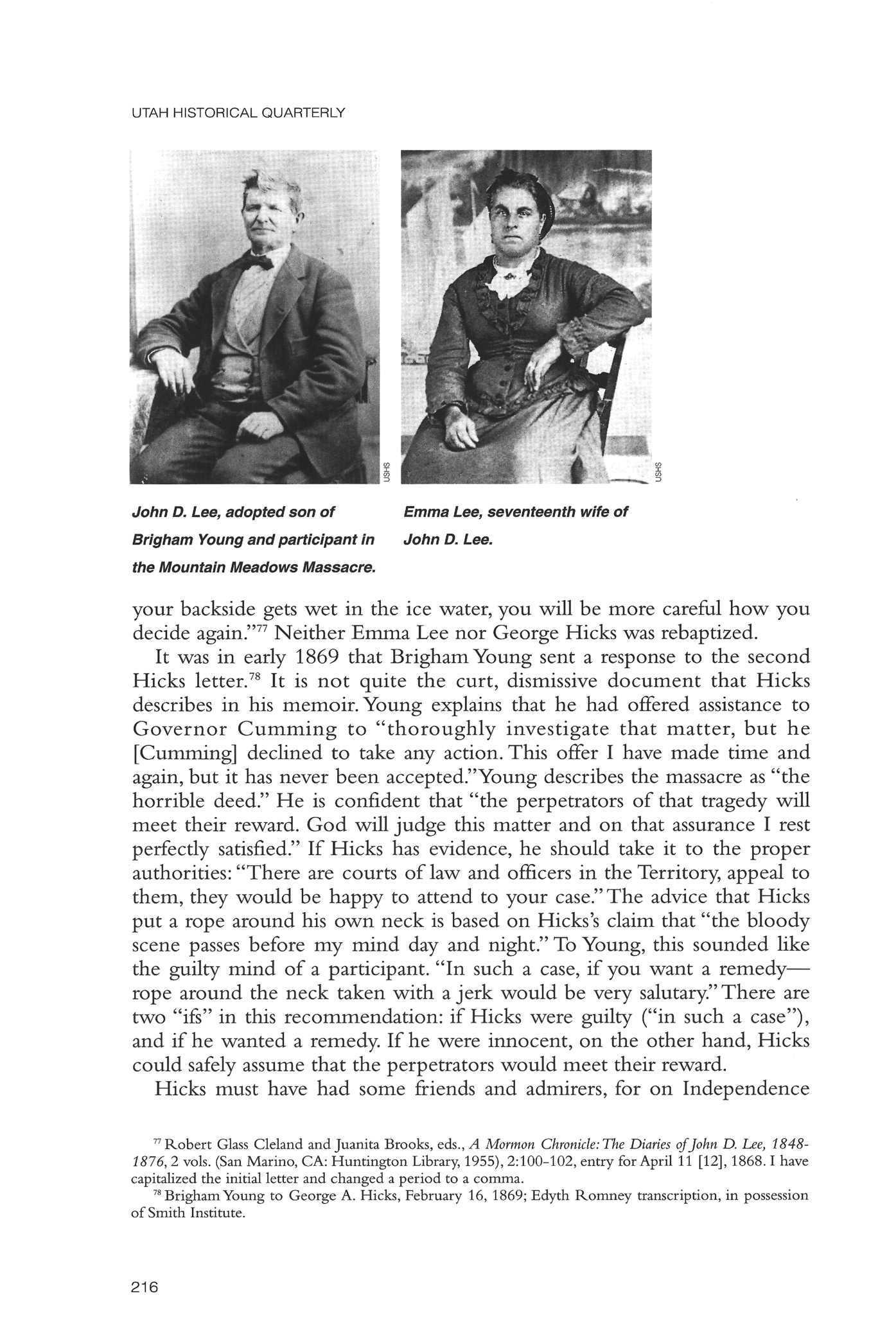
UTAH HISTORICAL QUARTERLY
John D. Lee, adopted son of Brigham Young and participant in the Mountain Meadows Massacre.
Emma Lee, seventeenth wife of John D. Lee.
77 Robert Glass Cleland and Juanita Brooks, eds., A Mormon Chronicle: The Diaries ofJohn D. Lee, 18481876, 2 vols (San Marino, CA: Huntington Library, 1955),2:100-102, entry forApril 11 [12], 1868.1 have capitalized theinitial letter andchanged aperiod toa comma.
216
78 BrighamYoung to George A Hicks, February 16,1869; Edyth Romney transcription, in possession of Smith Institute.
Day 1869 he was named orator. But, dissatisfied -with the letter he had received, he -was already publicly denouncing BrighamYoung, accusing the church president of being "led by Green backs & not by the Spirit of the Lord."John D Lee refused to join in the celebration. He would not, he said, strike hands "with the Enemies of this Kingdom, neither Make Merry with those who defamed the Character of the Prophet Brigham." In the eyes of Lee, the bishop,"& many others -who love order & Brigham & the Kingdom," Hicks -wasan "apostate."79
In 1871,along with his parents-in-law, Hicks moved to Mount Carmel. Then in 1876 he moved with his family to Clinton in Spanish Fork Canyon. Later he moved into Spanish Fork. BrighamYoung died in 1877, and the following year Hicks,still nursing grievances,began -writing his history, obviously a therapeutic exercise allowing him to release some of his pent-up bile
In 1885 Hicks mourned the death of his father. Of George Barton Hicks,William Creer, mayor of Spanish Fork, wrote:
From the time of his joining the Church until the day he died he never was known to waver or falter in the least in the faith. As a Latter-day Saint, the greatest test of his firmness was when four of his brothers and his aged mother followed William Law, when he broke away from the Church, and revolted against the Prophet Joseph Law was a personal friend of Brother Hicks, yet notwithstanding this, and the persecution that was brought to bear upon the Saints at that time in Nauvoo, and the fact that he was driven away from his home, he never swerved the least, nor was he known to speak wrongfully of the church authorities, nor murmur at his condition.80
George A. Hicks loved and admired his father but cannot be said to have emulated all of his qualities
If George A Hicks had been able to hunker down and bide his time, he might gradually have found things more to his liking.The leaders he most resented had died. He was in more comfortable circumstances. The Woodruff Manifesto of 1890 would officially end polygamy The establishment of the national political parties in Utah would mix up Mormons and gentiles, inevitably breaking down some of the old antagonism. Strongly attached to the Republican party,Hicks would find himself in alliance with church leaders likeJoseph F.Smith and,later,Reed Smoot.
But a peaceful denouement was not in the cards until much later Hicks could still not refrain from telling the church leaders what they should do and coloring his advice with derisive comments. Sometime in the 1880s he sent aletter to Bishop G.D.Snell in Spanish Fork declaring that the church should give up polygamy The advice -was considered gratuitous if not insulting, for many polygamists -were suffering exile and imprisonment fol-
79 Cleland and Brooks,eds., A Mormon Chronicle, 2:122-23,entry forJuly 4, 1869
80 "Death of aVeteran,"letter dated January 19, 1885,in Deseret News. George A Hicks touts the same qualities of his father, and Creer was a friend of his,the two oncejoining to defend the church membership ofsomeone accused of dabbling in astrology Hicks,5,40
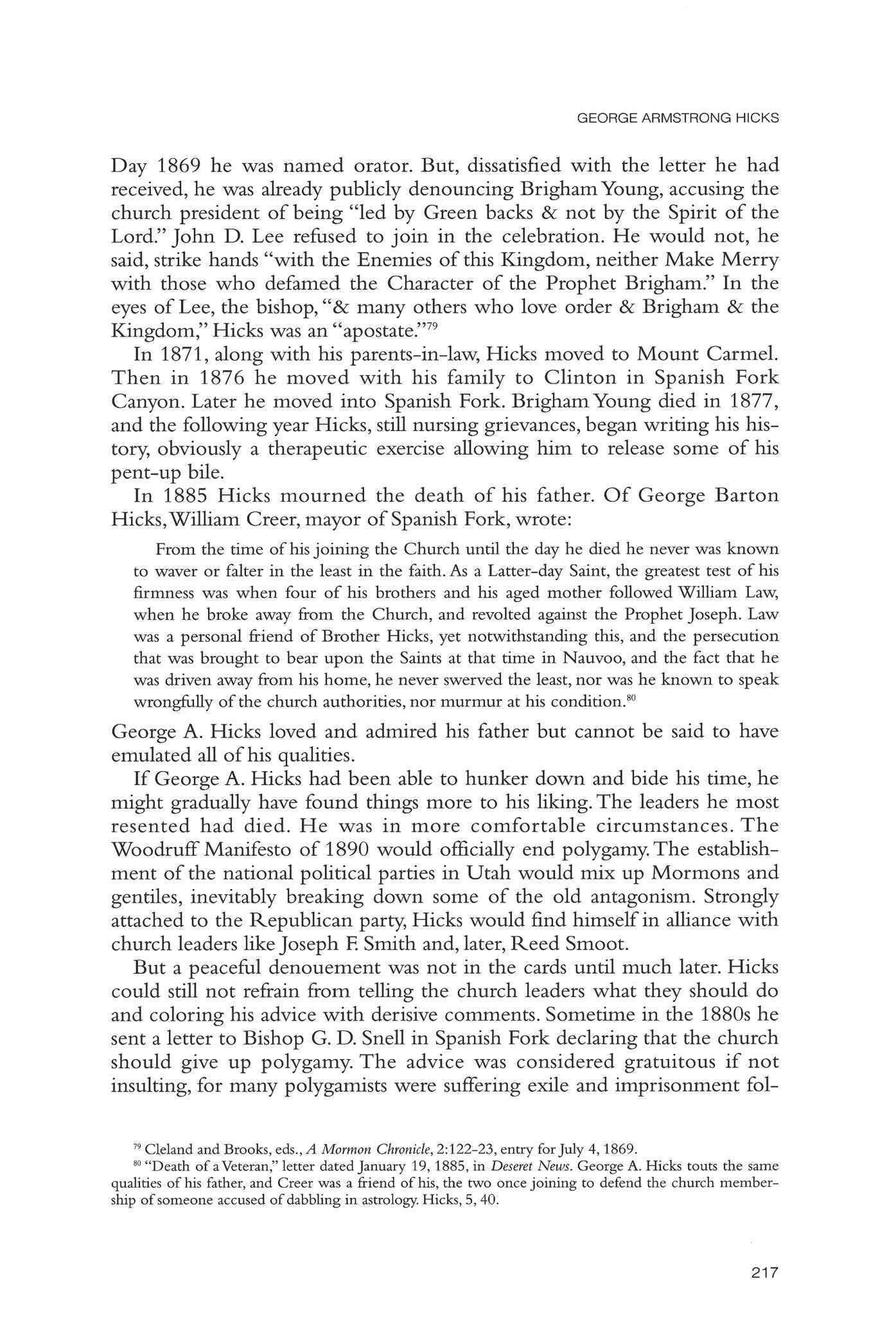 GEORGE ARMSTRONG HICKS
GEORGE ARMSTRONG HICKS
217
lowing the Edmunds Act of 1882. Hicks was cut off from the church. The excommunication was arguably invalid, for the bishop apparently did not follow standard procedure and the action was not recorded. Lacking Bishop Snell's testimony, we should probably suspend judgment, although it is worth noting that Hicks went public with his opposition by writing a play in 1886 entitled Celestial Marriage, its point of view expressed in an epigram byThomas Moore:
Faith, fanatic faith, once wedded fast
To some dear falsehood, hugs it to the last.81
In any organization having an official philosophy and program, the limits of dissent have to be determined. One might argue that, despite contrary allegations,Mormonism had allowed considerable latitude among its members
The Hicks who had denounced his branch president and Brigham Young was allowed, if he wished, to remain within the Mormon fold. But, as always, there are limits. His bishop might have tolerated private grumbling, but to raise the flag of opposition in this way could be seen as evidence of fundamental disloyalty For the next forty years Hicks lived under the impression that he had been cut off, as he put it,"for taking a stand against Polygamy and in favor of National Law."82

Hicks deplored what he considered mistreatment of apostates In his view, even William and Wilson Law, whose actions in Nauvoo led directly to the martyrdom of Joseph and Hyrum Smith, were unfairly treated. "A man's a man for a' that and a' that," he -wrote, quoting a popular line from Robert Burns.83 One wonders whether during this time of discontent loyalty to his parents and parents-in-law came into play, whether he ever spoke out in defense of the church against its enemies, or whether there were tugs and pulls from his wife and children.
Hicks himself was not ostracized With the establishment of the national political parties in Utah in the 1890s, Hicks became a staunch Republican and was unanimously elected chair of at least one party rally in Spanish Fork. "Protection as taught by Republicans is the only correct form of Human Government," he asserted.84 As the years went by, he taught school for four terms and served as postmaster He was ajustice of the peace and a school trustee. He wrote articles for newspapers, chatted with visiting professors, and even gave a guest lecture at BrighamYoung University. In 1913, at age seventy-eight, he -wrote a history of early Spanish Fork reflecting his point of view as aparticipant in its early history85
UTAH HISTORICAL QUARTERLY
Printed title page: Celestial Marriage /A Drama / In five Acts /A Domestic Tragedy / Designedfor the stage / (copyrighted) / By / Geo. A. Hicks. Special Collections, Harold B Lee Library, Brigham Young University.
Kept By Geo A Hicks ForAmusement
LDS Church
identified as Scrap Book
5
218
81
82 Undated letter to Bishop Ralph D Morgan,"Scrap Book
and Future Reference," microfilm,
Archives,hereafter
83 Hicks,
84 Scrap Book 85 Hicks,"History of Spanish Fork."
Pioneer Day (July 24th) celebration in Spanish Fork, George A. Hicks's final home, in 1914.
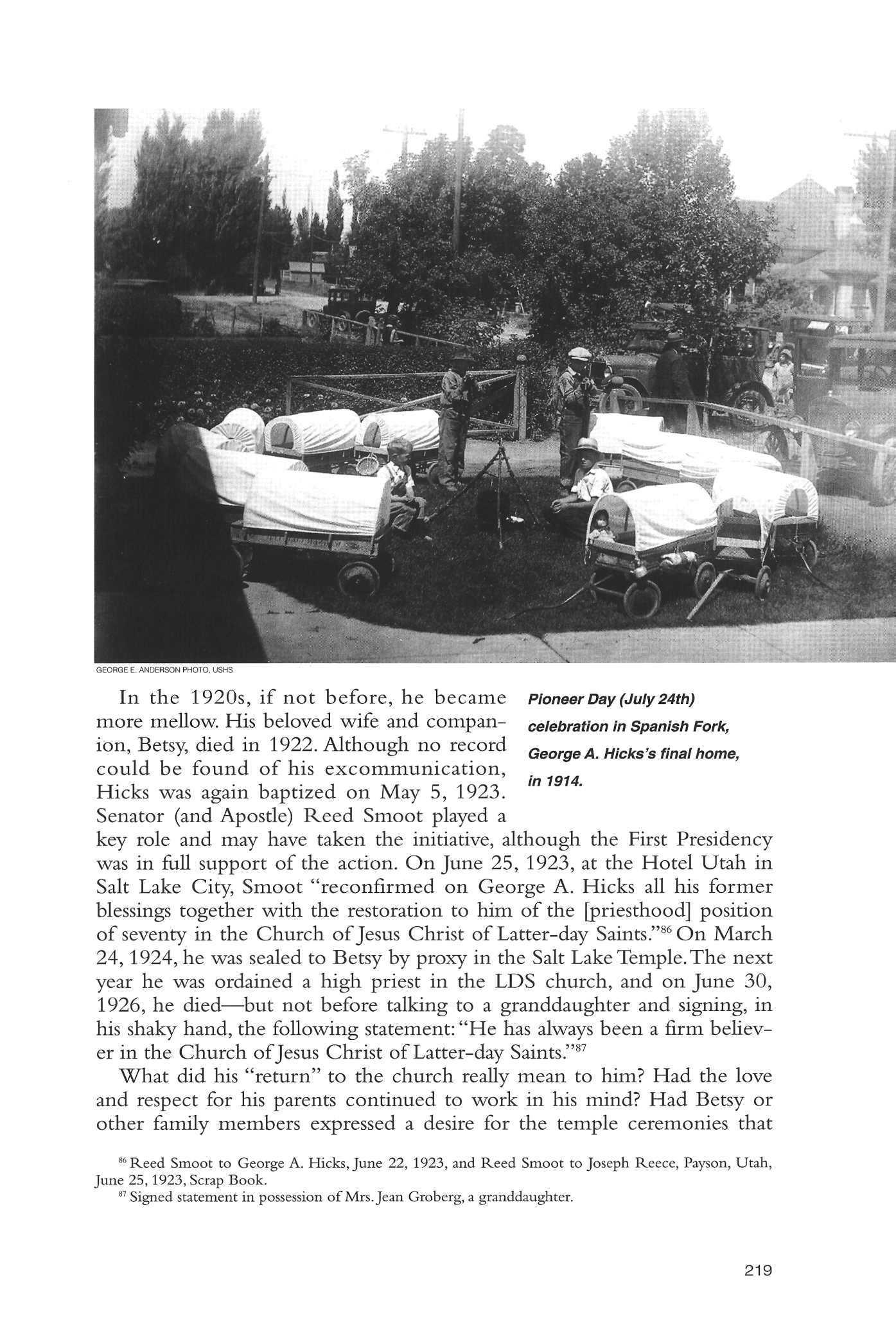
In the 1920s, if not before, he became more mellow. His beloved wife and companion, Betsy, died in 1922 Although no record could be found of his excommunication, Hicks -was again baptized on May 5, 1923. Senator (and Apostle) Reed Smoot played a key role and may have taken the initiative, although the First Presidency was in full support of the action On June 25, 1923, at the Hotel Utah in Salt Lake City, Smoot "reconfirmed on George A. Hicks all his former blessings together with the restoration to him of the [priesthood] position of seventy in the Church ofJesus Christ of Latter-day Saints."86 On March 24,1924, he was sealed to Betsy by proxy in the Salt LakeTemple The next year he -was ordained a high priest in the LDS church, and on June 30, 1926, he died—but not before talking to a granddaughter and signing, in his shaky hand, the following statement:"He has always been a firm believer in the Church ofJesus Christ of Latter-day Saints."87
What did his "return" to the church really mean to him? Had the love and respect for his parents continued to -work in his mind? Had Betsy or other family members expressed a desire for the temple ceremonies that
86 Reed Smoot to George A Hicks,June 22, 1923, and Reed Smoot to Joseph Reece, Payson, Utah, June 25, 1923,Scrap Book
87 Signed statement in possession of Mrs Jean Groberg, a granddaughter
GEORGE E ANDERSON PHOTO, USHS
219
UTAH HISTORICAL QUARTERLY
George and Elizabeth Hicks in later years.
represent the fulness of blessings for Mormons? With the passage of time,as his early poverty slipped farther and farther down the stream of time and as some of those he blamed died away, did Hicks ever doubt his doubts? In the absence of a complete soulbaring statement from him, perhaps the deed should speak for itself:he had sufficient attachment to his Mormonism that he -wished to be within the fold at the end of his life, and if he and his beloved wife could be together eternally he did not -wish any inaction on his part to stand in the way. 88 In 1924, at the age of eighty-nine, he wrote a hymn entitled "My Sovereign Lord,"the first stanza ofwhich reads:

I love my sovereign Lord
Because he died for me
And by his sacred word
From sin he sets me free He calls me by my name
And bids me share his fame
These are not the sentiments of an infidel. In some sense,he had retained a Christian faith ("This gracious Lord is mine / He gave his life for me. ..") and -wasable to pen lines ofpious devotion.89
On the other hand, on his headstone under the words "George A. Hicks—Poet and Moralist"is the following inscription:
N o vicious creed perplexed his mind, Nor brought misgivings to his breast. He strove to love the human kind And wished to all, both peace and rest
Neither Christianity nor Mormonism is specifically expressed in this broad
88 The LDS church teaches that marriages are eternal when couples remain faithful to covenants they make in LDS temples
89 Scrap Book
220
statement, butit does notpretend to state hisentire position.90
One wayof reading the Hicks 1878narrative, of course, is to take it as an objective account ofthe waythings were. Such areading will be tempting to those with a certain mindset, for instead of a varnished, faith-promoting version ofearly Mormon history,wearegiven acynical, naturalistic interpretation. However, some observations arein order.
First, for a number of years Hicks was a faultfinder, a complainer, a blamer.There isno denying theheavy cost to him—economically, psychologically, spiritually—of being called to settle in Salem andlater to migrate southward to the Dixie Mission. It is not unimportant to be reminded of the human cost paid by many foot soldiers ofMormonism, too often forgotten when the focus is entirely on top-level leaders.91 But others going through the same experiences as Hicks reacted differently. Rather than stewing andfuming, nursing a sense ofvictimhood, fueling their bitterness by griping sessions with other malcontents,they maintained adifferent perspective, a different spirit While Hicks was outraged over the handcart companies, many survivors who actually endured the experience thanked God andcontinued faithful.92 A different look at thehardships ofthe Dixie mission is provided by the detailed journal of another ordinary Mormon, Charles L Walker, who was also beset with poverty but never wavered in his faith.93
Second, not only do individuals differ in their interpretation of events but also their attitudes often change It would be interesting to follow the mutations of Hicks's thinking in the 1880s, 1890s, and the early twentieth century, but unfortunately we do not have an introspective diary covering his adult life. Nevertheless, we have been able to discern at least three George A. Hickses—the enthusiast and believer, the cynical author of a memoir in 1878, andthehumble devotee ofthe 1920s

Actually, George A.Hicks wasnot of one mind even when he wrote in 1878. Rather enjoying the label "infidel," he did not want to be seen as having gone offthe deepend.
I will say that with all my infidelity I have never lost faith in a glorious world beyond the grave where there is no death but I do not believe in any resurrection of the body but I believe in the immortality of the soul and in eternal progression I also believe in future rewards and punishments I believe that a time will come when we will all be judged according to the deeds done in the body and that we will be classified according to our intelligence.94
90 Mormonism hadalways disclaimed formal creeds, and even if there is a credo in the sense of basic beliefs, theLatter-day Saints didnotconsider these "vicious."
91 Charles S Peterson, Take upYour Mission: Mormon Colonizing along the Little Colorado River, 1870-1900 (Tucson, AZ: University of Arizona Press, 1973); David E Miller, Hole-in-the-Rock: An Epic in the Colonization of the Great American West (Salt Lake City:University ofUtah Press, 1966)
92 Mormon apostle David O McKay, citing Francis Webster about the remarkable faithfulness ofthe Martin Handcart Company survivors in Relief Society Magazine (January 1948),8.
93 A. Karl Larson andKatharine Miles Larson, eds., Diary of Charles Lowell Walker, 2 vols. (Logan: Utah State University Press, 1980)
94 Hicks, 42
GEORGE ARMSTRONG HICKS
221
UTAH HISTORICAL QUARTERLY
This is essentially deism with a Mormon residue of graded salvation and eternal progression.
Like other despisers of religion, Hicks in 1878 preferred naturalistic explanations and was fond of the notion of cause and effect One wonders whether he ever reflected on cause-effect relationships in the moral, psychological, and social world Did he think that outspoken denunciation of his leaders, including slurs against their character, would enhance affection and a desire to include him? Perhaps those he criticized, at times to their face, deserved censure More likely, there were two sides to each of these mini-dramas, and a young smart-aleck who, with partial information, showed a consistent tendency to grouse and murmur was labeled a troublemaker In any setting of group interaction his self-appointed status as carping critic -would produce similar results
However we feel about him—whether we admire him as a hero, pity him as one who failed to support the cause,or empathize with him as a fellow human being who, given his own experiences and body chemistry, did his best—all can recognize George Armstrong Hicks as a spokesman for a usually mute subset of the Mormon population. Some of them permanently left the fold, some few became shrill antagonists, some lapsed and lived quietly in relative "inactivity." And some, like Hicks, belatedly returned to the faith that had once motivated and nourished them.
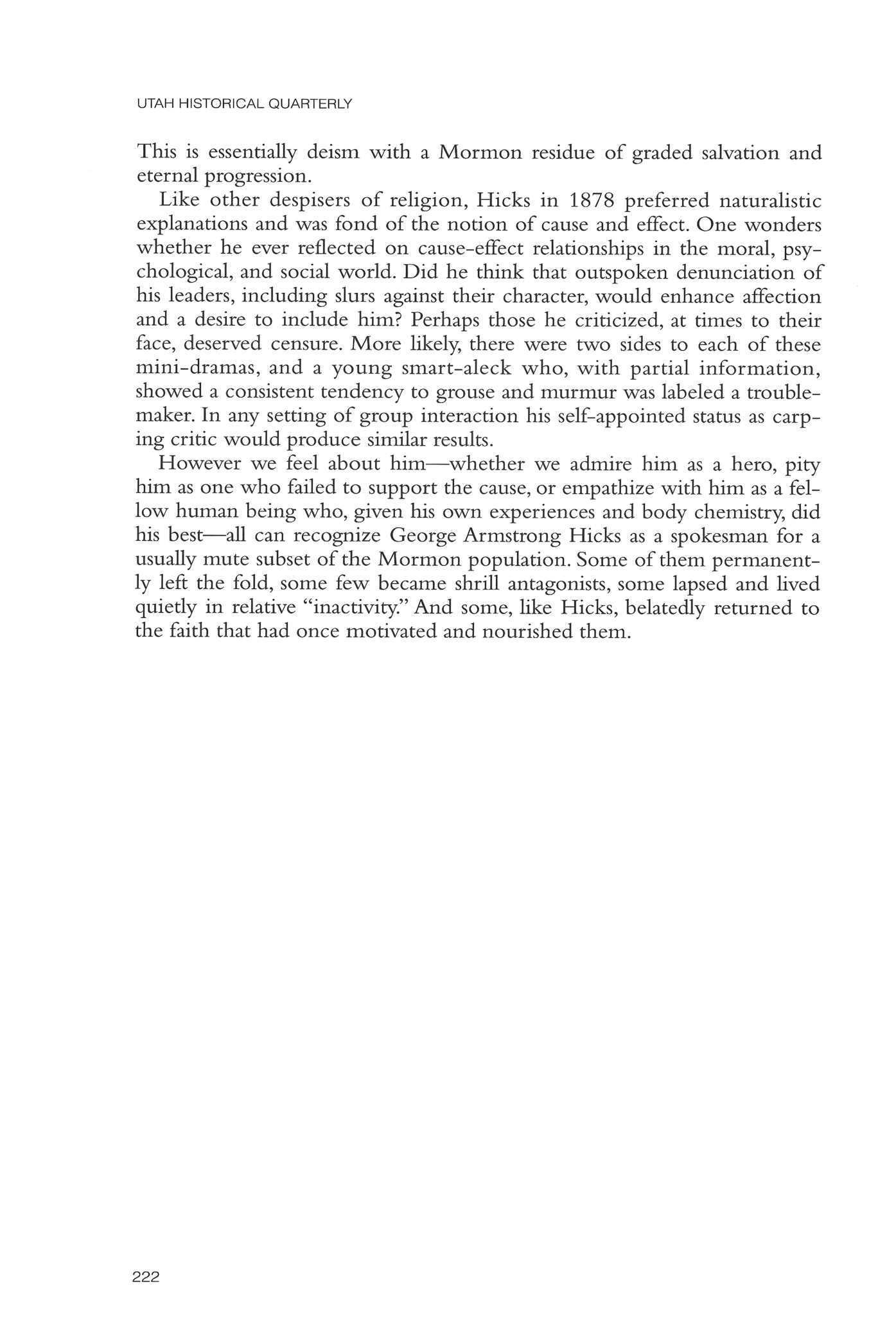
"Grit Enough to Stick with It": Stories from Blue Valley
Edited and introduced by KENT DAVIS and KRISTEN ROGERS
James W Nielsen was a storyteller So was his brother Joseph In the early 1960s James -wrote a history of his parents, Niels J and Minnie Nielsen, which included an account of their life in Giles, a town in BlueValley, Utah, around the end of the nineteenth century At about the same time, he wrote letters to his sister, Pat Nielsen Davis, telling her about other people and events associated with the valley Joseph, a younger brother, also wrote an account of life in Blue Valley.1
The Fremont River runs through Blue Valley, Utah, and Steamboat Point (seen in both photos) rises above it. Today only scant reminders of the settlement of Giles remain at the townsite. Photos of the valley were taken by Kent Davis in 1970.
The narratives give an intimate, firsthand look at an unusual community. Blue Valley, located on the Fremont River between Hanksville and Caineville on what is now State Highway 24, had
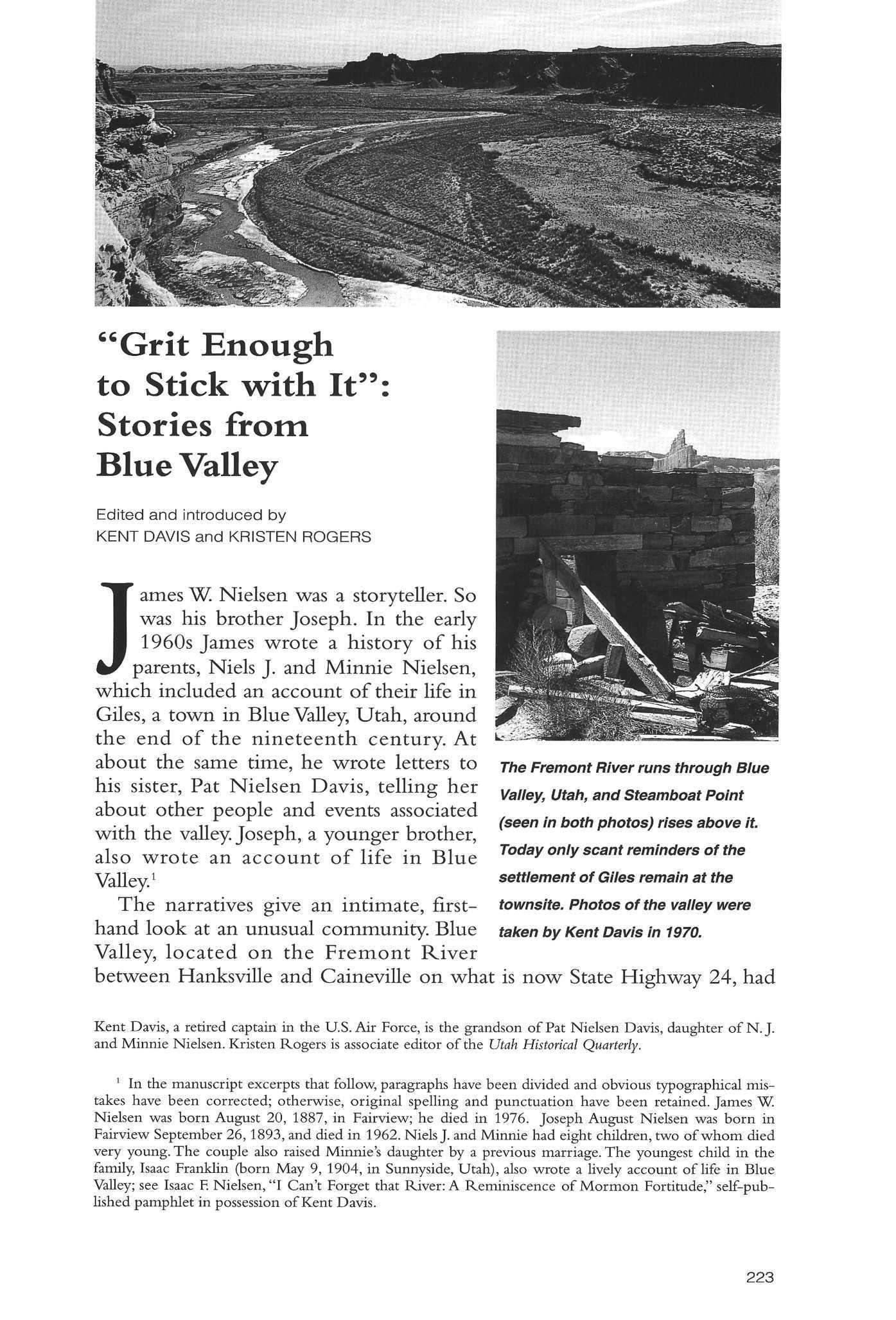
Kent Davis, a retired captain in the U.S.Air Force, is the grandson of Pat Nielsen Davis, daughter of N.J. and Minnie Nielsen Kristen Rogers is associate editor of the Utah Historical Quarterly.
1 In the manuscript excerpts that follow, paragraphs have been divided and obvious typographical mistakes have been corrected; otherwise, original spelling and punctuation have been retained James W Nielsen was born August 20, 1887, in Fairview; he died in 1976 Joseph August Nielsen was born in Fairview September 26,1893, and died in 1962.NielsJ.and Minnie had eight children, two of whom died very young The couple also raised Minnie's daughter by a previous marriage The youngest child in the family Isaac Franklin (born May 9, 1904, in Sunnyside, Utah), also wrote a lively account of life in Blue Valley; see Isaac F.Nielsen, "I Can't Forget that River: A Reminiscence of Mormon Fortitude," self-published pamphlet in possession of Kent Davis
received its name from the bluish-gray Mancos shale of the surrounding hills Those hills are barren indeed, and the Fremont River is unruly even today, but a small group of families who were "called"by Mormon church authorities to settle in the valley did not flinch from the task They came in full faith that they would be able to make a life and a community in the valley In so doing, they believed, they would contribute to building the kingdom of God
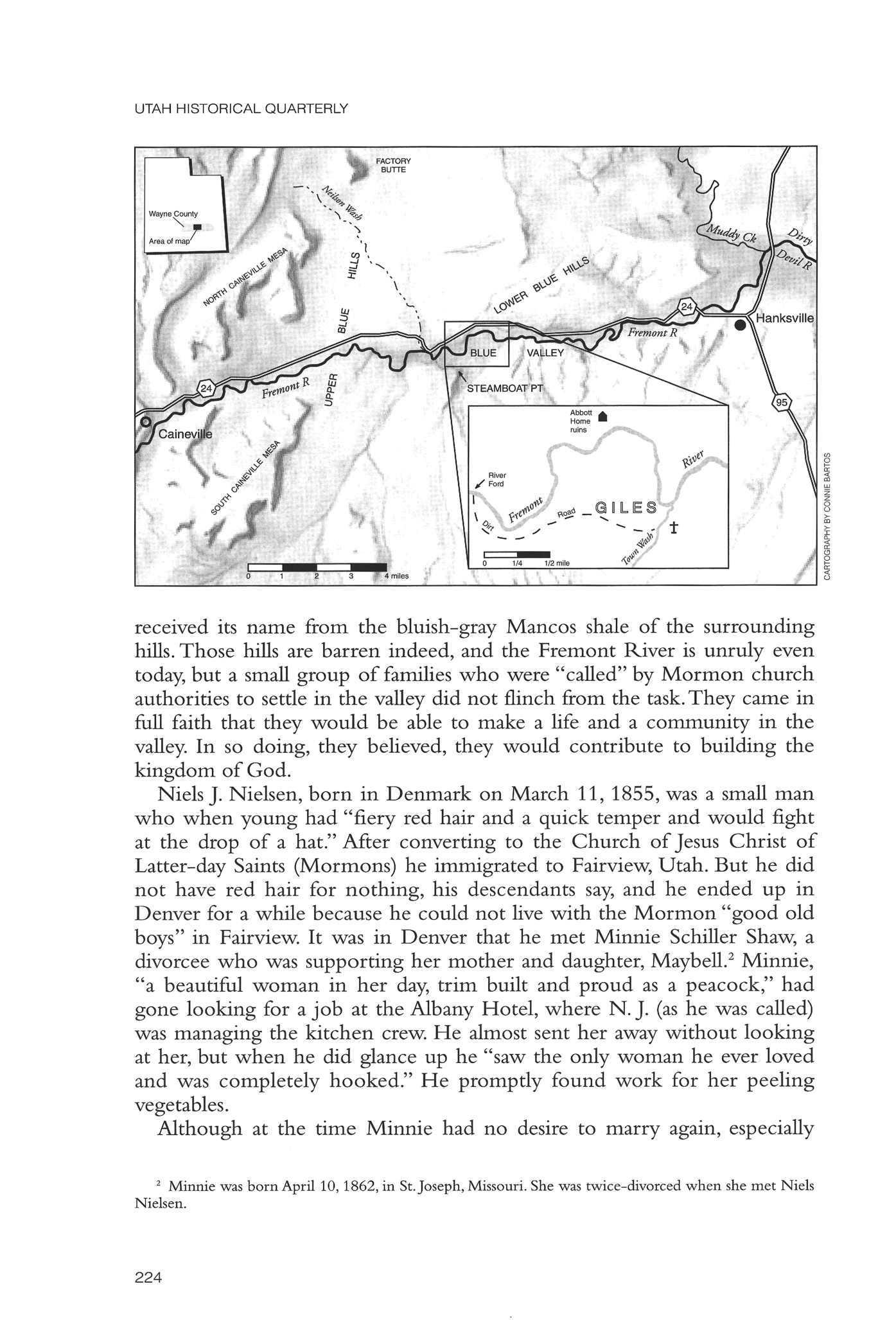
Niels J. Nielsen, born in Denmark on March 11, 1855,was a small man who when young had "fiery red hair and a quick temper and would fight at the drop of a hat." After converting to the Church of Jesus Christ of Latter-day Saints (Mormons) he immigrated to Fairview, Utah. But he did not have red hair for nothing, his descendants say, and he ended up in Denver for a -while because he could not live with the Mormon "good old boys" in Fairview. It was in Denver that he met Minnie Schiller Shaw, a divorcee who was supporting her mother and daughter, Maybell.2 Minnie, "a beautiful woman in her day, trim built and proud as a peacock," had gone looking for ajob at the Albany Hotel, where N.J. (as he was called) was managing the kitchen crew. He almost sent her away without looking at her, but when he did glance up he "saw the only woman he ever loved and was completely hooked." He promptly found work for her peeling vegetables.
Although at the time Minnie had no desire to marry again, especially
UTAH HISTORICAL QUARTERLY
22 4
2 Minnie was born April 10, 1862,in St Joseph, Missouri She was twice-divorced when she met Niels Nielsen.
The Nielsen family c. 1890. From left: Johanna Schiller, N.J. Nielsen, and Minnie Nielsen. The children are Jim and Maybell.
not to such a "homely clodhopper" as N. J., he convinced her, and they married in 1885 Within a year, Minnie converted to Mormonism and the family moved to Fairview, Utah, where their first five children were born; James and Joseph -were the two oldest. N J worked mainly at making adobes and -was so energetic that his local nickname was "Timothy Quickstep."3
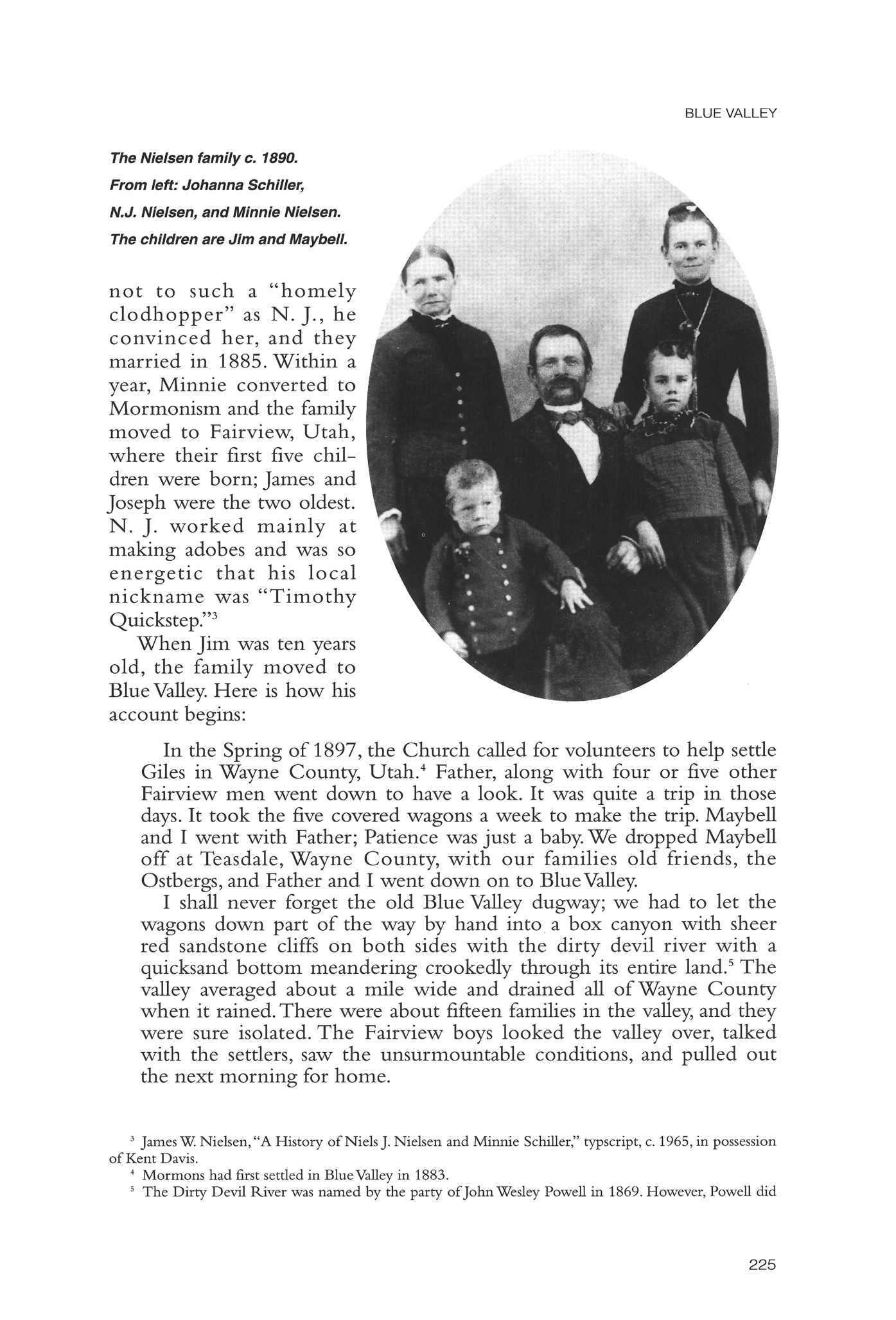
When Jim was ten years old, the family moved to BlueValley.Here is how his account begins:
In the Spring of 1897,the Church called for volunteers to help settle Giles in Wayne County, Utah.4 Father, along -with four or five other Fairview men -went down to have a look It -was quite a trip in those days. It took the five covered wagons a week to make the trip. Maybell and I went with Father; Patience wasjust a baby.We dropped Maybell off at Teasdale, Wayne County, with our families old friends, the Ostbergs, and Father and I went down on to BlueValley.
I shall never forget the old Blue Valley dugway; -we had to let the wagons down part of the way by hand into a box canyon with sheer red sandstone cliffs on both sides with the dirty devil river with a quicksand bottom meandering crookedly through its entire land.5 The valley averaged about a mile wide and drained all of Wayne County when it rained There were about fifteen families in the valley, and they were sure isolated. The Fairview boys looked the valley over, talked with the settlers, saw the unsurmountable conditions, and pulled out the next morning for home
BLUE VALLEY
3 JamesW Nielsen,"A History of NielsJ Nielsen and Minnie Schiller," typscript, c 1965,in possession of Kent Davis.
4 Mormons had first settled in BlueValley in 1883
225
5 The Dirty Devil River was named by the party ofJohn Wesley Powell in 1869 However, Powell did
UTAH HISTORICAL QUARTERLY
Father felt duty bound to stay.He traded a new Bain wagon to John C.Ekker for forty acres of land with a partial water right.About twenty acres of good ground; the rest was drift sand.6 He took over the farm of Henry Loris on shares for the summer.We planted several acres of corn and a nice garden.The corn that we planted had been frozen and the seed failed to germinate, so the crop for that summer was a total failure. We worked on our own place between times getting it ready so we could move Mother and the family down that Fall There was a one room frame house on our place with 14 by 16 feet with a dirt floor and just sheeting lumber nailed onto the frame and roof with a fireplace in the East end
The climate -was about the same as St. George, Utah, and the good land was very productive Sugarcane, corn, melons, and all kinds of fruit grew prolifically, when -we could hold the water to irrigate it Our dams in the river were always temporary ones;they -were built on a quicksand foundation and went out whenever -we got a hard rain. The ditches were built along the side walls,under the ledges,and everytime it rained they were filled with mud We were continually cleaning ditches or putting in a new dam with cotton-wood,-willows,and rock and, as hope springs eternal in the human breast, the men refused to quit. I can still hear old Pappylance7 say, after completing a goodlooking dam, "It will never go out in Gods almighty -world, no sir, it will never go out." But it always did and the half developed crops died and the people lived on faith and hope and greasewood greens. 8
Joseph Nielsen, Jim's brother, describes the building of dams in more detail:
It took all the men in theValley 30 days to build a dam in the river high enough to get the water into the ditches, on [e]ither side of the river they -would put a layer of cottonwood trees in the river, then a layer of big flat rock, then another layer of trees and rock and on up They had to make the dam about 25 ft. thick and 20 ft. high and the river was about 100 ft. across, and that spelled a lot of trees and rock and alot of hard -work, the dam -would hold fine until abig flood came, the flood -would pour over the dam with such force it -would gouge out
not know where the river's headwaters were or that the river had two main forks Today, the north fork is called Muddy Creek and the south fork is the Fremont River Where the two riversjoin near Hanksville, it becomes the Dirty Devil Therefore, Giles was located on what isnow called the Fremont River
6 He later acquired two "very small horses"and an old wagon as payment for building a house for one of the settlers "The old harness and wagon were tied together with bailing wire, and we spent a lot of time fixing them,"his sonJoseph recalled;Joseph Nielsen,typescript manuscript in possession of author
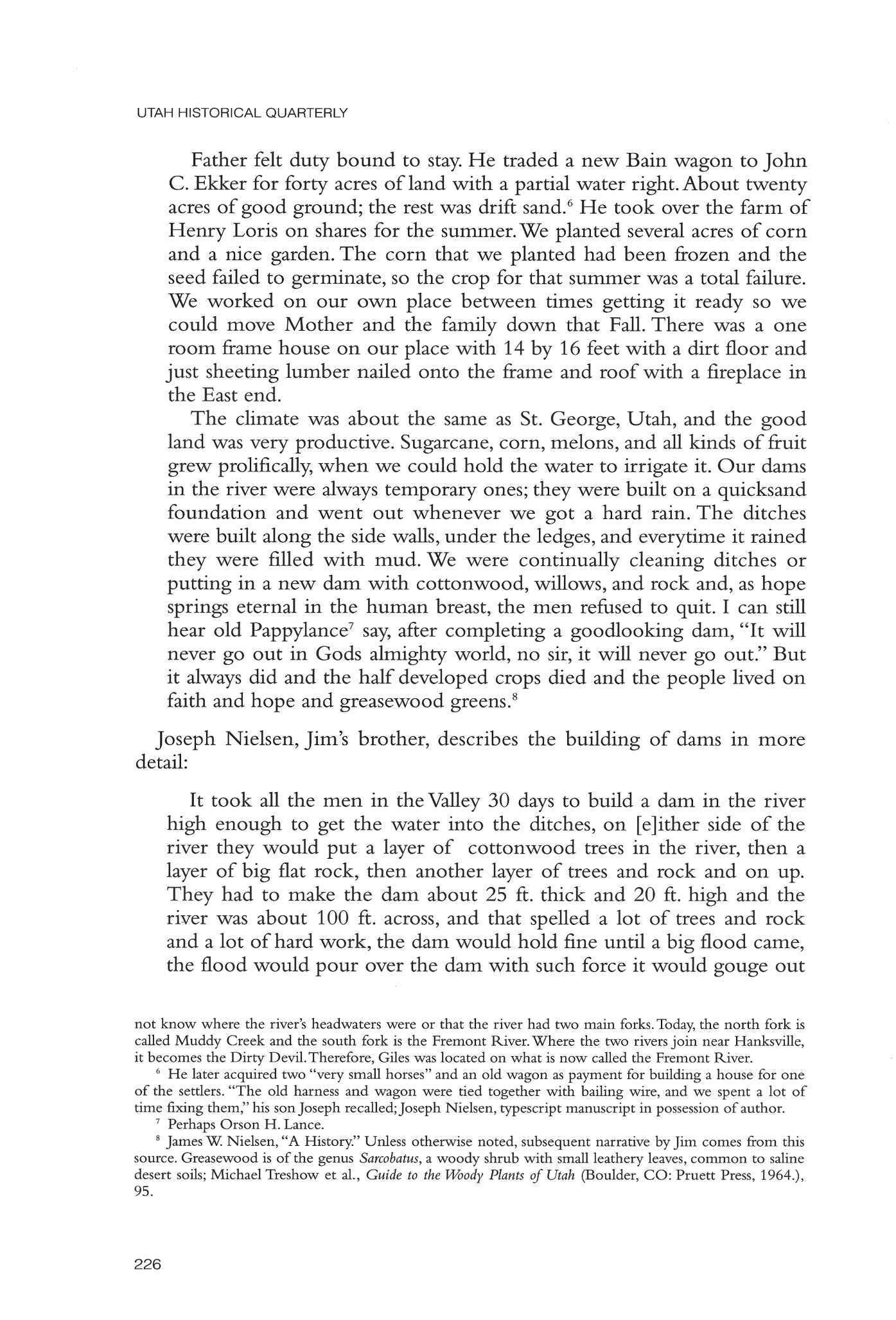
7 Perhaps Orson H Lance
8 JamesW Nielsen, "A History." Unless otherwise noted, subsequent narrative byJim comes from this source. Greasewood is of the genus Sarcobatus, awoody shrub with small leathery leaves,common to saline desert soils;Michael Treshow et al., Guide to the Woody Plants of Utah (Boulder, CO: Pruett Press, 1964.), 95
22 6
a big hole in the soft river bed below the dam, and the dam would tip over into the hole,and the big stones -would drop out into the hole, and the trees would float away, when this happened two or three times in the spring and early summer it got too late to put in a crop, and they would have to give it up for that year,and go to the coal camps or some place else and find work to provide for their families The ditch on one side of the river -was 7 miles long, and the one on the other side was 4 miles long,and they had to be shoveled out quite often asthe water was always riley that went into them.
The land in theValley -wasvery good, -when they could get the water they could raise good crops, but about half of the years they were not able to get the -water out of the river.9
Throughout its history, the story of Giles would center around the getting—and not getting—of water. Niels J. Nielsen -was quickly given a pivotal role in that effort, and he -was able to increase the efficiency of community irrigation, at least when the river was cooperating AsJim relates,
Half the old timers in BlueValley could neither read or write Father was a -wizard -with figures and was immediately appointed secretary of the irrigation company and his word -was law, and although he -was the smallest man in Blue Valley, he was respected and depended upon Headgates -were installed in each farm and each man drew his portion of water in accordance -with the amount of shares of water stock he had.This stopped alot of bickering and fighting over the 'water.
We got our place as near ready as we could and in the Fall of 1897 hired a man named ArchieYoung to go with us to Fairview and move Mother and the family down Father sold his home in Fairview for one thousand dollars, which was quite a bit of money in those days. We bought a new wagon, three horses, and a plow; loaded our furniture and belongings in the two -wagons with Mother, Joe, Patience, and Grandma and made the treck back to BlueValley full of hope and faith

For Joe, who was making the trip for the first time, the journey -was a hair-raising adventure that ended in anticlimax; at the end of the road lay disappointment.
I think it took us three days to make the trip, and we all looked forward to seeing our new home, the further we -went the more rugged and rough the country got, deep canyons some of them with straight up ledges hundreds of feet high, and so narrow there wasjust room for
BLUE VALLEY
22 7
9 Joseph August Nielsen, "Family History of NielsJoseph Nielsen and Minnie Schiller Nielsen," typscript, n.d., copy in possession of Kent Davis All narratives by Joe come from this source The settlers raised fruits, vegetables,melons, corn, cane, and alfalfa They also raised bees and made salt from "salt rock" by pounding it into a powder and boiling it until it had dissolved and the water evaporated See Anne Snow,comp., Rainbow Views:A History of Wayne County (Springville:DUP ofWayne Co., 1953),294-95
UTAH HISTORICAL QUARTERLY
the wagon road, and times it looked like we were coming to a dead end, but the box canyon would turn and on we'd go, finely we got out of the deep canyons, and came out into Canesville [Caineville, a town about sixteen miles west of Hanksville]Valley, there was a small town of very poor folks this town was twelve miles above Blue Valley, we went down over a long leval mesa, then we came to the bigjump off, the place where we had to go down off the high mesa into Blue Valley, so steep and it looked more like a trail then it did like a road, we all got out of the -wagon and walked down the hill, allbut Dad he stayed in and put on all the breaks he had and held back on the horses, the hill was so steep that one team could only pull an empty wagon up it, and if there was any load on the wagon they had to put on extra teams to pull them up, later on they built a little better dugway in a different place, but it was still very steep, this dugway was about 2 miles above...Giles..., after we got down the hill, the road went along a narrow place between the hill and a high river bank, and the road tipped toward the river bank, and we -wanted to get out and walk again it looked so bad, I cried and Mother screamed -we-were so scared.
The wagon road traversed the Waterpocket Fold through what is now Capitol Reef National Park.After it left the Fold, two or three miles before reaching the site of Caineville, the road went along the steep northwest slope of a blue clay reef. This -was the Blue Dugway. The downhill side sloped precipitously for several hundred feet, and there was no way for -wagons to turn around or pass. Even a fraction of an inch of rain caused the clay to turn into slick gumbo. Naturally, the dugway acquired a terrifying reputation, made worse by the legend of a teamster who, descending the slope one overcast day, suddenly encountered the devil blocking the road. Fortunately, the story goes, the teamster thought to pull his Book of Mormon from the grub box and -wave it,causing the devil to disappear in a scream of rage and cloud of smoke. Sunday School and Primary teachers told and embellished the story with great relish—but it gave the children nightmares, and church leaders finally banned the story.10
Joe Nielsen's story continues:
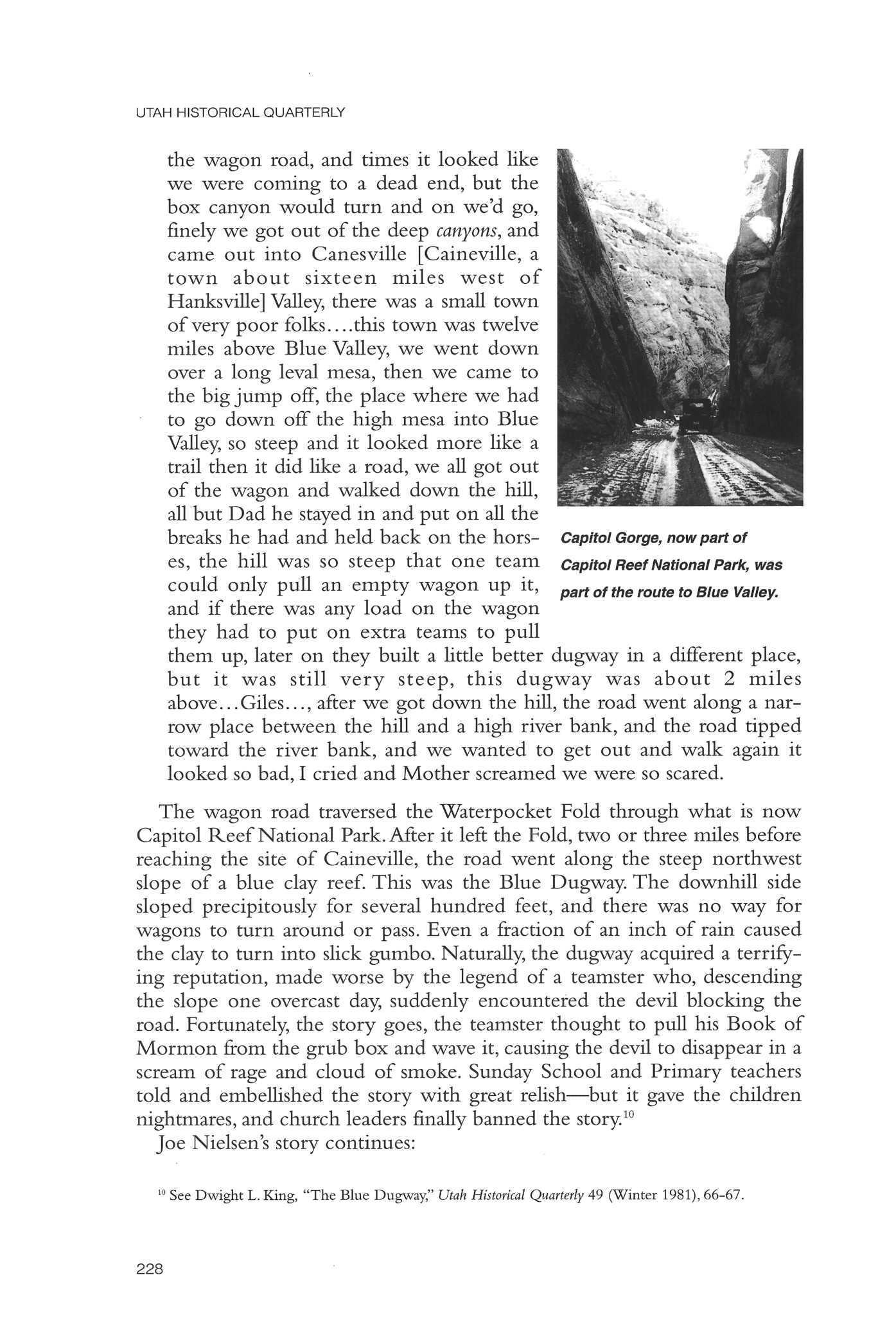 Capitol Gorge, now part of Capitol Reef National Park, was part of the route to Blue Valley.
Capitol Gorge, now part of Capitol Reef National Park, was part of the route to Blue Valley.
228
10 See Dwight L.King, "The Blue Dugway," Utah Historical Quarterly 49 (Winter 1981),66-67.
Then the valley got a little widder, and we passed a little ranch house,where Bro Lance and his family lived in the summer. Then -we passed Ren Turner's ranch house,both were log houses,then we crossed the river and that was real scarey to us nervous ones, we were getting all ruffeled up with the thrills and chills
After we crossed the river we went up through a big brush patch for about a half a mile, then up pretty close to a big sandstone bluff, we drove up to a little one room shack, made of boards, and you could stand on one side of it and see out the other, through the cracks bet-ween the boards.
Dad drove the wagon up close to the door and stopped the team and saidWell we're home Mother did not believe him at first, but he finely convinced her that this was it,the place was about halfway between the big dugway and the town, it was almost amile from any other house.
Mother shed bitter tears, she wondered why the church wanted to send them into such a forsaken place Dad put his arm around her, and told her not to try to swollow the whole situation all at once,just take one thing and one hour at a time, and thrash out the problems as they come along.The idea of living outside mostly among the bugs snakes and lizards was pretty heart rending to Mother, but when she finely got her teeth into it,she wasjust asgood apioneer as any one could be.
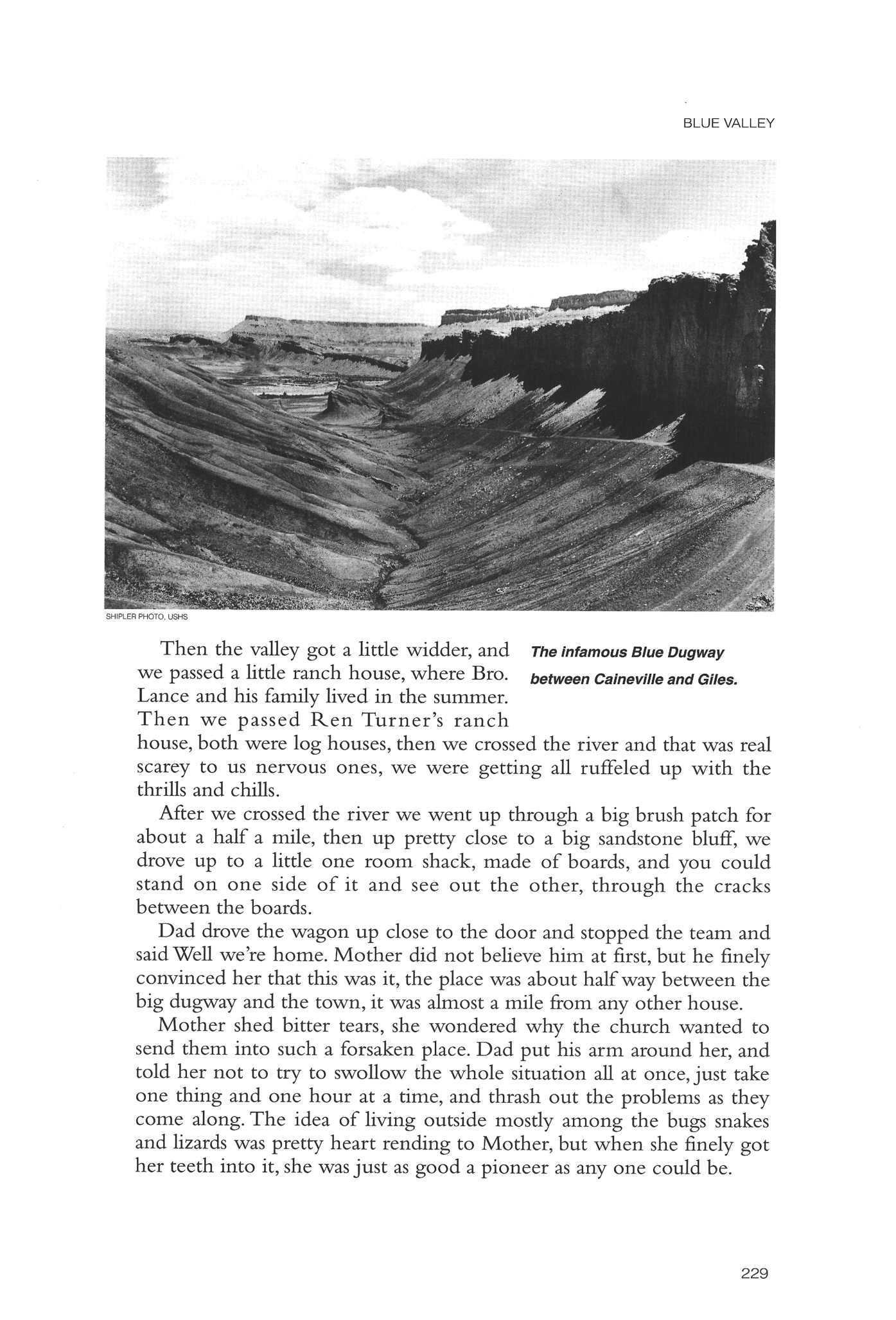
BLUE VALLEY
SHIPLEB PHOTO USHS
The infamous Blue Dugway between Caineville and Giles.
229
UTAH HISTORICAL QUARTERLY
According toJoseph, the house had one bedstead for the parents, and the children slept on the floor. He said that when the wind blew "the frail little house swayed back and forth, and the boards squeaked and popped...and the sand blew into the house in piles. I guess that's where we got grit enough to stick with it." But the house was only one of the disappointments of that first day,according to Jim.
We landed there at noon late in the Fall, unloaded the furniture in the well-ventilated lumber room and it started to rain. Mother had some nice things piled in the room.The rain came throgh the roof in streams We had buckets, tubs and all the containers we could find trying to catch the water and keep it from destroying Mothers keepsakes, with very poor success.Mother sat down in the middle of the mess and started crying, never before or after did I ever see her so heartbroken and thoroughly disgusted; but they had burned their bridges behind them and there was nothing to do but tough it out.
I say tough it out advisedly, we did tough it out, living mostly on faith for five years They were the miracle years We were seventy miles from the nearest railroad over a desert of sand. The nearest flour mill was fifty miles away over a road that was almost impassable.There was no doctor within a hundred and fifty miles It was not unusual for some of our own midwives to ride twenty miles on horseback to deliver a baby.11
N.J. and his sonJim built a shed in front of the house out of green Cottonwood limbs.The family called it the bowery and spent most of their time there in the summers Inside or outside, the family had to deal -with rodents, lizards, scorpions, insects, and snakes Minnie was squeamish, but her mother, Johanna Beatta Heidersbach Schiller, went after the "friendly pests"with a vengeance. 12 According toJoe's account:
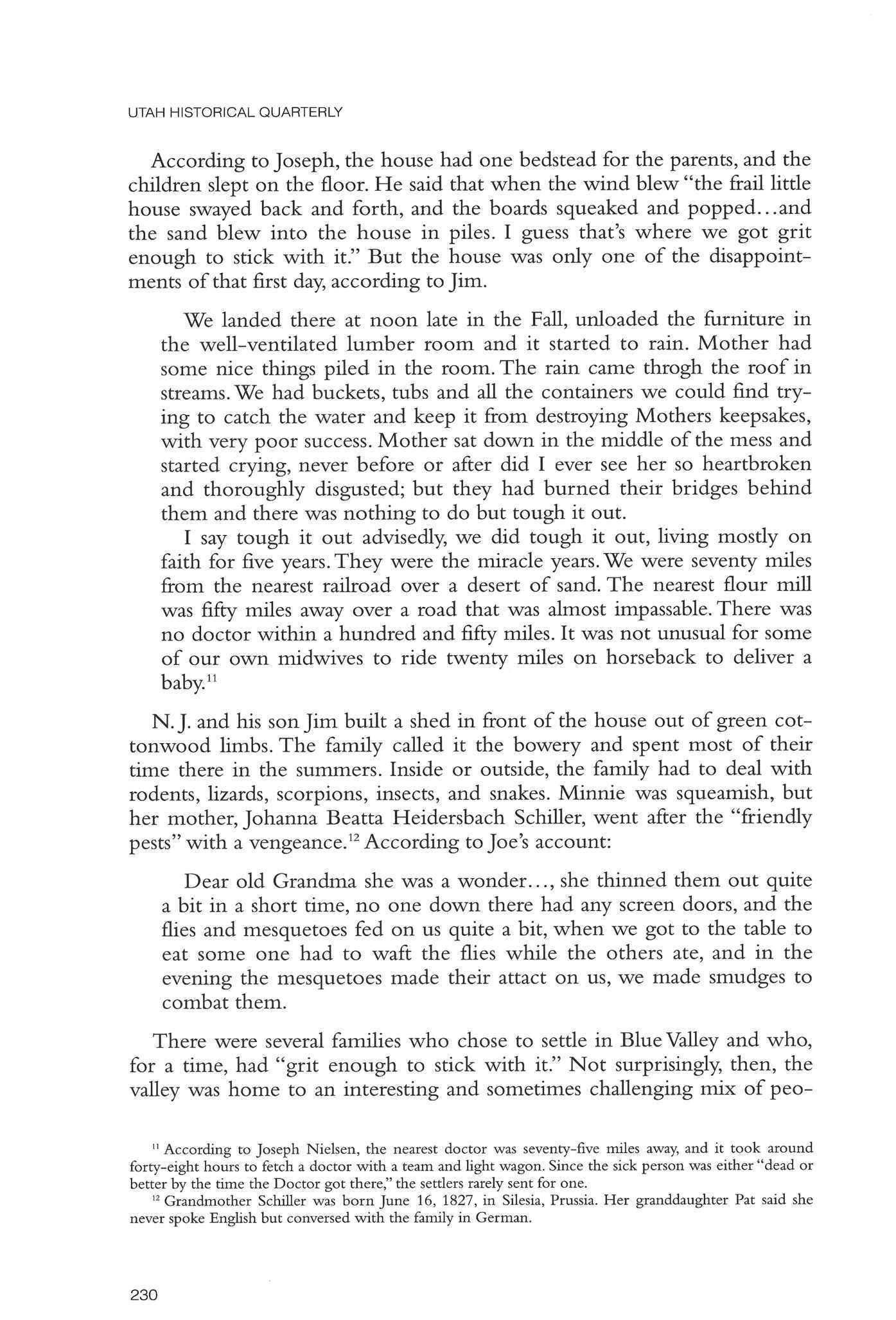
Dear old Grandma she was a wonder..., she thinned them out quite a bit in a short time, no one down there had any screen doors, and the flies and mesquetoes fed on us quite a bit, when we got to the table to eat some one had to waft the flies while the others ate, and in the evening the mesquetoes made their attact on us, we made smudges to combat them.
There were several families who chose to settle in BlueValley and -who, for a time, had "grit enough to stick with it." Not surprisingly, then, the valley -was home to an interesting and sometimes challenging mix of peo-
" According to Joseph Nielsen, the nearest doctor was seventy-five miles away, and it took around forty-eight hours to fetch a doctor with a team and light wagon Since the sick person was either "dead or better by the time the Doctor got there,"the settlers rarely sent for one 12 Grandmother Schiller was born June 16, 1827, in Silesia, Prussia Her granddaughter Pat said she never spoke English but conversed 'with the family in German
230
Giles settlers Melvina M. and Orson H. Lance. Photos of settlers are from Rainbow Views, published by the Daughters of Utah Pioneers.
pie.Jim was not afraid to classify his diverse neighbors, and in aletter to his sister, Pat Nielsen Davis, he wrote, "BlueValley people -were pretty closely related and there were two different factions lived there." Some families were "more or less on the Lord's side." Others were "the bad influence."13 He -went on to write brief profiles of some of the settlers.
Just before we moved there, the Bishop, Harry [or Henry] Giles (for whom the town was named) -was thrown from a horse and received a compound fracture of his right leg.They got a horse doctor from Grass Valley, sixty miles away, to come down Gangrine had set in and they sawed his leg off with an ordinary cross cut saw.No sedative, no nothing. He rolled a newspaper into a cone and hollered through it while they did the job. He died the next day and was buried in the Blue Valley graveyard along with a number of others -whose stories have never been told.14
Bishop Giles when he -was alive had the ability to keep them in line and theValley prospered.We moved down therejust at that time
Bishop Giles had been dead about two years and his son-in-law, Levi White was the Bishop Levi married the oldest Giles girl They were a proud family but so far as book learning was concerned they had none.
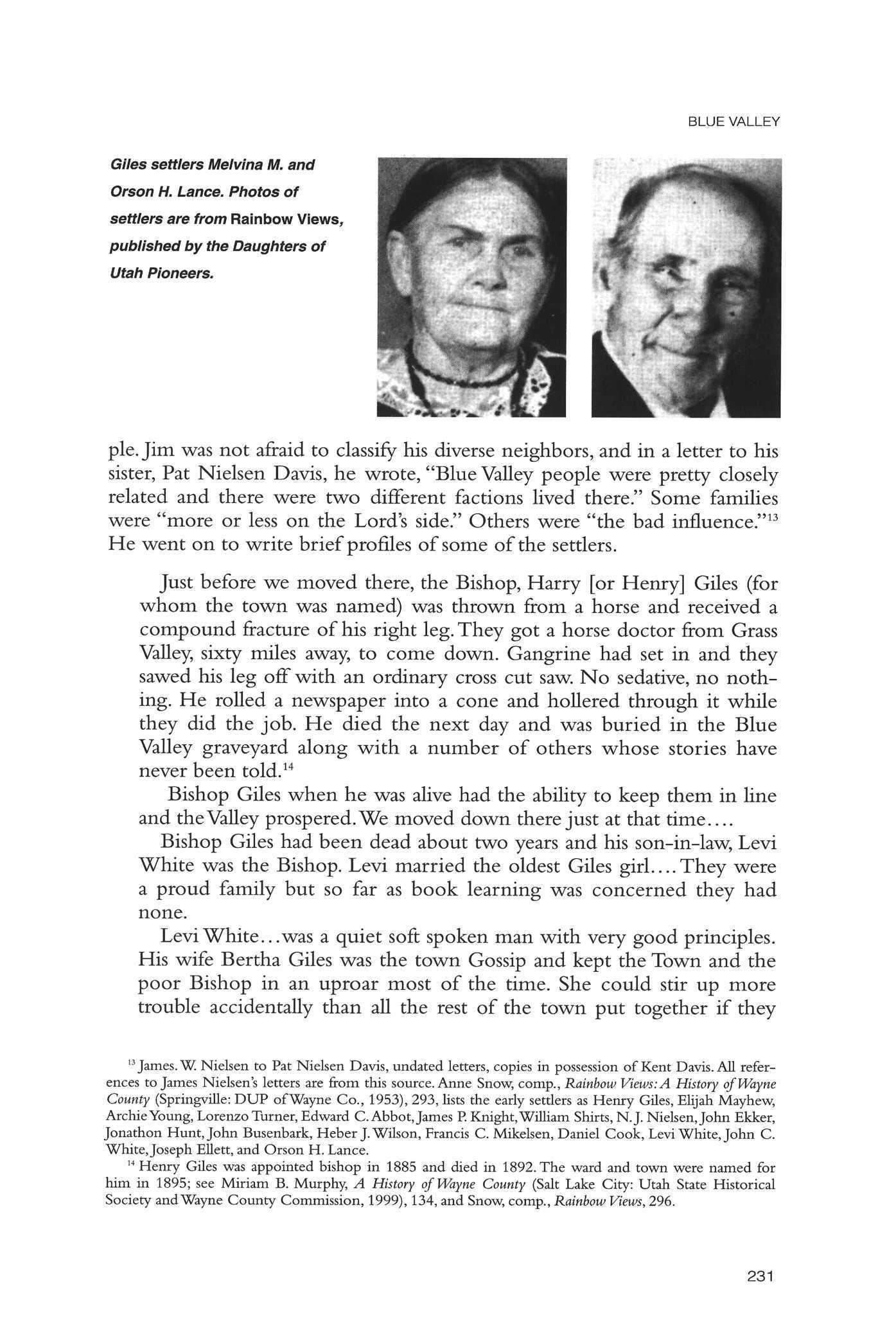
LeviWhite. .-was a quiet soft spoken man with very good principles His wife Bertha Giles was the town Gossip and kept the Town and the poor Bishop in an uproar most of the time. She could stir up more trouble accidentally than all the rest of the town put together if they
13 James W Nielsen to Pat Nielsen Davis,undated letters, copies in possession of Kent Davis All references toJames Nielsen's letters are from this source.Anne Snow, comp., Rainbow Views: A History of Wayne County (Springville:DUP ofWayne Co., 1953),293,lists the early settlers as Henry Giles,Elijah Mayhew, ArchieYoung,LorenzoTurner,Edward C.Abbot,James P Knight,William Shirts,N.J Nielsen,John Ekker, Jonathon Hunt,John Busenbark, Heber J.Wilson, Francis C. Mikelsen, Daniel Cook, LeviWhite,John C. White,Joseph Ellett,and Orson H Lance
14 Henry Giles was appointed bishop in 1885 and died in 1892 The ward and town were named for him in 1895; see Miriam B Murphy, A History of Wayne County (Salt Lake City: Utah State Historical Society andWayne County Commission, 1999), 134,and Snow, comp., Rainbow Views, 296
BLUE VALLEY
231
Mary Ann and John C. White.
tried. Lean hearTump busenbark cussing her now.Wren Turner accused Tump of shooting his dog and was sure mad about it.Tump said, "I know who told you it -was that G*** D***Birth White and Tump proceeded to call her every thing a sheep herder -would call his dog. If there was any swear words Tump didn't know I never have heard them Well it very near stareted a Feud as Bertha's brothers took it up and Tump threatened to kill the whole dam rotten family That isjust a sample of our neighborly difficulties.15
"Neighborly difficulties" were not necessarily the rule in Blue Valley, but the settlers did have a diversity of temperaments and habits.And each had his or her own way of adapting to a bare-subsistence life that, for many,-was based on faith and backbreaking work. For instance,John and Mary White, the "oldest couple" in Giles, had come directly from England. "They were hard working, honest people but they -were sure tight,"Jim's narrative continues.
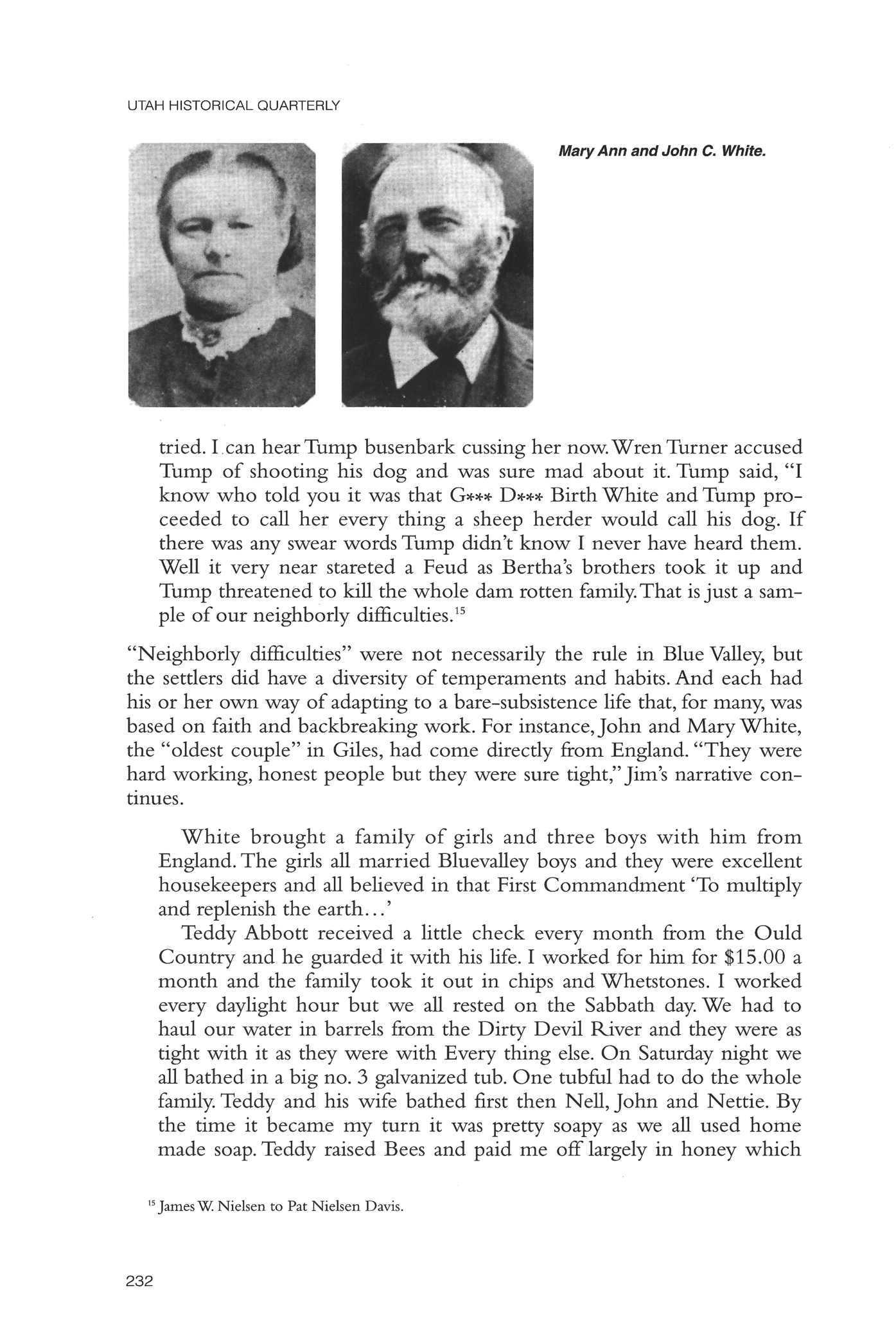
White brought a family of girls and three boys with him from England.The girls all married Bluevalley boys and they were excellent housekeepers and all believed in that First Commandment 'To multiply and replenish the earth.
Teddy Abbott received a little check every month from the Ould Country and he guarded it with his life I -worked for him for $15.00 a month and the family took it out in chips and Whetstones I worked every daylight hour but we all rested on the Sabbath day.We had to haul our water in barrels from the Dirty Devil River and they were as tight with it as they were with Every thing else. On Saturday night we all bathed in abig no. 3 galvanized tub.One tubful had to do the whole family. Teddy and his wife bathed first then Nell,John and Nettie. By the time it became my turn it was pretty soapy as we all used home made soap.Teddy raised Bees and paid me off largely in honey which
UTAH HISTORICAL QUARTERLY
232
15 JamesW Nielsen to Pat Nielsen Davis
he -watered down until it was about half and half.
OscarWhite -was the oldest boy and -was an old batchelor. He filled a mission for the church while we were there When he came back there was such an improvement that we hardly knew him His hands were as white and soft as a woman's.When he partook of the Sacrament, he would nearly drain the glass.I shall never forget what a righteous man I thought he must be after drinking all that Sacrament water. We all drank out of the same glass in those days
The boys generally married the local girls within a radious of ten or fifteen miles.A number of the people living there had never saw aTrain or been in a City larger than Loa Once in awhile alady school teacher would come there and they rarely got away. I remember several City girls who became anchored in Bluevalley.The morals of those people were exceptionally good.The girls were modest to afault. I never heard any off color stories told at our parties When we left Bluevalley and came to Sunnyside [in Carbon County] I -was sure surprised at the difference.16
According to Jim, the Nielsen family had its own ways of surviving life in BlueValley.
We never was without food in our home, sometimes only bread and
16 A few of the other Giles residents mentioned in the letters include Henry Giles,a"good man" who was named after his father, Bishop Giles "He headed the tribe,and ifyou had an argument or trouble with one, you had the whole family to whip. Right or wrong, they sure hung together.""Lydia [Giles] left Blue Valley and went to work in one of the Mining camps She got in trouble, came home and had her baby and later married John Bacon." "John [Giles] was a very profane man and one day when he was really going good, he was struck dumb and although he regained his speech to some extent, he never could talk fluently again.""Ann [Giles] married a sheepman who run his sheep in the Henry Mountains His name was ChrisJorgensen He was stone deaf and aheck of a nice fellow.""[Frank Mayhew] and I'were real pals when we were kids and stood by each other thru thick and thin We traveled together for protection as the Giles boys would gang up on us if we were alone." "Luella [Mayhew] married a Nielsen boy on the Reservation She died when she had her first baby.""Bill Shirts was the blacksmith in BlueValley and a pretty good one His wife, Sarah, was a very sweet woman and was President of the Primary She baked our bread and I shall never forget how good it tasted Pa furnished the flour and she baked our bread for half and it was sure worth it."
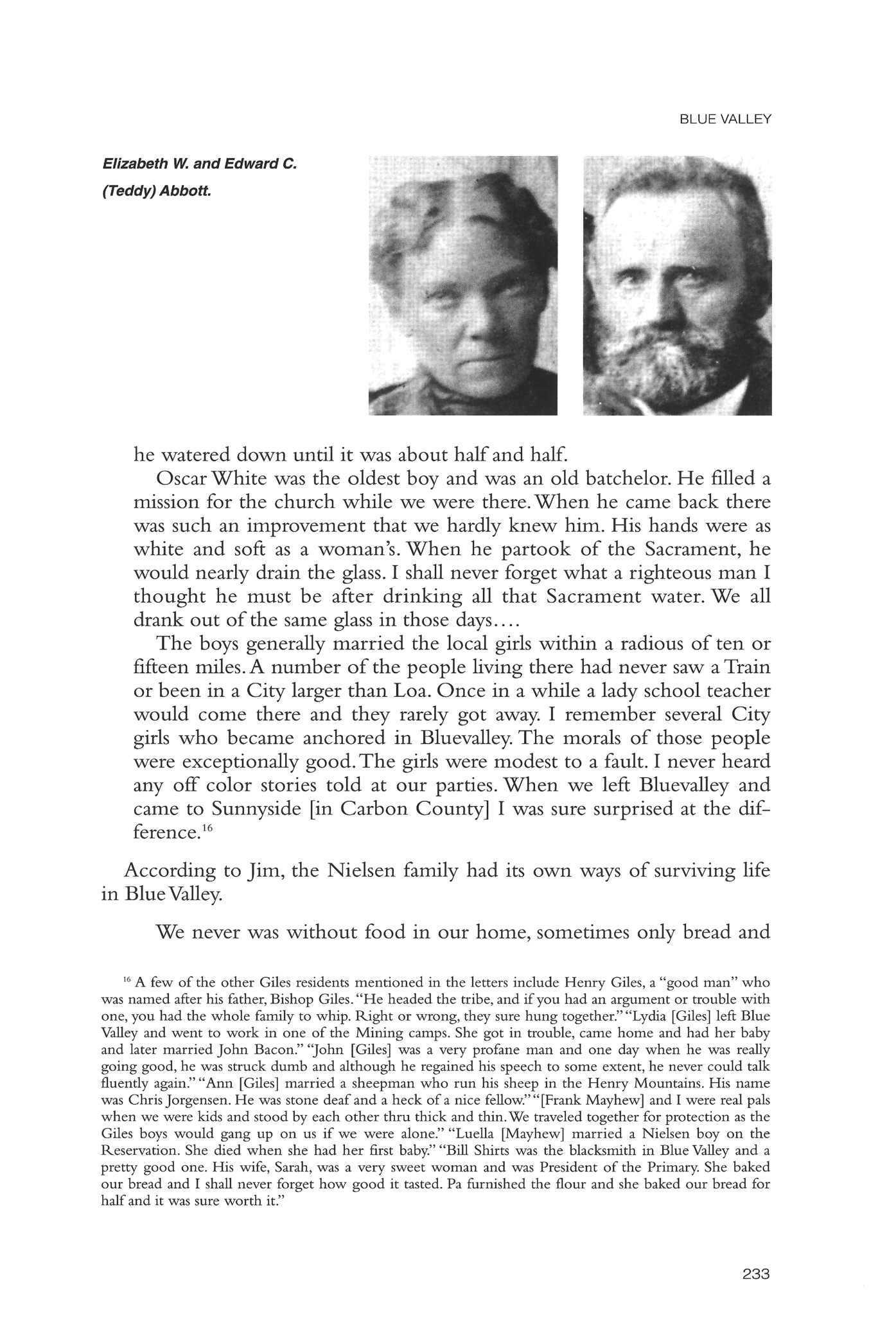
BLUE VALLEY
•MB9U M
Elizabeth W. and Edward C. (Teddy) Abbott.
233
UTAH HISTORICAL QUARTERLY
molasses and Brigham tea17 with a cottontail rabbit once in a while Mother would go to the flour bin for a mixing of bread and -would say, "Pa, I doubt if there is another mixing of flour there." But there was always another mixing.This would go on for weeks at atime.18 Nothing went to waste Bacon rinds were preserved and guarded to grease the drippers. One day the cat got the last bacon rind and I can remember mother calling all of us to come and help as the damn cat had the greaser.We never caught the cat.After that she sprinkled flour in the dripper to keep the bread from sticking
Father and Mother had a baking powder can in our cupboard where they deposited their tithing and one-tenth of any money of what -we got hold of was deposited in that can They were strict tithing payers We could go -without shoes, clothes or any necessity but that baking powder can belonged to the Lord and -wasnever touched and the blessings predicated upon keeping that commandment were fulfilled many times over during those lean years
St.Vitas Dance was very prevalent among the little children of our community and they believed they -were possessed of the devil as they would do and say many things -while under the influence of these attacks Maybe the devil did have something to do with it and they were more susceptable under their weakened condition. But as I assess it today in my opinion, it was a lack of proper nourishment.19 We had the same food as everyone else, but our family -was never afflicted and we saw much suffering along with our neighbors and several unexplainable deaths.
Two of our finest young women caught little colds and were found dead in their beds the next morning for no explainable reason. 20 Then
17 Genus Ephedra, a low-growing shrub with jointed stems and scale-like leaves common to southern Utah;Treshow et at, Guide to the Woody Plants of Utah, 98. Ephedra is a strong stimulant and has decongestant properties;it is also called Mormon tea
18 During this time, family tradition has it that N J and Minnie had taken in the orphaned Lafe, Leonard, Moroni, and Mary Ann Hunt, and the family worried that there would not be enough food That there was always another "mixing" of flour in the bin they regarded asa miracle
19 St Vitus' dance, or Sydenham's chorea, is a nervous system disorder causing spasms of the face and limb muscles; it results from allergic reaction to streptococcal infection Another type of chorea, Huntington's, is an inherited disorder of the nervous system. See the World Book Rush-Presbyterian St. Luke's Medical Center Encyclopedia.
In one of the letters to his sister,James gives more credit to the devil than to nutrition:
"An epidemic of St Vitus dance hit the valley and half the families were affected People became possessed of the devil and we sure had some great experiences with him The Elders would make him depart from one place and he would tell them thru the person possessed that he was going to another place and possess them You could feel his influence so strong that it made your hair stand on end Not all the people in BlueValley were wicked, but there were some pretty tough old Mormons lived there."
Minnie Nielsen believed the valley was a hangout for the Book of Mormon's Gadianton Robbers For another account of Mormon belief in devils and Gadianton Robbers, seeW Paul Reeve,"Cattle, Cotton, and Conflict: The Possession and Dispossession of Hebron, Utah," Utah Historical Quarterly 67 (Spring 1999), 171-73
20 The girls wereJennie and NellTurner "Fred Giles was engaged toJennieTurner and they had set the date It was quite a blow to him and he never married He died alone in a Hut on the Dirty Devil";James W Nielsen to Pat N Davis
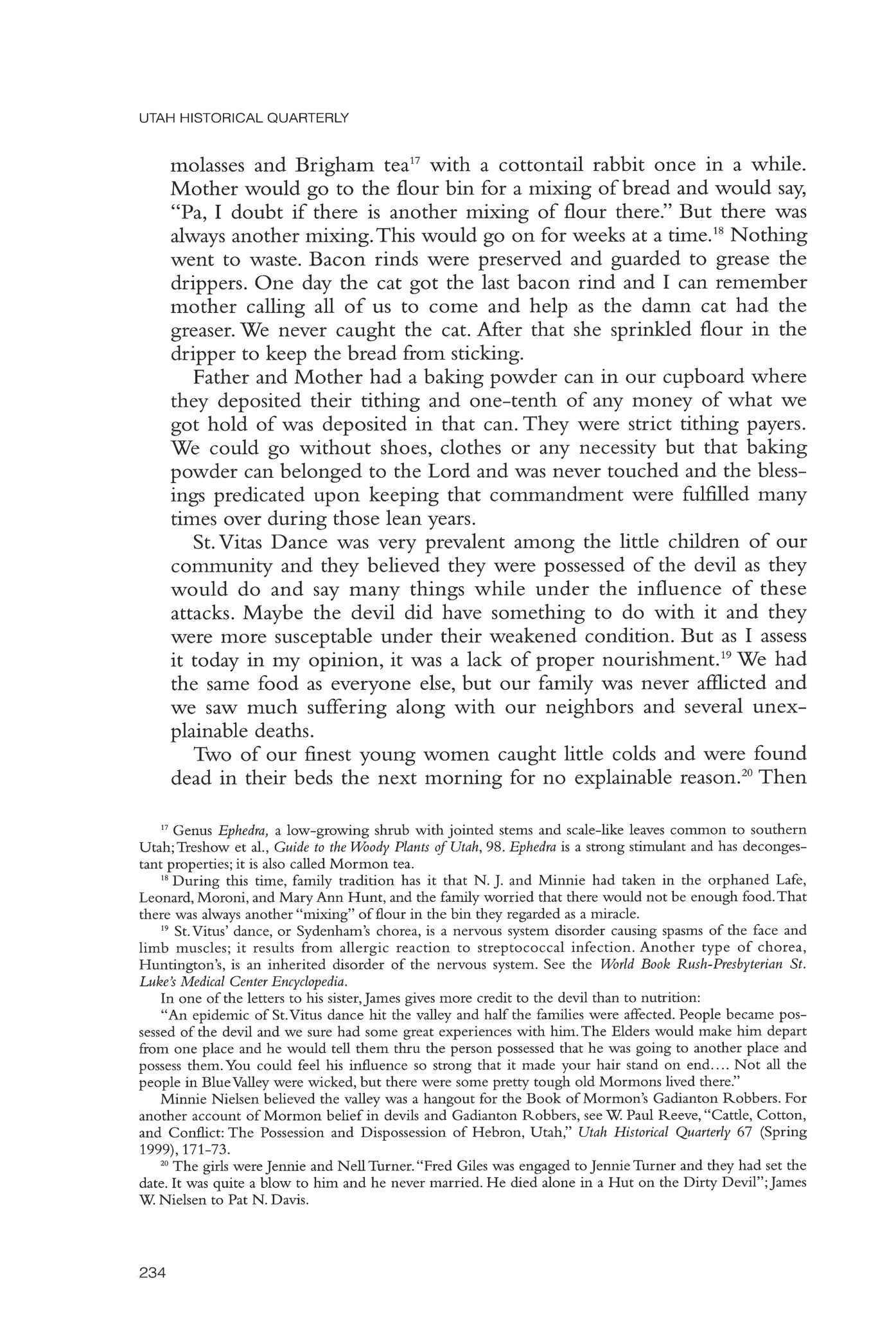
23 4
Small Pox hit our town. Henry Giles contacted [it] -while in Emery County after supplies.When he got home the whole family was stricken and helpless within a week A town meeting -was called, everyone was scared pink, asSmall Pox-wasakiller in those days The Giles family had to have help as they -were all down, and lived across the river from the town.

Father volunteered to go and take care of them, which he did, cooked, washed and seen them through. Mother and I -would go down to the river bank and visit with father by calling across the river.Archie Young, the town health officer, got so scared they stopped us from doing that. Father never got the Small Pox and it spread no further. The people were frightened they had the Giles family set fire to their home and burn everything they had.The people then pitched in and built them aone-room house on the town side
We had a large one-room meeting house -with a potbellied stove in the center of the room in which we held church, school and all public meetings.All the grades -went to school in that one room from kindergarden to grown men and women. They had an awful time keeping teachers as the big boys would run them out of town if they tried to correct them The same thing happened to the girl teachers who came there The young ladies of our town would clean up on them and send them home crying.We were without school more than half the time. The meeting house had a dirt roof with a log sticking out on the corners When -we got tired of school one of the boys would climb onto the roof, stuff the chimney full of trash and smoke us allout,and ended school for that day.21
What dances -we had in those days!The town was full of musicians. All of the Hunt family played the fiddle also our old friend, Henry Lords, asthat -wasabout the only entertainment we had,we danced two or three times a -week.22 The men always had plenty to drink as they made wine out ofthe grapes andwhite eye out ofthe green skimmings of the molasses.That -white eyewaspotent stuff, it would make a canary tackle an eagle The dances invaribly ended up in a big fight with alot of busted noses and sore heads.23 They always fought out their fueds at the dances.We had anumber ofgood square dance callers and I can still hear OldTomBusinbark stomping the floor ashe kept time to "Hell in the Cottonwoods." He -would generally have an epileptic fit before the dance wasover andhave to be carried home.
21 According toJoseph, education was second to farm work for the children, who might start herding cows at age sixandbe able to do an adult's work by age fourteen Joseph only went to school in the middle of winter, and only part of the time even then, since often he could not cross the"high and tretcherous"river to the school
22 Besides playing fiddle, Henry Lords ran asawmill in the Henry Mountains
23 At one dance "Jont Hunt andJim Bergess had a fight and Hunt bit offJim Bergess's nose and swallowed it";James Nielsen to PatNielsen Davis
BLUE VALLEY
23 5
UTAH HISTORICAL QUARTERLY
Father was a peacemaker, and lived his religion and those wild tough men respected him and for some reason feared him just a little Maybe it -wasbecause he had the Lord on his side and knew what he -was talking about. Father was a builder and in all their poverty they decided to build a new church.They put him in charge of construction, he drew the plans and made a beautiful drawing of how the church would look when finished. Each family in the valley contributed all they could in labor and commodities.

Father examined the soil and picked out a spot about a mile from -where the meeting house was built to make the adobies Many of the men helped mix the mud Father molded all the adobies,in fact, he put in his entire time until the building was completed. Doing all the mason -work and a large part of the carpenter work. The settlers paid him for his time in the things they had; molasses, honey, pigs,corn, and a horse or two How they ever done it I -will never be able to explain They hauled the lumber from the Boulder Mountain, fifty miles away, and bought tongue and grove flooring in Richfield at seventy-five dollars per thousand feet and hauled it to Blue Valley through what is called Wayne Wonderland now, we called it Capital Wash24 and in its natural state you can find nothing more rugged in Utah.
The building was, as I remember, about seventy by forty feet with nice comfortable bench seats and a good cedar shingled roof and it -was paid for when it was completed. Don't tell me you can't get blood out of a turnip.As poor as we were, father contributed over seven hundred dollars in labor and money, and wages in those days were about onetenth of what they are now The building was completed in 1900 or 1901 and stood in tact for over sixty years. It was the last building left standing in BlueValley.Our family visited the valley the year before joe died.25 The foundation of the building was still in good shape and the old door frames and -window lintels were still scattered around We found the old horse drawn tithing yard hay bailer with hay still in it. It could have been repaired in afew hours and used again.
Well things went from bad to worse,we had so many crop failures as we could not keep the water in our canals. Maybell came down from Teasedale,where she had been working and as she was anew girl in the valley she was very popular with the young men. She could have had her pick as she was a neat dresser and had some nice clothes and for a Nielsen was really good looking.What a celebration we had when she and Henry Hunt -were married.26 Everyone in theValley was there and we really put on a splurge, never saw so many pies in my life. Everything we had was sweetened -with molasses We would dump our
236
1 This would be Capitol Gorge, now part of Capitol Reef National Park. 'Joediedin 1962 ' Henry had been born in 1874 in Hebron, Utah
Theadobe walls and steeple of the meetinghouse N. J. Nielsen built. Thelumber came from Boulder Mountain and Richfield, but the settlers did not have to leave the valley to find mud for the adobes.
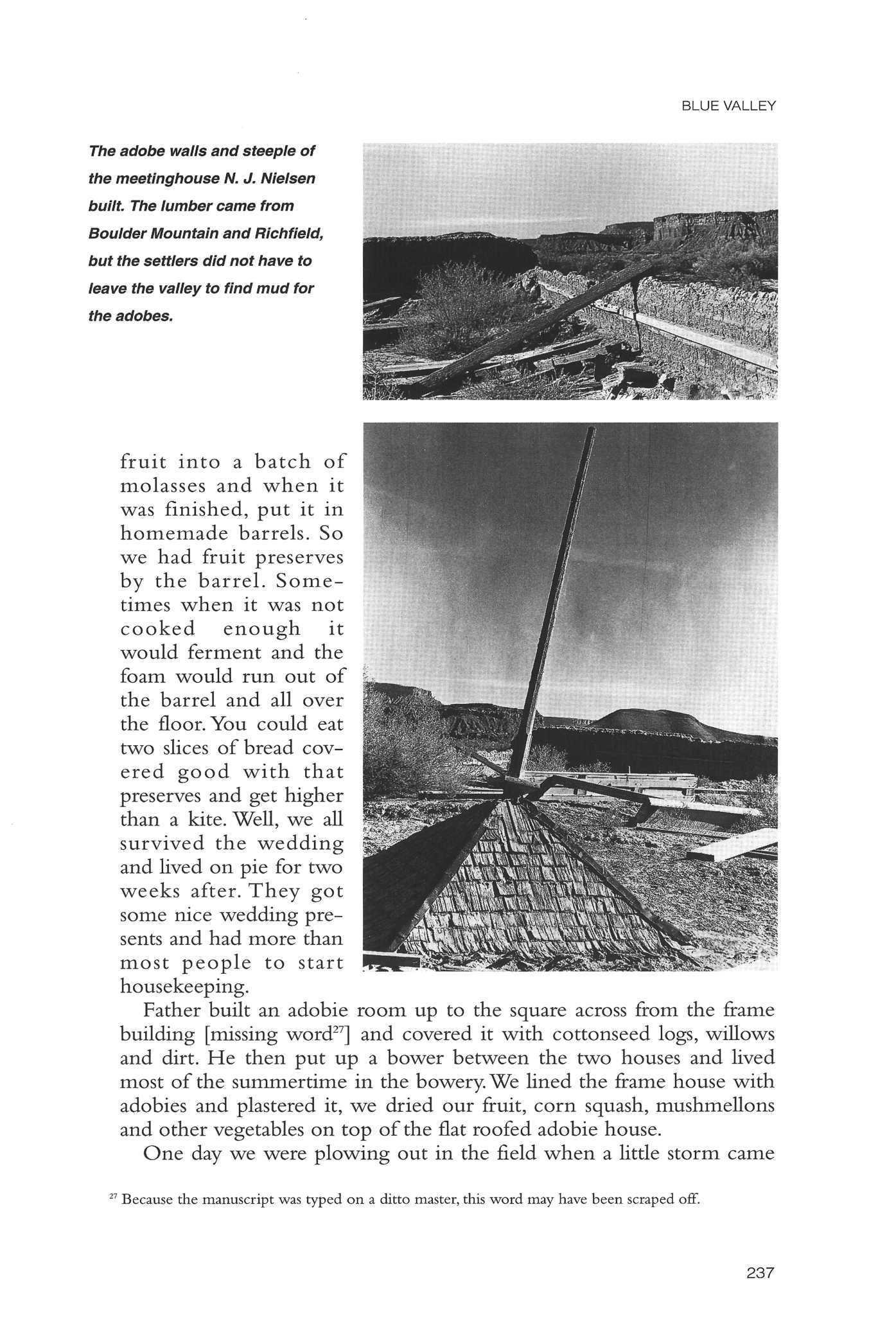
fruit into a batch of molasses and when it -was finished, put it in homemade barrels So we had fruit preserves by the barrel Sometimes -when it was not cooked enough it would ferment and the foam would run out of the barrel and all over the floor You could eat two slices of bread covered good with that preserves and get higher than a kite Well, -we all survived the wedding and lived on pie for two weeks after They got some nice wedding presents and had more than most people to start housekeeping
Father built an adobie room up to the square across from the frame building [missing word27] and covered it -with cottonseed logs, willows and dirt. He then put up a bower bet-ween the two houses and lived most of the summertime in the bowery.We lined the frame house with adobies and plastered it, we dried our fruit, corn squash, mushmellons and other vegetables on top of the flat roofed adobie house.
One day -we were plowing out in the field when a little storm came
BLUE VALLEY
237
'Because the manuscript was typed on a ditto master, this word may have been scraped off
UTAH HISTORICAL QUARTERLY
up, we heard mother running toward us screaming for help, we rushed to the house and found Grandma lying on the ground beside the ladder. She had attempted to get the drying fruit off the roof before the rain hurt it, the ladder slipped and Grandma came tumbling down. Pa and I carried her in the house and put her in bed but she never stood on her feet again. She quit cold which is a German trait She had never seen a sick day and worked like a beaver all her life, she recovered but had made up her mind that she was going to die. She ate hearty but -would not get out of bed, she got the dropsy and laid there until she smothered and had to sit up in a chair. Father built a special chair for her. Mother waited on her and lifted her around until she died.28 Mothers health was never good and Grandma almost killed her before she passed away.
N. J. Nielsen made this headstone for his mother-in-law, Johanna Schiller, by pounding nails in a board to form the letters.
Although the family grew a good crop in 1902, the irrigation system failed in 1903.The children carried river water to the garden in buckets, but the food supplies dwindled
Things finally got so tough that we had to do something. Father and I loaded up a wagon full of molasses and dried corn, leaving mother and the family in Blue Valley we came to Castle Valley to peddle our load.We spent several days peddling in Emery and Farren and finally disposed of the molasses at forty cents a gallon.
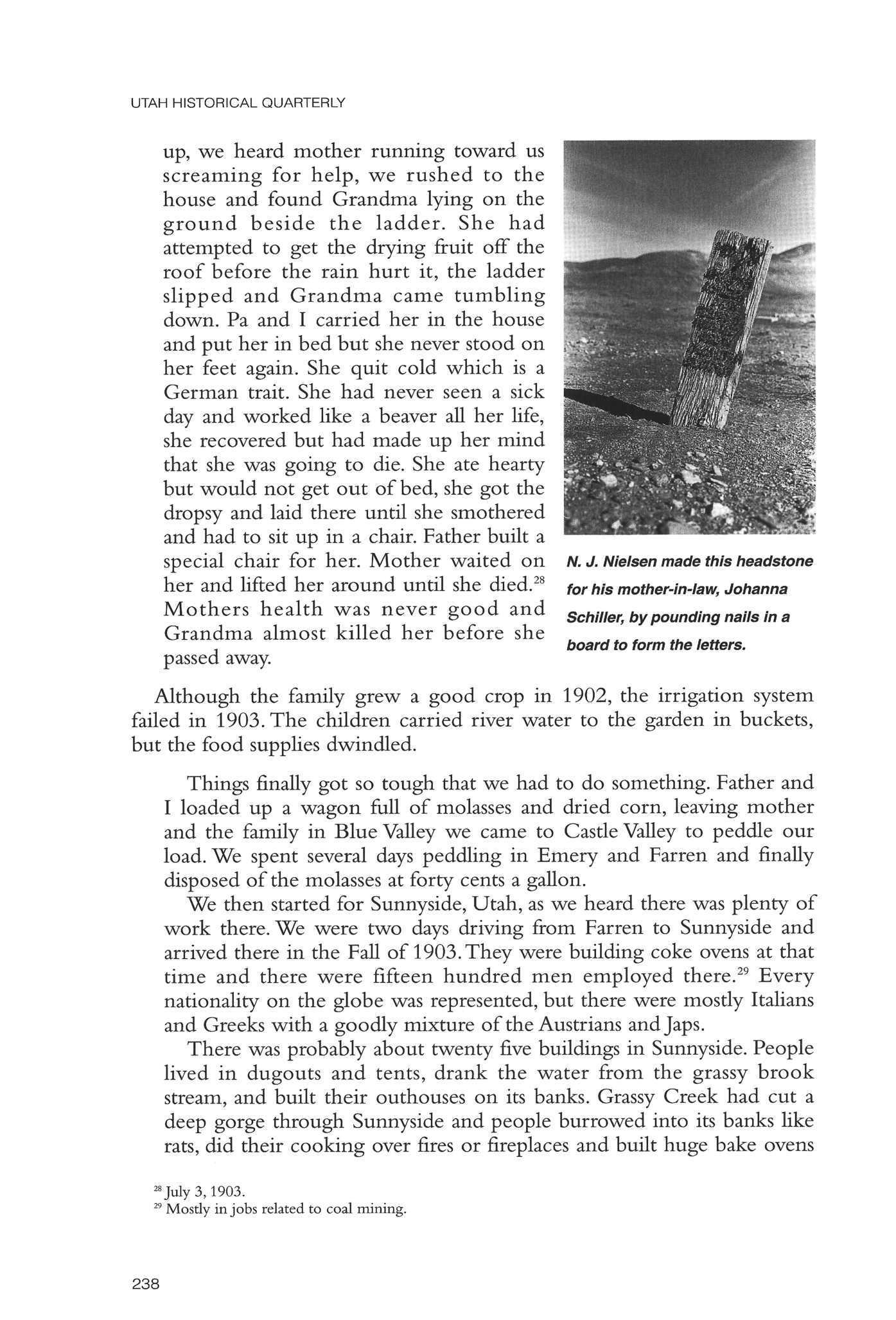
We then started for Sunnyside, Utah, as we heard there was plenty of work there We -were two days driving from Farren to Sunnyside and arrived there in the Fall of 1903.They were building coke ovens at that time and there were fifteen hundred men employed there.29 Every nationality on the globe -was represented, but there were mostly Italians and Greeks with a goodly mixture of theAustrians andJaps
There -wasprobably about twenty five buildings in Sunnyside. People lived in dugouts and tents, drank the water from the grassy brook stream, and built their outhouses on its banks. Grassy Creek had cut a deep gorge through Sunnyside and people burrowed into its banks like rats, did their cooking over fires or fireplaces and built huge bake ovens
28
238
July 3,1903 29 Mostly injobs related to coal mining
outside where they would bake a two week supply of bread at one time.What a change it was.We had always lived in a Mormon community where all that were not Mormons were gentiles and outsiders. Here in Sunnyside -we were the outsiders as there was only a handful of Mormons in the community
Father and I had no trouble getting jobs, he was a good drop mason and could draw top wages.I understood horses and started driving team hauling rock on a stone boat off the side of the mountain for the masons to cut and hew to build the ovens. We were making more money in a day than we made peddling our molasses after working all summer to raise it. Father sold our team and -wagon for a good fair price and sent the money to mother. Our financial troubles were over for a while.We worked good all Fall and winter, batching it except for one meal a day which -we ate at the boarding house
Pa paid his tithing regularly and insisted that I do the same He took an active part in the church and they sure needed all the help they could get. Grandma died in Blue Valley while Pa and I -were in Sunnyside and mother had to take care of all the funeral arrangements -with the help of the neighbors they got thejob done Henry Hunt and Maybell moved them [the rest of the family] out [to Sunnyside] and Henry got ajob at once so they pitched a tent and stayed.

Brother Frank -was born in Sunnyside on May 9th , 1904 He was the caboose, Mothers health had always been very poor and when John Henry and my sister Mary -were born in Blue Valley she nearly died both times as we only had mid-wives and if anything went wrong they -were at sea How often we had all knelt around mothers bed holding hands and praying for God to spare her when it seemed like all the blood in her body had drained out. Pa never seemed to worry much and -would go on about his -work.We thought he was pretty cold blooded but he knew what he was doing better than any of us He prayed, did all he could then left it up to the Lord and seemed to be sure that she -would be all right and she was.
When Frank was born in Sunnyside, we had a good doctor, the first she had ever had when one of her children -was born. Father bought a very large tent and pitched it on a hill across from the coke ovens in the lower end of Sunnyside, we also built a dugout in the side of the mountain where we all slept as it was cool in the summer and warm in the winter We had two tiers of bunks in the dugout with an alley bet-ween Mother and father took in boarders and -we did all the cooking and eating in the large tent which was boarded up to the square.They had five or six boarders who paid them $22.50 a month for board They bought most of their supplies from peddlers who came up from Castle valley with butter, eggs,meat and all kinds of vegetables.
The folks were making money, but mother did not like the mining camp so they moved to Huntington in Emery County where they
BLUEVALLEY
239
bought a home from Antoine Nielsen, (no relation), the house consisted of two log rooms with an acre and a half of ground in the Southwest corner of Huntington. Father did well from the start, and always had more work than he could do,but he felt that his mission inWayne County had never been finished, so they stored up supplies,bought anew wagon, team and harness, sold their home to me and moved back to Blue Valley to finish their assignment.
They moved back in 1906 and with enough means to start the grind all over again They bought the old Knewl Knight home in Clifton three miles below our old home. The place had a fine large orchard, grape vineyard and large alfalfa fields.They bought chickens,pigs and a cow or two and were really fixed fine. Henry and Maybell were still in Huntington
My wife and I had bought Father and Mothers home there and were settled down. Father and mother were anxious to have us move back to BlueValley.Henry and Maybell and my wife and I sold out our belongings and moved back to BlueValley That was our big mistake Two years later we had a flood that took everything before it Bishop Elliot [Joseph H. Ellett] and I stood on the banks of the Dirty Devil River at Hanksville and watched the farms and houses go down the river. I shall never forget BishopJoseph Elliot saying,"Jim,ifwe ever get out of here and tell people what we have seen today,they will never believe us."We saw whole orchards with ripened fruit on the trees floating down the river along with houses,barns,pits,chickens and cattle and most everything we had Father and mother were washed out completely, their
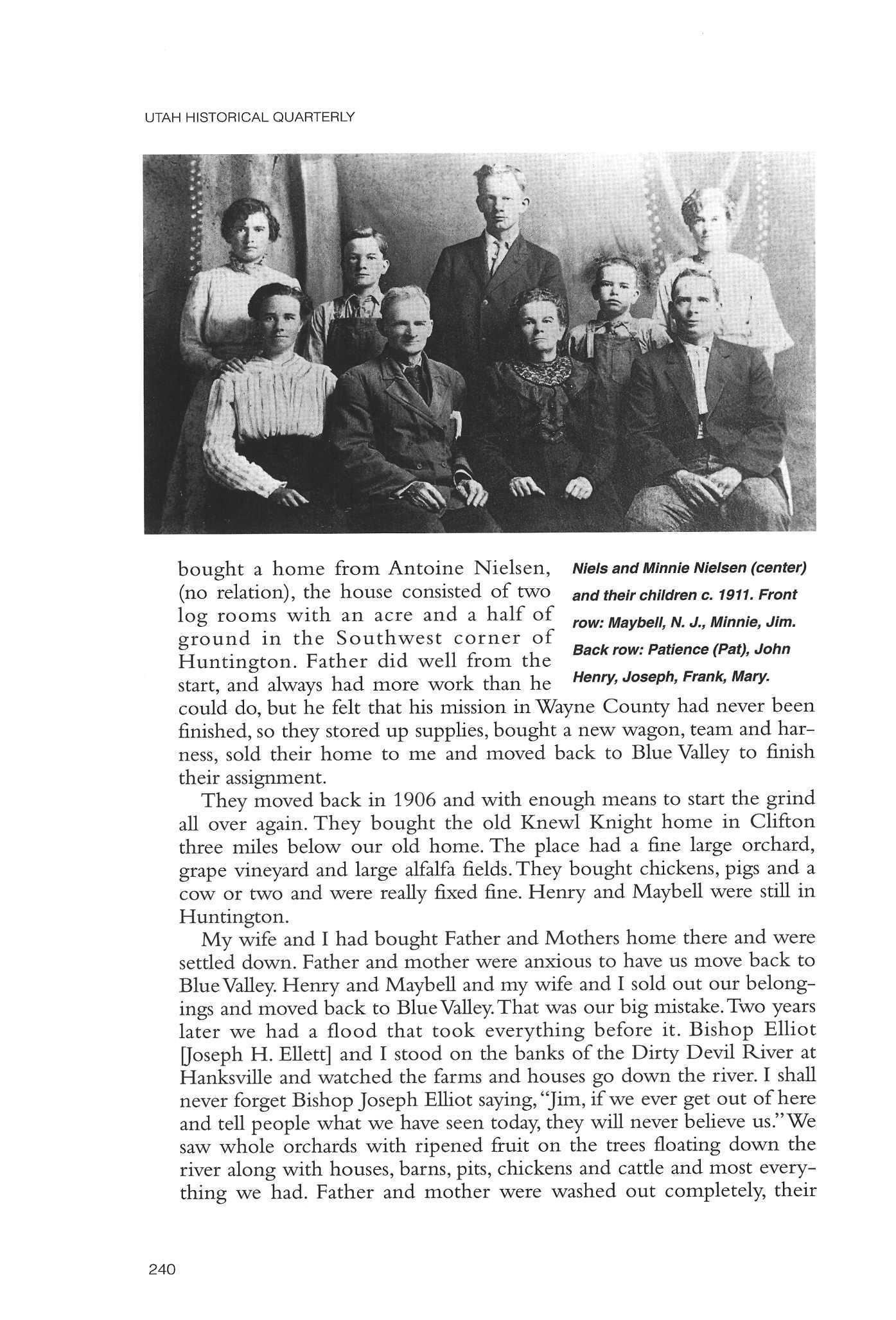
UTAH HISTORICAL QUARTERLY
Mete and Minnie Nielsen (center) and their children c. 1911. Front row: Maybell, N. J., Minnie, Jim. Back row: Patience (Pat), John Henry, Joseph, Frank, Mary.
240
whole farm -wasnothing but a river bed.
Joseph gives the date of the big flood as 1909 He says that the river was in flood for most of two months and that it took out large amounts of farm land, widening the river until it cut a wide swath through the valley Overgrazing had caused flooding of this nature to become more and more common in southern Utah, a circumstance that was documented during the 1930s in aWPA project on grazing The interviews and notes gathered byWPA writers consistently discuss the depletion of groundcover and the resulting floods that left wide gullies across the land.30
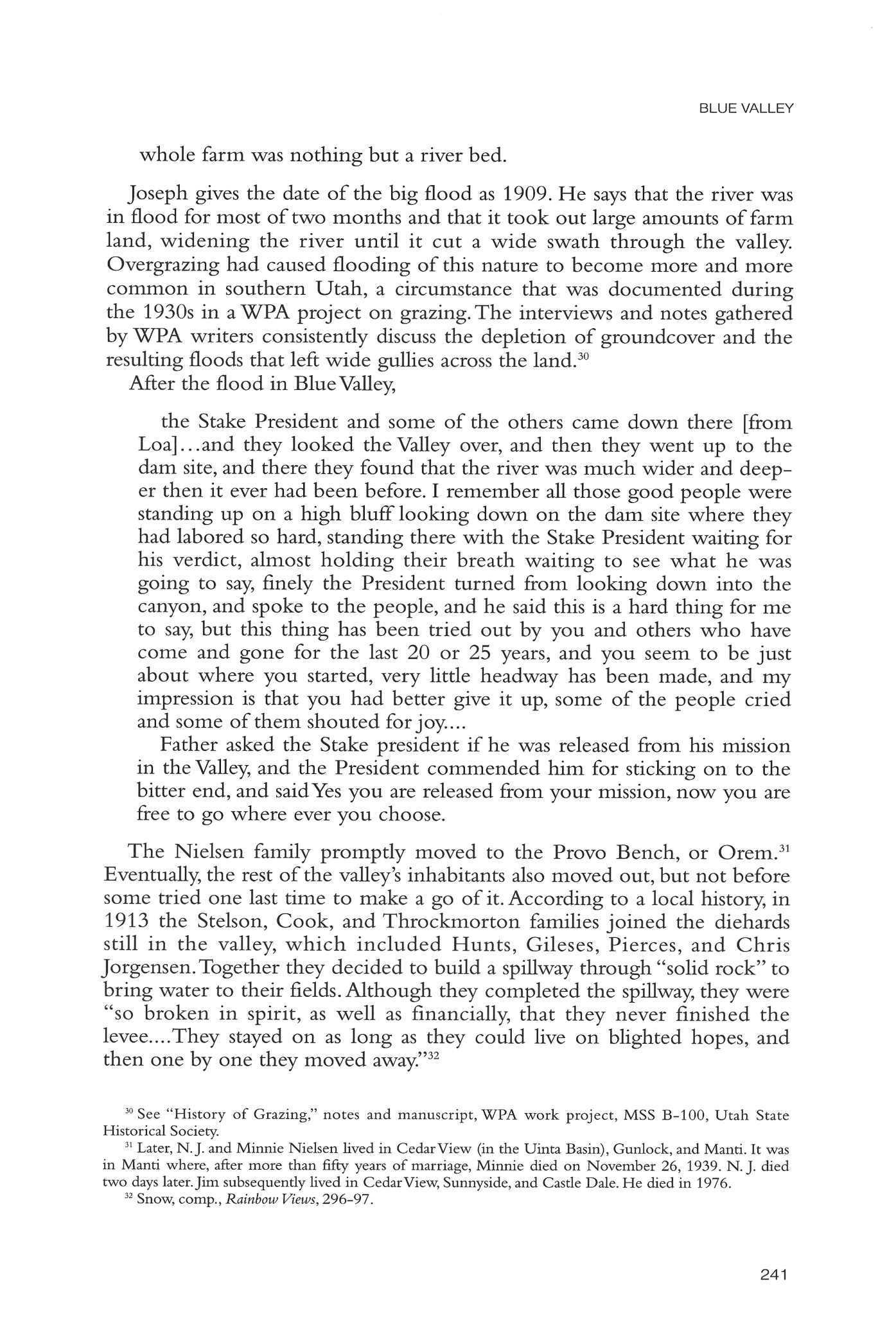
After the flood in BlueValley,
the Stake President and some of the others came down there [from Loa]...and they looked the Valley over, and then they went up to the dam site,and there they found that the river was much wider and deeper then it ever had been before. I remember all those good people were standing up on a high bluff looking down on the dam site where they had labored so hard, standing there with the Stake President waiting for his verdict, almost holding their breath waiting to see what he was going to say, finely the President turned from looking down into the canyon, and spoke to the people, and he said this is a hard thing for me to say, but this thing has been tried out by you and others who have come and gone for the last 20 or 25 years, and you seem to be just about where you started, very little headway has been made, and my impression is that you had better give it up, some of the people cried and some of them shouted for joy...
Father asked the Stake president if he -was released from his mission in theValley, and the President commended him for sticking on to the bitter end, and saidYes you are released from your mission, now you are free to go where ever you choose.
The Nielsen family promptly moved to the Provo Bench, or Orem.31 Eventually, the rest of the valley's inhabitants also moved out, but not before some tried one last time to make a go of it.According to a local history, in 1913 the Stelson, Cook, and Throckmorton families joined the diehards still in the valley, which included Hunts, Gileses, Pierces, and Chris Jorgensen.Together they decided to build a spillway through "solid rock" to bring water to their fields. Although they completed the spillway,they were "so broken in spirit, as well as financially, that they never finished the levee....They stayed on as long as they could live on blighted hopes, and then one by one they moved away."32
30 See "History of Grazing," notes and manuscript, WPA work project, MSS B-100, Utah State Historical Society
31 Later, N.J and Minnie Nielsen lived in CedarView (in the Uinta Basin), Gunlock, and Manti It was in Manti where, after more than fifty years of marriage, Minnie died on November 26, 1939 N J died two days later.Jim subsequently lived in CedarView,Sunnyside,and Castle Dale.He died in 1976.
32 Snow, comp., Rainbow Views, 296-97
BLUE VALLEY
241
UTAH HISTORICAL QUARTERLY
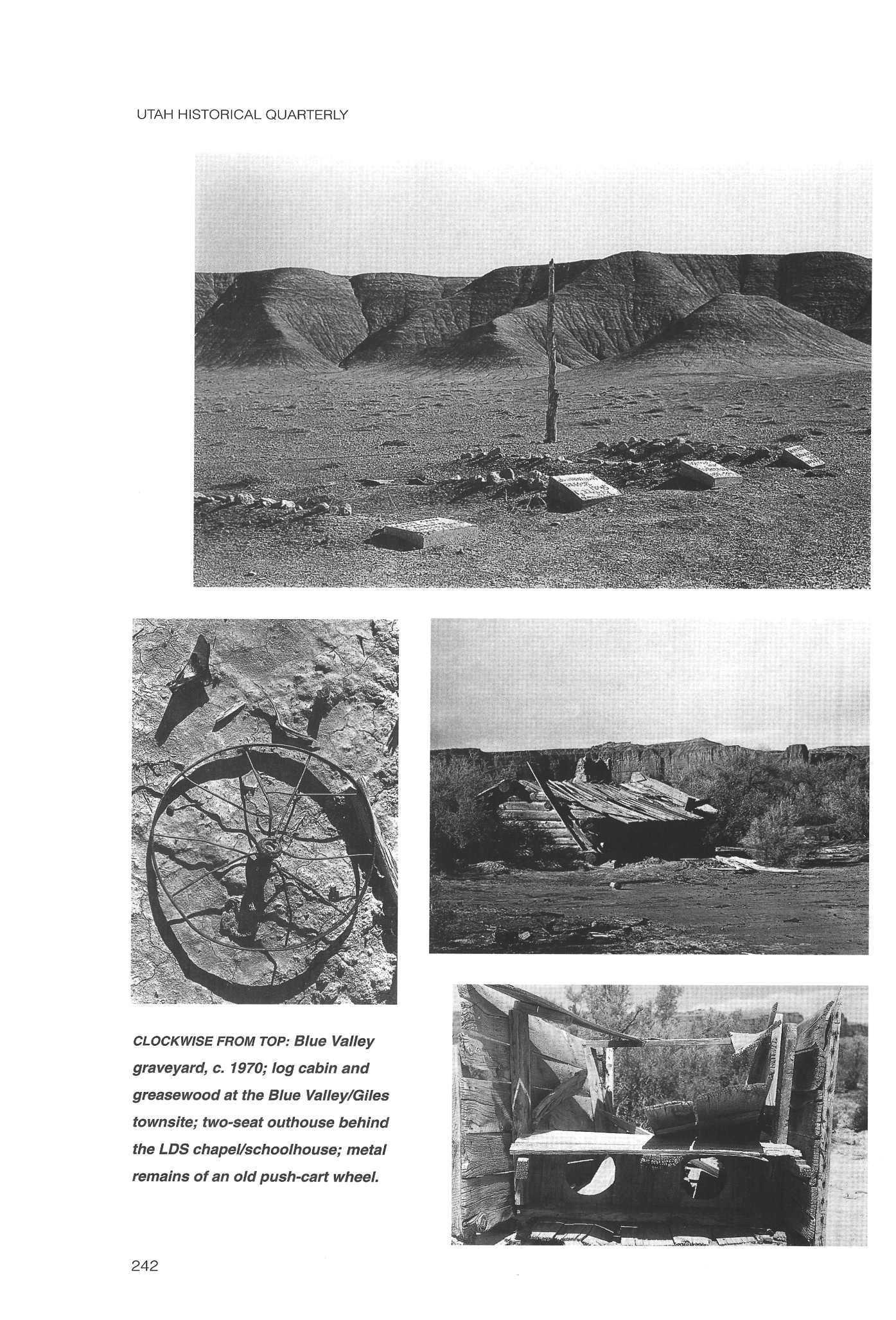
242
CLOCKWISE FROM TOP: Blue Valley graveyard, c. 1970; log cabin and greasewood at the Blue Valley/Giles townsite; two-seat outhouse behind the LDS chapel/schoolhouse; metal remains of an old push-cart wheel.
As one of those who had worked to wrest a living from BlueValley,Jim Nielsen must have recognized how the geography of the place worked against the settlers Maybe he also recognized a connection between overgrazing and flooding. But in trying to find a reason for the community's failure, he turned not to these factors but to the paradigm of faith—the same paradigm that had led his family to the valley in the first place. A faith-steeped explanation for the flooding could justify the priesthood leaders who had called the settlers to Blue Valley and -who had promised the settlers that if they kept God's commandments they would prosper. 33 A faithful explanation could alsojustify his own family's prodigious and sacrificial efforts to obey this call Perhaps it -was natural, then, for him to blame the failure of the community on those he called the "bad influence.""I will tell you about those who brought on the disaster," he wrote his sister. "I heard Sister [Lydia] Giles tell the people in front of the old meeting house one Sunday what would happen if they did not repent and quit making -whiskey and wine."
In his history,Jim looks back at a community that -was not able to survive "Not a single living soul has lived in the valley since and the majority of the valley is still river bottom."
The Greasewoods grow so high that they have obliterated all signs of human habitation, but if you have time and -will search long enough, you will find an old graveyard high and dry.The old foundations of many houses and the remains of a beautiful church building that -was built by a bunch of the most determined pioneers that ever lived in Utah.They were handlisted tough men and today -would be poor Latter Day Saints.
Most of them did not keep the Word of Wisdom, they made and drank their own whiskey and wine and -when times were tough lived on greasewood greens and faith.The Word ofWisdom was not a commandment in those days, but the people were advised to keep it.34 Maybe because they did not, the Lord permitted the valley to be destroyed and its people scattered.There is very little life in the valley today—our family stopped there a day and night We saw no birds, or wildlife, not even an animal track on the soft blue hills.
34 The Word ofWisdom is a Mormon health code advising against tobacco and "strong drinks"; it was nven asrevelation in 1833 See Doctrine and Covenants, section 89
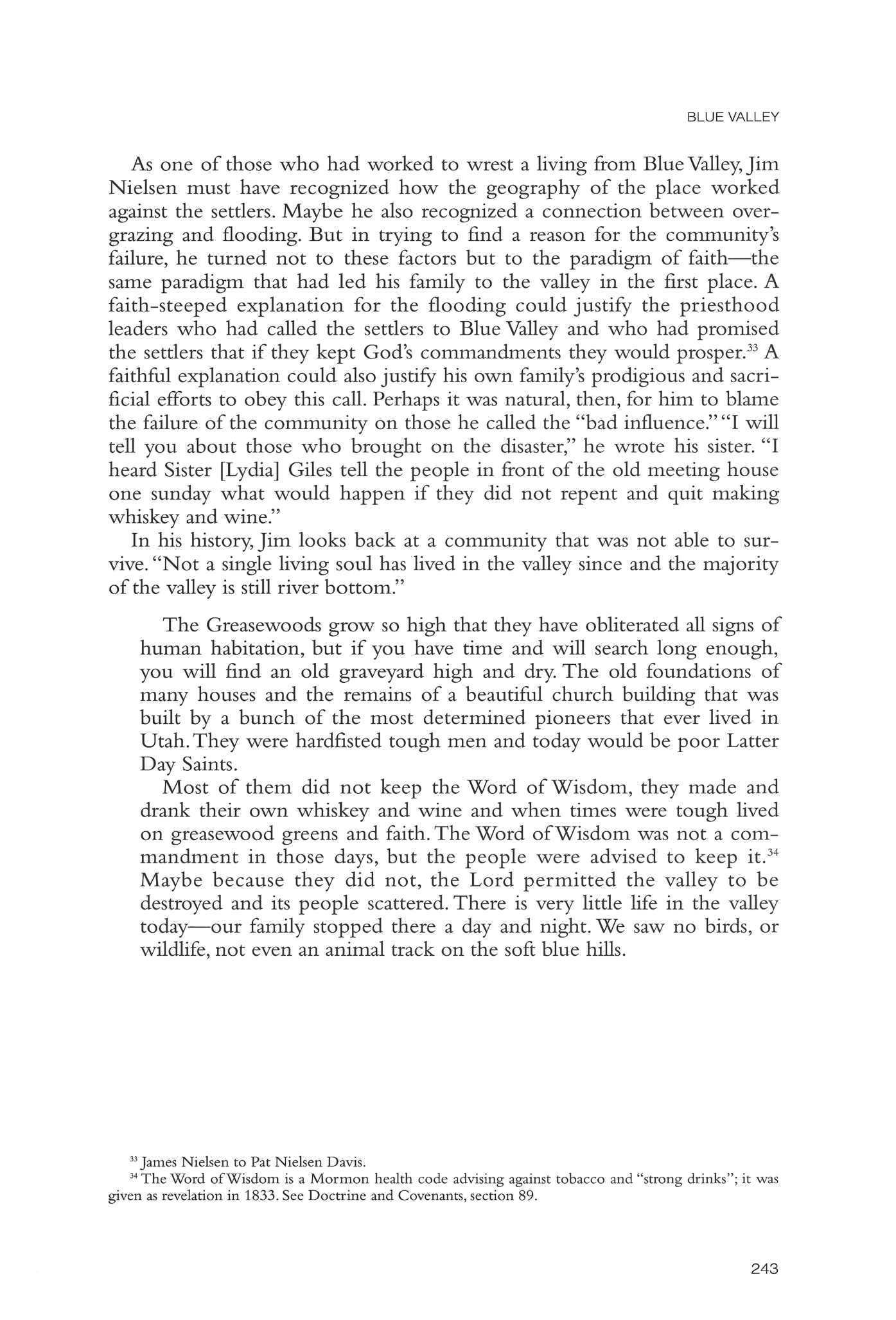
BLUE VALLEY
33 James Nielsen to Pat Nielsen Davis
24 3
Apr.i3.Ki
Price Band Days: The Intermountain Music Festival
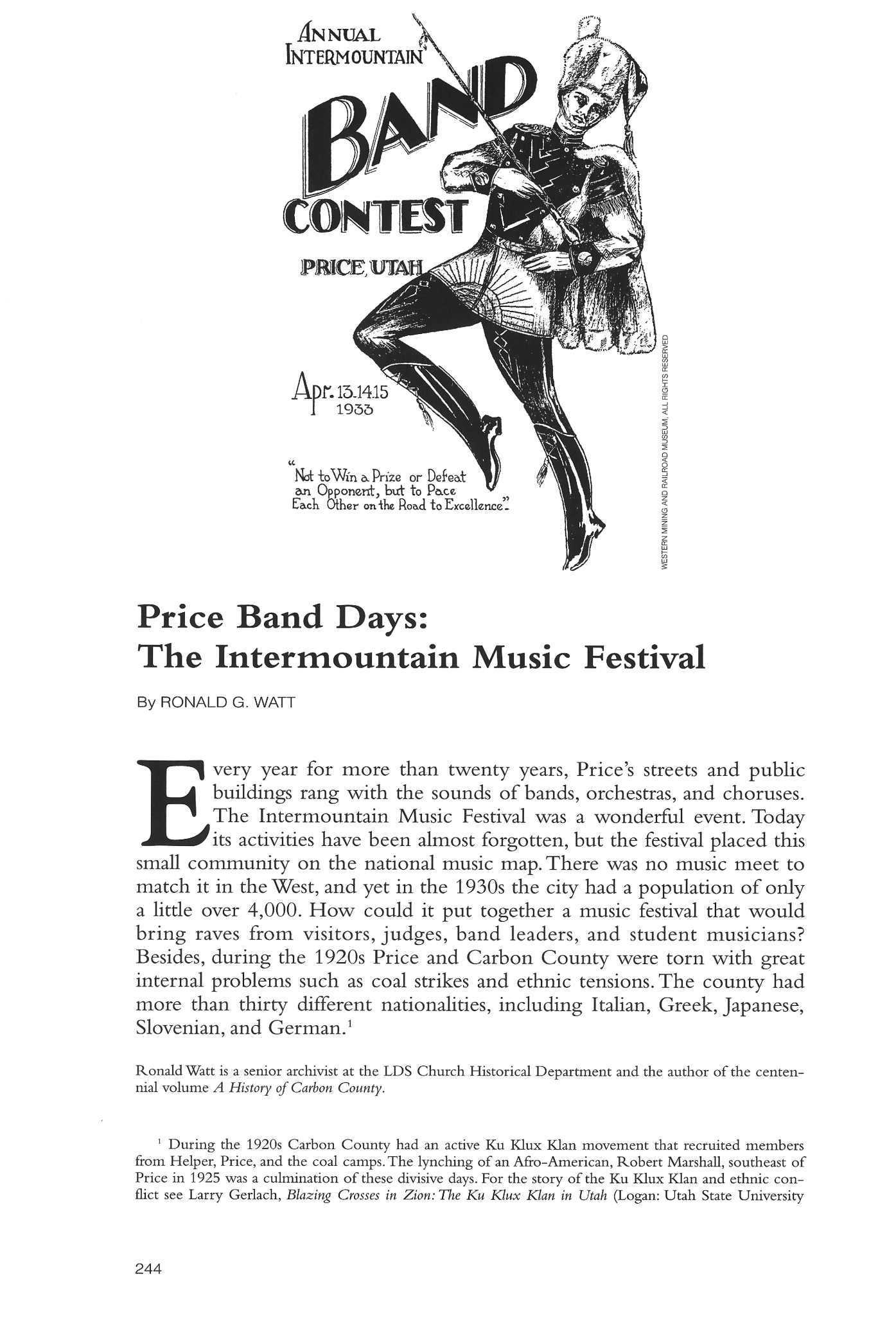 By RONALD G WATT
By RONALD G WATT
Every year for more than twenty years, Price's streets and public buildings rang -with the sounds of bands, orchestras, and choruses
The Intermountain Music Festival -was a wonderful event. Today its activities have been almost forgotten, but the festival placed this small community on the national music map There was no music meet to match it in the West, and yet in the 1930s the city had a population of only a little over 4,000. How could it put together a music festival that would bring raves from visitors, judges, band leaders, and student musicians? Besides, during the 1920s Price and Carbon County were torn -with great internal problems such as coal strikes and ethnic tensions The county had more than thirty different nationalities, including Italian, Greek, Japanese, Slovenian, and German.1
RonaldWatt is a senior archivist at the LDS Church Historical Department and the author of the centennial volume A History of Carbon County.
1 During the 1920s Carbon County had an active Ku Klux Klan movement that recruited members from Helper,Price,and the coal camps The lynching of anAfro-American, Robert Marshall,southeast of Price in 1925 was a culmination of these divisive days.For the story of the Ku Klux Klan and ethnic conflict see Larry Gerlach, Blazing Crosses in Zion: The Ku Klux Klan in Utah (Logan:Utah State University
ANNUAL INTERMOUNTAIN* \ CONlfST
MattoWin a Prize or Defeat am Opponent, but to Pace Each Other ontheRoadtoExcellence
244
Into this milieu entered Edgar M Williams, who was from Emery County and thus was no stranger to Price's diversity. In 1923 the Carbon County School District hired Williams as the music director for the Carbon County High School band and chorus. Because there were two other teachers with the name of Williams in the high school, one of the teachers recommended that they call him "Toot." It was an appropriate name;Williams directed choruses, but his heart was in bands.After receiving a lifetime teaching certificate from Brigham Young University, he taught at Heber City,where he took instruments from a defunct city band and created a school band.
When the Carbon County School District hired E. M. Williams as its new high school music director, it found a man anxious to build a band that would compete with the best.That first year Williams had only nine students in his band. But he began building support in the community for his newly developing music department In order to help fund the band and purchase necessary instruments to loan to aspiring students,the band played at funerals, receiving $50 per funeral from the Miners Welfare Organization. To gain more students, he began teaching private lessons and providing summer group instruction for the novices.2 Always a taskmaster, Williams marched and practiced his band continuously, concerned with every detail.
In the latter part of the decade Williams heard about the new marching band music meets, and he was anxious to test his students in these contests. His opportunity came when in 1930 the chambers of commerce of Price and Grand Junction wanted to promote the transportation system between the two cities William Toy, secretary to the Price Chamber of Commerce, approached Williams about taking his forty-three-member band to the Grand Junction music competition, -which had started four years earlier. Desiring to match his band against more experienced ones, Williams accepted the challenge, but with some apprehension He did not want the members of his small band to be disappointed ifthey failed to do well.3
The Price Chamber of Commerce and the city helped fund the trip, and the Denver and Rio Grande Railroad provided the band with a special car
Press, 1982) and Ronald G.Watt, A History of Carbon County (Salt Lake City;Utah State Historical Society and Carbon County Commission, 1997)
2 Edgar M.Williams, "The Life and Times of Edgar M.Williams as Remembered in theYear 1977 at the age of Eighty-four," Archives and Manuscripts, Harold B. Lee Library (HBLL), Brigham Young University,Provo, Utah
3 Ibid
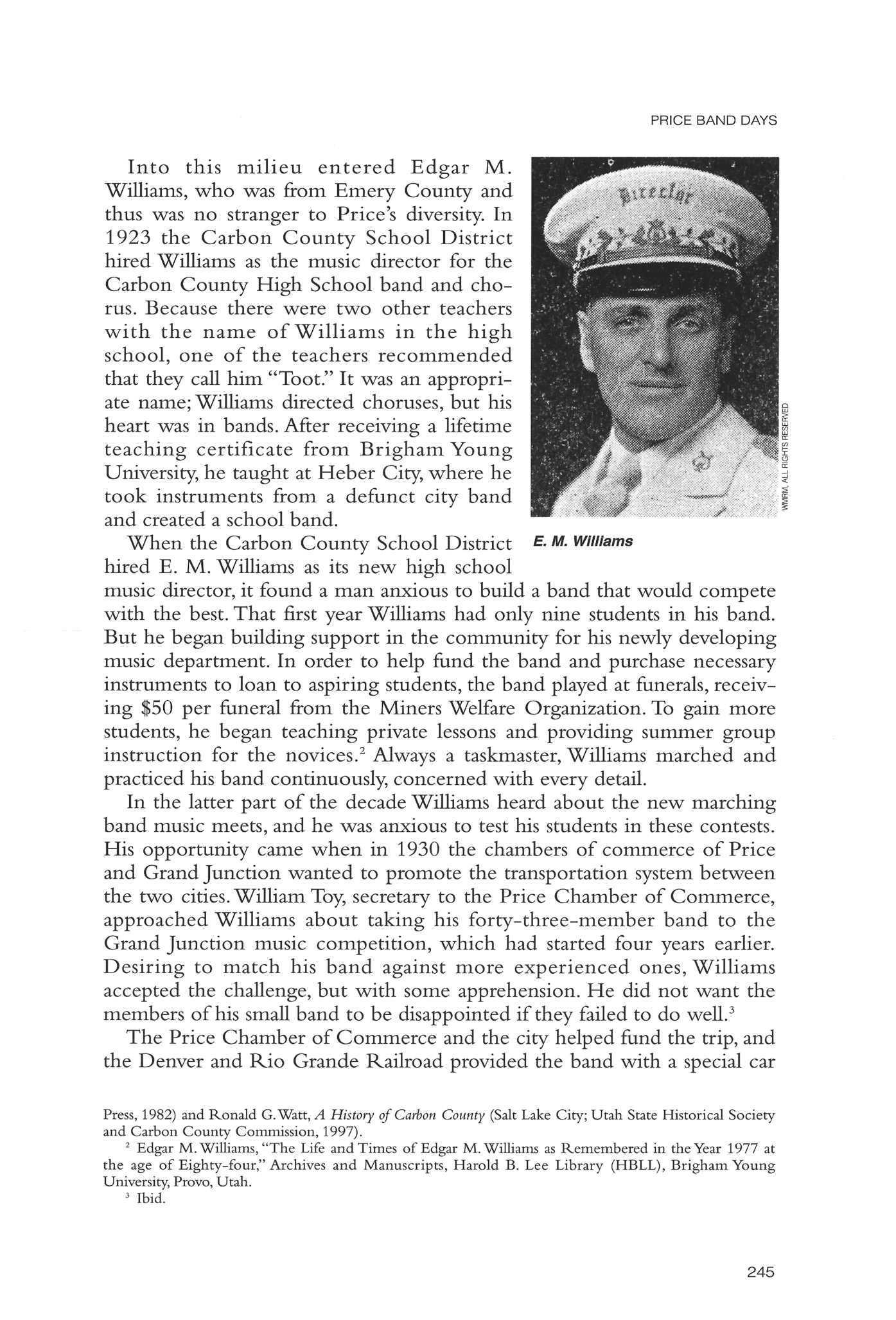
PRICE BAND DAYS
E. M. Williams
245
on the train. In competition against twenty Carbon High School Band, n.d. bands, the Carbon High School Band performed magnificently, taking first place in every category and winning the C G Conn trophy for the outstanding band of the meet AsWilliams said, "Surprise of surprises and wonder of wonders! Our little inexperienced band, seemingly from out of nowhere, walked off with every possible award."The judges congratulated the band leader."Both men told me that they were awed that such a small group with incomplete instrumentation could render the difficult selections so nearly perfect." Commenting about the excitement in Price,he said,"Our town -went -wild."4
Shortly afterward,Toy andWilliams discussed the possibility of holding a band meet in Price under the auspices of the Price Chamber of Commerce. Toy was determined to commit Price to a music meet that would give the town great publicity. It would include orchestras, choruses, solos, and ensembles, but the centerpiece would always be bands—marching bands The members of the chamber of commerce, the Price City administration, and others accepted the idea enthusiastically. In a local newspaper, Toy said he -was gratified at the public response, and he informed everyone that it would be the biggest contest of its kind ever held in Utah The contest would provide an educational benefit as all these young musicians met together, he said, and it would provide a forum for music directors to discuss their problems."Commercially, it will bring hundreds of people to our city."Toy concluded by saying,"True sportsmanship, keen competition, friendly rivalry, cannot help but make bigger men and women of these young folks."5
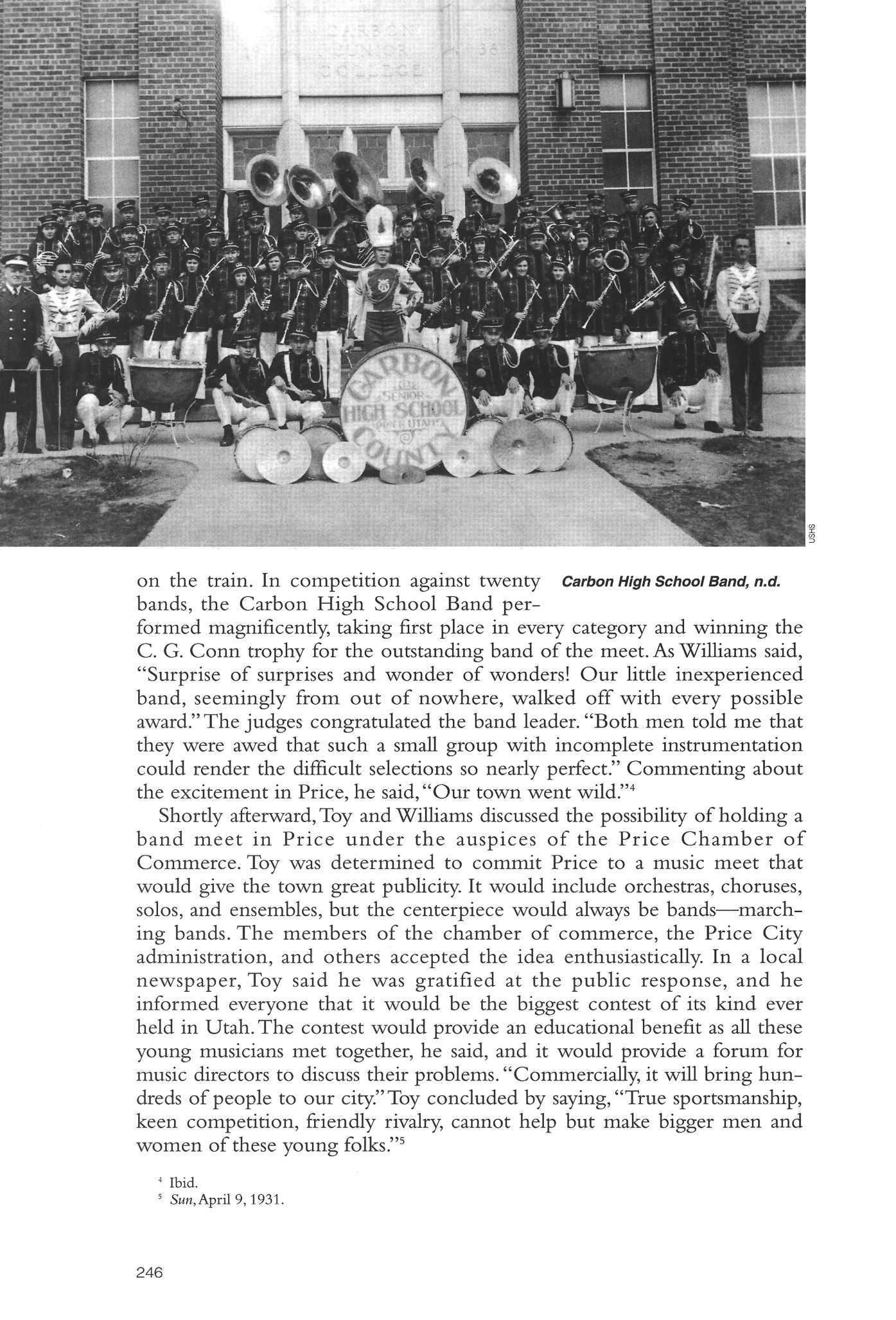
Ibid 5 SHw,April9,1931. 246
4
The meet that would accomplish all this had at its foundation a visionary band director E M Williams's primary purpose was to build great bands and inspire students to do their best.The growing success of the Carbon High School Band would electrify the entire county and create interest throughout the state It provided a unifying element for the county with its diverse population because the nationality of a student never concerned Williams, only talent.6 He -was a pioneer in the development of marching bands in Utah. Hy Summerhays, owner of a Salt Lake City music store, commented, "Please keep in mind that the big push for bands in Utah actually started in Price. Other communities had bands previously, but the actual competition at Price was the biggest thing of its time, and I don't believe that participation of any contest in Utah has exceeded the competition of the early 1930s held in Carbon County."7
Musical bands became part of the elementary and junior high school curriculum in Carbon County.The schools of Harding, Latuda,Wellington, Hiawatha, Spring Glen, Sunnyside, Helper, and Notre Dame became feeder schools for Williams's bands through the years.The high school band itself grew until it had close to 100 students For a while it had both A and B bands, with students playing almost every instrument imaginable Williams -was a perfectionist, and throughout his career in Carbon County he never
6 A few last names in the high school band of 1932 and 1933 are Bonacci, Garavaglia, Cook, Litizzette, Reese,Piute,Piacitelli,and Zubick See Carbon High School Annual, 1932,copy in possession of author
7 Derral Lewis Siggard, "School Bands in Utah:Their History and Development between 1928 and 1975,"unfinished Ph.D dissertation draft in possession of author
 Band marching on field of the Salt Lake High School (now West High) c. 1919. Note the construction of the state capitol in the distance.
Band marching on field of the Salt Lake High School (now West High) c. 1919. Note the construction of the state capitol in the distance.
247
UTAH HISTORICAL QUARTERLY
lost sight of his goal of producing excellent bands He always wanted to win, but foremost he wanted good relationships with other bands and other leaders Besides teaching music, he also taught his students good sportsmanship, loyalty,honesty, and a sympathetic feeling for others.8 After a few years of his directorship, the county talked about instrumental players the way we would compare players on athletic teams today
By early October 1930 Toy had selected a committee, and plans began taking shape for the first annual Price Intermountain Music Meet, which included both individual and group competition.9 The committee set up the same rules that the national meets used After some deliberation as to which schools should be invited, the committee sent invitations to all schools in Utah and western Colorado that had bands They invited some top music people to judge the various contests Bolime Makovsky, the musical authority at Oklahoma A & M at Stillwater, Oklahoma; Clarence J Hawkins of the University of Utah; and Leopold A Yost,band leader of the Thirty-eighth Infantry Band at Fort Douglas accepted invitations to adjudicate The Denver and Rio Grande Western Railroad joined in by discounting railroad tickets for the participating band and music participants Finally, eighteen bands—with a total of more than 1,000 students—came to Price inApril 1931
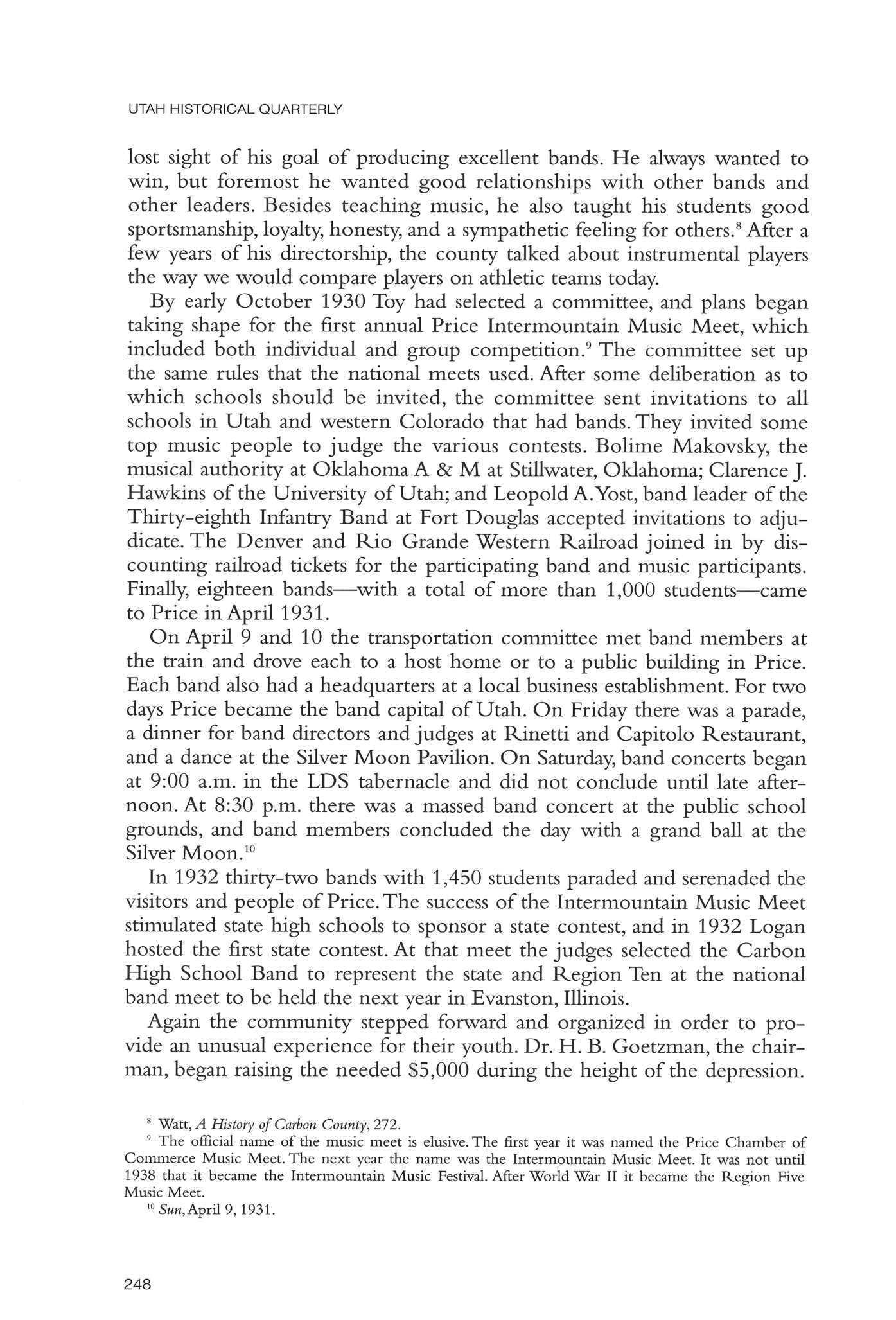
On April 9 and 10 the transportation committee met band members at the train and drove each to a host home or to a public building in Price. Each band also had a headquarters at alocal business establishment. For two days Price became the band capital of Utah. On Friday there was a parade, a dinner for band directors andjudges at Rinetti and Capitolo Restaurant, and a dance at the Silver Moon Pavilion. On Saturday,band concerts began at 9:00 a.m. in the LDS tabernacle and did not conclude until late afternoon. At 8:30 p.m. there was a massed band concert at the public school grounds, and band members concluded the day with a grand ball at the Silver Moon.10
In 1932 thirty-two bands with 1,450 students paraded and serenaded the visitors and people of Price.The success of the Intermountain Music Meet stimulated state high schools to sponsor a state contest, and in 1932 Logan hosted the first state contest. At that meet the judges selected the Carbon High School Band to represent the state and Region Ten at the national band meet to be held the next year in Evanston, Illinois.
Again the community stepped forward and organized in order to provide an unusual experience for their youth. Dr. H. B. Goetzman, the chairman, began raising the needed $5,000 during the height of the depression.
10 Stm,April9,1931
8 Watt, A History of Carbon County, 272
24 8
9 The official name of the music meet is elusive The first year it was named the Price Chamber of Commerce Music Meet The next year the name was the Intermountain Music Meet It was not until 1938 that it became the Intermountain Music Festival After World War II it became the Region Five Music Meet
Goetzman and his committee raised most of The Lincoln School Drum Corps, the funds in Carbon County, but he also ven- n a. tured to Salt Lake and obtained donations.
Governor Henry Blood even gave a personal check for $10. Emery County also contributed to Carbon County's successful band.11
Early in June 1933 the eighty-five-member band departed for Evanston—but Williams, who had been diagnosed as having phlebitis in both legs, sat in a wheelchair looking helplessly on while A. B. Caseman from Helper took his band.At the national band contest the band won first place in the first division in marching and in the second division for playing According to a Sun Advocate reporter, "The Carbon entry was acclaimed by the judge as the greatest marching unit ever to enter a national contest."Williams also commented that the judges had declared them "Number One in all the nation in marching maneuvers." Jessie Rasmussen Holdaway, a student musician in that band, in reminiscing about that event said, "Once -we donned our uniforms -we kept standing to prevent wrinkles.We began our march and concert in spotless unwrinkled uniforms....Our front to back lines, side to side lines and obliques were as perfect as possible. Our eyes and our feet moved, but we were otherwise at attention, heads up shoulders straight."12 When the band returned to Price,
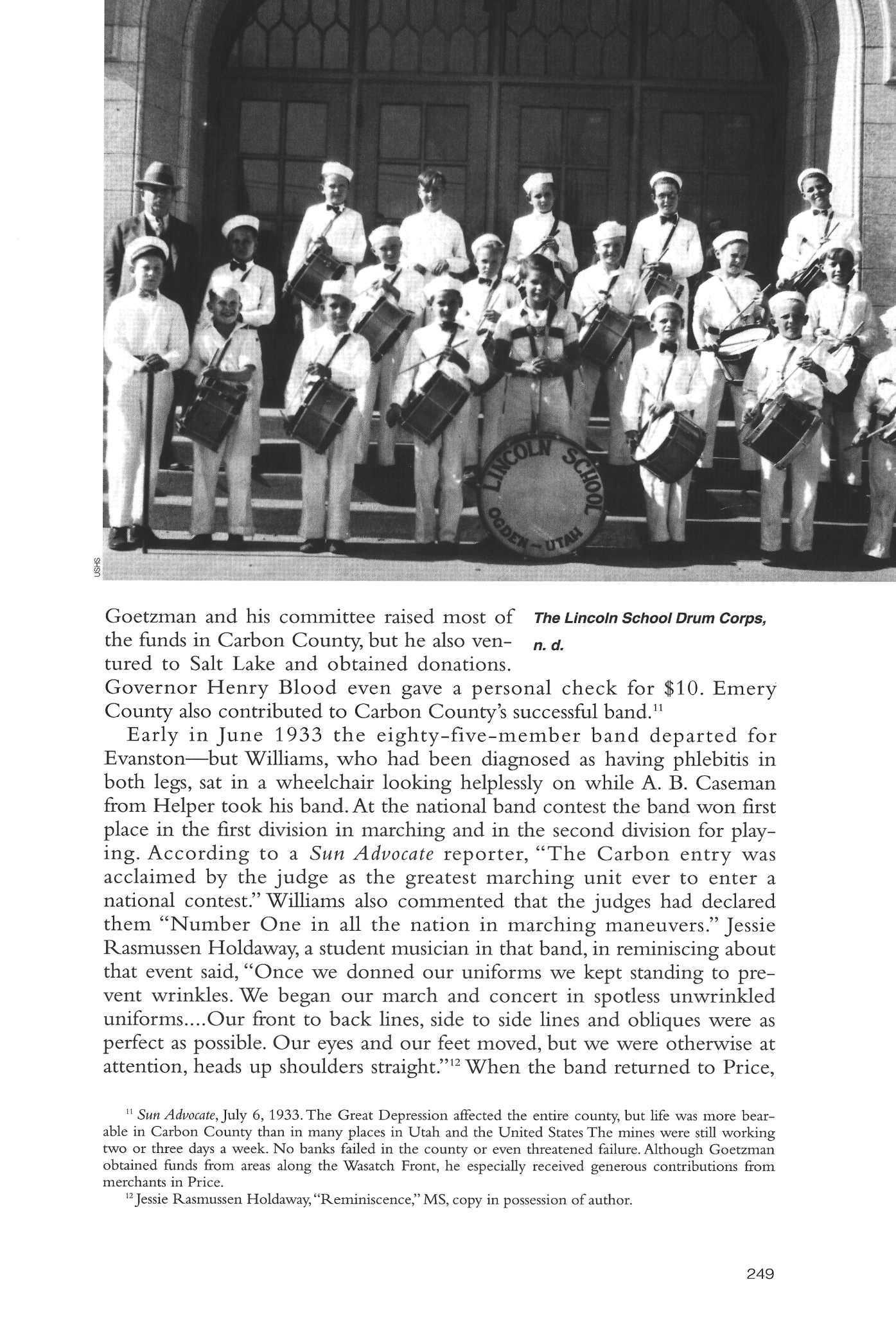
11 Sun Advocate, July 6, 1933 The Great Depression affected the entire county, but life was more bearable in Carbon County than in many places in Utah and the United StatesThe mines were still working two or three days a week No banks failed in the county or even threatened failure Although Goetzman obtained funds from areas along the Wasatch Front, he especially received generous contributions from merchants in Price.
12 Jessie Rasmussen Holdaway,"Reminiscence," MS,copy in possession of author
249
the crowd gave the student musicians a royal welcome, and later the chamber of commerce gave them a dance at the Silver Moon.13
National Institute of Music, Jr. Musicians of America, January 31, 1938. At least some of these young players would later compete as member of high school orchestras.
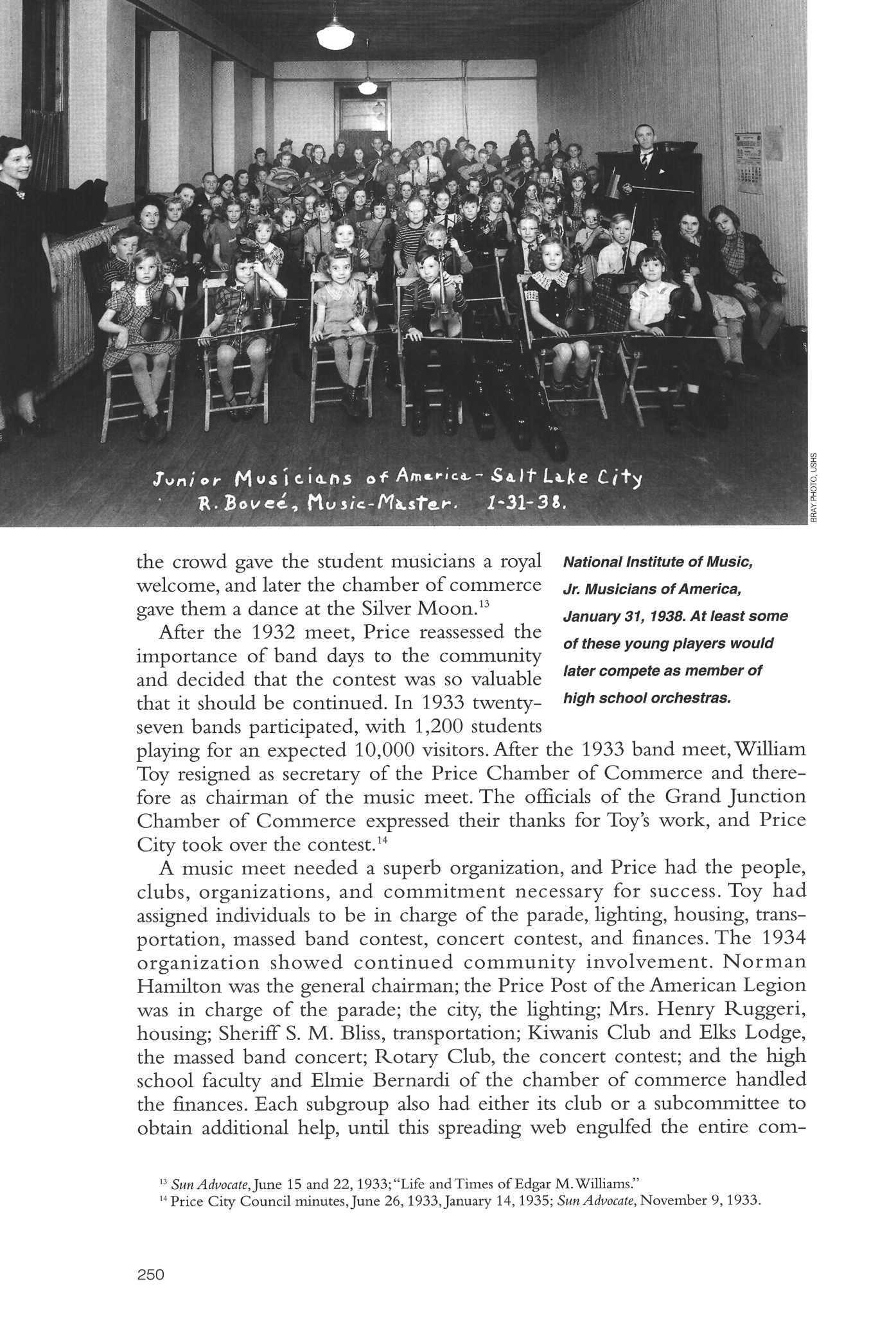
After the 1932 meet, Price reassessed the importance of band days to the community and decided that the contest was so valuable that it should be continued. In 1933 twentyseven bands participated, -with 1,200 students playing for an expected 10,000 visitors After the 1933 band meet,William Toy resigned as secretary of the Price Chamber of Commerce and therefore as chairman of the music meet. The officials of the Grand Junction Chamber of Commerce expressed their thanks for Toy's work, and Price City took over the contest.14
A music meet needed a superb organization, and Price had the people, clubs, organizations, and commitment necessary for success Toy had assigned individuals to be in charge of the parade, lighting, housing, transportation, massed band contest, concert contest, and finances. The 1934 organization showed continued community involvement. Norman Hamilton was the general chairman; the Price Post of theAmerican Legion was in charge of the parade; the city, the lighting; Mrs Henry Ruggeri, housing; Sheriff S. M. Bliss, transportation; Kiwanis Club and Elks Lodge, the massed band concert; Rotary Club, the concert contest; and the high school faculty and Elmie Bernardi of the chamber of commerce handled the finances. Each subgroup also had either its club or a subcommittee to obtain additional help, until this spreading web engulfed the entire com-
13 Sun Advocate, June 15 and 22, 1933;"Life andTimes ofEdgar M.Williams."
"Price City Council minutes,June 26, 1933,January 14, 1935; Sun Advocate, November 9, 1933.
250
munity.15
In 1934theintermountain band contest in m National, Utah, n.d. Price merged with the state andRegionTen music meets. Fifty-two bands and fifteen orchestras representing fifty-six schools from three states notified the music committee that they would participate in this gigantic three-day festival.The committees worked overtime because they estimated that approximately 4,000 student musicians would attend and the committee would need to furnish sleeping quarters for about half ofthem. Mrs. Henry Ruggeri andhercommittee scoured all of Price to find housing for the students. Standardville, Helper, and Wellington accepted some students, but most would be housed in Price Norman Hamilton, the committee chairman, finally telegrammed Secretary ofWar George Dern asking for permission to use 1,500 Fort Douglas army cots.TheArmy loaned 1,300, which committee members placed in every available vacant building and large hall they could find. Hamilton also estimated that thecommittee would need fifty "greeter cars" to take visiting students and directors wherever they wished, and he reckoned that 30,000 people would attend thethree-day event.16
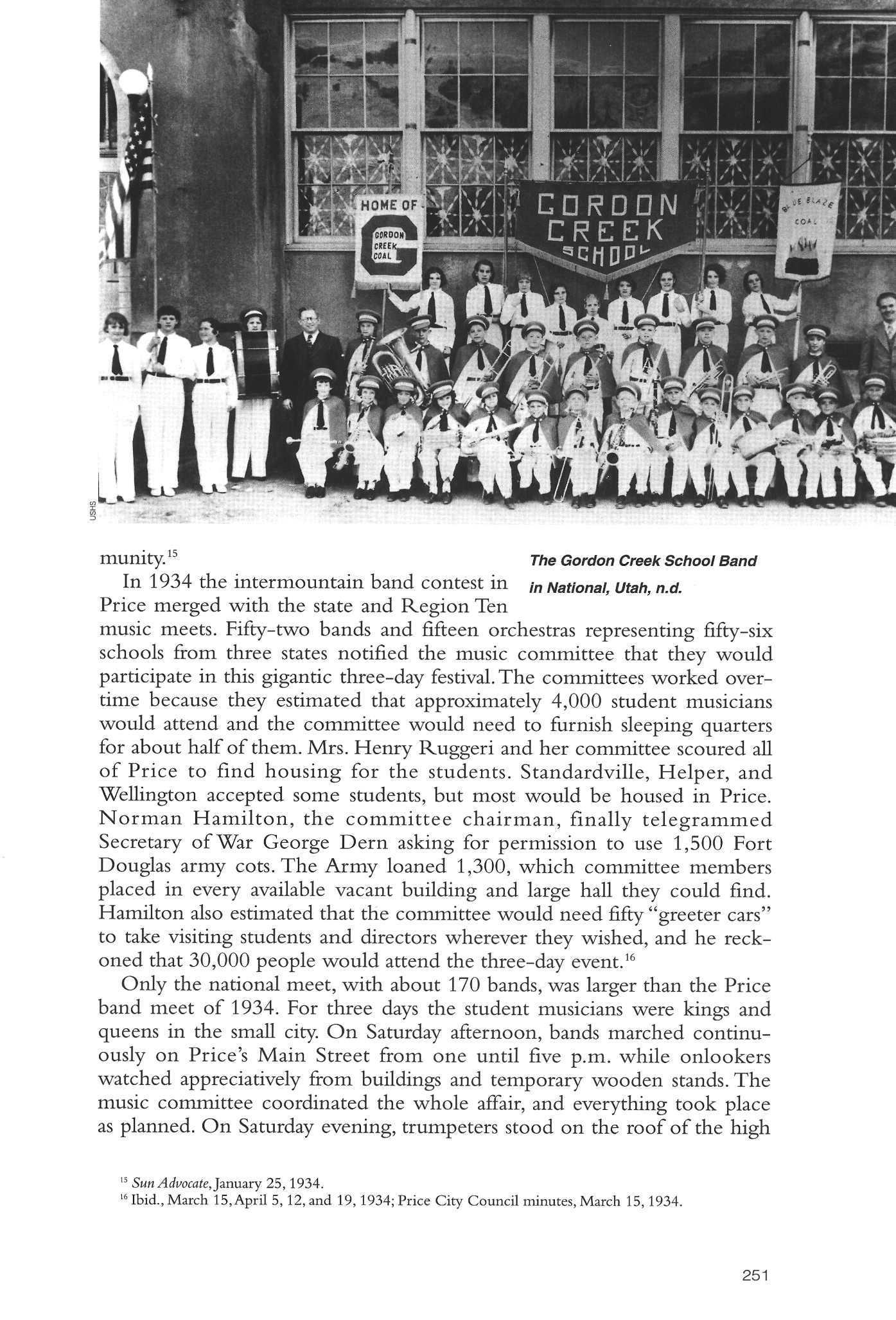
Only thenational meet, with about 170bands, was larger than the Price band meet of 1934 For three days the student musicians -were kings and queens in the small city On Saturday afternoon, bands marched continuously on Price's Main Street from one until five p.m.while onlookers watched appreciatively from buildings and temporary wooden stands.The music committee coordinated the whole affair, and everything took place as planned On Saturday evening, trumpeters stood on the roof ofthe high
Sun Advocate, January 25,1934.
Ibid.,March 15,April 5,12,and 19, 1934;Price City Council minutes,March 15, 1934.
The Gordon Creek School Band
251
school and on Round Hill,Wood Hill, and Granite High School Band, Kiwanis Field and opened the evening cere- November21,1934. mony with trumpet calls, followed by a Niagara Falls fireworks display over the high school letter "C" on Wood Hill "With the clear notes of a trumpet trio selection played from the top of the high school building still ringing in their ears,the vast throng heard a welcome address by Mayor B W Dalton who expressed Price City's pleasure at being the host city for an affair of such magnitude as the state and intermountain music contest." Governor Henry H Blood also spoke to the crowd.17
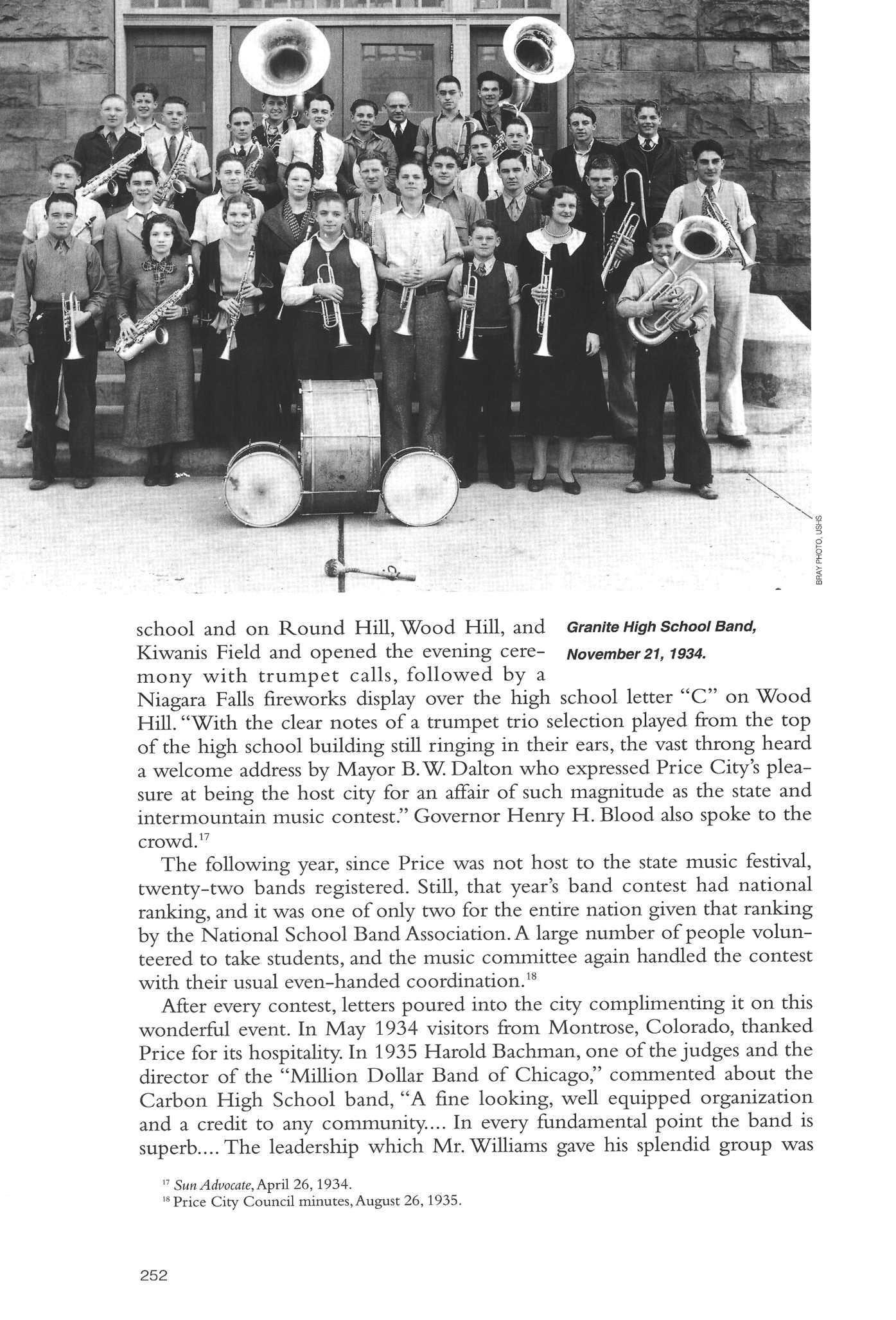
The following year, since Price was not host to the state music festival, twenty-two bands registered. Still, that year's band contest had national ranking, and it was one of only two for the entire nation given that ranking by the National School Band Association A large number of people volunteered to take students, and the music committee again handled the contest with their usual even-handed coordination.18
After every contest, letters poured into the city complimenting it on this wonderful event. In May 1934 visitors from Montrose, Colorado, thanked Price for its hospitality In 1935 Harold Bachman, one of thejudges and the director of the "Million Dollar Band of Chicago," commented about the Carbon High School band, "A fine looking, well equipped organization and a credit to any community.... In every fundamental point the band is superb... The leadership which Mr Williams gave his splendid group was
s s,
17 Sun Advocate, April 26, 1934
252
18 Price City Council minutes,August 26,1935
modest but effective."19
Ferrin Van Wagoner and the
In 1935 J. Bracken Lee's election as mayor Tabiona High School Band, threatened an end to the festival In January Julv24 1940 1936 the city council discussed whether or not to continue sponsoring the band contest and agreed to continue it for at least that year. In 1936 thirty-seven schools sent various groups, including solos, ensembles, and bands, to the meet Twenty-nine bands assembled for the parade and for the massed band concert at Kiwanis Field with Harold Bachman from Chicago directing them.At the end of the program Mayor Lee thanked the committee, and Bachman commented that Price was an outstanding music center in theWest and that a decision to discontinue the contest would be extremely unfortunate. Dr. H. B.Goetzman, the chairman, thanked alarge list of organizations for their help in the festival.20
The following year, 1937, the national regional music committee awarded Price the contest to be held from May 13 to 15 Each school in the contest would have to earn a superior or highly superior rating in district contests. Mrs.William Hakalo immediately began finding housing for student musicians, a task that was extremely difficult; afterward, the committee even considered constructing permanent barracksjust for the meet Thirtyseven bands and representatives from fifty schools—almost 2,500 students representing three states—came to Price for the three days in May.A total of 1,600 students needed housing. Nine judges participated, eight from
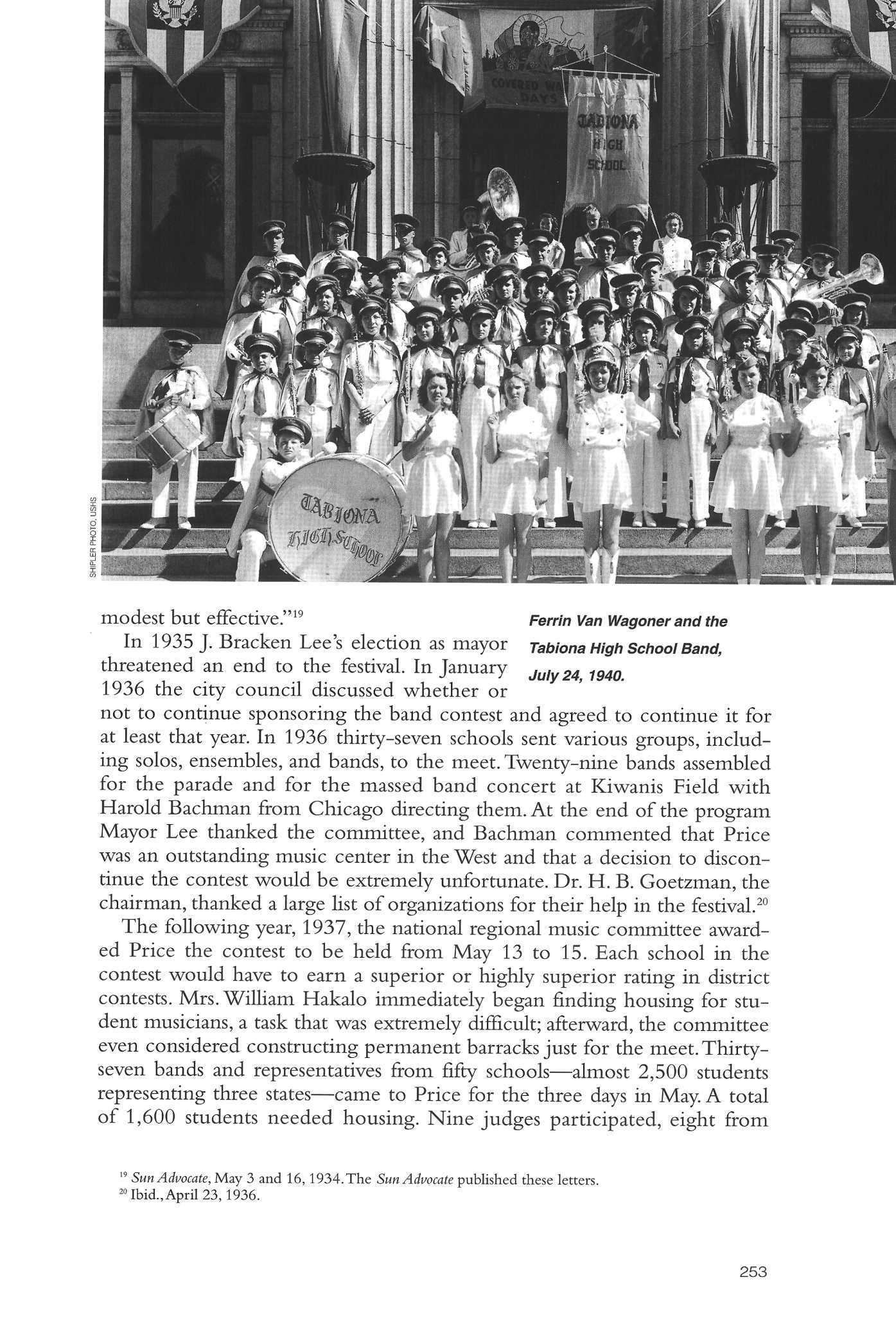
Sun Advocate, May 3 and 16, 1934.The Sun Advocate published these letters Ibid.,April 23,1936. 253
UTAH HISTORICAL QUARTERLY
Utah and Henry Fillmore from Cincinnati, Ohio.At the end of the contest Fillmore commented, "I have never seen anything of its kind to equal the festival you have staged here in Price. In my opinion, the Chicago district is the only one in the nation which rivals your community as a center of music for schools."Thomas Giles,ajudge from Salt Lake City, wrote,
After the dazzling brilliance of the great national contest held in Price, it is utterly impossible to let this occasion pass without a word to the superbly efficient committee in charge of the mammoth affair It has been my pleasure to judge national music contests during the past seven years in Los Angeles, Portland, Chicago, and Minneapolis, in addition to state contests in Iowa, Wisconsin, Montana, Idaho, and district contests embracing these latter states The Price contest, in its scope, in its efficiency and in its brilliance, surpasses any that I have mentioned.21
In early 1938 J. Bracken Lee and Price City dropped their official and financial support of the contest, but the withdrawal of Price City did not end band days.Under the leadership of Dr. H. B. Goetzman, the supporters organized a nonprofit corporation known as the Intermountain Music Festival, with Goetzman as president.22 In 1938 eighteen bands and representatives of thirty schools, about 1,000 students, converged on Price for another highly successful three-day meet. The local newspaper had a column entitled "DidYou See?"
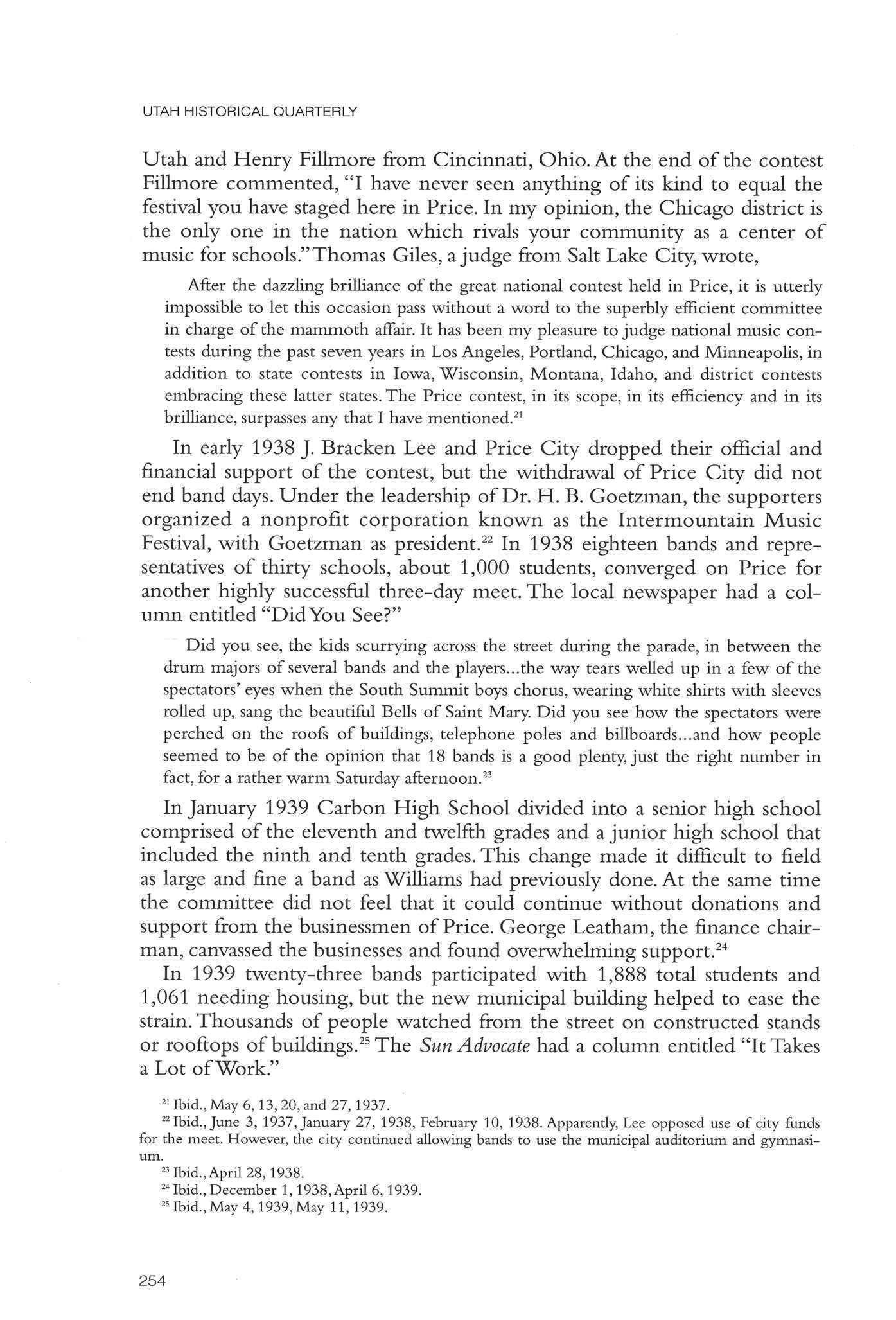
Did you see, the kids scurrying across the street during the parade, in between the drum majors of several bands and the players...the way tears welled up in a few of the spectators' eyes when the South Summit boys chorus, -wearing white shirts with sleeves rolled up, sang the beautiful Bells of Saint Mary. Did you see how the spectators were perched on the roofs of buildings, telephone poles and billboards...and how people seemed to be of the opinion that 18 bands is a good plenty, just the right number in fact, for a rather warm Saturday afternoon.23
In January 1939 Carbon High School divided into a senior high school comprised of the eleventh and twelfth grades and ajunior high school that included the ninth and tenth grades This change made it difficult to field as large and fine a band asWilliams had previously done.At the same time the committee did not feel that it could continue without donations and support from the businessmen of Price. George Leatham, the finance chairman, canvassed the businesses and found overwhelming support.24
In 1939 twenty-three bands participated with 1,888 total students and 1,061 needing housing, but the new municipal building helped to ease the strain Thousands of people watched from the street on constructed stands or rooftops of buildings.25 The Sun Advocate had a column entitled "It Takes a Lot of Work."
21 Ibid.,May 6,13,20, and 27,1937
22 Ibid.,June 3, 1937,January 27, 1938, February 10, 1938.Apparently, Lee opposed use of city funds for the meet However, the city continued allowing bands to use the municipal auditorium and gymnasium
23 Ibid.,April 28,1938
24 Ibid.,December 1, 1938,April 6, 1939
25 Ibid., May 4, 1939,May 11,1939
25 4
It takes a lot of work to make a music festival For the eighteen hundred students wh o participated in the ninth annual Intermountai n Music Festival at Price last Thursday, Friday and Saturday, it meant long, arduous hours of preparation... For members of the festival committee and the scores of people wh o assisted in arranging and carrying out festival details and for the many others -who helped to solve the financial and housing problems, it meant the expending of much time and money and effort. As a result eighteen hundred students received valuable experience, culturally and socially... Hundreds of people received the personal satisfaction of knowing that they helped to make all this possible And eighteen hundred student musicians won't forget.26
In 1940 the music committee decided to stage a smaller state regional band contest and invite only the eastern Utah schools, and seven schools, totaling over 700 students, sent their musical groups.The next year, 1941, sixteen bands arrived in Price.The newspaper commented, "The hallo-wed echoes of bands that have gone before will be replaced by the actualities of today as the students of these bands will endeavor to fit themselves in to the highly competitive places left vacant by the school musicians who have left their names engraved upon the music rolls of the Price City contest."27
Shortly after the 1941 contest, the National Divisional Band Association slated Price as the site of the national music contest for the southern half of the region. But that day never came;World War II interrupted the plans, and early in February 1942 the national committee canceled all national contests.After that, band days -were never the same.Price continued to hold its own county meet with twelve bands from the county attending that year. In 1943 eight bands participated and in 1944 only six. In 1945 the committee canceled the meet altogether. In 1946 the music meets resumed again -with E.M.Williams as chairman of the committee.That year, twentyfive schools with seventeen bands participated. Besides Carbon County bands, Grand, Uintah, Duchesne, and Emery counties sent bands, as did Grand Junction and a few other Colorado communities. In 1947 Grand Junction schools and Price decided to participate in each other's meet every other year, and so the Colorado schools did not come that year. The biennial agreement never took place, and the connection -with Grand Junction ended. In 1947 sixteen bands from all over eastern Utah came, bringing approximately 1,000 student musicians.28 In November of that year G. J. Reeves, the superintendent of the Carbon County School District and a great supporter of the music meet, died at the age of fiftynine.The school board replaced him -with Mont Harmon, a Brigham City native.Thereafter, Harmon became the chairman of the music meets.
In 1947 the magazine First Chair of America honored E M Williams and the Carbon High School band, calling it "One of the really great bands of Ibid.,
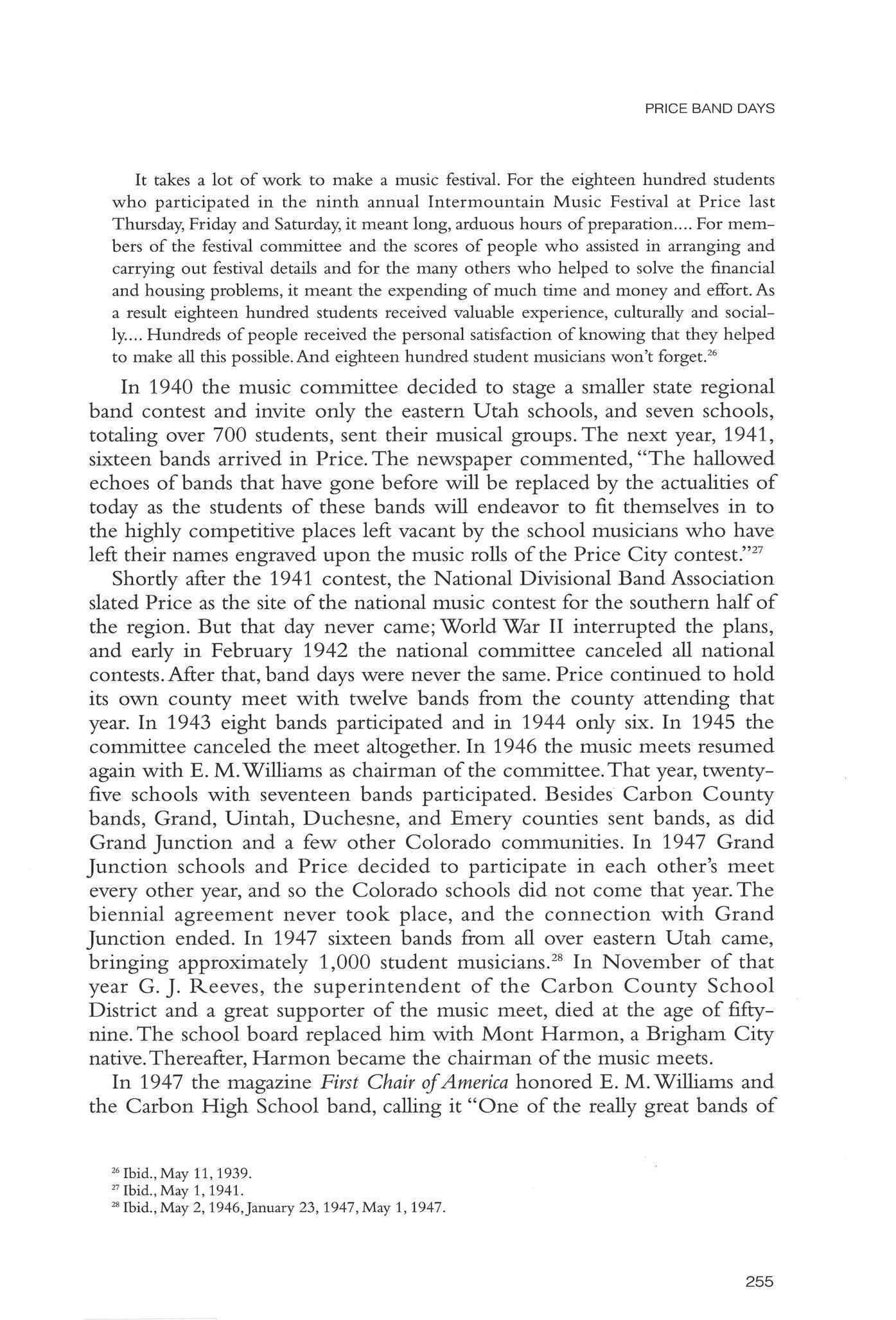
PRICE BAND DAYS
May 1,1941
Ibid.,May 2, 1946,January
255
May 11,1939 Ibid.,
;
23, 1947,May 1, 1947
America."29 Price had a music meet in 1948, Notre Dame de Lourdes school and in 1949 Region Five, which was com- band marching on a Price street. posed of all the bands in eastern Utah, held The drum major is Jack Kelley. its music contest in Price. In 1950 the committee, under Mont Harmon, announced there would be a band festival, but it only held a county junior high marching band meet. In 1951 the Region Five bands returned to Price,and the school district purchased several hundred cots for the students who invaded the town. Because the routine had become every other year, the bands went elsewhere for the music meet in 1952,and in 1953 they returned to Price.Again the town did itself proud with great bands competing in concerts and marching on the streets, not realizing that this year would be the last band meet.
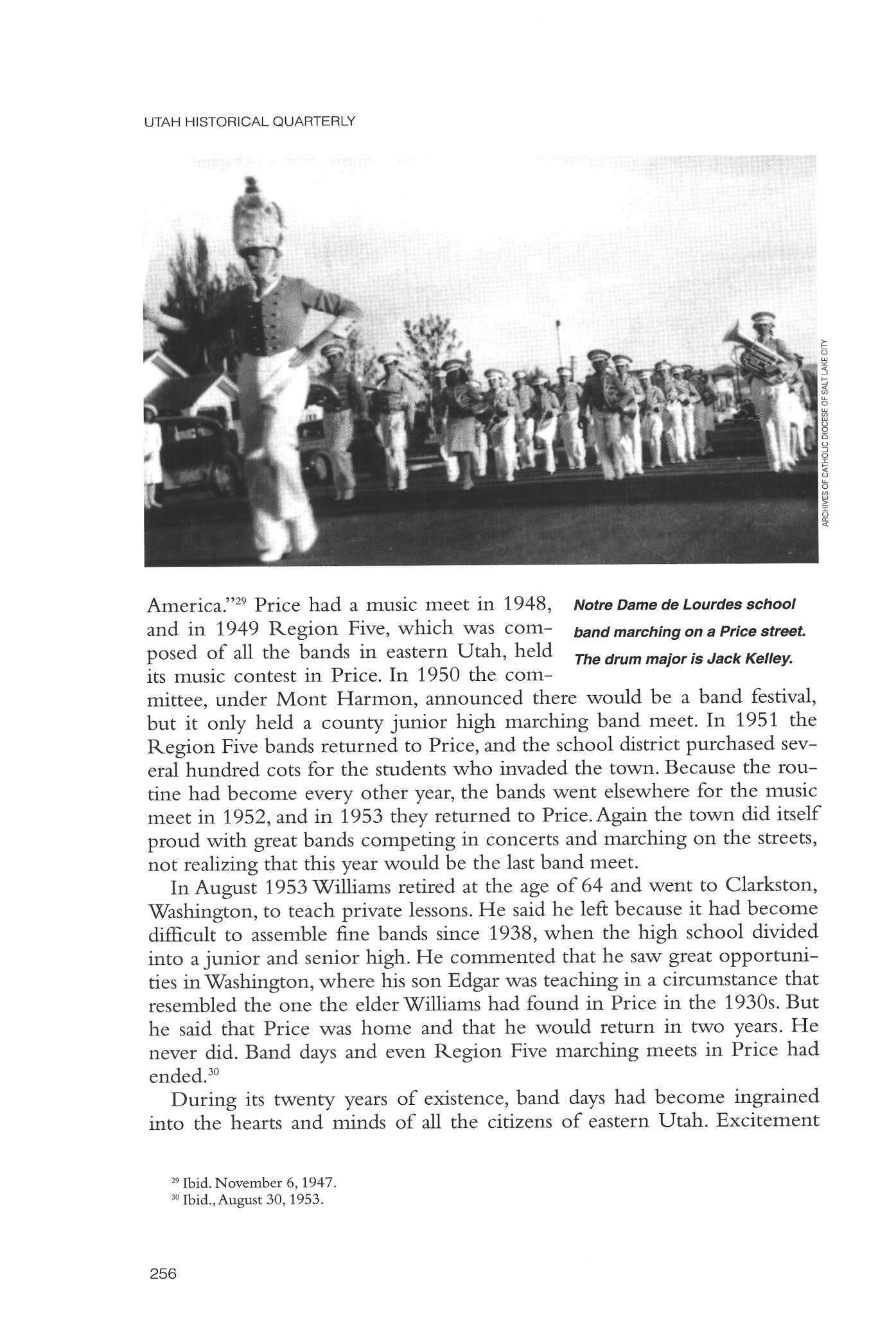
In August 1953Williams retired at the age of 64 and went to Clarkston, Washington, to teach private lessons He said he left because it had become difficult to assemble fine bands since 1938, when the high school divided into ajunior and senior high. He commented that he saw great opportunities inWashington, where his son Edgar was teaching in a circumstance that resembled the one the elderWilliams had found in Price in the 1930s But he said that Price was home and that he would return in two years. He never did. Band days and even Region Five marching meets in Price had ended.30
During its twenty years of existence, band days had become ingrained into the hearts and minds of all the citizens of eastern Utah. Excitement
UTAH HISTORICAL QUARTERLY
29 Ibid November 6,1947 30 Ibid.,August 30,1953 256
reigned in the city for the festival and everyone participated. Who could help but admire the instrumental groups, choruses, and orchestras that performed in the LDS tabernacle, the Methodist church, and the new municipal hall? But for spectators, the pinnacle of the music meet was the marching bands that did complicated maneuvers on the street, playing music while striding in perfect formation down the streets. To the people of Carbon County, their own high school band represented the ultimate. Everybody stayed to the end to watch the very last band, Carbon High School, a magnificent instrumental marching group, perform. The greatness of the band was equaled by a superbly organized committee that knew how to efficiently run the meet and by a director who was devoted to the art of teaching and inspiring his students to great heights.

PRICE BAND DAYS
257
Pins, Patterns, and J.C. Penney: An Ogden Cottage Industry Goes Global
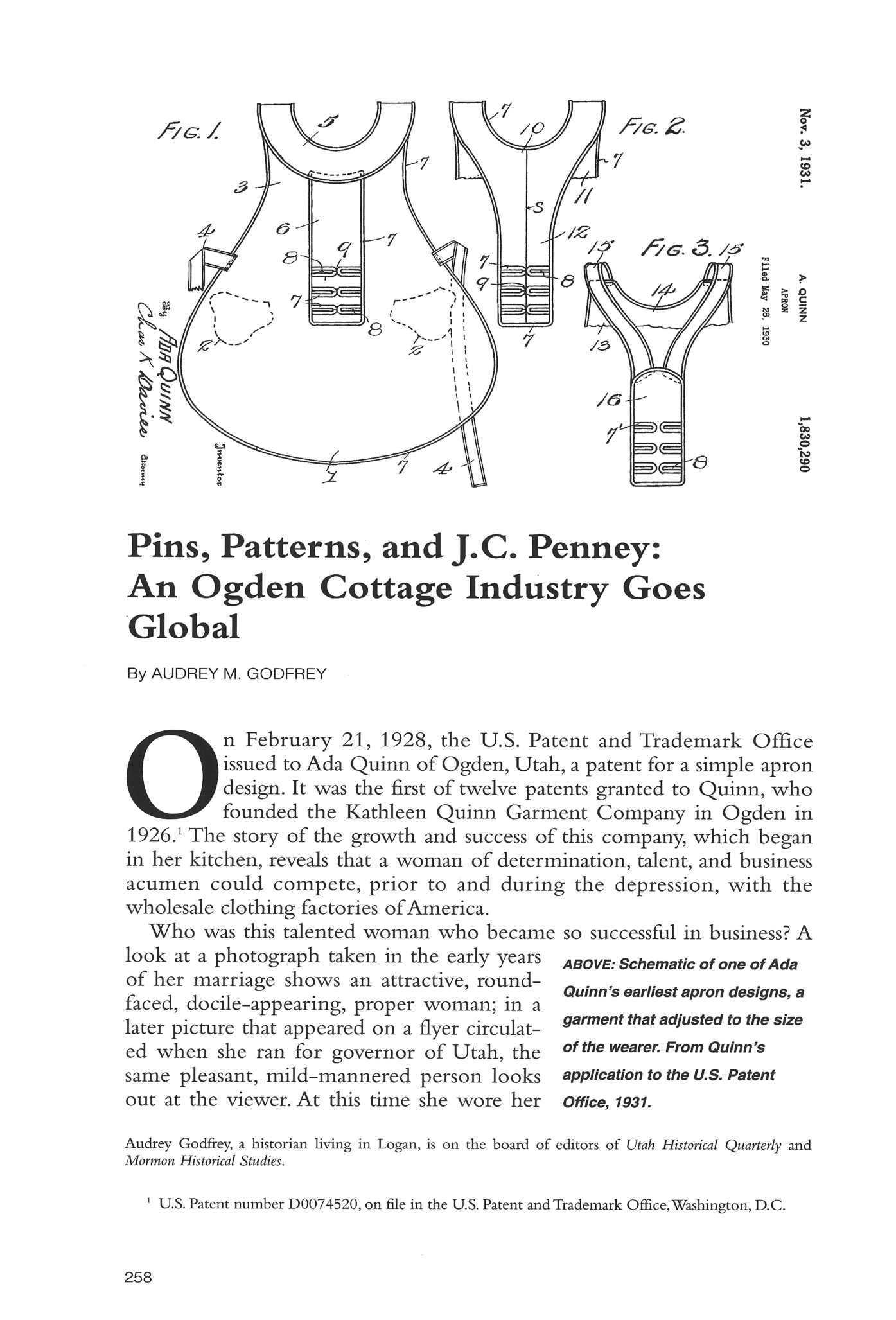 By AUDREY M GODFREY
By AUDREY M GODFREY
On February 21, 1928, the U.S. Patent and Trademark Office issued toAda Quinn of Ogden, Utah, apatent for a simple apron design. It -was the first of twelve patents granted to Quinn, who founded the Kathleen Quinn Garment Company in Ogden in 1926.1 The story of the growth and success of this company, which began in her kitchen, reveals that a woman of determination, talent, and business acumen could compete, prior to and during the depression, with the wholesale clothing factories of America.
Who -was this talented woman -who became so successful in business? A look at a photograph taken in the early years of her marriage shows an attractive, roundfaced, docile-appearing, proper woman; in a later picture that appeared on a flyer circulated when she ran for governor of Utah, the same pleasant, mild-mannered person looks out at the viewer. At this time she wore her
ABOVE: Schematic of one of Ada Quinn's earliest apron designs, a garment that adjusted to the size of the wearer. From Qu inn's application to the U.S. Patent Office, 1931.
' U.S.Patent number D0074520, on file in the U.S.Patent andTrademark Office,Washington, D.C.
/VG./. f/G.Z. /VG. 3. /&
Audrey Godfrey, a historian living in Logan, is on the board of editors of Utah Historical Quarterly and Mormon Historical Studies.
258
PINS, PATTERNS, AND J.C PENNEY
long gray hair in abun on the back of her head.But her looks -were deceptive. Her long, modest dresses and her serviceable shoes did not reflect the bright apparel she produced And her daughter-in-law, Ethel Low, said that Quinn "blew her top" frequently. She was determined, ambitious, and blunt, and she expressed herself freely and emphatically.A nephew, Richard Shaw, remembered Quinn and her three sisters, Gwendolyn, Ivy, and Mabel,asindependent women -who were feminists.2
Ada Quinn, who was born December 13, 1878,joked that life for her began at age forty-six.3 Yet she was proud of the years and heritage that preceded her venture into manufacturing She was born in Peterson, Utah, to early Mormon pioneers Joshua and Hannah Martha Green Williams. Quinn graduated from public schools and completed credentials for teaching at the University of Utah. She taught school in Morgan and Ogden City,where she met her husband, who was also a teacher They married in 1902 and produced four children: Horace Alvord, born in 1903; Kathleen in 1905; and twins Robert and Ralph in 1914. Ralph died shortly after birth, and several miscarriages had occurred between the births of Kathleen and the twins
Ada's husband, Edward Nelson Quinn, had graduated from Grinnell College in Iowa. After their marriage, the couple moved to Washington, DO, for several years When they moved back to Utah, Edward worked for the government, proofing homesteads in six western states Although Edward and Ada did not share the same religious faith—he was Catholic and she Mormon—the couple -was compatible in other ways. Ed-ward was the sounding board for Ada's business ideas;he provided her with excellent advice and supported her in all aspects ofher life.4
In 1926, established in Ogden and with her children needing less constant care, Quinn decided to begin a business in her home. She claimed that she started with "five dollars, an idea, one family sewing machine and her will to work."5 Although Utah and the nation had just been through a short depression in the early 1920s and some businesses were still trying to recoup, Quinn chose the right product for the times for her cottage industry Aprons were almost indispensable to the American housewife "Clothing represented a sizable investment of disposable income, so it was important to protect it from unnecessary wear or hazard."6 The humble
2 Ethel Larsen Quinn Low, interview with author, March 4, 1999, Providence, Utah, and telephone interview,July 12, 1999 Richard and Marian Shaw, interview with author, Logan, Utah, July 2, 1999 Gwendolyn became a librarian Ivy, whom Shaw called a"firecracker," was a writer and poet, and Mabel also founded a garment factory, in Lodi,California; later,she became superintendent of schools in Lodi. There were three brothers also Arthur worked for the railroad Frank died at birth, and Roland established a fireworks factory in Idaho Falls.In 1933 an explosion killed him, a daughter, and a niece.
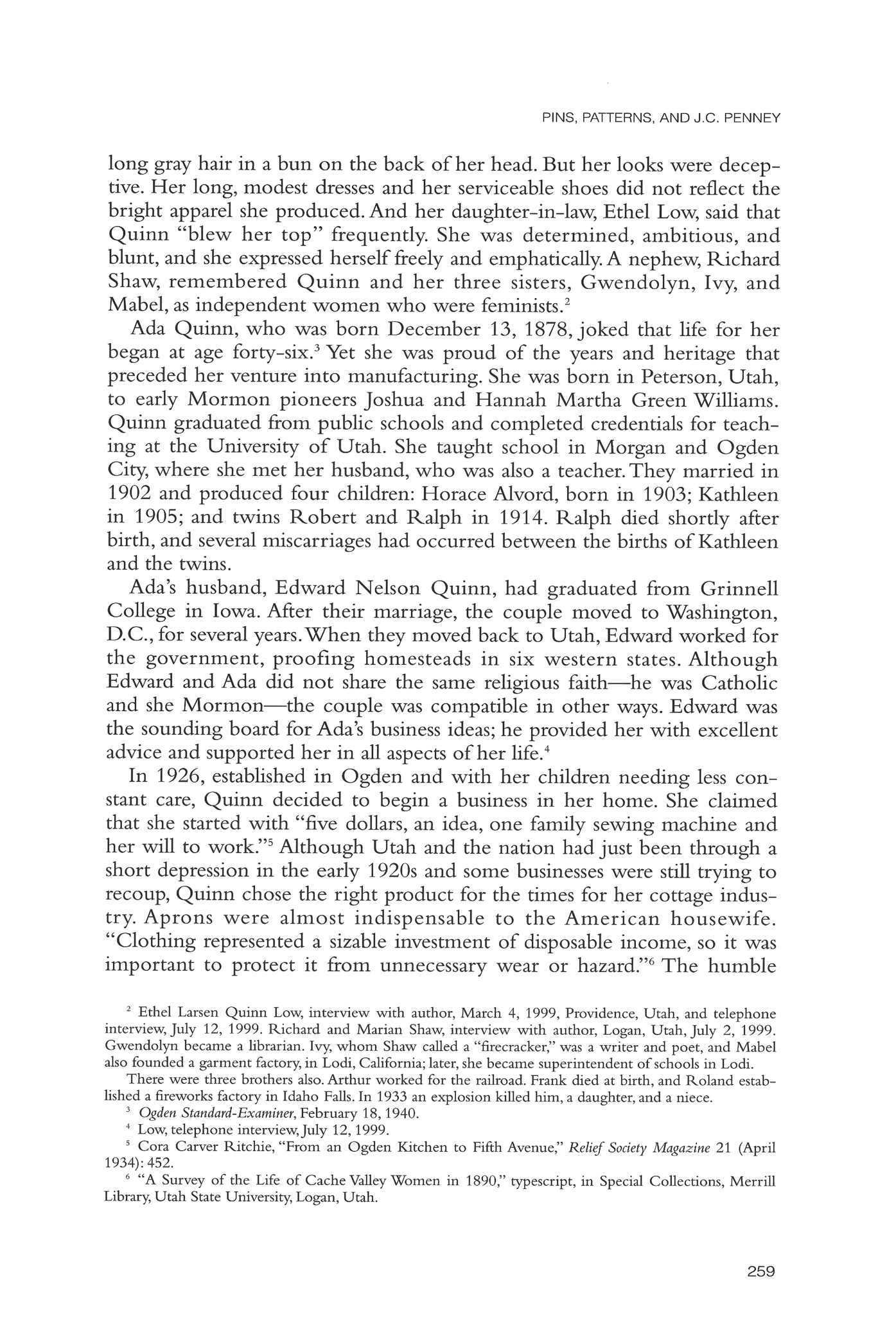
3 Ogden Standard-Examiner, February 18,1940
4 Low,telephone interview,July 12, 1999
5 Cora Carver Ritchie, "From an Ogden Kitchen to Fifth Avenue," Relief Society Magazine 21 (April 1934):452
1 "A Survey of the Life of Cache Valley Women in 1890," typescript, in Special Collections, Merrill Library,Utah State University, Logan, Utah
259
UTAH HISTORICAL QUARTERLY
apron allowed a woman to go about her work with alayer of material protecting the larger dress investment Aprons also required only a small outlay of capital for material and could be sewn up quickly, allowing for greater output in production.Although women, especially rural women, had traditionally made their own clothing, the idea of purchasing garments readymade was gaining popularity in the 1920s
Quinn used her five dollars to purchase a few yards of gingham and some thread. She made four different lots of aprons before she sold any. Particular even from the first, she picked apart much of her sewing several times before becoming satisfied with the result. She then sent her young son to downtown Ogden to a large store with the aprons and was thrilled when the manager agreed to buy them and ordered eleven dozen more. But it took alot of convincing to get other retailers interested in selling her apparel. On her first marketing trip to stores in Salt Lake City, she recalled, she walked back and forth in front of the Broadway Company, one of the largest women's apparel stores in the city, without entering, because she dreaded facing the executives who would examine her wares. Finally, she forced herself to go in—and was promptly turned down. Later on, however, this store became one of her best customers.7 In the first six months, using nothing but the family sewing machine, Quinn sold $5,000 worth of goods. She gave much of the credit for her success to Gus Wright of Ogden, -who encouraged her and purchased the first lot of aprons.
During the depression years of the 1930s an eager workforce enabled Quinn to expand as her orders increased. She carefully chose her employees and became especially close to them She showed an inclination toward helping women in need by hiring widows at a time when work for them -was difficult to find. Concerned for their welfare, she also hired unwed mothers and helped them get a start toward self-sufficiency. In fact, she wanted to "put into effect the theory that real social -welfare work comes through helping others to help themselves."8 In turn, her workers remained loyal and hardworking as her business grew.By 1934 several of the women who had sewed for her at the beginning of her venture still remained with her.They had become expert seamstresses.
Realizing that more expertise would help her succeed, Quinn learned the art of buying materials. She rightly judged that bright, easy-to-care-for calicos, with a little trim to dress them up, -would become good sellers. "I always loved color," she said, and she gave much thought to the right color effect.9 She also found that keeping her credit good allowed her to buy material from jobbers in large quantities, which saved her money. She bought her wares in eastern markets because local companies could not handle her large orders or provide the variety of patterns and colors she
7 Ogden Standard Examiner, February 18, 1940
8 Low interview,March 4, 1999;Ritchie,"From an Ogden Kitchen," 452
9 Ritchie,"From an Ogden Kitchen,"453.

260
needed. Her prompt payment for these orders kept her credit so impeccable that salesmen began coming to her to display their samples.10
Ada Williams yuin n
A Job Maker For Governor
Quinn cut down her overhead and supplied family members -with jobs and income by using relatives in various capacities in the business. She and Edward worked together on obtaining patents for her patterns and establishing business policies, and she often sought his advice in matters relating to the business. She employed her daughter, Kathleen, after whom the company was named, to design dresses and aprons, sell the apparel, manage the office, and help train employees When the family decided to open a sales office in New York City, Kathleen managed it, earning a salary and a commission on her sales.11 Quinn's sons, Robert and Quinn's campaign brochure when Horace, also helped in the business As boys she ran for governor in 1940. they worked for small wages doing janitorial work and making deliveries. Later, they worked in other capacities as their careers permitted; Robert became a partner when the business was incorporated.

Quinn sent her sister Gwendolyn Shaw, with large suitcases of apron samples, to Washington, DC, and New York City on a two-week selling trip.12 Shaw also tried her hand at design. Her son David worked as a bookkeeper and kept track of the piecework of Quinn's employees, as did Ethel
10 Ibid., 452
11
Here,
12 Quinn paid Shaw's wages
PINS, PATTERNS, AND J.C PENNEY
The New York office was a large sample room located in the Herald Square Building at 1350 Broadway
retailers could view displays of each of Quinn's designs and place their orders
261
and expenses for the trip,so this may have been an effort by Quinn to help her sister's family financially during the depression Shaw worked as a librarian during the school year but had no income during the summer, and Mr Shaw's wages were low,reflecting the economic conditions of the time.
Low for a time. The payment of $99.60 by Avard Fairbanks working on a another sister (Mabel Barron) is listed as an bust of J. C. Penney in New York asset in the company incorporation papers. It Cjt is unclear what this payment -was for, but it shows some kind of involvement with the company. 13
As Quinn's success increased, some of the larger manufacturing companies tried to force her out of business. An early competitor was John Scowcroft & Sons Company, -which was founded in Ogden in 1880 as a bakery and candy store but had diversified into manufacturing and wholesaling other items,including clothing.These companies put pressure on her to such a degree that her friends advised her to sell out. However, realizing that her competitors "were trying to copy and put [her] out" and "were only men in a woman's game," she instead expanded the business and sought a larger market. Her philosophy that brains were better than money and that one should "keep plugging" along saw her through these early attempts to scare her out of the industry.14
Indeed, Quinn's business prospered LocalJ C Penney stores bought her aprons,as did Penney's first store inWyoming. On a trip to the East she met Mr. Penney, and he subsequently chose the Kathleen Quinn Company as his exclusive supplier of aprons Quinn often had lunch with him on business trips to NewYork City She met Penney's managers all over the country as she checked on orders to see if they had arrived on time and if they

13 Shaw interview,July 2, 1999; "Articles of Incorporation of Kathleen Quinn Garment Company," September 9, 1940,Utah State Archives
14 Ritchie, 452; Ogden Standard Examiner, February 18, 1940
UTAH HISTORICAL QUARTERLY
262
PINS, PATTERNS, AN D J.C PENNEY
-were satisfactory to the company The excellent craftsmanship of her needle-workers and Quinn's attention to details such as careful pressing, packing, and delivery of orders impressed Mr Penney and others who ordered from her.15
Early on, she diversified and began producing children's clothing and women's dresses in addition to her aprons. 16 J C Penney also sold these items One of the popular items Penney purchased from Quinn was called the Hoover dress In 1937 she had received a patent for a wraparound garment that could be used as an apron over a dress or as a dress itself In 1945 she patented a similar garment that she named the Hoover dress The patent shows a wraparound dress that could easily be put on or taken off and that could also be worn as a"slip-over garment to protect underneath dresses."17 When asked why her dresses were so popular, Quinn answered,"I believe that first of all it is the fine quality and exquisite workmanship
Some of my women are real experts, then too, color combinations are absolutely essential."18
One of Quinn's first apron designs—and a creative coup—had resulted from the small space she had to work in With little room for cutting tables, she sought to create a pattern she could cut on her limited table space She thus designed an apron that did not need to be cut into different sizes but that would fit any woman Quinn recognized that even in such a utilitarian garment as an apron, fit was important Her apron featured a back panel that "dropped from the shoulders a sufficient length to permit adjustment of the apron to -wearers of various sizes."A "plurality of string holes" at the lower end of the panel also allowed for physical differences in the bodies of various wearers. 19 This design became a mainstay of her business and was copied by home sewers
But she had many other apron designs Some had high -waists, -while some were half aprons Some had V-neck or half-moon-shaped yokes Along with the bright-colored prints, she used contrasting bias tape trim, lace, eyelet, appliqued designs, buttons, laced bibs, pockets, ruffles, scallops, and different -ways of securing the tie strings She -wasnot content to design aprons merely for serviceable purposes; she also made them feminine and pretty Perhaps she remembered her own days as a busy homemaker when a little beauty -would have made tasks easier to bear
Quinn protected her designs by going through a sometimes several-yearlong process of having them patented with the United States Patent
15 Low interview, March 4, 1999
16 The 1931 Polk Directory for Ogden says that the company produced "Ladies, Girls and Childrens House Dresses,Aprons, Smocks."
17 U.S Patent numbers 2,091,084 and 2,373,415, on file in the U.S Patent and Trademark Office, Washington, D.C. I recall my mother and other women in my community, North Ogden, wearing such dresses made of cheerful cotton prints in the 1940s
18 Ritchie,"From an Ogden Kitchen," 453
19 Explanatory notes accompanying Quinn's application for a patent on May 28, 1930 It was assigned patent number 1,830,290 by the United States Patent andTrademark Office
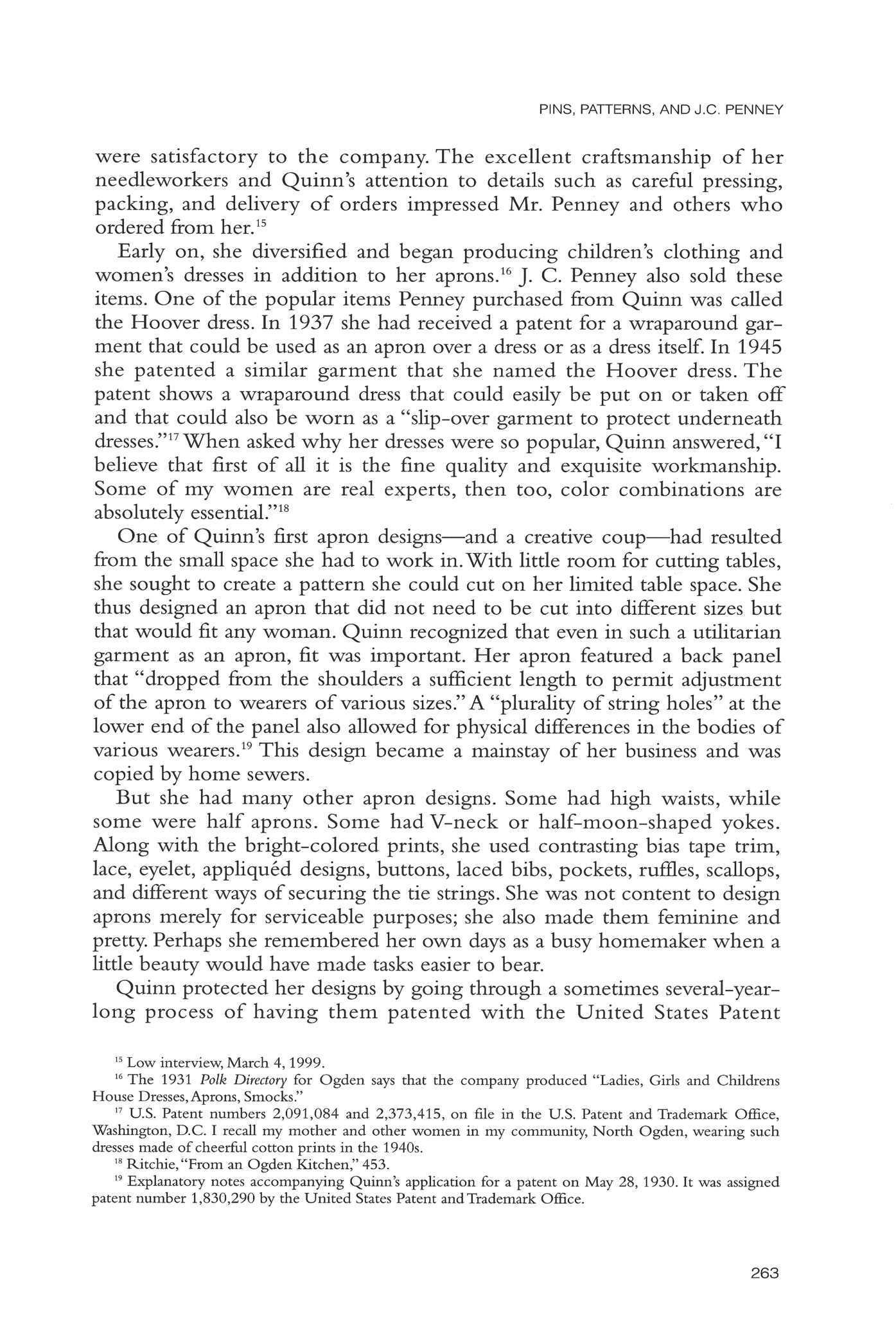
26 3
Office.20 It took a great deal oftalent to Schematic for the Hoover dress, compute measurements and transfer them to which couldbe worn eitheras a paper visually and then describe them clearly. dres s oran apmn fmm Qujnn,s Quinn had taken a design class in college, ^ , , . -ii - IT - i j 1945patentapplication. and this, along with herinnate abilities, led to her success indrafting patterns.21 Alookat her first two patents shows that she learned description skills from the submission process itself These first applications only briefly describe the aprons she wished topatent However, the third application ismuch more detailed, showing her acquired understanding ofthe need tobespecific in each detail
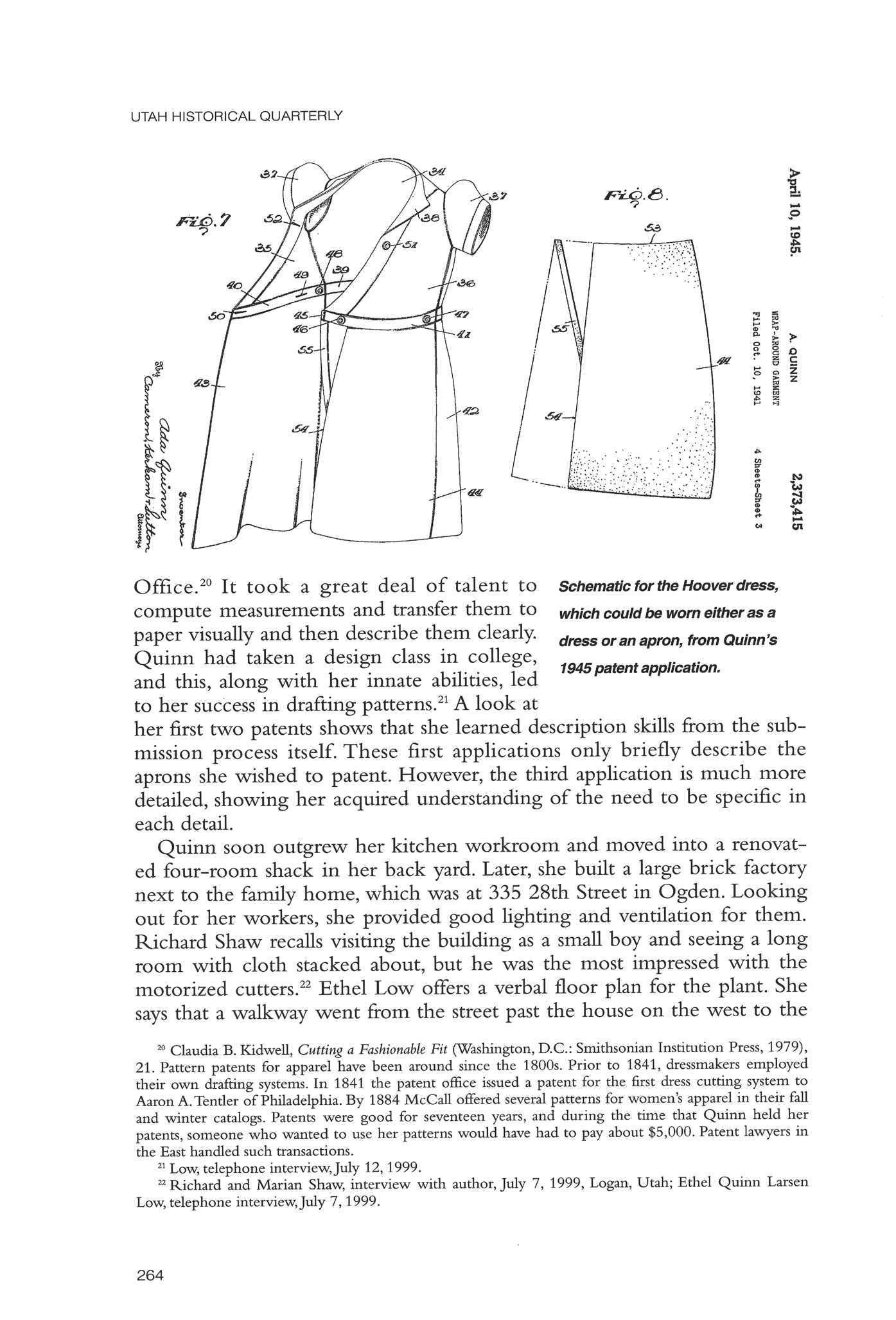
Quinn soon outgrew her kitchen workroom and moved into a renovated four-room shack inher back yard. Later, she built alarge brick factory next tothe family home, which was at335 28th Street inOgden. Looking out forher workers, she provided good lighting and ventilation forthem Richard Shaw recalls visiting the building as asmall boy and seeing a long room with cloth stacked about, but hewas themost impressed with the motorized cutters.22 Ethel Low offers averbal floor plan forthe plant. She says that awalkway went from the street past the house onthe west to the
20 Claudia B Kidwell, Cutting a Fashionable Fit (Washington, D.C.: Smithsonian Institution Press, 1979), 21 Pattern patents forapparel have been around since the1800s Prior to 1841,dressmakers employed their own drafting systems In 1841 the patent office issued apatent forthe first dress cutting system to Aaron A Tender of Philadelphia By 1884 McCall offered several patterns for women's apparel intheir fall and winter catalogs Patents were good forseventeen years, and during thetime that Quinn heldher patents, someone who wanted touse her patterns would have had to pay about $5,000 Patent lawyersin the East handled such transactions.
21 Low,telephone interview,July 12, 1999.
22 Richard and Marian Shaw, interview with author,July 7,1999, Logan, Utah; Ethel Quinn Larsen Low,telephone interview,July 7,1999.
UTAH HISTORICAL QUARTERLY I a > > s. a o
264
PINS, PATTERNS, AND J.C PENNEY
factory.The east half of the large room had offices in the front and sewing machines "all the way down." Across the back on the south side -were restrooms, and up the center were huge shelves of material and supplies On the -west side in the back was the cutting room There, on large tables, lay layers of fabric two inches thick -with patterns on top,-waiting to be cut by the huge machine remembered by Shaw. In the front on the -west side -wasthe shipping area. 23
In 1940 Quinn moved all the sewing machines to a second factory in the upper story of a building on the northwest corner of 23rd Street and Washington Boulevard This location also provided the workers with a large workroom with excellent lighting and amenities such as a restroom, cloakroom, and lunchroom. The old building -was used for designing, patternmaking, cutting, pressing, shipping, and storage. In the production center at the new factory, workers sewing on hundreds of machines turned out orders as large as 10,000 dozen aprons.At times, the factory ran all night to keep up with orders, and Quinn began telling retailers they would have to wait their turns to receive their shipments.The company now filled orders for stores on every continent except Asia as well as in every state in the nation.24
Because of this growth, the business employed about 185 people and had a monthly payroll of $10,000. Skilled workers earned as much as $4.00 per day, and no employee earned daily wages less than $2.40. In the midst of the depression Quinn chose union -workers and paid union wages, borrowing money to do so She trained her employees in their professions and indicated in 1940 that she had spent $740 in a recent month for that instruction. Her 1940 grand opening ad indicated that "All Quinn Products are original styles designed in Ogden."The "home owned, home operated industry" certainly looked successful.25
In 1940, Quinn formed a corporation for her company, the "Kathleen Quinn Garment Company." The name honored her daughter for her "valuable assistance in the progress of the company."26 Incorporation articles limited capital stock to $100,000, to be divided into 10,000 shares valued at $10 each. Named as incorporators were Ada Quinn, Robert N. Quinn, Edward N Quinn, Hazel Barrett, and LeRoy B Young A picture in the grand opening ad indicates that Barrett was head of the office force.Young was Quinn's attorney and had prepared the articles of incorporation.27
That same year, Quinn decided to run for governor of Utah on the Independent ticket in order to get her thoughts on government intervention in the garment industry before the public. Her literature condemned
23 Low,telephone interview,July 7, 1999
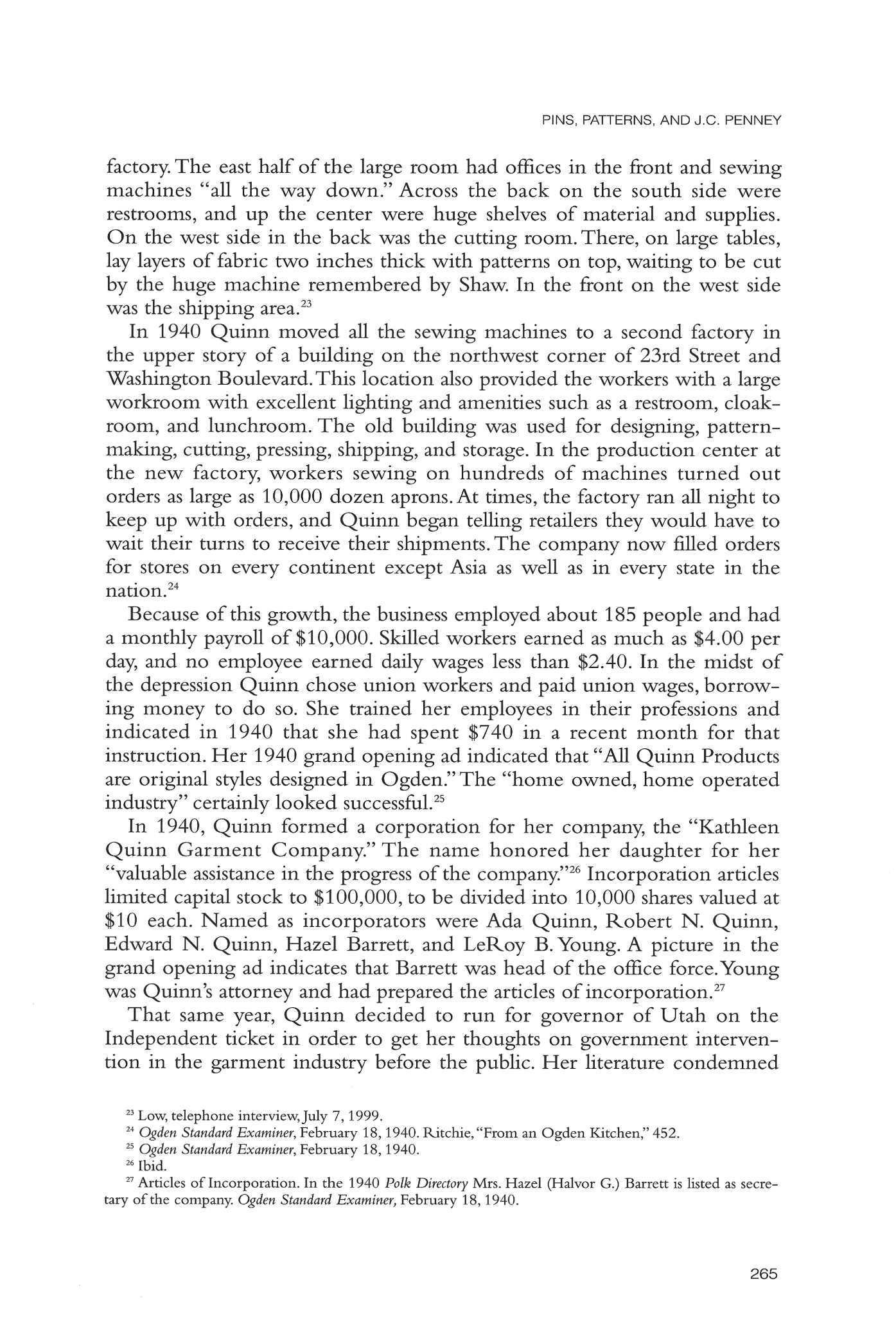
24 Ogden Standard Examiner, February 18,1940 Ritchie,"From an Ogden Kitchen," 452
25 Ogden Standard Examiner, February 18,1940
26 Ibid.
27 Articles of Incorporation. In the 1940 Polk Directory Mrs. Hazel (Halvor G.) Barrett is listed as secretary of the company Ogden Standard Examiner, February 18, 1940
265
UTAH HISTORICAL QUARTERLY
the strictures that persons could not be apprenticed in the industry without the consent of the federal government, and she declared that in 1938 only 129 such certificates had been issued for the whole nation, a situation that prevented factories from employing learners Because of this and other regulations, she said, four garment factories in Utah had closed in the previous year. 28

According to Ethel Low, Quinn realized she had little chance of winning the election, so she did not campaign statewide She had flyers made up and distributed to voters, and she bought time on local radio stations to air her beliefs. She considered such efforts sufficient to publicize her strong views about government control of the "needle industry" and to let voters know what she thought good government should be With so little exposure, and as a female candidate, it is no surprise that Quinn trailed far behind both Herbert B. Maw, the Democrat who -won the election, and Republican Don B Colton.29
A few months before the death of her husband, which occurred in May 1942, a new challenge came to Quinn, a religiously devoted Mormon. Throughout her life she had participated in the women's auxiliary of her church—the Relief Society—and attended weekly worship services Such dedication, along with her long years of experience in clothing production, brought a request from her church leaders to serve on a clothing manufacture subcommittee of the General Welfare Department of the Church of Jesus Christ of Latter-day Saints Charged with helping members become self-sufficient in producing their own clothing, the committee -was also to investigate the possibility of fabricating cloth and to coordinate all sewing and clothing production in the various church units.30
Because Quinn valued the idea of individuals helping themselves, she must have enjoyed seeing the fruits of the committee's labors in promoting clothing production In 1943 Relief Society women of the church made nearly a quarter of a million articles and donated almost three-quarters of a million hours in that production. These articles were sent to the church bishop's storehouses for distribution to needy families. Also, as part of the -war effort, many quilts, clothing, and other necessities produced by the women of the church were sent to war-torn countries.31 More than 32,000 women participated in the program each month, and the articles they produced were of"high quality and value."32
However, in 1944, when fabric production in the nation was deployed
28 Undated campaign flyers, Utah State Historical Society archives,Salt Lake City
29 Maw received 52.1 percent of the votes with 128,519; Colton had 47.7 percent with 117,713; and Ada had 0.2 with 580 votes
30 "Welfare Plan Forms New Clothing Unit," Improvement Era 45 (April 1942):242
31 See"Annual Report—1943," Relief Society Magazine 31 (July 1944),370-72.See alsoJoyce B. Peaden, "Donated Quilts Warmed War-torn Europe," in Quiltmaking in America: Beyond the Myths, Laurel Horton, ed (Nashville:Rutledge Hill Press, 1994), 105-111
32 Marion G. Romney, "The Relief Society in Church Welfare," Relief Society Magazine 32 (March 1945): 134
266
PINS, PATTERNS, AND J.C PENNEY
toward items needed in the defense industry, the women's output slowed. A note in the Relief Society Magazine advised women that, as material became available, local units should continue to work toward completing their clothing assignments, but the General Committee would no longer provide material.Women were also told that if units could obtain fabric at wholesale prices it would be proper to buy it,but they should, in turn, advise the General Committee of those purchases so it would not over-purchase later on. "If it is necessary to go into the retail markets and pay retail prices and take from the shelves of local merchants materials that are needed to meet the general needs of the local community, such purchases should not be made," the directive stated. One can almost see Quinn penning that advice.33

With the progression ofWorld War II, Quinn found it increasingly difficult to obtain the material she needed for her factory and to meet the higher shipping costs of getting the cloth to Utah As business declined, her son Horace suggested that the company begin sewing items needed for national defense For a time, the company thus tried producing munitions bags and other items for the government But when Quinn saw the enormous outlay of funds needed to carry out this work, and when she correctly realized that women's work wear -was changing from dresses and aprons to pants, she decided to close down in 1945 She sold the power machines to a factory in San Francisco and the 23rd Street building to an automobile business, and at the 28th Street plant she held a sale on case-lot fabrics, thread, and trim.34
Unfortunately, Quinn's sudden death soon thereafter ended her illustrious and successful career in the summer of 1945 Shortly before her death, she had had a wisdom tooth pulled The infection from the diseased tooth entered the bloodstream; pneumonia resulted in her death on August 23 An article in the Ogden Standard-Examiner summed up her accomplishments
Mrs. Quinn was long a leader in L.D.S. church duties, but was best known as the founder and manager of a garment industry In 1926 she established the Kathleen Quinn Garment Co., building it up from a modest beginning on a family sewing machine [to one] -which employed approximately 200 people For the past 15 years she maintained an office and sample room in the Herald Square Building, 1350 Broadway, New York City, and from there sold to the leading stores throughout the United States and in foreign countries
At the time of her death she was a chairman of the clothing committee of the church welfare plan.
She was also a member of the Daughters of the Utah Pioneers and the Business and Professional Women's club.35
33 "Materials for the 1945Welfare Clothing Budget," Relief Society Magazine 32 (March 1945):161
34 Low interview, March 4, 1999.
35 Ogden Standard Examiner, August 23, 1945.
267
UTAH HISTORICAL QUARTERLY
Ada Quinn was a remarkable woman -with great business sense, drive, and leadership. It is ironic to think that her company survived the depression,which caused many businesses to fail, only to be laid low by a war that energized similar endeavors, and it is doubly ironic that a war that brought women out of the home into the factories took her employees from the workroom and sent them home. One wonders why she did not turn to the production of the sportswear that was supplanting her aprons and dresses. Perhaps her energy was failing her as she reached her mid-sixties, and she may have felt she had attained the goals she set when she began In addition, her long-supportive husband no longer stood at her side, and she missed his support. Nevertheless, it is important that we remember her as a capable leader in LDS church -welfare work, as an outspoken gubernatorial candidate, and as a successful businesswoman who developed her company from a small beginning to a worldwide endeavor.

26 8
BOOK REVIEWS
Nearly Everything Imaginable: The Everyday Life of Utah's Mormon Pioneers
Edited by Ronald W.Walker and Doris R Dant (Provo: BrighamYoung University Press, 1999 xvi +
512 pp
$27.95.)
THROUG H DESCRIPTION S of the everyday life of early Mormo n pioneers, this fascinating collection of twenty-three essays provides in-depth insight into the character, emotions, and attitudes of these remarkable people The essays enlighten the reader on how the committed and creative Great Basin pioneers met the varying challenges of settling a new land
In "Battle of the Homefront : Th e Early Pionee r Art of Homemaking," Andrew Hedges recounts the experiences of Ann Howell Burt and Mary Hom e in dealing with the hazards and frustration of such creatures as snakes, insects, and rodents. For Ann, a rolling pin became her weapon to thwart a rattlesnake threatening her baby and her patience, and a watchful eye became her means of solving a bull-snake milk mystery. Mary, like others living in dugouts, willow lean-tos, and log cabins, had to find a way to meet the challenge of a dozen or more mice invading her home each night.
The culinary talents of residents of the Great Basin were constantly challenged by the limited availability and variety of food
In '"I Have Eaten Nearly Everything Imaginable': Pioneer Diet," Jill Derr notes that if anything could be converted into food, the pioneers found a way to do so The sego lily, destined to become the Utah state flower, was a common source of food for many individuals It is difficult to imagine the preparation of nettle, which could become a palatable dish Because of their creativity and sharing of resources, few Saints starved
An interesting look at church activity is found in "Commo n People: Churc h Activity during the Brigham Young Era," by William Hartley Compared to present times, church attendance was not an essential criterion of faithfulness One compelling reason was an absence of facilities that could accommodate the entire membership of a ward In addition, prior to the organization of church auxiliaries, children and women were not encouraged to attend meetings The sacrament was not offered as frequently as it is today and, contrary to the principles of modern hygiene, the sacrament was taken from a communal cup
"The Homemade Kingdom: Mormon Regional Furniture," by Richard Oman, describes the origin and construction of pioneer

269
UTAH HISTORICAL QUARTERLY
furniture. Du e to isolation and the difficulty of transportation, most early furniture was handcrafted from local materials. As Mormo n converts came from many lands and cultures, the furniture they fabricated illustrated their various origins; thus, there -was no commo n style. On e commo n feature of regional furniture was the artificial graining finish on cottonwood and pine to mimic scarce hardwoods. As transportation permitted importation of factory-made furniture, the local manufacture of furniture declined.
Man y other topics poignantly describe everyday life in the Great Basin as experience d by the Mormo n pioneers . The y include health, dress, education, cemeteries, biographical sketches, statistics, music, growing up, longevity of married couples, and more. For those readers looking for information about early life in the Great Basin this volume should offer some interesting reading.
This collection, the first in a new series called Studies in Latterday Saint History, is published by Brigham Young University Press. Walke r and Dan t collecte d th e essays from a symposium , "Everyday Life in Pioneer Utah," sponsored in March 1997 by the Smith Institute at Brigham Young University, for inclusion in this volume. Personally, I found this to be a very interesting book.
JAY A ALDOUS University of Utah
Over the Rim: The Parley P. Pratt Exploring Expedition to Southern Utah, 1849-50. Edited by William B. Smart and Donna T. Smart (Logan: Utah State University Press, 1999 x + 270 pp Cloth, $37.95; paper, $19.95.)
TH E EDITORS , William B. Smart and Donna T Smart, became interested in the Parley P Pratt expedition that explored southern Uta h through an interest in finding information on Donna's great-great grandfather, William Henrie, wh o was a membe r of the Pratt party. They found few references to him, but the search led them to a desire to publish in full the four original journals kept by participants during the expedition of 1849-50. Th e journals of Robert Campbell, the official clerk of the expedition, and of Joh n C. Armstrong, John Brown, and Isaac C. Haight are published with the original spelling, punctuation, and grammar
Th e editors add significant commentar y betwee n journa l entries to place the expedition in context among other explorations of southern Utah, to discuss present-day place names, and

270
to speculate on the route when it is in doubt Those familiar with the Rick J. Fish master's thesis on the Southern Utah Expedition done at Brigham Young University in 1992 may -want to compare the route from the Sevier River to Summers Gate as suggested by the Smarts on page 60-61 to that suggested by Fish's thesis Th e editors also provide some detail on the outcomes of the expedition in relationship to settlement sites and land usage However, Cedar City was not settled the year following the settlement of Parowan but in the same year, November 11, 1851 (14)
Pratt's official report to the territorial legislature and a short epilogue are also included together with rather lengthy appendices that include related papers, valuable short biographies of the expedition members, and Rober t Campbell's Ut e dictionary and his emigrant guides There are, however, a few minor errors on dates in the biographies, which may be typos. For example, on page 224 Josep h Hom e is said to have bee n driven from Nauvo o in February 1861. George B. Matson, Sr., was said to have helped build Camp Floyd in 1857 (231), and the camp was actually built in 1858. And on page 235 William Wines Phelps is said to have acted as Josep h Smith's scribe and speechwrite r at Kirtlan d between 1825 and 1836.
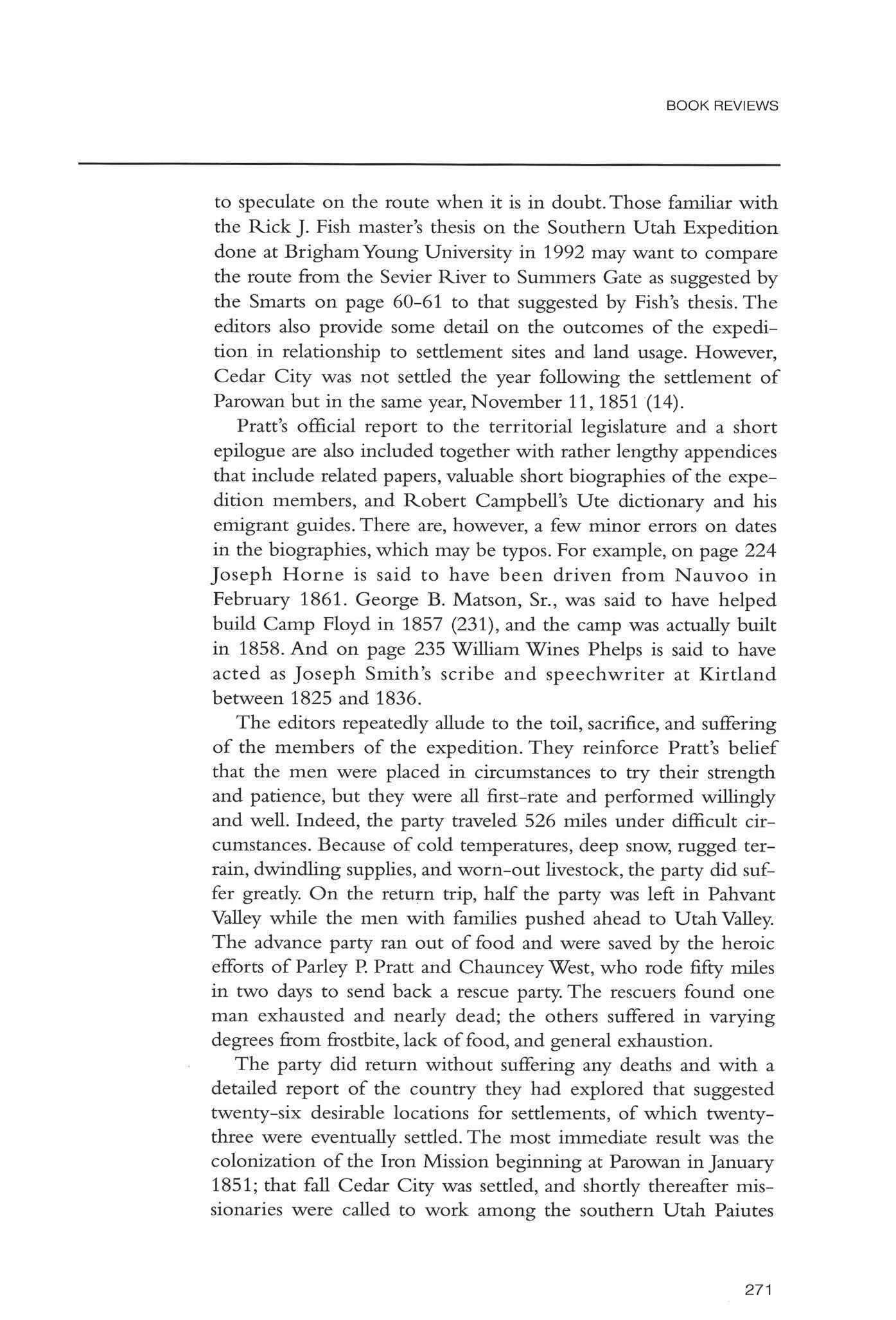
Th e editors repeatedly allude to the toil, sacrifice, and suffering of the members of the expedition. They reinforce Pratt's belief that the me n were placed in circumstances to try their strength and patience, but they were all first-rate and performed willingly and well Indeed, the party traveled 526 miles under difficult circumstances. Because of cold temperatures, deep snow, rugged terrain, dwindling supplies, and worn-out livestock, the party did suffer greatly. O n the return trip, half the party was left in Pahvant Valley while the men with families pushed ahead to Utah Valley
Th e advance party ran out of food and were saved by the heroic efforts of Parley P Pratt and Chauncey West, who rode fifty miles in two days to send back a rescue party. Th e rescuers found one man exhausted and nearly dead; the others suffered in varying degrees from frostbite, lack of food, and general exhaustion
Th e party did return without suffering any deaths and with a detailed report of the country they had explored that suggested twenty-six desirable locations for settlements, of which twentythree were eventually settled Th e most immediate result was the colonization of the Iron Mission beginning at Parowan in January 1851; that fall Cedar City was settled, and shortly thereafter missionaries were called to work among the southern Utah Paiutes
BOOK REVIEWS
271
QUARTERLY
along Ash Creek and later at Santa Clara Still later, other colonies were established as a result of the Pratt report.
Th e work is thorough and convincing, as the journals are supported by good research by the editors. This is a valuable and worthwhile addition to the history of western exploration and to Utah and Mormo n history Th e Smarts' thesis—that the expedition was made up of men wh o were willing to give all for their God and their religion, that the me n returned strengthened in commitmen t and contributed muc h to their communities and their church, and that the results of the exploration justified the efforts—is well-documented
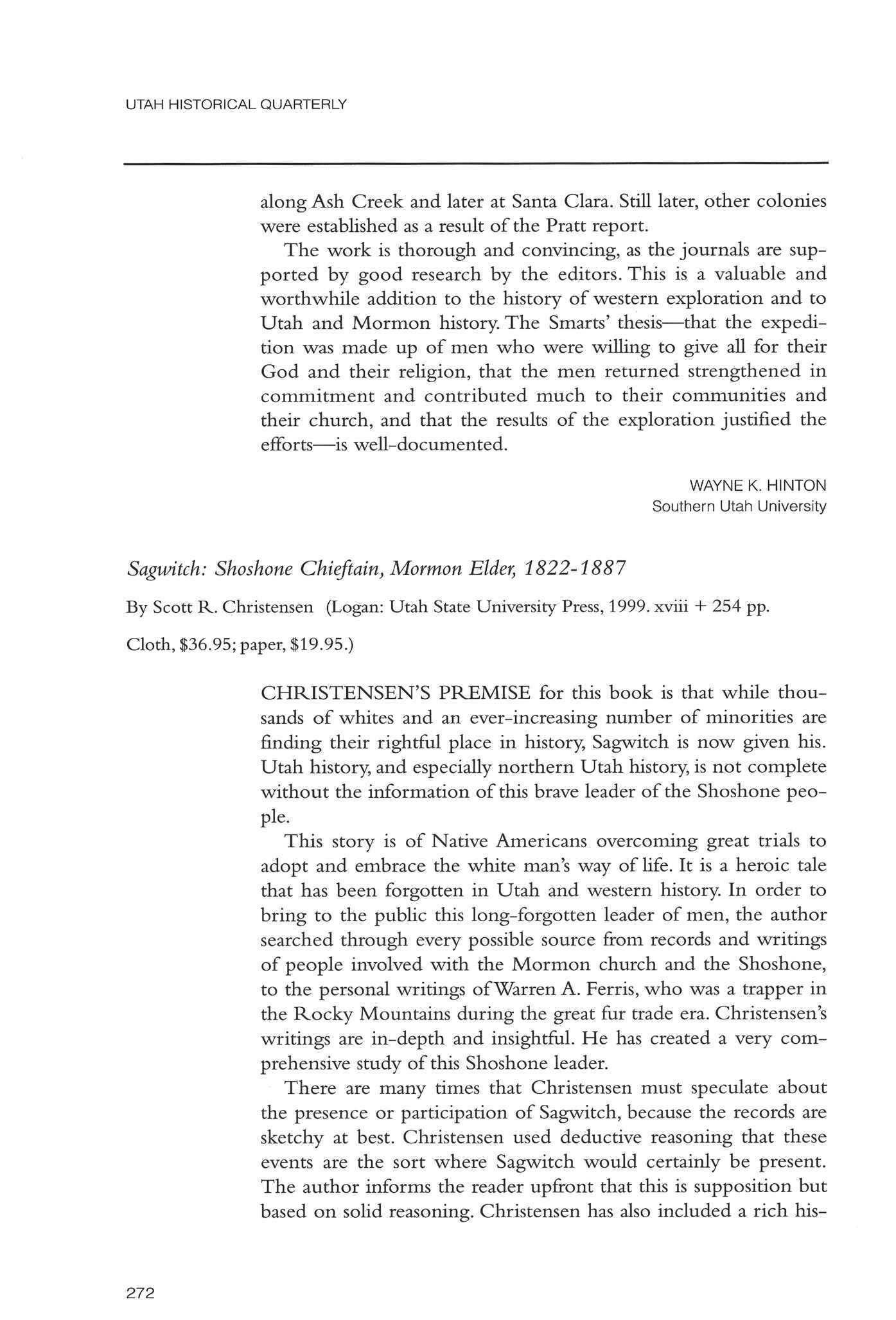 WAYNE K HINTON Southern Utah University
WAYNE K HINTON Southern Utah University
Sagwitch: Shoshone Chieftain, Mormon Elder, 1822-1887
By Scott R. Christensen (Logan: Utah State University Press, 1999. xviii + 254 pp. Cloth, $36.95; paper, $19.95.)
CHRISTENSEN' S PREMIS E for this book is that while thousands of "whites and an ever-increasing number of minorities are finding their rightful place in history, Sagwitch is no w given his. Utah history, and especially northern Utah history, is not complete without the information of this brave leader of the Shoshone people
This story is of Native Americans overcoming great trials to adopt and embrace the -white man's way of life. It is a heroic tale that has been forgotten in Utah and western history In order to bring to the public this long-forgotten leader of men, the author searched through every possible source from records and writings of people involved with the Mormo n church and the Shoshone, to the personal writings of Warren A Ferris, wh o was a trapper in the Rock y Mountains during the great fur trade era. Christensen's writings are in-depth and insightful H e has created a very comprehensive study of this Shoshone leader.
There are many times that Christensen must speculate about the presence or participation of Sagwitch, because the records are sketchy at best Christensen used deductive reasoning that these events are the sort where Sagwitch would certainly be present Th e author informs the reader upfront that this is supposition but based on solid reasoning Christensen has also included a rich his-
UTAH HISTORICAL
272
tory of the area of northern Utah and southern Idaho to give a foundational background and understanding of the -world of the Shoshone
While Christensen strives to be objective in the writing of this book, it is still pro-Native American and pro-Mormon. Perhaps this is because he deals mainly with the interactions of the Indians within and without the Mormo n church, and only minimally with the non-Mormon world of Corinne, Utah, and the U.S. government. H e tries to look at events from the Shoshone point of view, which leaves little room for total objectivity The information is presented -well in an easy-to-follow and engaging format The reader becomes engrossed in the narrative of the events as they unfold.
Sagwitch himself was a natural-born politician His name means "orator," and it was given to him because of his "significant speaking and negotiating skills." "He had a way of speaking to his people that made them listen and obey." Using his political savvy and oratory skills, he saw the importance of embracing the -white man's way to best ensure the survival of his people. His is a story of continual struggle to fit into a world that mostly did not want him The Mormo n policy was that it was easier and cheaper to feed the Indian than to fight him, so they strove to provide room for Indians. It was the non-Mormon population of Corinne that tried to drive the Shoshone out of the land altogether, as presented by Christensen Many of the problems arose as more and more settlers arrived in the area, taking over the hunting grounds of the Shoshone and making it impossible for them to survive on their own. The narrative ends with the death of this great leader and a look at his descendants and their impact on the surrounding communities
The information and sources are solid and are likely to stand the test of time. There is little chance that this book will be replaced in the near future, because of its completeness This is a welcome addition to the historical scholar's library, but its greatest interest will most likely be for the Mormon community. However, it is written for all to enjoy and effectively use. In an ever-growing field of Native American studies, this book will be able to hold its own and make a valid and valuable contribution It is well -written and well presented and will be well received.
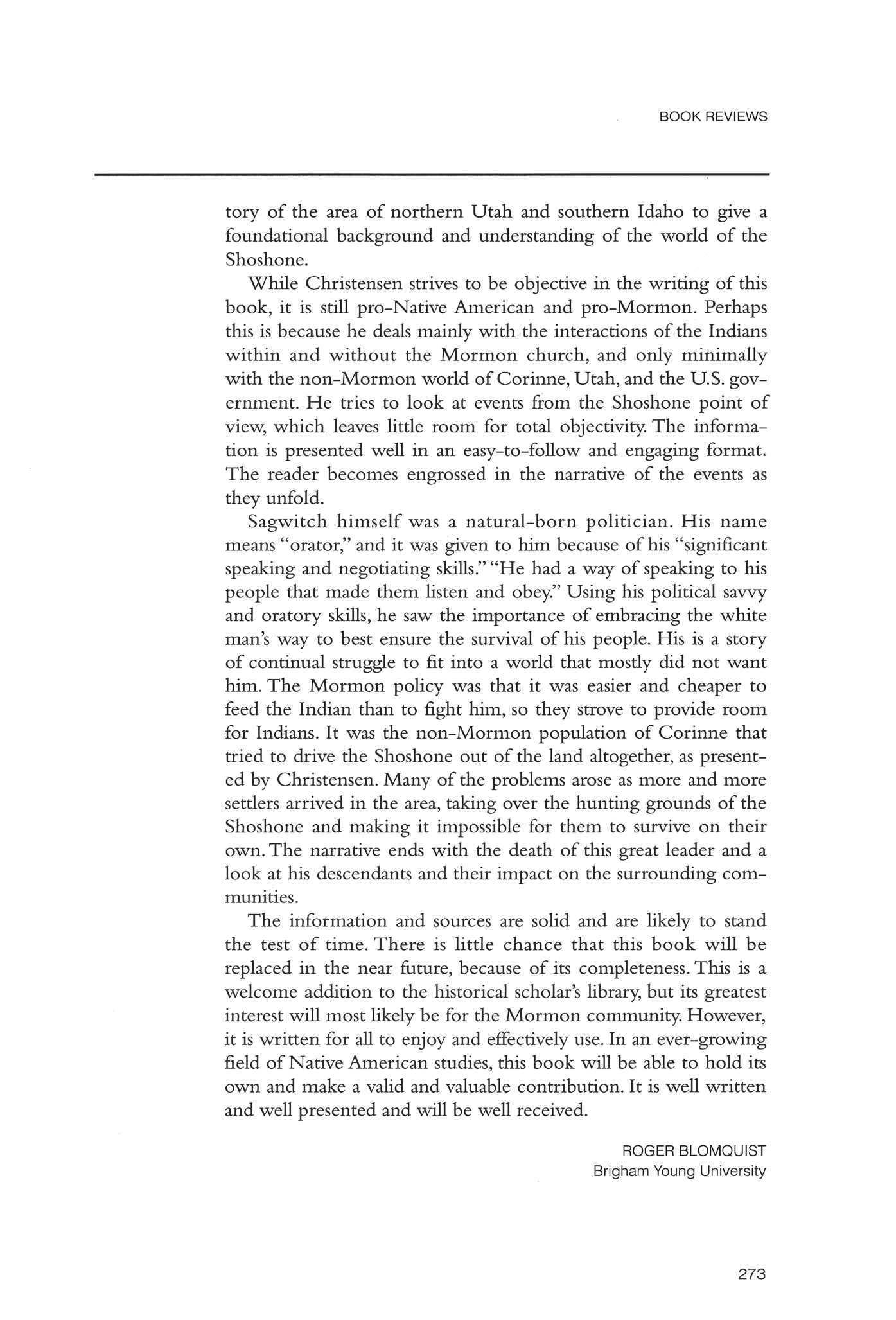 ROGER BLOMQUIST Brigham Young University
ROGER BLOMQUIST Brigham Young University
BOOK REVIEWS
273
UTAH HISTORICAL QUARTERLY
Irrigated Eden: The Making of an Agricultural Landscape in the American West
By Mark Fiege (Seattle: University ofWashington Press, 1999. xvi + 323 pp. $35.00.)
ACCORDIN G T O TH E
BOO K of Genesis, Adam and Eve lived in a state of harmony in the Garden of Eden, with all manner of fruit, grain, and animals being provided them. Whe n they were banished from the garden to the natural world of wilderness filled with thorns and thistles and other flora and fauna of the -world, it became necessary for Adam to work by the sweat of his brow, planting, irrigating, and harvesting crops that were necessary for life. To take full advantage of the wilderness, the biblical couple had to deal with the environment and to use the resources that existed for their benefit.
Th e title of this book , Irrigated Eden: The Making of an Agricultural Landscape in the American West, and the illustration that adorns the dust jacket, "Golden Opportunities," -which depicts a very youn g couple (perhaps a late nineteenth-centur y Idaho Adam and Eve) gazing over a bountiful harvest, suggest the successful conquest of the wilderness found in souther n Idaho However, a reader of this well-written book quickly learns the real story of agriculturalists coming to grips with the natural environment William Cronin, writer of the fore-word, suggests that Irrigated Eden is a "meditation on the complex interplay of human dreams and natural realities in reshaping our national landscape" (ix) Fiege's investigation of the interplay of irrigation and the environment is part of a series of environmental titles supported by th e Weyerhaeuse r Environmenta l Books , whic h seek to "explore huma n relationships with natural environments in all their variety and complexity."
In his first two chapters, Fiege examines the interrelationships between the existing natural landscape and a new environment created by irrigators. H e quickly discovers in his study that even as irrigators were attempting to "tame" the Snake River and "conquer" the arid land by the construction of irrigation ditches and canals, the riparian environment of the Snake River and its tributaries -was also being expanded by the same irrigation ditches and canals. Th e diversion of water brought a "profound ecological change" to southern Idaho (43). This constant interplay bet-ween the irrigated and riparian environments resulted in -what Fiege identifies as a "dynamic environment" of flora and fauna that was seldom controlled absolutely by farmers and scientists (40).
Th e attempt to create an irrigated garden, writes Fiege, is not
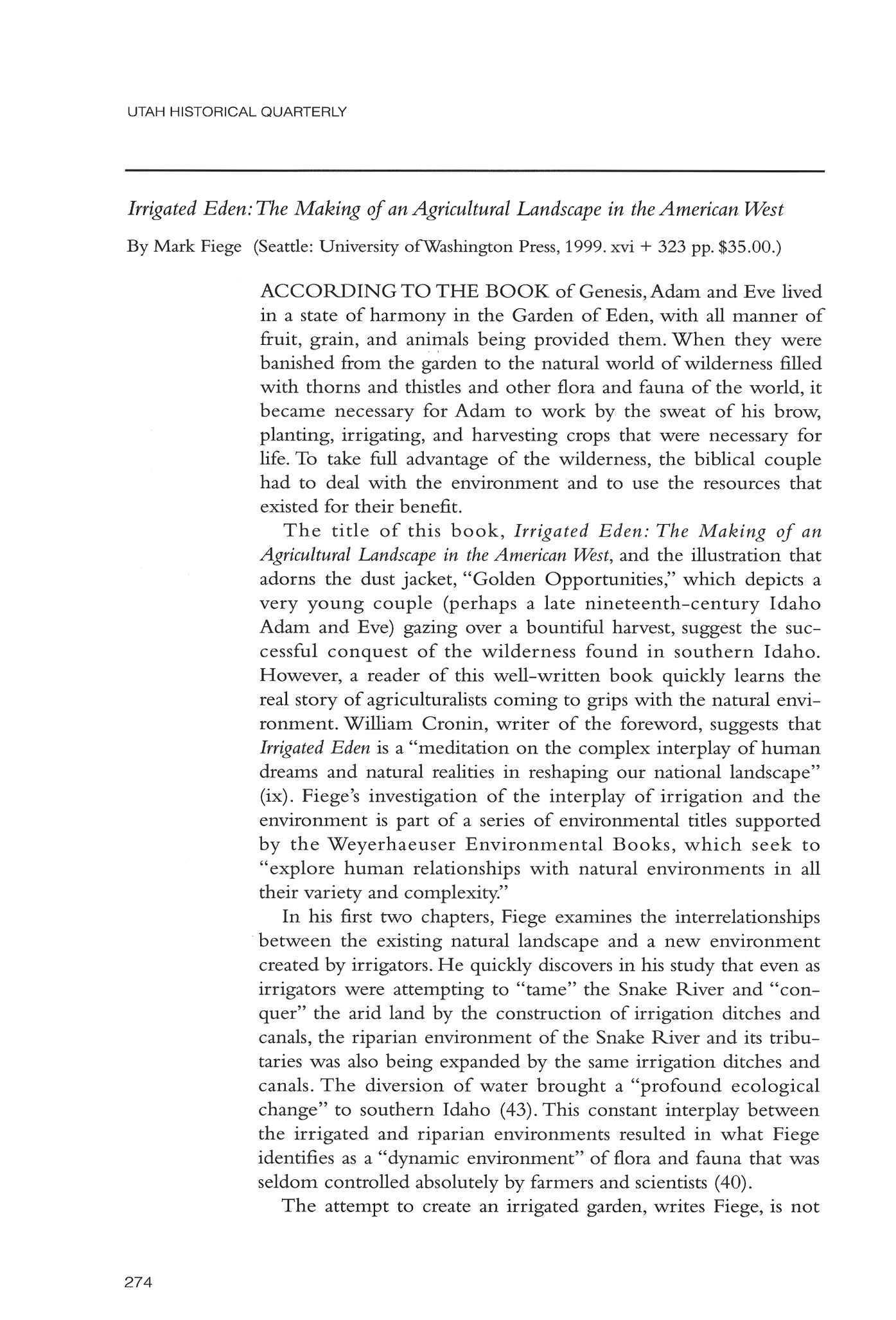
27 4
without unwanted consequences. For instance, the diversion of vast amounts of water and the impoundment of the Snake River have greatly altered the habitat of salmon and other cold-water fish In their place are the Utah chub and suckers, -which flourish in warmer, slower-moving -water A more recent example illustrates this "dynamic environment." In the 1970s irrigators, scientists, engineers, and others conceived of a plan to control and manage the upper Snake River by constructing the earth-filled Teton Dam Th e subsequent collapse of the dam significantly altered the landscape and environment in ways that the engineers, agriculturalists, and others had not planned.
In three chapters, Fiege examines the human interplay created by the construction of artificial water-ways and the use of the scarce resource of water Unlike the Garden of Eden, the created irrigation environment of the late nineteenth and early twentieth centuries had no demarcated boundaries. Cooperation and conflict were part of the interplay of the agriculturalists Conflicts were resolved by various means, from individual vigilantism—the tried and sometimes-used method of the mythical "Old West"— to organization and the establishment of laws and rules.
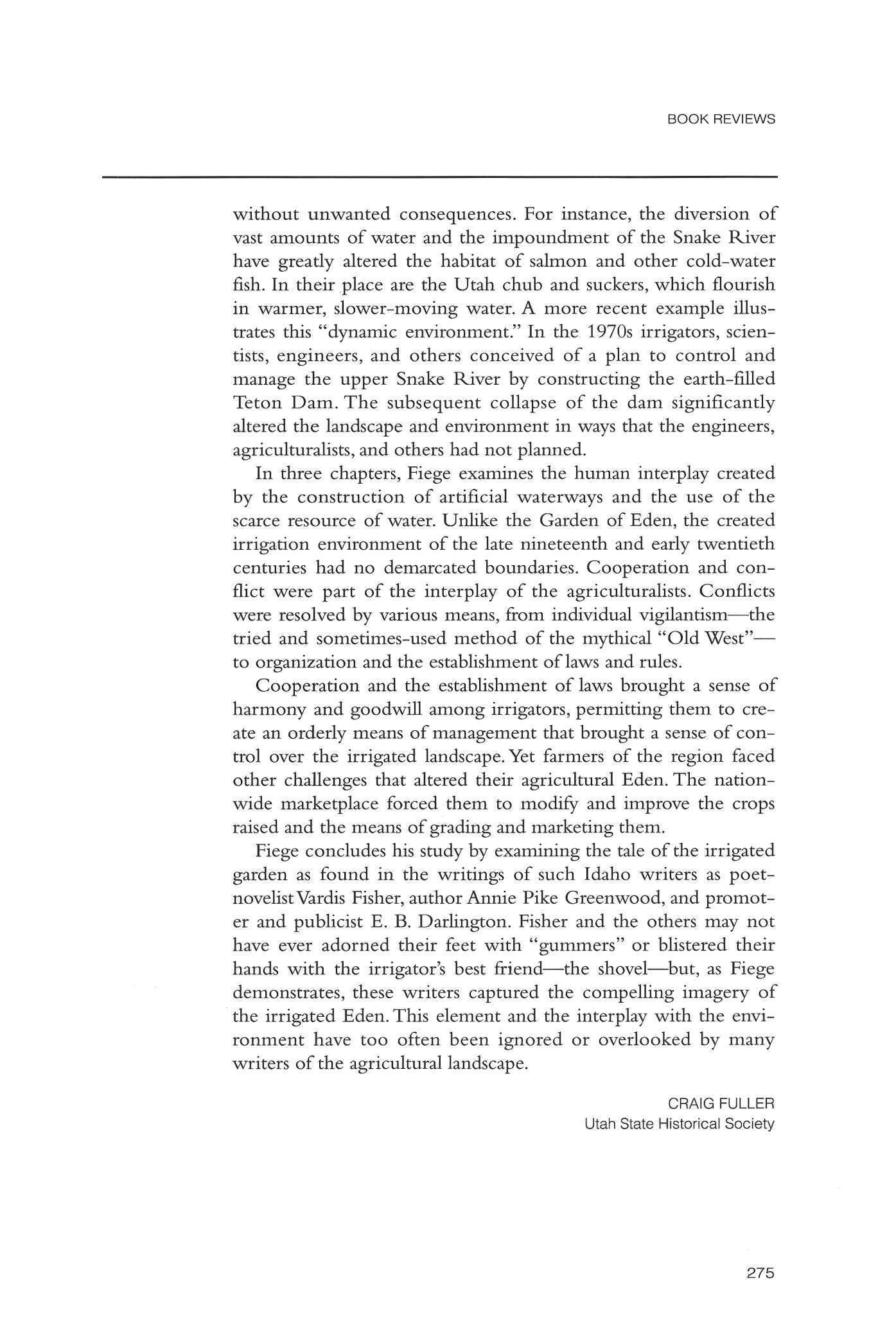
Cooperation and the establishment of laws brought a sense of harmony and good-will among irrigators, permitting them to create an orderly means of management that brought a sense of control over the irrigated landscape. Yet farmers of the region faced other challenges that altered their agricultural Eden The nationwide marketplace forced them to modify and improve the crops raised and the means of grading and marketing them.
Fiege concludes his study by examining the tale of the irrigated garden as found in the writings of such Idaho -writers as poetnovelist Vardis Fisher, author Annie Pike Greenwood, and promoter and publicist E. B. Darlington. Fisher and the others may not have ever adorned their feet with "gummers" or blistered their hands with the irrigator's best friend—the shovel—but, as Fiege demonstrates, these writers captured the compelling imagery of the irrigated Eden. This element and the interplay with the environment have too often been ignored or overlooked by many -writers of the agricultural landscape
CRAIG FULLER Utah State Historical Society
BOOK REVIEWS
275
HISTORICAL QUARTERLY
Fawn McKay Brodie: A Biographer's Life
By Newell G Bringhurst
(Norman: University of Oklahoma Press, 1999 xviii + 350 pp $29.95.)
BEGINNIN G WIT H TH E COVE R portrait of Fawn McKay Brodie glancing beguilingly over her shoulder under a broadbrimmed hat, this biography of Mormonism's most spectacular bad girl since Fanny Stenhouse is deeply researched and engagingly written
Bringhurst makes no bones about his fascination with Brodie, confessing in the first sentence, with tongue only slightly in cheek, that he has spent the past thirteen years in "an intense intimate relationship with a woman other than my -wife" (xiv) H e honors both Brodie's achievement and her techniques by explaining his own reasons for being attracted to her controversial professional life, includin g his persona l disillusionmen t wit h Mormonism over the ban on ordaining African American men
H e set himself two goals in this biography: to present "the -whole individual" including "her frailties, frustrations, and failures," and also to explore the question: "Why did Fawn Brodie find herself embroiled in controversy throughout her life?" (xv). H e answers both, and the results are a generally satisfying and thoroughly engrossing biography, appealingly studded with personal and family photographs
It also includes a very helpful description of the development of biographical theory, the influence of Freud and Erikson on Brodie's approach to psychobiography, and her preoccupation with sexual issues and lying as consistent themes in the five very different but very public figures -who -were the subjects of her biographies: Joseph Smith, Thaddeus Stevens, Richard Burton, Thomas Jefferson, and Richard Nixon
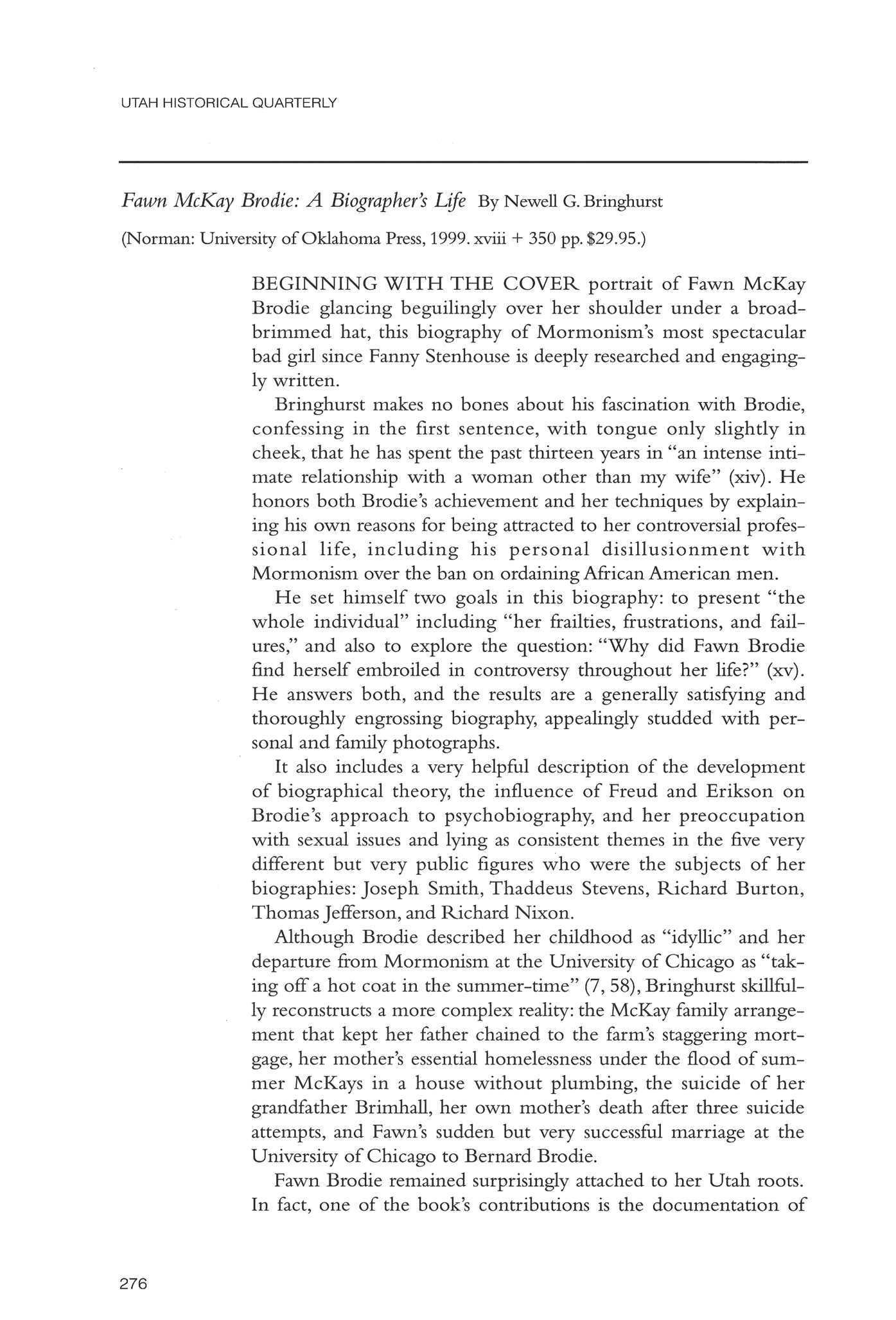
Although Brodie described her childhood as "idyllic" and her departure from Mormonism at the University of Chicago as "taking off a hot coat in the summer-time" (7, 58), Bringhurst skillfully reconstructs a more complex reality: the McKay family arrangement that kept her father chained to the farm's staggering mortgage, her mother's essential homelessness under the flood of summer McKays in a house without plumbing, the suicide of her grandfather Brimhall, her own mother's death after three suicide attempts, and Fawn's sudden but very successful marriage at the University of Chicago to Bernard Brodie
Fawn Brodie remained surprisingly attached to her Utah roots In fact, one of the book's contributions is the documentation of
UTAH
276
almost annual visits to the state, including several important speeches and her much-appreciated election as a fellow of the Utah State Historical Society She also gave and received regular visits with her family. Such closeness on one level coexisted with distance on another: her father never read her controversial Joseph Smith biography "or even acknowledge[d] its existence" (103) Absorbing for RLDS and LDS readers will be the discussion of the two churches' reactions (both negative) to the 1945 publication of the Smith biography, culminating in Brodie's excommunication by the Ne w England Mission president for apostasy on June 1,1946 (98-113)
Despite Bringhurst's impressive research, he is unexpectedly reticent in offering his own analysis of his controversial subject. After thirteen years of research, he must know Fawn McKay Brodie as a person and as a professional in ways that even her children do not, and I wanted more of his own conclusions Although he diligently summarizes the critical reaction to each book, he does not share his own critical insights. Bernard's relatives disappear from the narrative after the wedding without an explanation. Through quotations, Bringhurst speculates that Brodie defined herself in a typically masculine way—by her workaholic achievements—and that she even wanted in some ways to be a man (16768), yet he does not juxtapose this conclusion with evidence he himself presents of her blissful delight in mothering her three children or her nurturing support of her students He establishes that she was preoccupied with lying as a character trait in all of her biographical subjects, yet he does not explore her own standards of historical research and -writing Bringhurst candidly documents that Fawn sympathized with her mother's revulsion about sex, that she dealt therapeutically with her own sexual inhibitions -with only partial success, and that she was outraged when she discovered that Bernard had had at least one affair Yet he does not explore the meaning these elements may have had as she relentlessly probed the sexuality of her subjects.

Any biographer must decide how much is excessive; but if a reader's preference counts, I vote for more
LAVINA FIELDING ANDERSON Salt Lake City, Utah
BOOK REVIEWS
277
UTAH HISTORICAL QUARTERLY
The Trial of Don Pedro Leon Lujdn: The Attack against Indian Slavery and Mexican Traders in Utah
By Sondra Jones (Salt Lake City: University of Utah Press, 2000
vii+ 182 pp $27.50.)
MAN Y STANDAR D HISTORIE S O F UTA H contain brief discussions of the controversial Do n Pedro Leon, a trader from Ne w Mexico who -was accused of engaging in the Indian slave trade in late 1851. Some historians have related that he and some of his compatriots were tried by Judge Zerubabbel Snow and fined and sent out of the territory Several historians attempt to draw a relationship between these traders and the subsequent Walker War. This slender volume by Sondra Jones is certainly the definitive work on the subject Jones provides a rich cultural and historical background to slavery and the slave trade in early Utah, dispelling along the way a number of myths about them as well as about the trial of Do n Pedro Leon.
The book is competently written and organized in a helpful and logical -way. Jones first examines traditional views of the Do n Pedro Leon affair, finding them deficient in a number of aspects She then describes the Indian "slave" trade in Uta h and Ne w Mexico, noting how differently the two cultures viewed slavery and those held as indentured servants or slaves. Hispanic Ne w Mexico assimilated Native Americans (even those held originally as slaves or indentured servants) far more easily than did Mormo n Utah. Uta h legally approved of African American slavery but found Indian slavery more troubling, partly because it generally involved stronger tribes preying on weaker groups and partly, perhaps, because of the religious significance attributed to Native Americans by Mormons (though Mormon-Indian relations were often not easy).
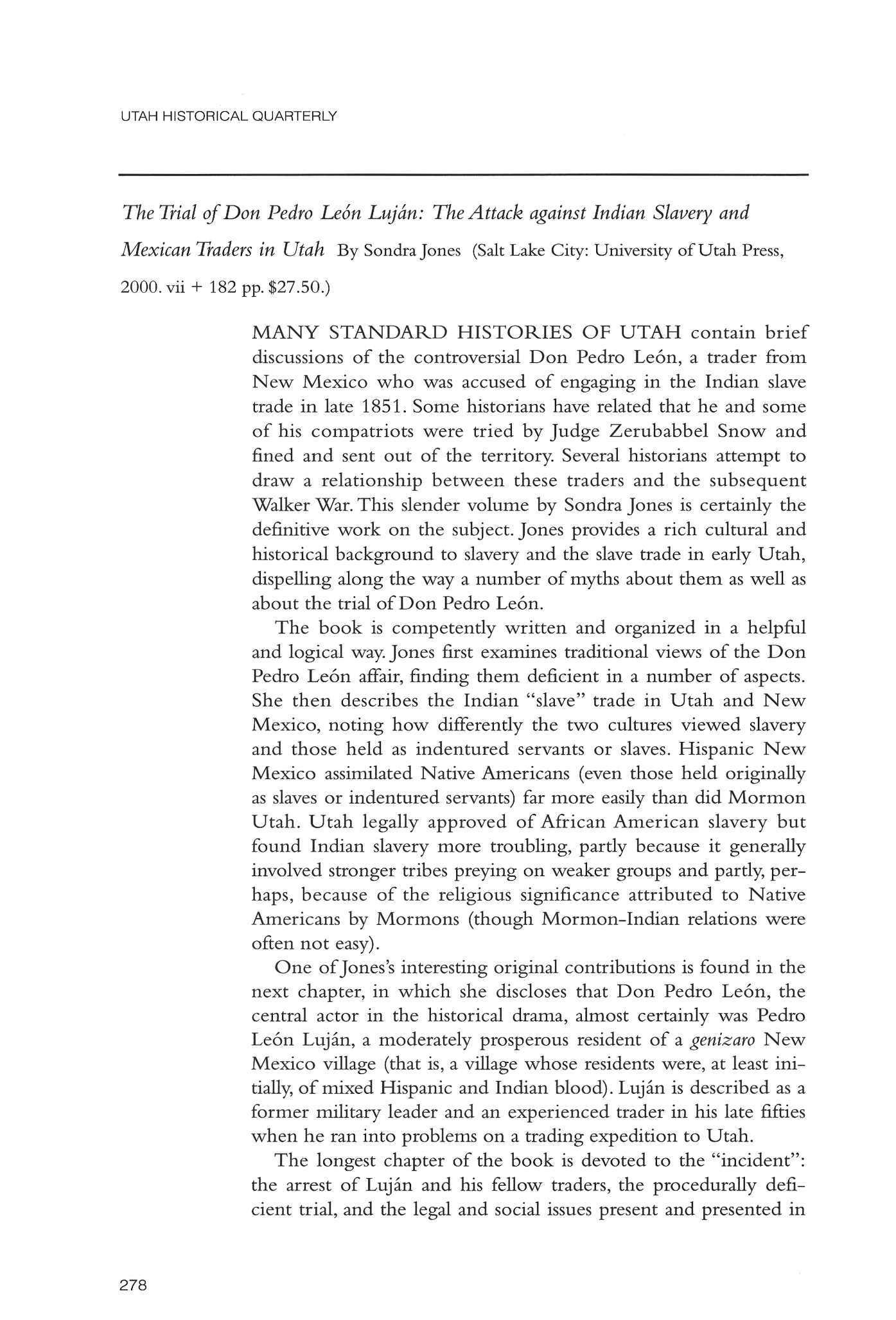
On e of Jones's interesting original contributions is found in the next chapter, in which she discloses that Do n Pedro Leon, the central actor in the historical drama, almost certainly was Pedro Leon Lujan, a moderately prosperous resident of a genizaro Ne w Mexico village (that is, a village whose residents -were, at least initially, of mixed Hispanic and Indian blood) Lujan is described as a former military leader and an experienced trader in his late fifties -when he ran into problems on a trading expedition to Utah.
The longest chapter of the book is devoted to the "incident": the arrest of Lujan and his fellow traders, the procedurally deficient trial, and the legal and social issues present and presented in
278
the proceedings Jones makes a strong case that Lujan and his fellow traders were actually attempting to trade legally in Utah and may have been willing to cease when told they were acting illegally. Th e Indians appear to have been adamant about trading slaves for goods Social reality, even without legal support, required the arrest and conviction of Lujan and his men, however. Seth Blair prosecuted the defendants, and Mormo n leader George A Smith, wit h one month's legal practice behind him, was lead counsel to the traders Relying on those primary documents she was able to locate, Jones closely scrutinizes the court proceedings, noting the practical issues involved as well as the political and cultural forces at work. She essentially concludes that Lujan should not have been convicted, because there were strong defenses, but that the jur y was more interested in making a statement about Indian slave trading than in considering the genuine issues in the proceeding before them.
In the next, penultimate chapter, Jones discusses the "aftermath" of the trial, including its effect on Lujan, on Ne w Mexico (slight) and on Utah (far more pronounced) Pedro Leon Lujan found himself destroyed financially by the confiscation of his property, first by the Indians and then, of what was left, by Utah court officials. Although the trial itself did not stop the Indian slave trade in Utah, it set in motion events that would eventually lead to this result. Substantial coverage is provided of the treatment of Indian children wh o ended up with Mormo n families in Utah and ho w they fit in less easily and were less acculturated in Utah than were their counterparts in Ne w Mexico
Jones concludes wit h a chapter that discusses the views of Mormons on slavery evidenced in the trial and in the treatment of Indians purchased and/o r adopted by Utah Mormons, and that judges the validity of the trial. Mormon s in Uta h sometimes found themselves "trading" for Indian slaves by being faced with the same choice Lujan may have been given: purchase an Indian child with arms or other goods or watch the child be killed
Jones has made a small but important contribution to Utah history by providing a clear, concise account of the trial of Do n Pedro Leon and the issues addressed therein, the events leading up to it, and its aftermath In doing so she revises earlier, more biased, attempts to fit this episode into the broader background of midnineteenth century events Her analysis of the difficult and sometimes inconsistent views of Utah Mormon s on slavery and the dependence for these views on the ethnicity of those enslaved is
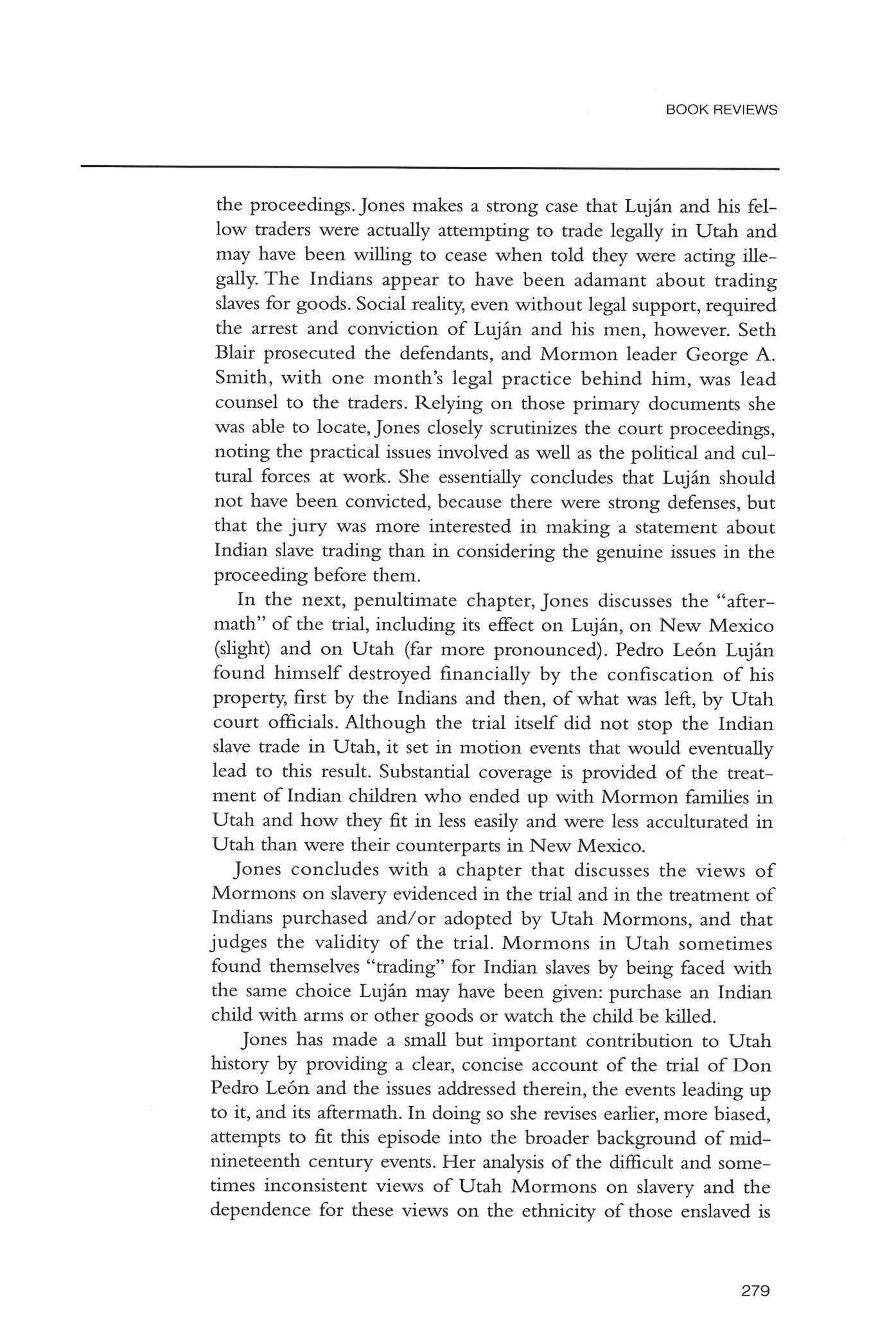
BOOK REVIEWS
279
UTAH HISTORICAL QUARTERLY
filled with disquieting but intriguing insights Her point that we too often focus on the "white" history of the area is well taken
KENNETH L.CANNON II Salt Lake City
Compiled by John H.Yang (Salt Lake City: Asian American Advisory Council in cooperation with the Utah State Office of Asian Affairs, 1999 xvi + 264 pp $25.00.)
Asian Americans in Utah: A Living History
TH E STATE O F UTAH , and indeed the entire West, is a region of ethnic and cultural diversity Although scholars from many disciplines have begun to investigate this diversity in recent years, much remains to be done. Building upon the earlier work of Helen Papanikolas in telling the story of The Peoples of Utah (Utah State Historical Society, 1976), Asian Americans in Utah seeks to "render a more complete view of the Utah history" by recording the Asian American experience (xi). The book provides a historical look at Asian Indian, Cambodian, Chinese, Filipino, Hmong, Japanese, Korean, Laotian, Thai, Tibetan, and Vietnamese immigrants to Utah from their earliest recorded arrival in the state to the present
The book is divided topically with each chapter dealing -with a specific immigrant group. Chapters begin with a brief but valuable review of the pre-immigration history of the country of origin, thus creating a context for the emigration process Most chapters include a discussion of how the irnmigrant community developed within the state, the traditional cultural celebrations and practices maintained by the community, and the contributions of its individual members to the professional, academic, and cultural fabric of Utah.
The strengths of the book are its depth and breadth of coverage. Th e immigration history of each Asian group is covered from the 1850s, in the case of the Chinese, to the present. At the same time, the inclusion of relatively small immigrant groups demonstrates the work's depth Each chapter is written by people wh o have "distinct" ties to the communities they write about and "wh o understand the culture, traditions, and intricate nature of each people"(xiv) It is also evident that the authors have a passion for the stories they tell Othe r strengths include the color pho -

280
tographs, which add a sense of reality and personality to the text, and the bibliographies included with each chapter, which provide the serious student of the Asian experience in Utah a source for further research
The book could have benefited from a stronger editorial hand The chapters are not equal with regard to style and grammar. Some chapters focus on immigrant family histories to tell the story of the immigrant community while others rely on a more general history of the entire group Occasionally, the work suffers from obvious spelling errors that should have been discovered at some point in the editorial process.
Asian Americans in Utah is a must-have book for all public and school libraries throughout Utah, as well as anyone interested in the history of Asians in the state. It provides students from elementary through high school with a local context for the multicultural perspective evident in so many of their texts and assignments and allows them to see the strength of that multi-cultural influence in their own communities. It provides an excellent source of research material on topics as varied as the history of Tibet to the results of American involvement in the Vietnam War
• ", •
Contested Landscape: The Politics of Wilderness in Utah and the West
ERICWALZ
Ricks College
(Salt Lake City: University of Utah Press, 1999. xviii + 266 pp. Paper, $19.95.)
Edited by Doug Goodman arid Daniel McCool
CONTESTED LANDSCAPE IS A COLLECTIO N of essays that grew out of a 1997 University of Utah course, taught by political scientist Daniel McCool , entitled "Th e Politics of Wilderness in Utah and the West." McCool's goal, as he explains in his preface, was to have his students, undergraduate as well as graduate, produce a series of balanced essays examining various facets of the recent battles over the creation of wilderness areas in Utah. The result, he hoped, would be a primer on the political intricacies and various points of view involved in protecting wilderness in Utah McCool and his co-editor, Doug Goodman, have succeeded fairly well in meeting this goal. Although the essays are uneven, together they do give the reader a detailed sense of the complexities of wilderness designation More than that, the
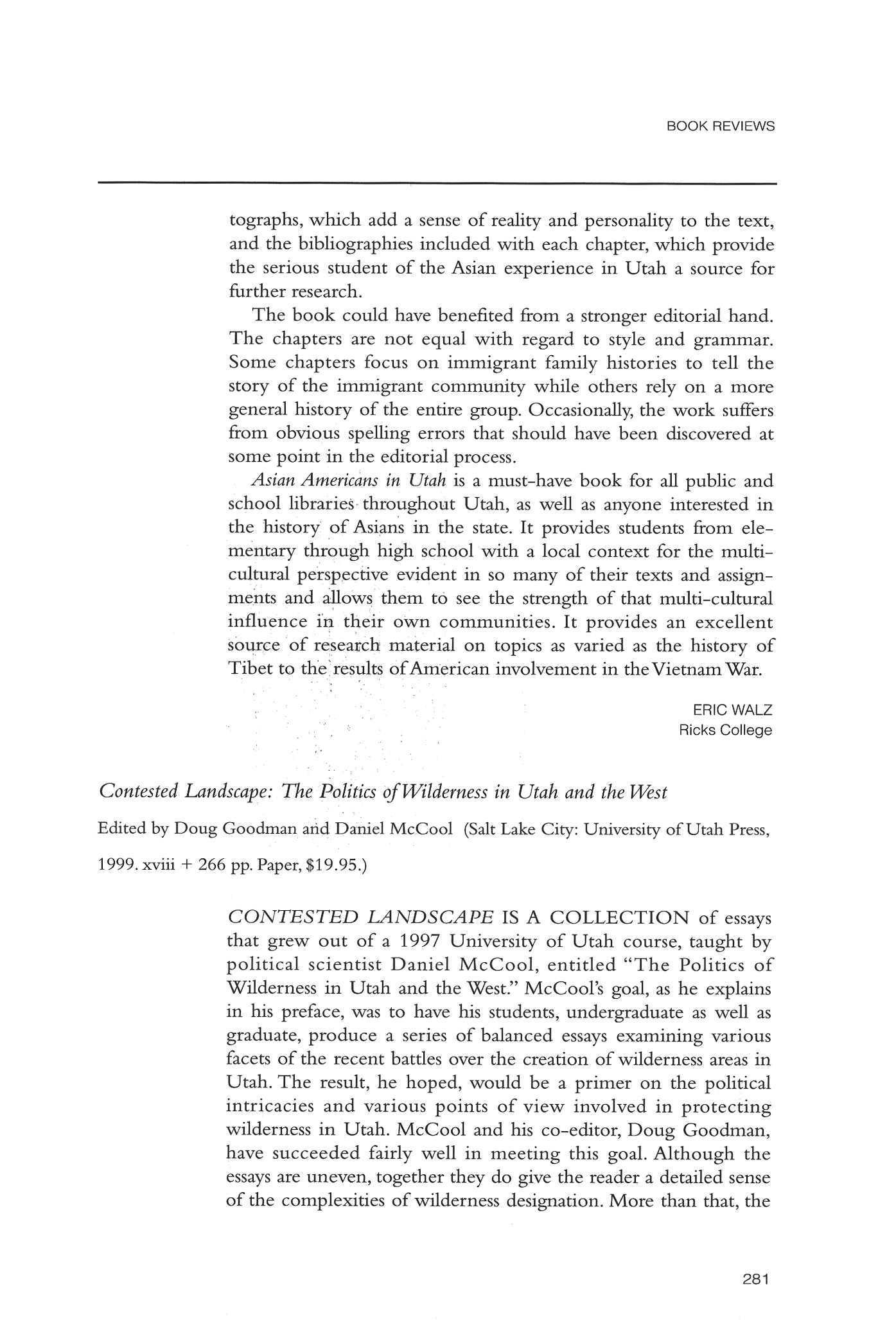
BOOK REVIEWS
281
essays provide a solid basis for the volume's overarching policy suggestion: that wilderness designation needs to be a process that both respects and effectively mediates the interests of local as well as national stakeholders.
The book is divided into four thematic sections. Section One, "A Foundation of Facts," has essays that look at the history of the wilderness concept, the constitutional bases for wilderness designation, and the specific process of inventorying Utah's Bureau of Land Management (BLM) holdings for potential wilderness areas. As the authors of this last essay point out, Utah's wilderness politics currently revolve around the suitability of various BL M areas for wilderness designation. This debate began in the -wake of the Federal Lands Policy and Management Act of 1976 (FLPMA), the BLM's organic act that provided, for the first time, a process whereby BL M lands could be preserved as wilderness. Section Two, "Th e Wilderness of Politics," has essays that look at interestgroup politics, public opinion on -wilderness as revealed in polling, and the complex rhetoric of sufficiency and release (basically, political battles over how much wilderness is enough and whether the failure to recommend or protect areas as wilderness releases them for other uses). Part Three, "Competition for Resources," is the most extensive section of the book, with essays that examine historical and current conflicts between mining and wilderness, the thorny problem of state trust lands, grazing and wilderness conflicts, the semantic politics of the roadless debate, archaeological resources in wilderness areas, and the question of whethe r accurate economi c values can be assigned to wilderness as a resource. On e emerges from this section humbled by the complexity of the issues involved. Finally, Section Four, entitled "Lessons from the Past, Proposals for the Future," contains two substantive and valuable essays. Th e first looks at the successful passage of the Utah Wilderness Act of 1984, compromise legislation that preserved a dozen substantial wilderness areas in Utah's national forests.The final essay, by the editors, proposes a "community contex t approach" to breaking the deadlock over BL M wilderness designation in Utah. Goodman and McCool argue that we need to recognize that rural residents in the vicinity of wilderness areas bear a disproportionate share of the costs involved in preserving -wilderness areas. Their solution, which is laid out in some detail, is to pay much more attention to the needs and wellbeing of rural communities in the process of-wilderness preservation. Their goal—and it is an admirable one—is to achieve wilderness preservatio n whil e simultaneousl y shorin g u p rura l
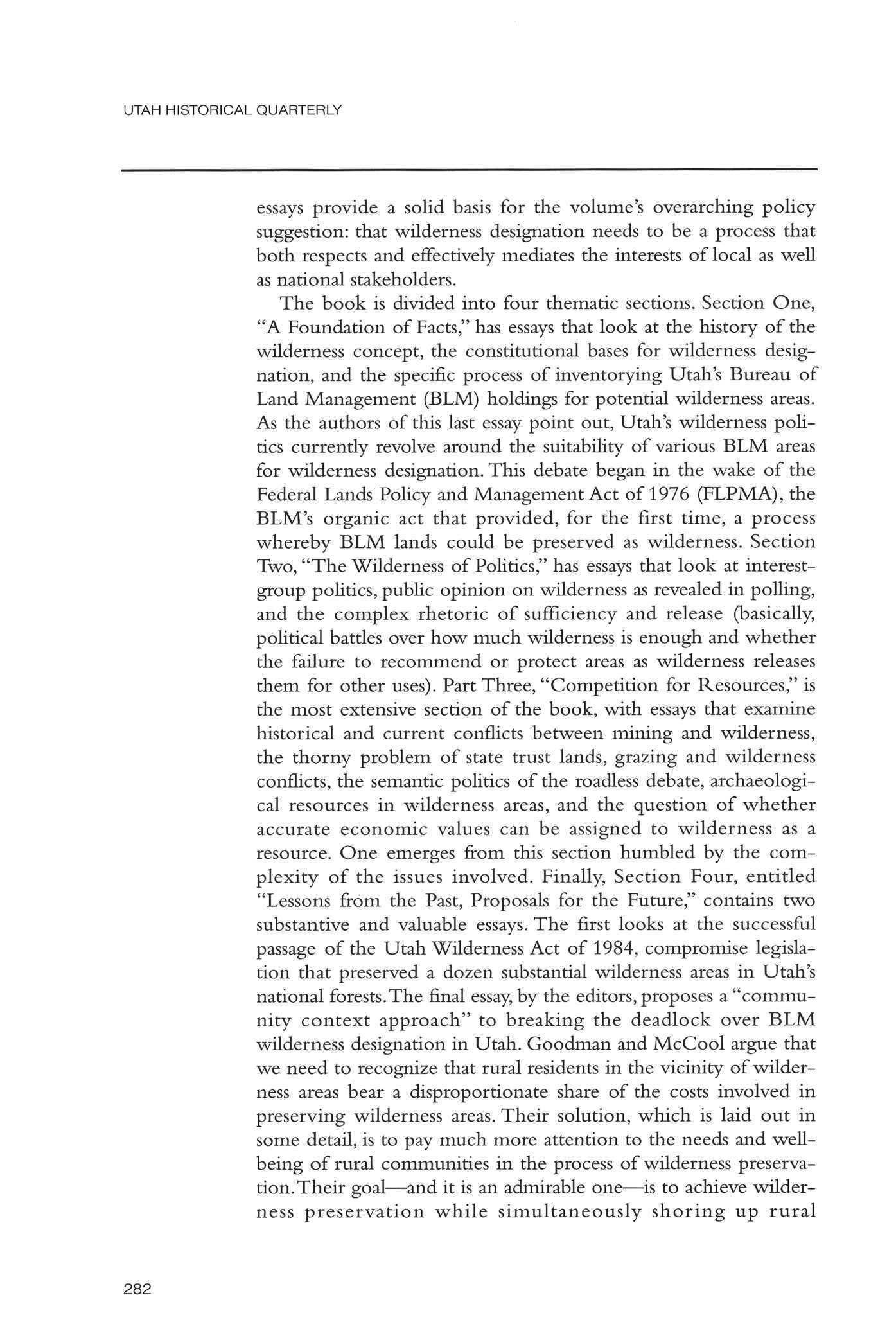
UTAH HISTORICAL
QUARTERLY
282
economies (through increased payments in lieu of taxes and the imposition of user fees) and providing local rural residents with more input into the management of wilderness areas in their vicinity.
Reading Contested Landscape can be laborious at times, but those interested in a detailed look at the labyrinthine politics of wilderness preservation in Utah and the West will be hard-pressed to find a more comprehensive assessment.
PAUL S SUTTER University of Georgia Athens, Georgia
Working the Divine Miracle: The Life of Apostle Henry D. Moyle
By Richard D. Poll. Edited by Stan Larson (Salt Lake City: Signature Books, 1999.
xx + 240 pp. $29.95.)
RICHAR D D. POLL BELIEVED that the task of "any honest biographer" centered around three critical questions: (1) What did the subject do? (2) Why did the subject do it? and (3) What shall I write? (226). Although the second question is "the biographer's greatest challenge," the third question, according to Poll, is fundamental He stated that his guiding principle in telling a story has always been to tell the "truth, nothing but the truth, but not necessarily the whole truth" (229), thereby "avoiding the extremes of muckraking and idealization" (230)
Poll's biography of Henr y Dinwood y Moyle (1889-1963), written in the early 1980s, remained unpublished for more than a decade Following Poll's death in 1994, his papers, including the biography of Moyle, were donated to the J Willard Marriott Library at the University of Utah. Stan Larson, a University of Utah curator, prepared Poll's final version of the biography, dated 1983, for publication in this volume Larson added supplemental material to the biography, including David O. McKay's funeral tribute to Moyle; Ned Winder's recollection of Moyle's last hours; a review of Poll's life and contributions to Mormon history and culture; and an essay entitled "Problems of Writing Mormo n Biography," presented by Poll in 1992. This essay discusses the broad issues involved in LDS biographical writing, including those noted above Fortuitously, the essay also highlights the challenges and concerns Poll encountered as he prepared the biography on Moyle and is a significant and relevant addition to the volume.
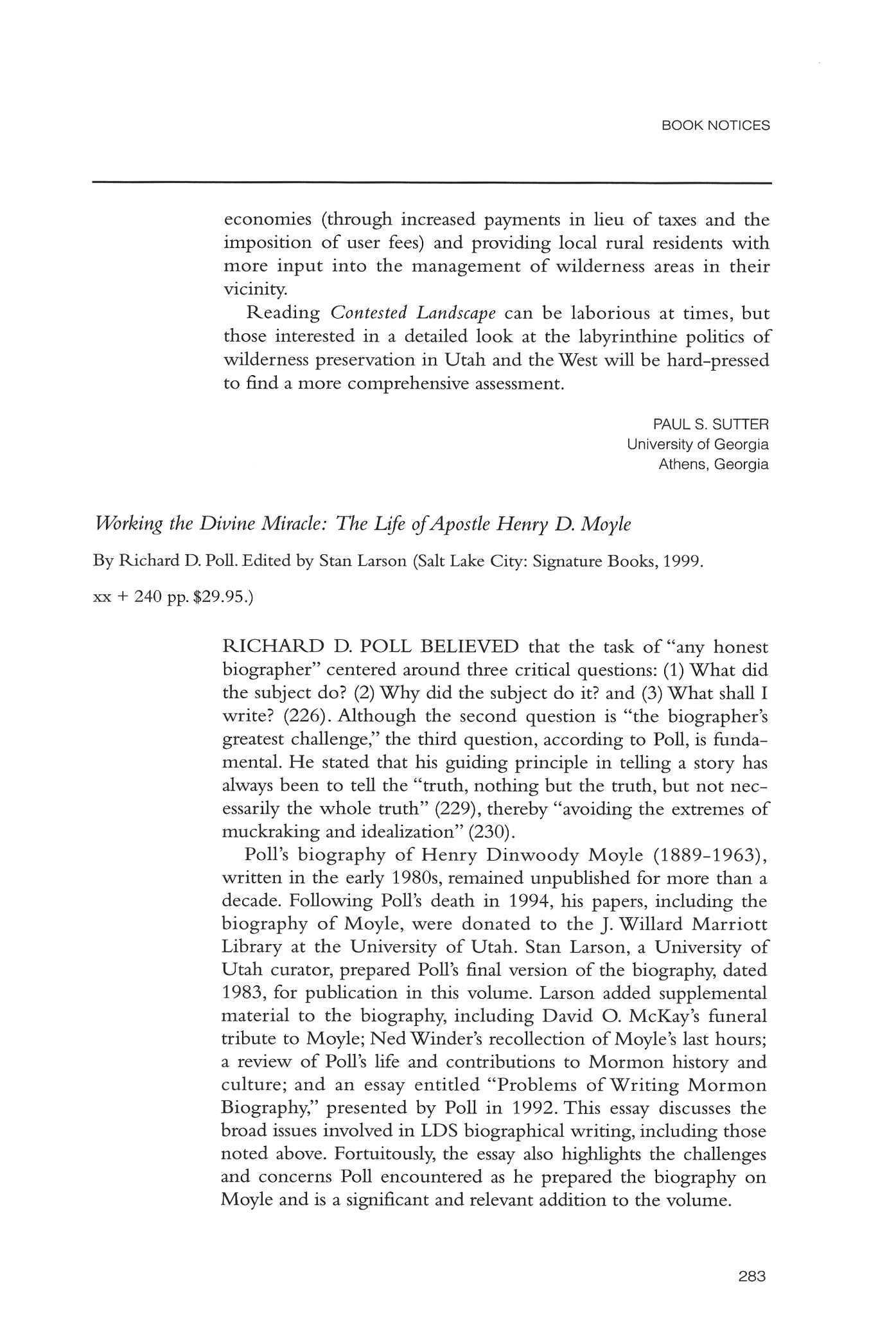
BOOK NOTICES
283
Th e heart of the book remains the biography—divided into sixteen chapters that provide a lively account of Moyle's ancestry and first years (childhood, early missionary labors, educational endeavors, and military service); early married life (family, law practice, and church service as stake president); middle age (welfare work, politics, ranching, and business entrepreneurship); and the final decades (work as a missionary apostle and counselor in the LDS church First Presidency). In these chapters Poll successfully answers in detail the first question noted above: "Wha t did the subject do?"
Th e single most important contribution of the book is Poll's efforts to take Moyle's religious commitment seriously. As a result, the biography is packed with insights that are often obscured or completely missing in this type of scholarly work. H e shows, for example, ho w Moyle's "patriarchal blessings," given -when he was young, motivated him with a sense of "obligation and destiny" (22) This is one of many attempts by Poll to answer the second question noted above: "Wh y did the subject do it?"
Another important contribution of the book is the sweeping and comprehensive overview of Moyle's administrative experience throughout his adult life in a variety of settings. Thoug h a tough lawyer, businessman, and churchman, Moyle was concerned about preserving "huma n dignity" (78). Here, Poll demonstrates his finesse in answering question three: "Wha t shall I write? " H e moves beyon d a stereotype, thus revealing the complexit y of huma n thought, motives, and activity
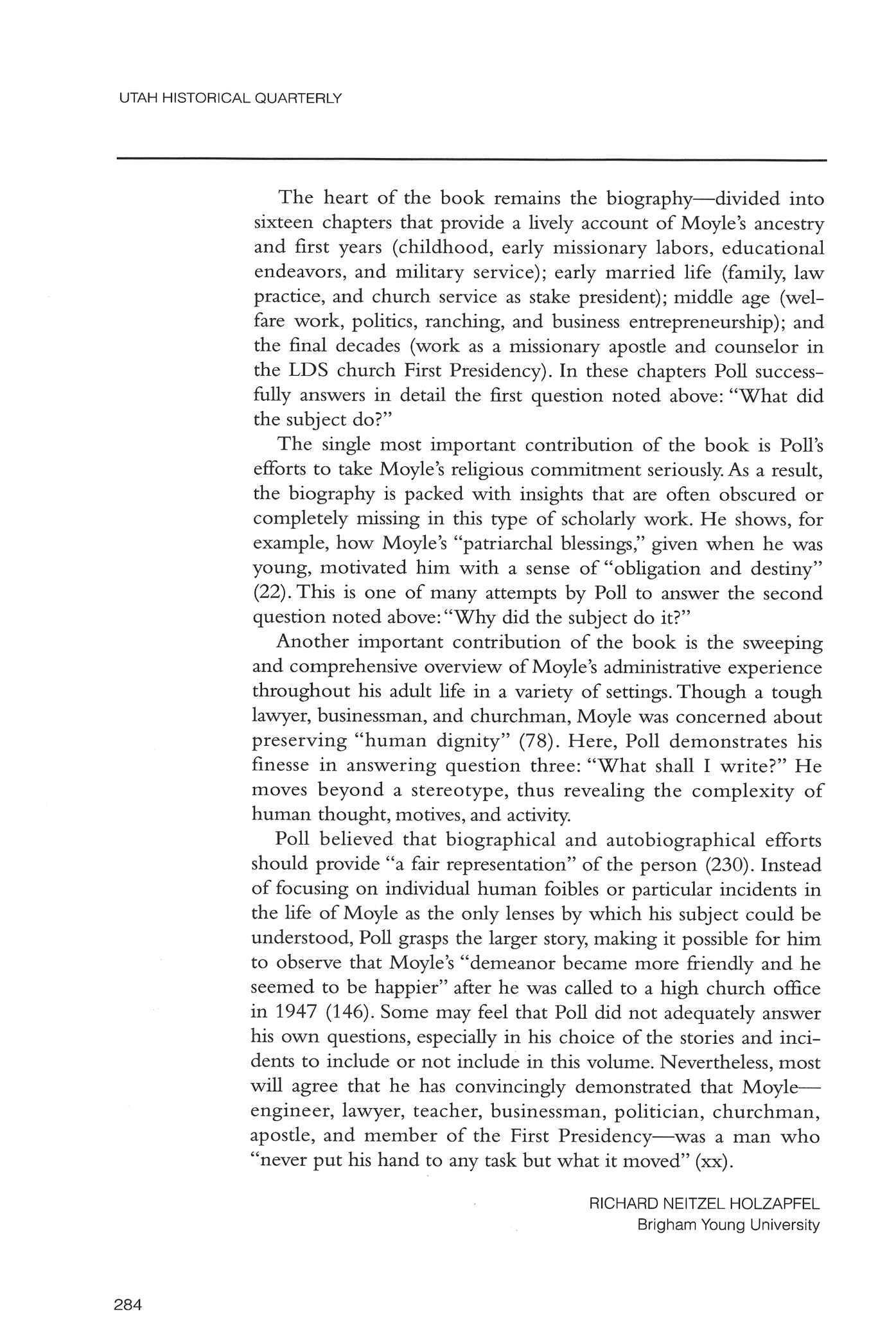
Poll believed that biographical and autobiographical efforts should provide "a fair representation" of the person (230). Instead of focusing on individual human foibles or particular incidents in the life of Moyle as the only lenses by which his subject could be understood, Poll grasps the larger story, making it possible for hi m to observe that Moyle's "demeanor became more friendly and he seemed to be happier" after he was called to a high church office in 1947 (146). Some may feel that Poll did not adequately answer his ow n questions, especially in his choice of the stories and incidents to include or not include in this volume. Nevertheless, most will agree that he has convincingly demonstrated that Moyle — engineer, lawyer, teacher, businessman, politician, churchman , apostle, and membe r of the First Presidency—was a ma n wh o "never put his hand to any task but what it moved" (xx).
RICHARD NEITZEL HOLZAPFEL Brigham Young University
UTAH HISTORICAL
QUARTERLY
284
BOOK: NOTICES
Desert between the Mountains: Mormons, Miners, Padres, Mountain Men, and the Opening of the Great Basin, 1112-1869
By Michael S. Durham
(Reprint ed.; Norman: University of Oklahoma Press, 1997. 336 pp. Paper, $18.95.)
Th e title aptly describes this work. Largely a narration of various explorations but also including chapters on Mormo n settlement, polygamy, and the Utah War, Desert between the Mountains has little to say about the lives of indigenous peoples. Both the title and the content imply that the Great Basin was a closed, unknown, and useless place before Europeans and Americans arrived.
As a single volume on the first non-native incursions into the Great Basin, this book may be useful to some readers. But the accounts are summarized from standard sources—readers familiar with Utah history will find the material mostly familiar—and little attempt has been made to create new interpretations. The narrative does not even remain focused on the book's subject; for instance, it follows Jedediah Smith around the entire West instead of covering more deeply his time in the Great Basin. And a certain shallowness of research comes through at times; for instance, the author recounts without a blush the apocryphal story of Ji m Bridger offering Brigham Young $1,000 if the pioneers were able to raise a bushel of corn in the Salt Lake Valley.

Although the book jacket calls this "the definitive, dramatic, and multifaceted study of the Great Basin," the book is something less than that.
Sanpete Tales: Humorous Folklore from Central Utah
By William Jenson Adams
(Salt Lake City: Signature Books, 1999 xxii + 128 pp Paper, $15.95.)
In 1930 Edgar M Jenson, the author's grandfather, began writing down the impudent folk tales told by the Scandinavian settlers of Sanpete County An example: "Whe n Doc Olstein was called in to see Requel Nielsen's wife, wh o was very ill, he made a very careful examination, but finally shook his head and said, 'Requel, I am worried I yoost don't like your wife's looks at all.' 'Veil, I neffer like dem either,' answered Requel, 'but she surely haf been a faithful vife oond modder"'(57)
Although these stories had entertained and united the community for decades, by 1930 the old tradition of storytelling was dying out, and the then-current generation of Sanpeters was mostly ashamed of the dialect and situations in these tales. Though many disliked the way the stories made the settlers look unsophisticated, Jenson loved the stories, and he wanted his children to know them.
Lucky for us. The hand-typed, hand-illustrated volumes he left for his posterity have been compiled and abridged into this volume Besides making us laugh, the dry humor in this collection helps us to enjoy the people—the "tough-bodied,
285
UTAH HISTORICAL QUARTERLY
warm-hearted, sly-humored" (xx) Swedes, Norwegians, and Danes wh o passed them around
Home Away from Home: A History of Basque Boardinghouses
By Jeronima Echeverria (Reno and Las Vegas: University of Nevada Press, 1999.
xv + 359 pp. $44.95.)
Th e man y Basqu e boardinghouse s an d hotels— ostatua k Amerikanuak—located in towns around the West nourished Basque immigrants in many -ways. Here, newcomers could find compatriots wh o also spoke Euskara and -who would help the m adjust to America Here they could dance, eat, listen to music, and celebrate as they had in their native country. They also might find -work, a spouse, or various kinds of social support through the boardinghouses
In Utah, the cities of Ogden, Salt Lake City, and Price all had Basque hotels, including the Hogar Hote l run by Joh n and Claudia Landa in Salt Lake City. Here, Joh n helped man y sheepherders find wor k on Basque-owne d ranches; Claudia's "legendary cooking skills" provided countless meals; and the couple regularly cared for injured herders Th e Landas opened their hotel in 1927 and ran it for fifty years.
Basques, wh o claim to be Europe's oldest ethnic group and wh o speak Europe's only remaining pre-Indo-European language, cherish their ethnicity. The y have "for centuries...spoken of themselves as a unique people and believed it fervently" (15). This boo k explores the role of a unique institution within this distinctive culture

Where Rivers Change Direction By Mark Spragg
(Salt Lake City: University of Utah Press, 1999. 270 pp. $21.95.)
A couple of annoying questions too often intervene in the reading of a personal essay: Di d this really happen as the writer says it did? Is this writer, as he seems to be, really so muc h wiser, braver, and more present in the momen t than the rest of us mortals are?
Maybe yes, maybe no. Writers do exploit the opportunity of looking back at memor y and either finding or creating a meaning that was not apparent at the time Like anybody narrating the past, they have the opportunity to shape their history; like anybody, they can choose to assume a pose through their stories, making themselves larger than they really are.
In the case of this book—essays looking back at a boyhood spent working the family dude ranch o n the Wyoming/Idaho border—those bothersome questions
286
could loom large This is no ordinary life The boy must shoulder a man's responsibilities, handling horses, dudes, blizzards, accidents. The events he recounts are astonishing But this is writing that gets each moment right, putting the reader into the "kidney-warm manure cake of the corrals," at the side of a mentor who has just nearly sliced part of his hand off, or on the bare backs of horses walking belly-deep in a river.
And because the moments as well as the instincts of these stories—of relations between males, animals, and land—are right, the question of authenticity does not intrude on the reading Factual or not, the stories are true and completely compelling
What E'er Thou Art Act Well Thy Part: The Missionary Diaries of
David O McKay
Edited by Stan Larson and Patricia Larson
(Salt Lake City: Blue Ribbon Books, 1999. xlviii + 301 pp. $24.95.)
At first glance, this book, with its sentimental dustcover illustration, appears to be more concerned with promoting an image than with scholarship A heartfelt tribute to LDS church president David O. McKay by Marion D. Hanks strengthens that impression But essays by Leonard Arrington and Eugene England show that neither the book nor its subject is one-dimensional. Arrington discusses McKay's open-mindedness and other positive qualities but also mentions that McKay was sometimes "arrogant and subject to toadyism" (xvi). England describes a man who valued intellectualism and who combined conservative, moderate, and liberal thought; believed in evolution as God's method of creation; disbelieved in the "curse of Cain" justification for denying the LDS priesthood to African Americans; and took important steps that led toward a reversal of that policy.
With such introductory essays, the diaries of this influential man during a formative period in his life become more interesting. The entries show McKay's intellectual curiosity, his spiritual and emotional development, and his growth as a leader through his experiences in Scotland As the editors point out, this is a rare look at the private writings of someone wh o was not at the time a general authority but who would later become church president; no other such missionary diaries have ever been published. Along with a solid and insightful introduction to the diaries, the editors have provided annotations and period photographs of sites mentioned by McKay.

BOOK NOTICES
28 7
UTAH HISTORICAL QUARTERLY
The Animals Came Dancing: Native American Sacred Ecology and Animal
Kinship By Howard L Harrod (Tucson: University of Arizona Press, 2000 xxv +
171 pp Cloth, $35.00; paper, $17.95.)
A professor of social ethics, sociology of religion, and religious studies, Harrod writes about the relationships between Norther n Plains Indians and animals Th e myths and rituals of these tribes show a view of animals as transcendent others—not only sentient, intelligent beings but also powerful agents wh o could mediate between humans and the natural and supernatural worlds. In these stories animals are creators, rescuers, husbands and wives, parents, and providers of food, well-being, and renewal
In a final chapter, the book explores and deconstructs humans' current relationships with animals In almost all cases the Nort h American culture views animals from a utilitarian standpoint: that animals, including wildlife, exist to serve huma n needs and desires. Thoug h the author speaks against a direct appropriation of Native American attitudes—such appropriation would lead to shallow sentimentality, disembodied traditions, and continued cultural imperialism—he does argue for a reimagining of our relationship to animals If our culture can view animals as sentient, complex, transcendent, and other, he says, -we can transform the current paradigm of the natural world as commodity.
To Build, to Create, to Produce: Ephraim P. Ellison's Life and Enterprises, 1850-1939
By William G Hartley (Ellison Family Organization, 1997 xvii + 556 pp.)

A no-nonsense businessman, leader in his LDS congregations, and father of nine, E. P. Ellison was one of those men -who shaped Utah through his entrepreneurship His business interests were many and included enterprises in Canada as well as in the Mountain West With Jesse Knight as a sometimes partner, he directed operations in banking, sugar processing, flour milling, livestock, and merchandising. Perhaps among his largest contributions -was his work as vice president and president of the Davis and Weber Counties Canal Company whe n it built the East Canyon and Echo dams
Using a variety of primary sources, this volume details the history of Ellison's businesses, his church and civic work, and his family Although the progress of the companies may be tracked, Ellison himself, wh o was not prone to show or write about his deepest feelings, is somewhat more cryptic. But the book is a valuable account of economic activity in a variety of enterprises
288
UTA H STAT E HISTORICA L SOCIET Y
Department of Community and Economic Development Division of State History
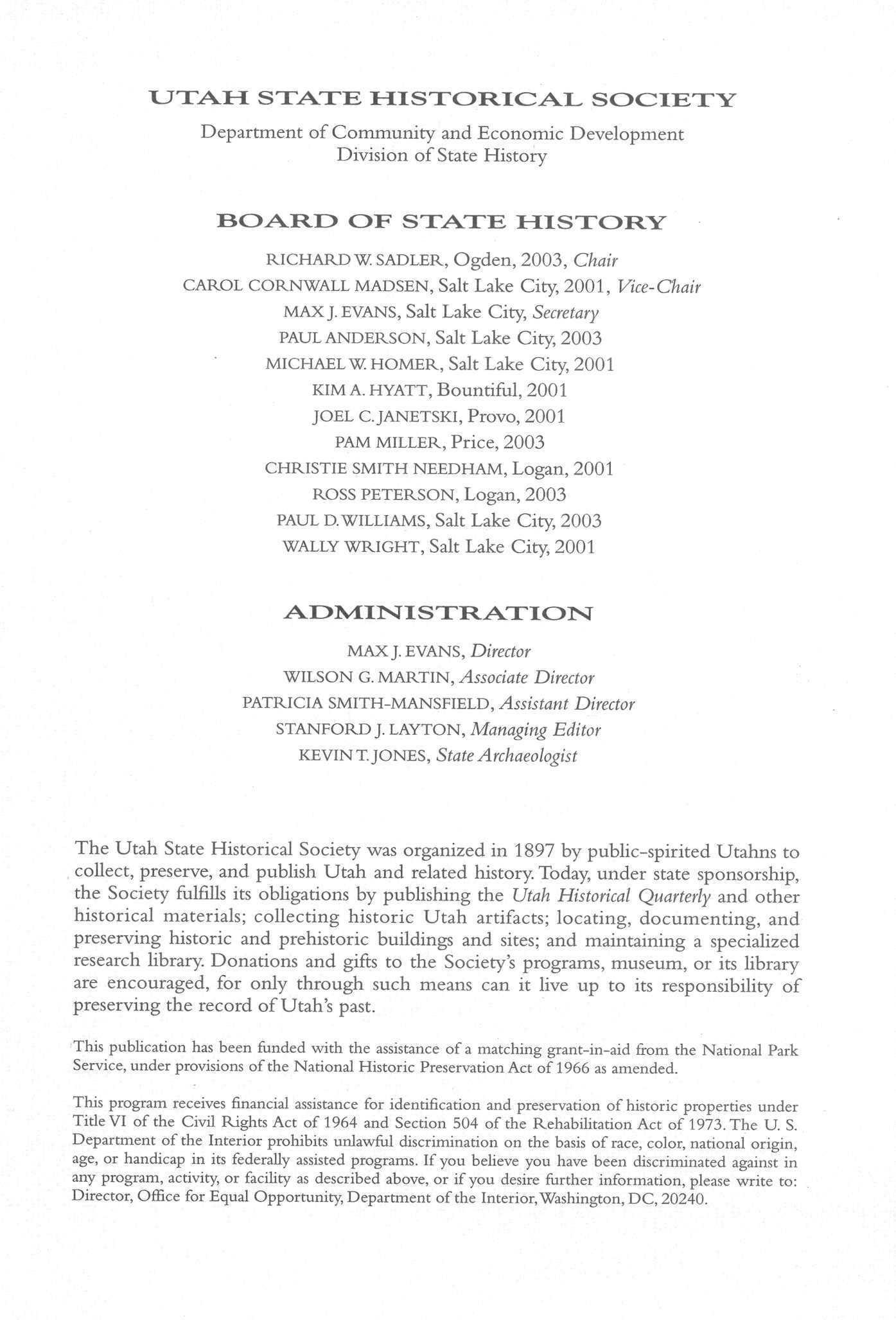
BOAR D O F STAT E HISTOR Y
RICHARD W. SADLER, Ogden, 2003, Chair
CAROL CORNWALL MADSEN, Salt Lake City, 2001, Vice-Chair
MAX J. EVANS, Salt Lake City, Secretary
PAUL ANDERSON, Salt Lake City, 2003
MICHAEL W HOMER, Salt Lake City, 2001
KIM A. HYATT, Bountiful, 2001
JOEL CJANETSKI, Provo, 2001
PAM MILLER, Price, 2003
CHRISTIE SMITH NEEDHAM, Logan, 2001
ROSS PETERSON, Logan, 2003
PAUL D.WILLIAMS, Salt Lake City, 2003
WALLY WRIGHT, Salt Lake City, 2001
ADMINISTRATIO N
MAX J EVANS, Director
WILSON G MARTIN, Associate Director
PATRICIA SMITH-MANSFIELD, Assistant Director
STANFORD J LAYTON, Managing Editor
KEVIN T.JONES, State Archaeologist
The Utah State Historical Society was organized in 1897 by public-spirited Utahns to collect, preserve, and publish Utah and related history Today, under state sponsorship, the Society fulfills its obligations by publishing the Utah Historical Quarterly and other historical materials; collecting historic Utah artifacts; locating, documenting, and preserving historic and prehistoric buildings and sites; and maintaining a specialized research library Donations and gifts to the Society's programs, museum, or its library are encouraged, for only through such means can it live up to its responsibility of preserving the record of Utah's past.
This publication has been funded with the assistance of a matching grant-in-aid from the National Park Service, under provisions of the National Historic Preservation Act of 1966 as amended.
This program receives financial assistance for identification and preservation of historic properties under Title VI of the Civil Rights Act of 1964 and Section 504 of the Rehabilitation Act of 1973 The U S Department of the Interior prohibits unlawful discrimination on the basis of race, color, national origin, age, or handicap in its federally assisted programs. If you believe you have been discriminated against in any program, activity, or facility as described above, or if you desire further information, please write to: Director, Office for Equal Opportunity, Department of the Interior, Washington, DC, 20240.






 By DAVIS BITTON
By DAVIS BITTON
















 GEORGE ARMSTRONG HICKS
Erastus Snow, Mormon apostle, directed the settlements in southern Utah.
GEORGE ARMSTRONG HICKS
Erastus Snow, Mormon apostle, directed the settlements in southern Utah.



 GEORGE ARMSTRONG HICKS
GEORGE ARMSTRONG HICKS










 Capitol Gorge, now part of Capitol Reef National Park, was part of the route to Blue Valley.
Capitol Gorge, now part of Capitol Reef National Park, was part of the route to Blue Valley.















 By RONALD G WATT
By RONALD G WATT


 Band marching on field of the Salt Lake High School (now West High) c. 1919. Note the construction of the state capitol in the distance.
Band marching on field of the Salt Lake High School (now West High) c. 1919. Note the construction of the state capitol in the distance.










 By AUDREY M GODFREY
By AUDREY M GODFREY













 WAYNE K HINTON Southern Utah University
WAYNE K HINTON Southern Utah University
 ROGER BLOMQUIST Brigham Young University
ROGER BLOMQUIST Brigham Young University



















